-
Posts
2,102 -
Joined
-
Last visited
-
Days Won
2
Content Type
Profiles
Forums
Blogs
Gallery
Events
Store
Posts posted by Rusty Greaves
-
-
President Dwight D. Eisenhower (34th US President from 1953-1961) was one of the most well-known Americans to be awarded the Order of Ismail. He received the Grand Cordon 1st Class sash, sash badge, and breast star on 24 May, 1947. This was after he had returned to Washington DC following his work in the Occupied Zone of Frankfurt, Germany (1945), his advancement to Chief of Staff of the US Army (1945), and having his wartime rank of General of the Army made a permanent rank (1946), and prior to his running for US President in 1948. The regalia is housed at the Dwight D. Eisenhower Presidential Library, Museum & Childhood Home, 200 SE 4th Street, Abilene, Kansas, USA (https://www.eisenhowerlibrary.gov/eisenhowers/awards-medals). This example was probably made by Tewfik Bichay (spelled "Bichai" on the interior of the presentation case lid). Below are some med-low resolution images from the Dwight D. Eisenhower Library and Museum of his Order of Ismail. There apparently are no photos of the presentation of this award to Eisenhower, nor of him wearing it. I am checking with the staff to see if I can get any better images, some photos of the reverse of the sash badge and breast star to identify the manufacturer and date hallmarks, or information about the award brevet.
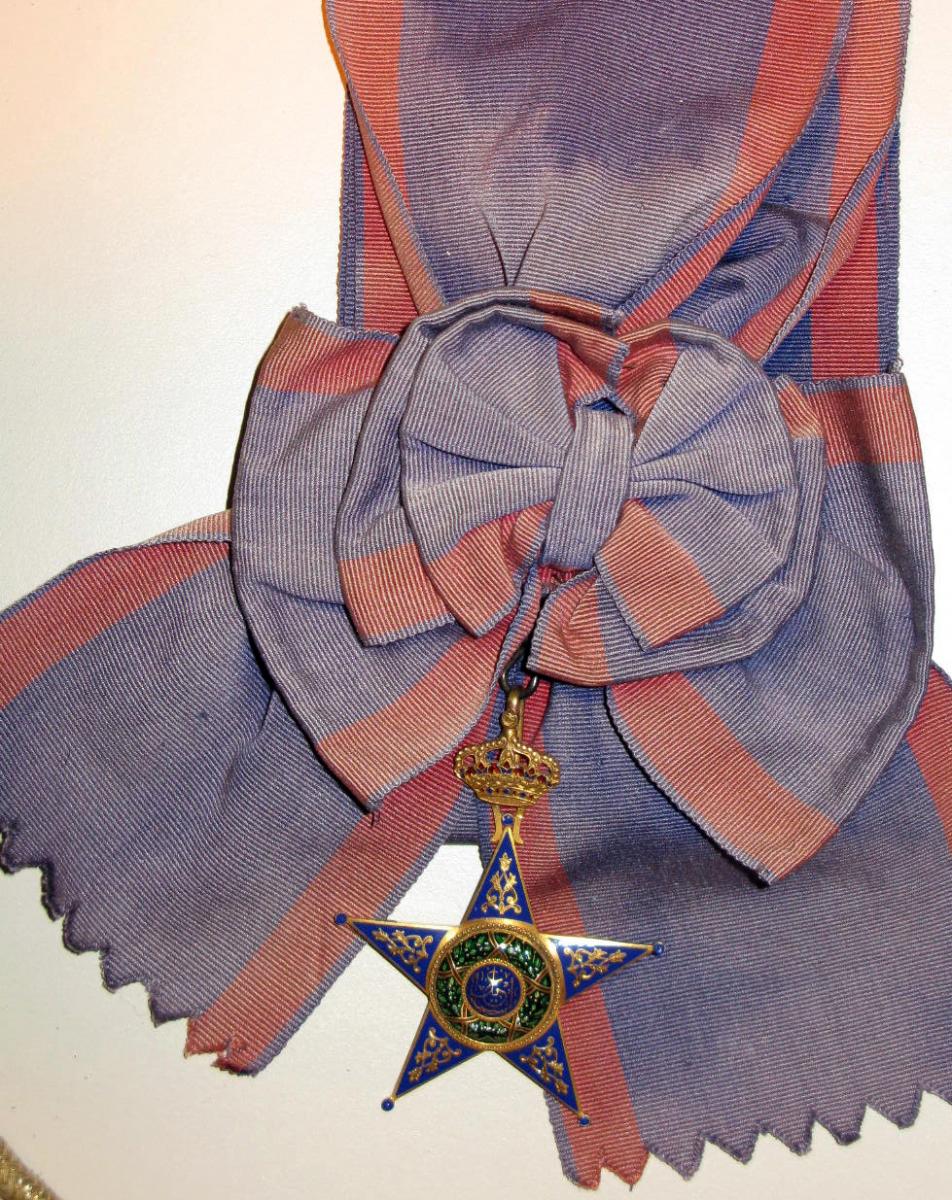
Moderate resolution image of the Eisenhower sash and sash badge. Note the presence of a clip that the suspension device attached to the crown uses to secure it to the sash that is similar to the illustrated clips on this thread in the 6th photo (the last photo) of my previous post of 22 August 2019 and in the 2006 JOMSA photo reproduced in my post of 27 August, 2019. Also of interest in this Grand Cordon set are the muted colors of the blue and the red of the sash. 922F pointed out in a post of 5 April, 2018 on this thread that the 3rd Class Commander's neck badge that Owain showed in his 3rd-6th photos of his post here of 5 April, 2018 exhibits comparably less brilliant colors of that neck ribbon. 922F further stated that Fahmy Tewfik Bichay told him about shortages of materials for medals in 1940-1944 (less relevant to the Order of Ismail are shortages in 1953-1959) that included ribbons, and 922F suggested that this color difference may be frequent enough across award classes to merit designation as a possible variant form of the Order of Ismail. The coloration of the sash of the Eisenhower example appears to be very similar to that in Owain's 5 April post.

Low-resolution closer view of the Eisenhower sash badge. The dark color of the metal of the clip to which the sash badge's suspension device is attached cannot be determined from this image. 922F indicated in his 5 April post that Fahmy Tewfik Bichay specifically mentioned the difficulty in obtaining the swivel attachments for badges to sashes during the periods of material shortages, so this may be a different material "work-around" that 922F quotes Bichay as saying his workshop staff had to create during these shortages. This photo does show the 3-D engraving of the gold ornamentation of the 5 arms of the star (seen on all examples that were made by Lattes or Tewfik Bichay, but possibly not present on all [any?] medals made by Fahmy Tewfik Bichay). Again note the "faded" red and blue of the sash. Compare the above sash with the sash colors seen on the Grand Cordon sash and sash badge example from a past eMedals auction example (Item W0269, made by Lattes with a date hallmark "A" for 1925-1926) illustrated on my 13 November, 2017 post on this thread; 2 images of the same Grand Cordon set (made by Lattes, with a date hallmark of "Y" for 1923-1924) on my posts of 6 December, 2017 and of 13 December, 2018 on this thread from a Spink & Sons Catalog listing (Auction 17003, Lot 28) of December 2017; and the cased Grand Cordon set (made by Lattes, with a date hallmark of "B" for 1927-1928 on the sash badge and a "C" for 1928-1929 on the breast star) illustrated in the first 2 photos of my post of 22 February, 2019 offered on an April 2018 auction by La Galerie Numismatique archived on the live auctioneer.com website.
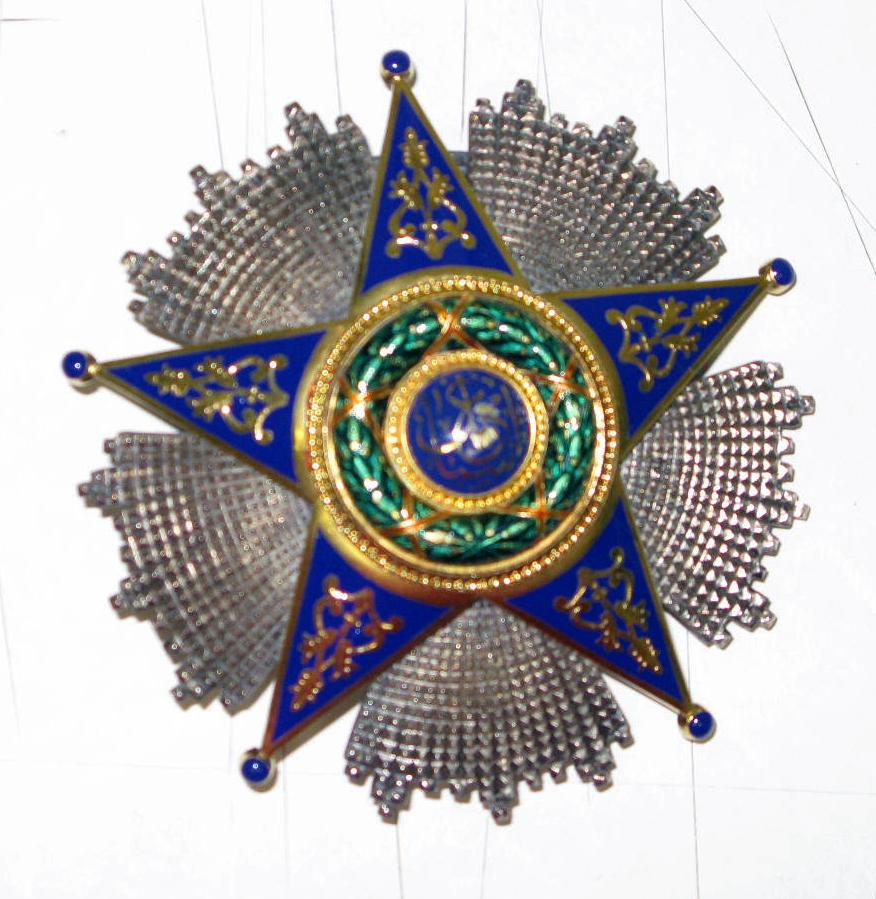
Poorly focused image of the breast star of President Eisenhower's Grand Cordon Class of the Order of Ismail. This also shows the sculpted gold ornamentation on the 5 arms of the blue enamel and gold star.
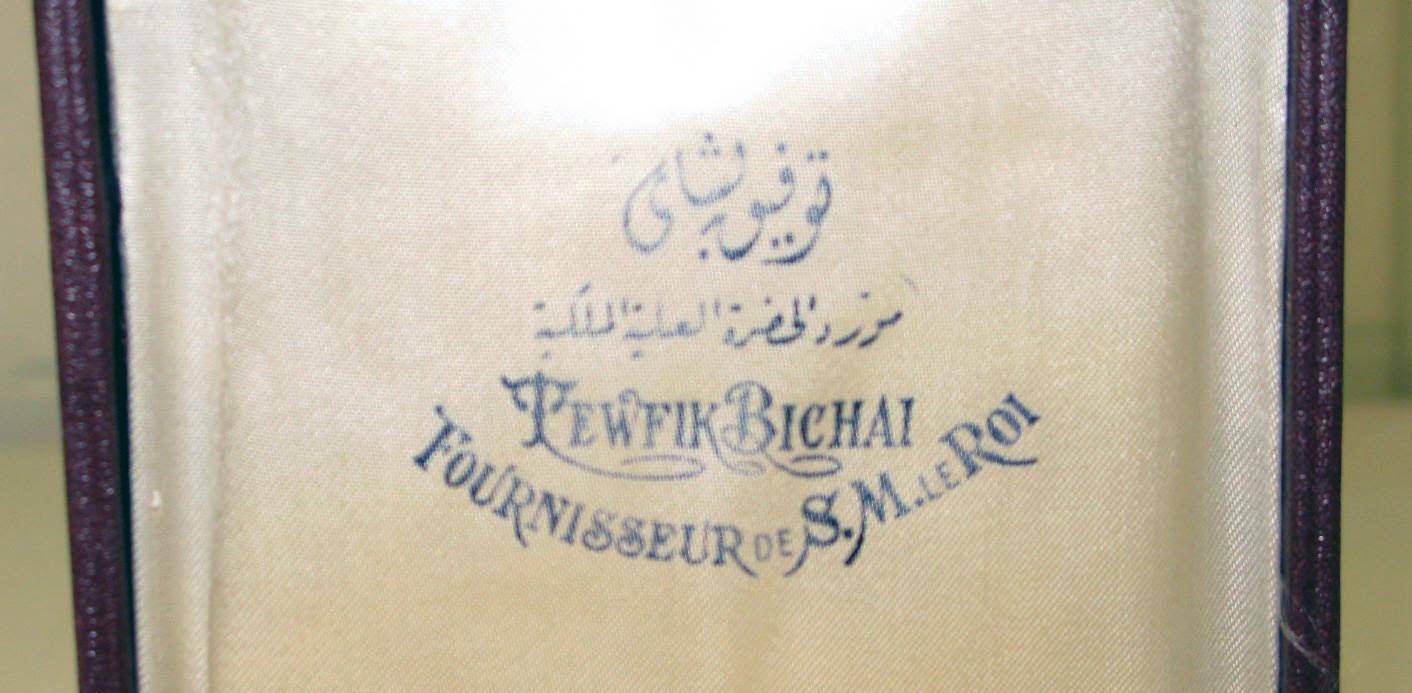
Inside of the upper case lid showing the maker's name of "TEWFIK BICHAI, FOURNISSEUR DE S.M. LE ROI". This is the same inscription shown on the inner case of the 3rd Class Commander's neck badges illustrated by Owain in the 2nd photo of his post of 5 April. 2018 on this thread. Owain noted that while the maker's inscription on the inside of the case for his Commander's neck badge was Tewfik Bichay, the hallmark on the reverse of that neck badge was of Fahmy Tewfik Bichay, the son of Tewfik Bichay.
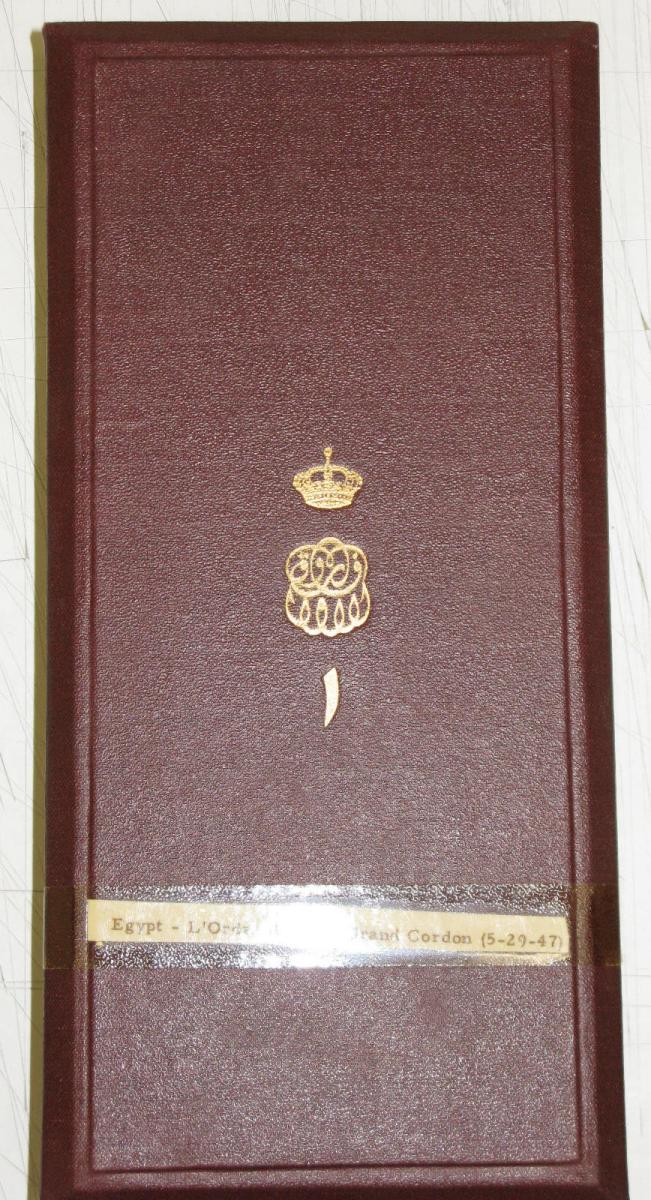
Photo of the exterior of the presentation case with King Farouk I's cipher and the taped note that this is "Egypt-L'Ordre d'Ismail Grand Cordon 5-29-47", indicating a slight discrepancy in its award date to President Eisenhower as 29 May, 1947 (other sources give the date of this award as 24 May, 1947).
0 -
Peter, I am always happy if this research is of interest to someone else. Many thanks for your kind words.
I believe I have identified the studio that took the photograph of Adib Makaad Bey in his court regalia and wearing the the 4th Class Officer Order of the Nile, the 4th Class Officer Belgian Order of Leopold II, the 4th Class Officer Italian Order of the Crown, and the Belgian (wartime?) Order of the Crown Palms (shown in the 7th-to-last photo attachment in my most recent post of 6 September, 2019). That portrait photo is dated January 1929. I have included the image below. The eBay seller of the photos shown in my 6 September post responded to my inquiry about whether this group of photos might be from collection associated with Adib Maakad Bey or his family. He obtained them from a local market, probably in Cairo, with no additional documentation. However, as every photo contains an image of Adib Maakad Bey, and they represent matted prints with handwritten legends from multiple photo studios in Alexandria, these likely came from an associated album of images. Most probably, they were at one time the property of Adib Maakad Bey.
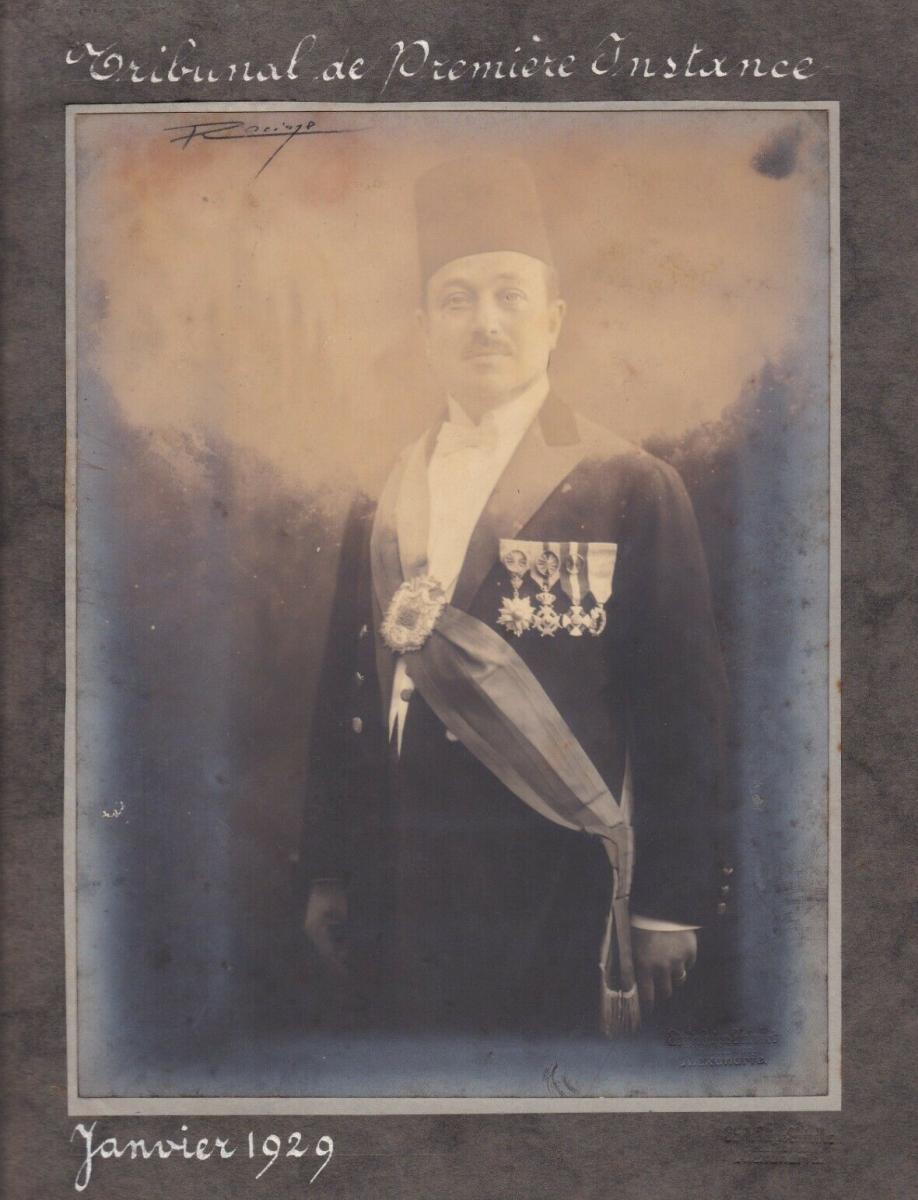
January, 1929 portrait photo of Adib Makaad Bey, during his tenure as Greffier en Chef of the District Court of Alexandria. The handwritten (or stamped?) studio name in the upper left corner is "Racine", a studio that was located on 13 rue Stamboul, Alexandria.
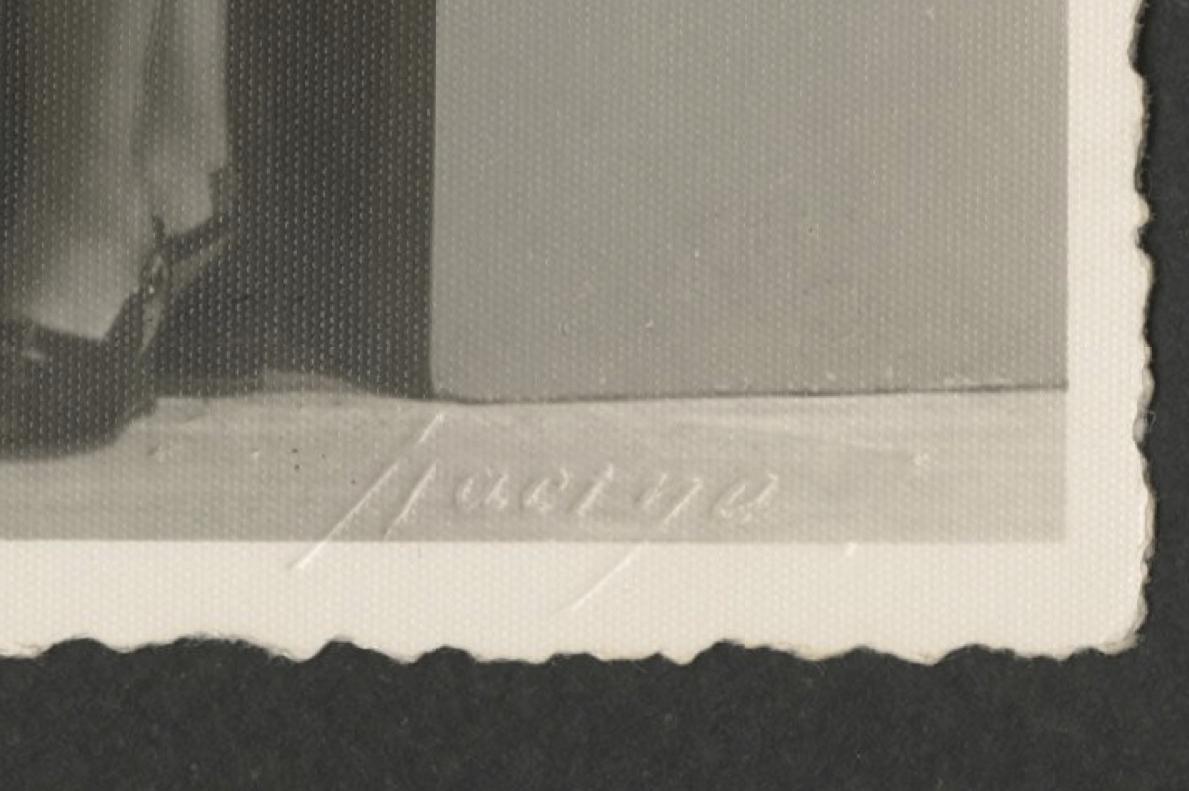
I have identified a similar studio mark to that on the portrait of Adib Makaad Bey from a photograph listed in the "Guide to the Yasser Alwan Collection 1890-1970" of more than 2,000 photographs in the New York University Abu Dhabi, Akkasah: Center for Photography (http://dlib.nyu.edu/findingaids/html/akkasah/alwan/dscref179.html). Yasser Alwan purchased old photographs from flea markets and book merchants in the 1990s, selecting images (principally from the 1920s, 1930s, and 1940s) that show the cultural diversity of life in Egypt during the first half of the 20th century. Above is the studio's embossed name "Racine" on the lower right of an image dated 13 May, 1949 and titled "A young woman in a dress with shoulder detailing" (AD-MC-002_ref611; Box 3, Folder 19). The reverse of the postcard includes the address: "RACINE ALEXANDRIE 13 RUE STAMBOUL".
I also want to illustrate a judicial badge I just came across from a current auction by Lundin Jewel & Antique that is listed on the worldantiquenet.com website (https://www.worldantique.net/apstort.asp?selbinr=326604&kukat=8715&valuta=USD#valuta). This badge has no maker's hallmark on the reverse. This has piqued my curiosity about better ways to identify the many unmarked Mixed Court judges' badges, and I am starting to compare the calligraphy on the inscriptions of the central tablets of these badges. I will soon post some comparative images of these tablets from badges that either have a maker's hallmark shown in auction photos of the reverse, are associated with cases that name the manufacturer, or seem to have reliable attribution even if no photographs of the reverse of the badges are available. I hope to see if these may provide some use in preliminary identification of the makers of some unmarked badges.
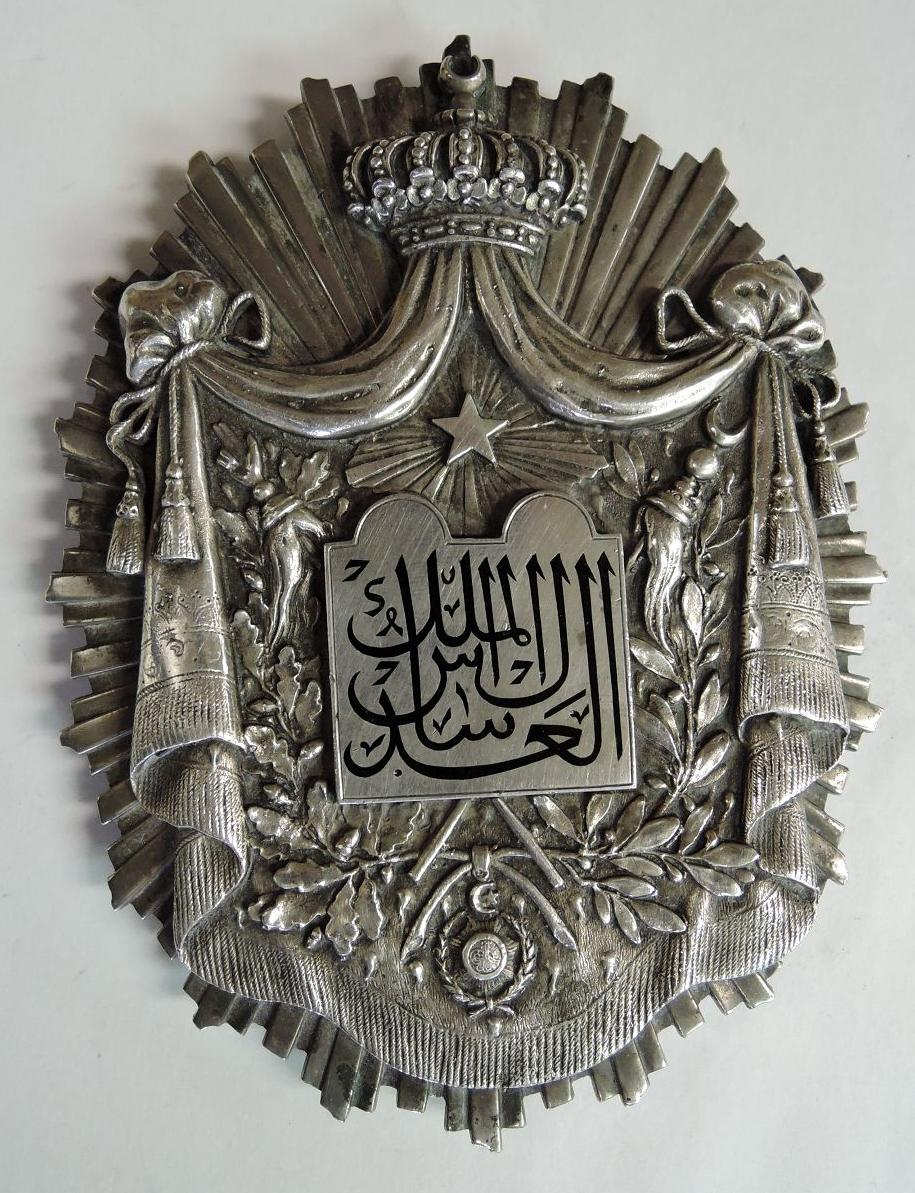
Obverse of the Lundin Antique judicial badge (Item no. 326604). It is identified in the auction description as silver, measuring 112 mm X 85 mm, and the translation provided of the inscription is given as "Government is based on Justice". This example shows quite a bit of wear of the upper folds of the mantle drapery and tassels. My current suspicion is that this may be an example made by Stobbe of Alexandria, but I will post the comparisons soon and see if the calligraphy on the central tablets can provide some initial clues to the makers' identities of the many unmarked badges being offered on auction sites.
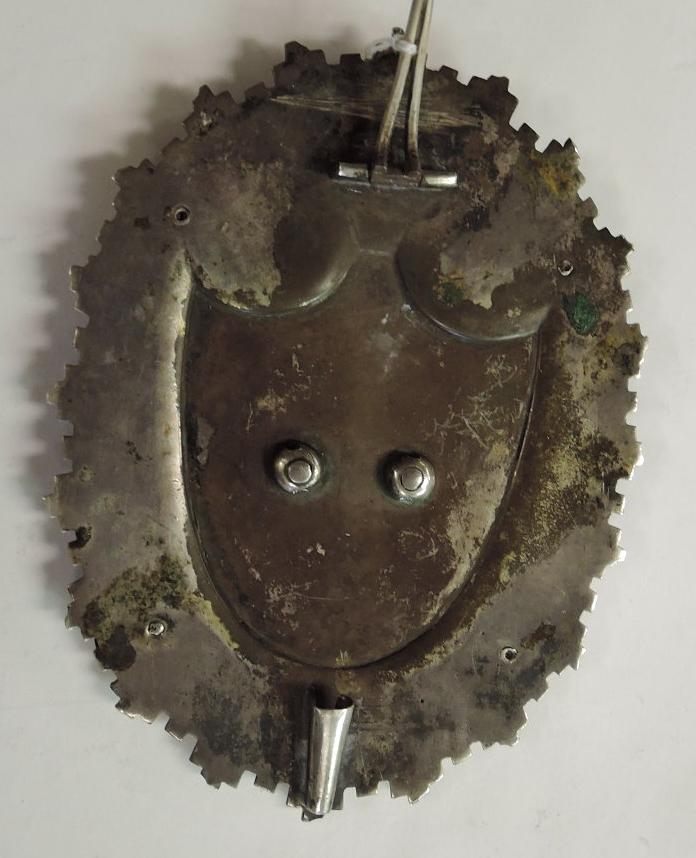
Reverse of the same badge with the tunic pin open showing the lack of any maker's hallmarks or visible silver assay marks.
0 -
I recently came across several photographs from the Egyptian Mixed Courts in a group of photos being auctioned on eBay since May, 2019. These all are related to functionaries (many of them greffiers) serving the Court of Appeals and the District Court of Alexandria. All of these photos are matted and have some level of information hand-written on the mats. The calligraphy of the handwriting in white or silver ink on all of these mats is not completely identical, however it is quite similar. The kinds of information, presence of dates, names on some mats, and calligraphic embellishments do suggest they are an associated collection. I am providing additional data about each of these photos based on my personal research of the Mixed Courts. Both the Appeals Court and the District Court represented in several photos were located in Alexandria and several photos come from the well-known Alban Studio in Alexandria. Two of these are photos that were used in the Les Juridictions Mixtes d'Égypte 1876-1926 50th Anniversary volume that I have used in previous posts on this thread. The auctioneer has obtained a number of photos in this assortment that feature one particular individual, Adib Maakad Bey. The predominance of images of Maakad Bey (as well as very similar handwriting on all examples) may suggest this is a grouping that was at one point owned by Makaad Bey or his family.
I have in the past used the term “clerks” to refer to the roles of greffiers in the Mixed Courts, but perhaps the translation offered by S. W. Hoyle in his 1986 article (The structure and laws of the Mixed Courts of Egypt, Arab Law Quarterly, vol 1 (3): 327-345), of “registrar” is more apt. These individuals handled a range of skilled and complex paperwork, including listing cases, supervising trials, countersigning the judges’ signatures, and formally published case results. Initially this demanding role was filled exclusively with foreigners who had served in comparable positions abroad, but eventually a significant number were drawn from Egyptian applicants. Greffiers had to be at least 24 years old, have a good knowledge of Arabic French, or Italian (most apparently spoke at least 2 of these languages). Applicants had to pass a rigorous exam in law and be approved by a panel of judges and the Greffier en Chef (Chief Registrar). Greffiers also assumed duties dealing with deeds and notary tasks. Other staff described by Hoyle include huissiers, a combined role of bailiff and usher. These individuals also had to be 24 or older, pass an exam to demonstrate they could read and write at least one judicial language, and had to provide a cash or securities guarantee in case of claims made against them in their professional work. Interpreters also formed a large group of court officials, subject to the same age requirement and needed to be fluent in Arabic and one other judicial language. They mostly worked with litigants because of the requirement that most huissers,greffiers, and judges were able to communicate in multiple languages. The courts also had their own guards, caretakers, and messengers (Hoyle 1986: pp. 341-342).
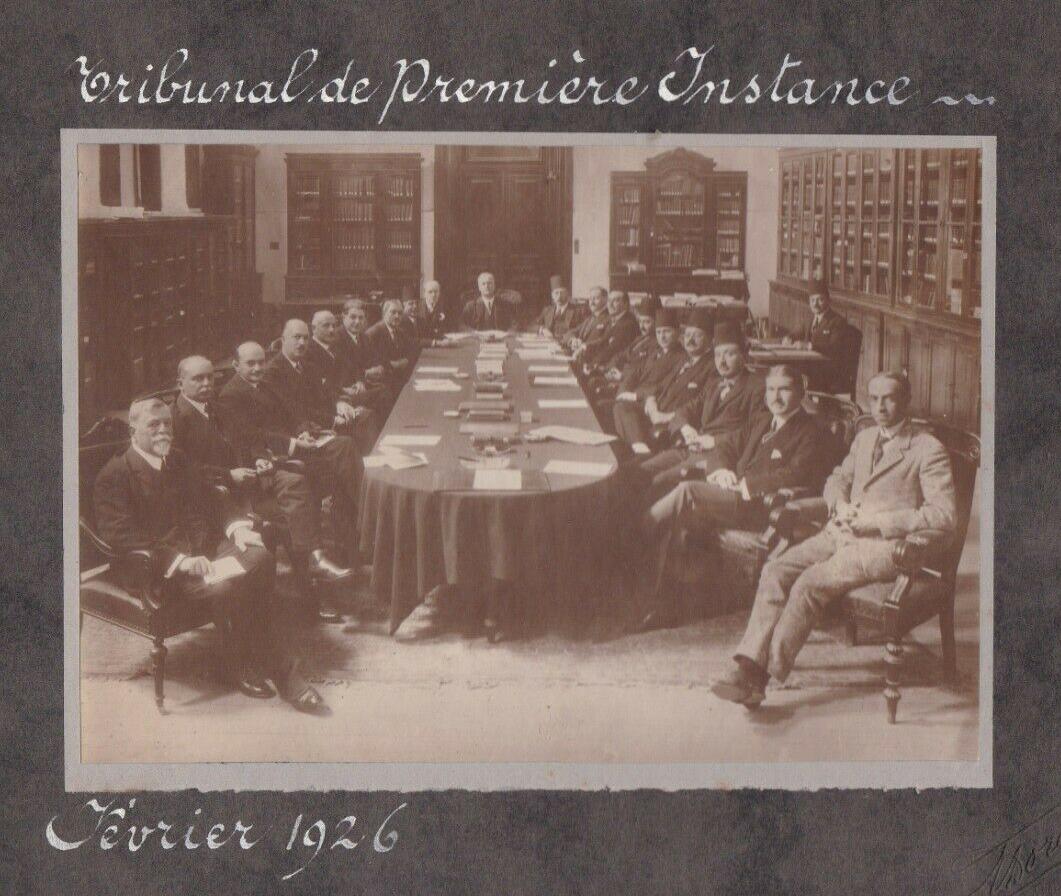
Example of one of the photographs in this eBay offering that is a picture of the District Court of Alexandria that I have previously posted as the 5th photo in my post of April 18, 2019 in this thread (with all the individuals identified in that post) and in the 11th image of my post of 21 August 2019 (to illustrate Judge William Hobart Houghton Thorne of Britain). Those illustrations using this same photo came from the Les Juridictions Mixtes d'Égypte 1876-1926: Livre d'or Édité sous le Patronage du Conseil de l’Ordre des Avocats á l’Occasion du Cinquantenaire des Tribunaux de la Réforme, par le: Journal des Tribunaux Mixtes. Alexandrie, Egypte, Février 1926 volume (pg 192). In my original post of this image I did not know when this photo was taken, this example identifies February 1926, the same month the Les Juridictions Mixtes d'Égypte 1876-1926 volume was published. The seller identifies this as an original print, sized 17 cm x 12 cm, from the “Photo Dores Studio” in Alexandria. This is the Aziz & Dorés Studio, one of the most important early studios in Alexandria run by Aziz Bandarli and Umberto Dorés, located at 3 rue de l’hopital grec, Alexandrie (this is now Istanbul Street). This studio may have opened in 1907 and also was involved in early cinema in Alexandria. I have previously identified the judges and the Greffier en Chefin this photo in my April 18 post. In relation to several photos reproduced below, note the individual at a writing desk to the far right away from the table where the judges are seated. This is the Greffier en Chef, Adib Maakad Bey, who is shown below in several photos outlining his career roles with the District Court of Alexandria and his earlier role as a greffierwith the Court of Appeals. (From: https://www.ebay.com/itm/EGYPT-VINTAGE-PHOTOGRAPH-mixed-jurisdictions-of-egypt-1926-PHOTO-DORES-ALEX/312613193983?_trkparms=aid%3D333200%26algo%3DCOMP.MBE%26ao%3D1%26asc%3D20190129125700%26meid%3D384b24d149c54feabe53a40b67859832%26pid%3D100752%26rk%3D5%26rkt%3D12%26sd%3D312613211731%26itm%3D312613193983&_trksid=p2047675.c100752.m1982)

Greffiers of the Court of Appeal, December 1910. Some of these individuals are shown in a photo in the Les Juridictions Mixtes d'Égypte 1876-1926 volume titled “Les Functionnaires de la Cour D’Appel” on page, pg 391. I have identified their 1926 roles from the legend to that photo in the listed identities below, however their assignments in 1910 are not known to me. 1st row = L. Camiglieri (Greffier contrôleur des taxations); A.(?) Gregnac; Gregnas; E. della Rovere Rey (Greffier Comptable de la Cour et du Tribunal d’Alexandrie). 2nd row = M. Biagini; Adib Maakad; an unnamed court functionary, and M. Buccianti (Secrétaire de Greffier en Chef) - the Les Juridictions Mixtes d'Égypte 1876-1926 volume identifies his first initial as “M.” although it appears to be “F.” in the written legend on this photo). This is the earliest image I have seen of Adib Maakad. As noted this auction group contains several additional images of Adib Maakad (later Adib Maakad Bey) in group photos and single portraits associated with his work as a greffier in the Appeals Court and later the District Court of Alexandria. In this photo, only L. Camiglieri and E. della Rovere wear the judicial costume of the high collared tunic coat (stambouline), tarbush, biclored sash, and judicial badges (probably silver?). Camiglieri’s sash clearly is bicolored, and della Rovere’s sash is probably bicolored. In these photos, and previous black & white images I’ve posted on this thread, I am interpreting the colors of sashes based on comparisons with images of monochrome sashes. Individuals identified as judges with the Appeals Court wore green sashes, and in the black & white photos their sashes appear a lighter gray. Judges of the District Courts (principally serving in Alexandria, Cairo, and Mansourah; and the Mansourah Court personnel visited Port Said once a year) wore red sashes, and these appear much darker in the contemporary black & white photos. I am interpreting the orientation of the green & red stripes of the sashes of the Parquet and other court functionaries based on the contrasting darkness or lightness of each strip compared with the colors seen on sashes of Appeals or District Court judges. According to the protocol that I have been able to find, the bicolored sash of the Parquet is supposed to have been worn with the green stripe uppermost, and presumably that may also be the case for other court functionaries wearing these sashes. As can bee seen in several photos in this post, and in previous posts on this thread, there is some variability in how the sash was actually worn. However, there may be a general preponderance of individuals wearing the bicolored sash with the green stripe uppermost. This image is identified as an original print, but the size of the print and the photo studio (almost certainly in Alexandria) are not identified. It mistakenly identifies the subjects as judges, despite the hand lettered legend on the right of the mat stating “Greffe de la Premier Chambre”. (From: https://www.ebay.com/itm/EGYPT-VINTAGE-PHOTOGRAPH-mixed-jurisdictions-of-egypt-1910-Judges-With-medals/273849827037?hash=item3fc2b8bedd:g:wqcAAOSwvX5c3fdB&frcectupt=true)
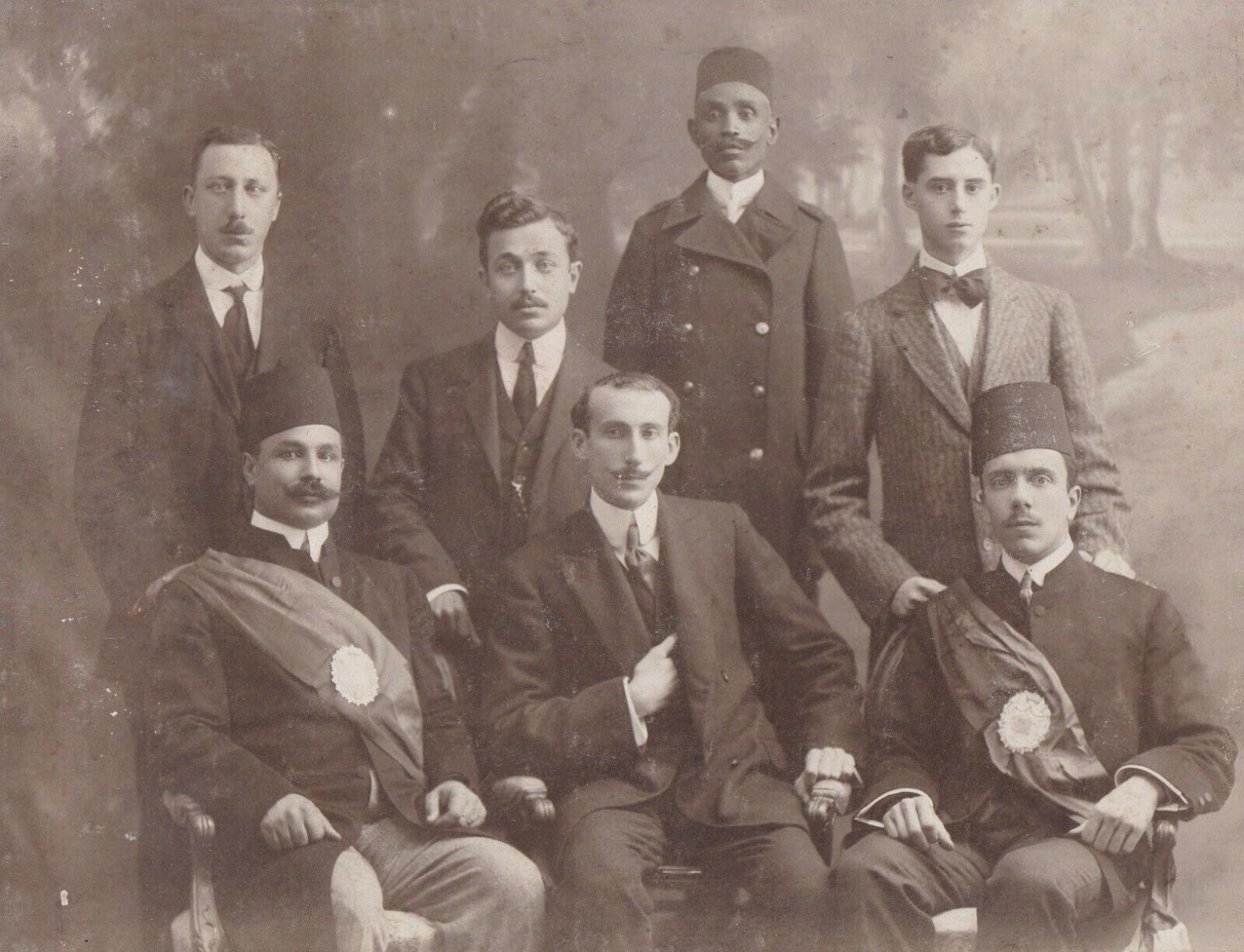
Higher resolution of the same photo of this group of Greffiersof the Court of Appeals, December 1910.

Higher resolution image of the names of those in this photograph (except the 3rd man from the left in the 2nd row wearing an overcoat.
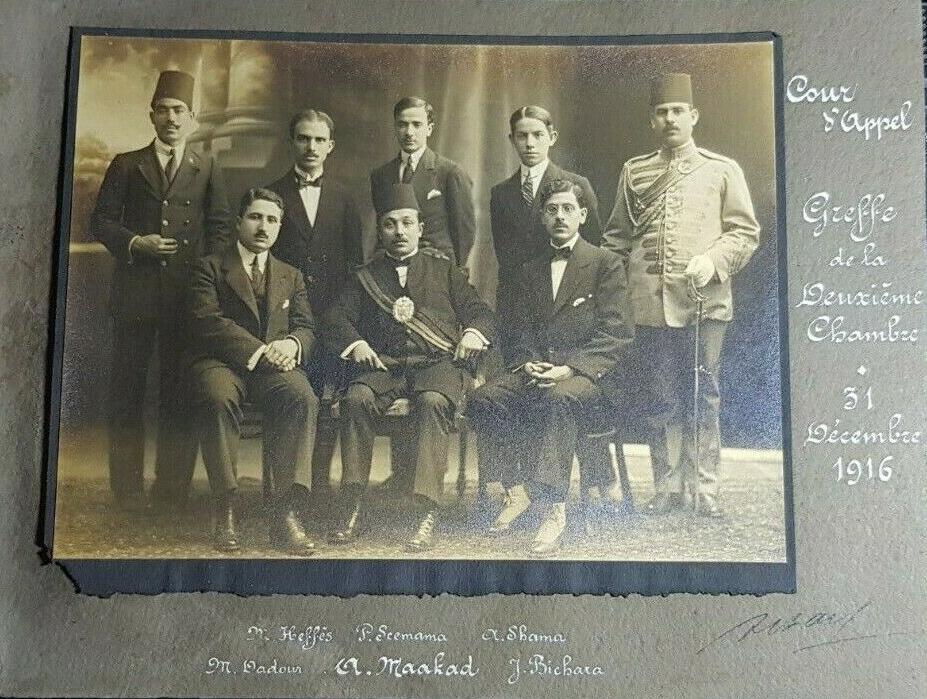
Photo of Court of Appeals, 31 December, 1916, by Alban Studio, Alexandria (Greffe de la Deuxième Chambre). Only 3 of these individuals in this photo can be identified using a photo in the Les Juridictions Mixtes d'Égypte 1876-1926 volume titled “Les Functionnaires de la Cour D’Appel” on page, pg 391 (probably taken in 1925 or 1926). Except for Adib Maakad, I have again identified their 1926 roles from the legend to that 1925 or 1926 photo in the listed identities below, because their court roles in 1910 are unknown to me. 1st row = M. Dadour (Secrétaire de la Commission du Tableau et de l’Assistance Judiciaire); Adib Maakad (probably Greffier en Chef in 1916 given his central position in this portrait, and the larger script identifying his name, as well as both of these things in the 1920 portrait of functionaries of the Court of Appeal shown below; Here, Adib Maakad also is distinguished by being the only greedier wearing the stambouline coat, tarbush, bicolored sash [with the red stripe uppermost] and judicial badge); J. Bichara (Cis-Greffier). 2nd row=unnamed court official; M. Helles(?); P. Seemama; A. Shama, and an unnamed court guard. The auction description identifies this as an original print 22 cm X 17 cm in size from the Photo Alban Studio. Note the signture of Alban in the lower right of the mat. (From: https://www.ebay.com/itm/Armenian-photographer-in-Egypt-mixed-jurisdictions-of-egypt-PHOTO-ALBAN-1916/273849768153?hash=item3fc2b7d8d9:g:d-UAAOSwCrpc3fMY)
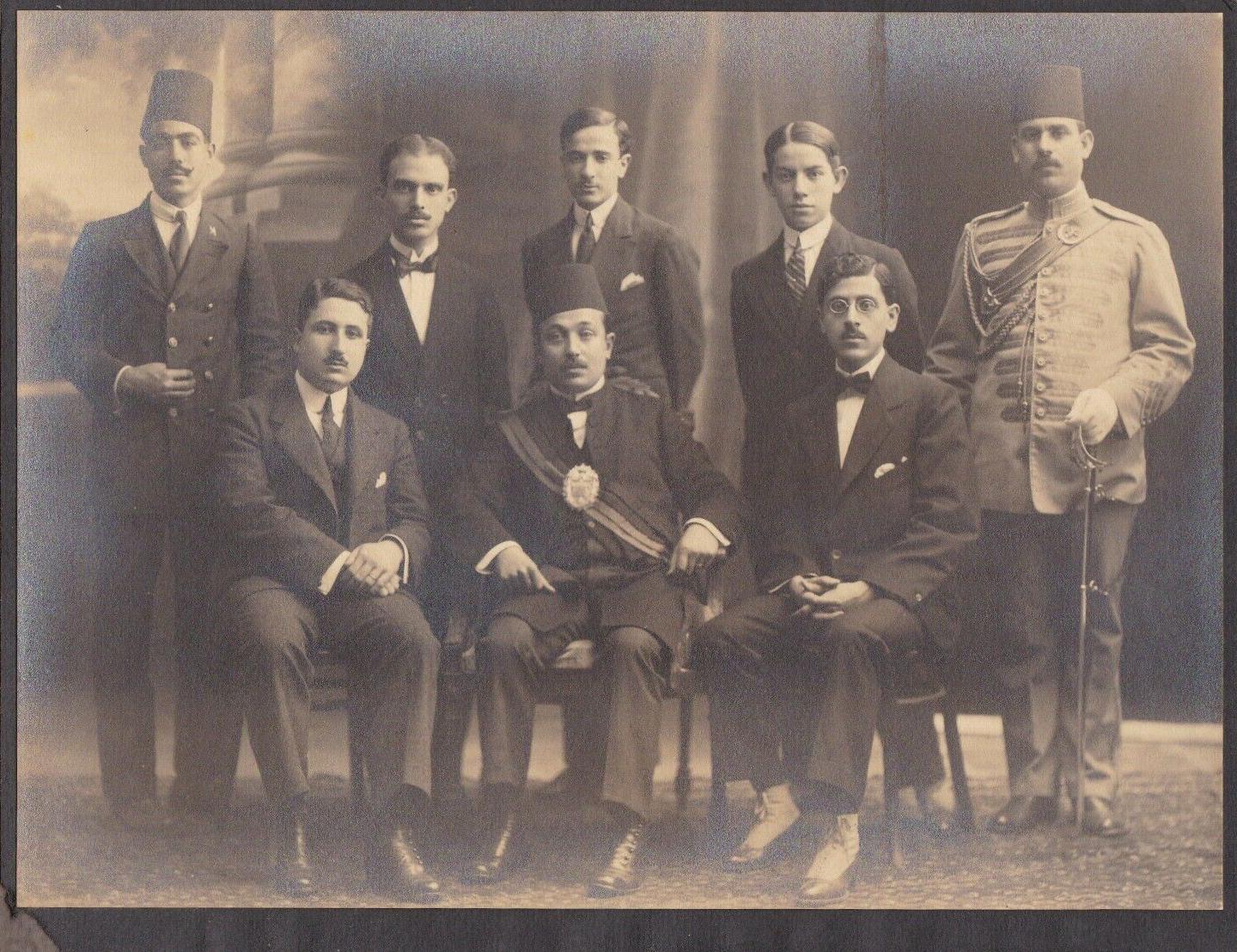
Cropped enlargement of the same portrait photo of 31 December, 1916.

Higher resolution cropped image of the names identified on this same 31 December, 1916 photo, excluding the court official 1st on the left and the court guard 5th from left in the back row.

Enlargement of the signature of Alban on the lower right of the photo mat.
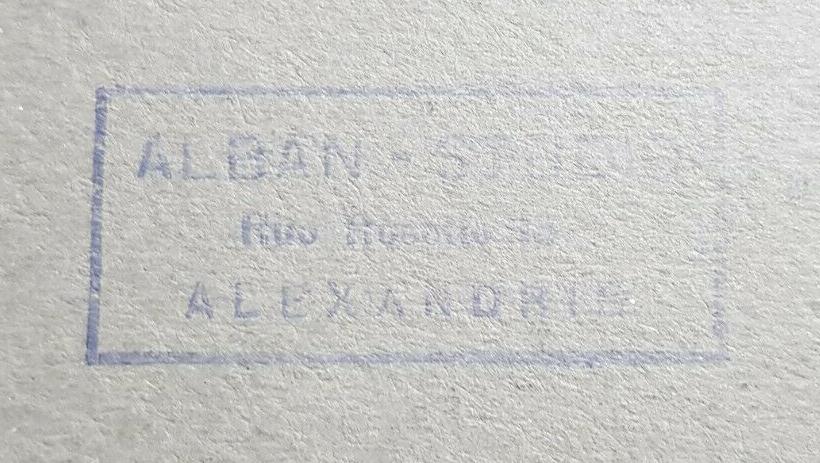
The stamp of Alban Studio in Alexandria on the reverse of this same portrait photo from 31 December, 1916.
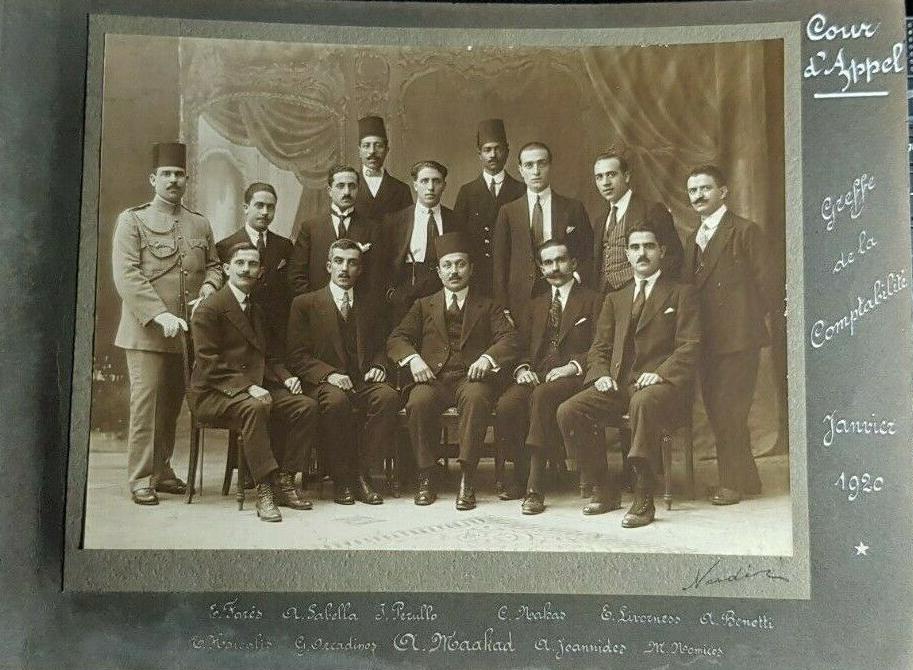
Matted portrait of Greffe de la Comptabilité (Registry of Accounting) of the Court of Appeals in January of 1920. Except for Adib Maakad, I currently have no additional information about any of the greffiers identified in this photo. 1st row (L-R) = G. Nicadimos; Adib Maakad (probably also Greffier en Chef in 1920 given his central position in this portrait, the more elaborate handwriting of his name, and that he is wearing a tarbush, as well as the position similarity to the 1916 portrait of functionaries of the Court of Appeals shown above); A. Joannides; and A. Bennett. 2nd row = Unnamed court guard; E. Farès; A Sabella; J. Perullo; C. Nakas; E. Joannides; M. Nomicos ; 3rd row (L-R) = 2 unnamed court officials. The auction description identies this an as original photo 23 cm X 18 cm in size, printed by the studio “Nader”. This probably refers to the studio of Nadir. Note the signature on the bottom right of the mat showing the correct spelling of this name. (From: https://www.ebay.com/itm/Armenian-photographer-in-Egypt-mixed-jurisdictions-of-egypt-PHOTO-NADER-1920/312613214230?hash=item48c9331816:g:GTkAAOSwEeVc3fHF)
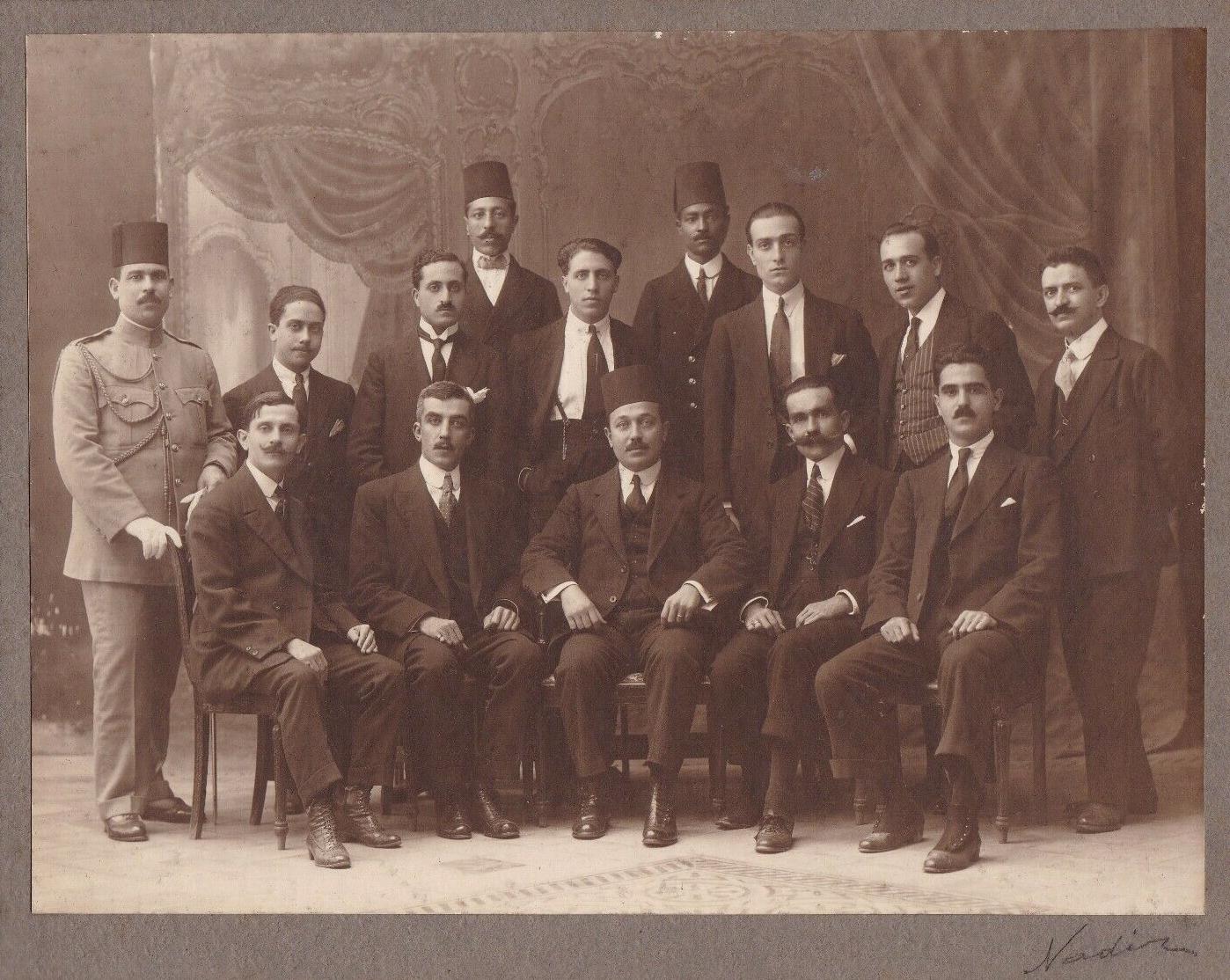
Cropped enlargement of the same portrait photo of the Court of Appeals’ Registry of Accounting, from January, 1920.

Higher resolution cropped image of the names identified on this same January, 1920 portrait photo, again excluding the court guard 1st on the left in the 2nd row and the two court officials in the back row.

Photo from 29 December, 1911 that appears to be Adib Maakad, identified serving the Court of Appeals (as greffier). Only his mustaches are anomalously long in this photo compared with all other images of him in these auction offerings. I am basing the identification on significant facial similarities and the fact that many other photos in this eBay auction listing seem to focus on Adib Maakad. He is wearing the court regalia of the high collared tunic coat, tarbush, bicolored sash (showing the decorative knot very well and worn with the green stripe uppermost), and the judicial badge (probably in silver?). This is an original print, no dimensions are given in the auction description. For obvious reasons given his costume, the eBay seller has identified this individual as a judge of the Mixed Courts. (From: https://www.ebay.com/itm/EGYPT-VINTAGE-PHOTOGRAPH-mixed-jurisdictions-of-egypt-1911-Judge-With-medals/312613296488?hash=item48c9345968:g:3DEAAOSw589c3fXS&frcectupt=true)

Cropped higher resolution image of the same portrait that is probably of Adib Maakad in his roles greffier of the Court of Appeals from 29 December, 1911.
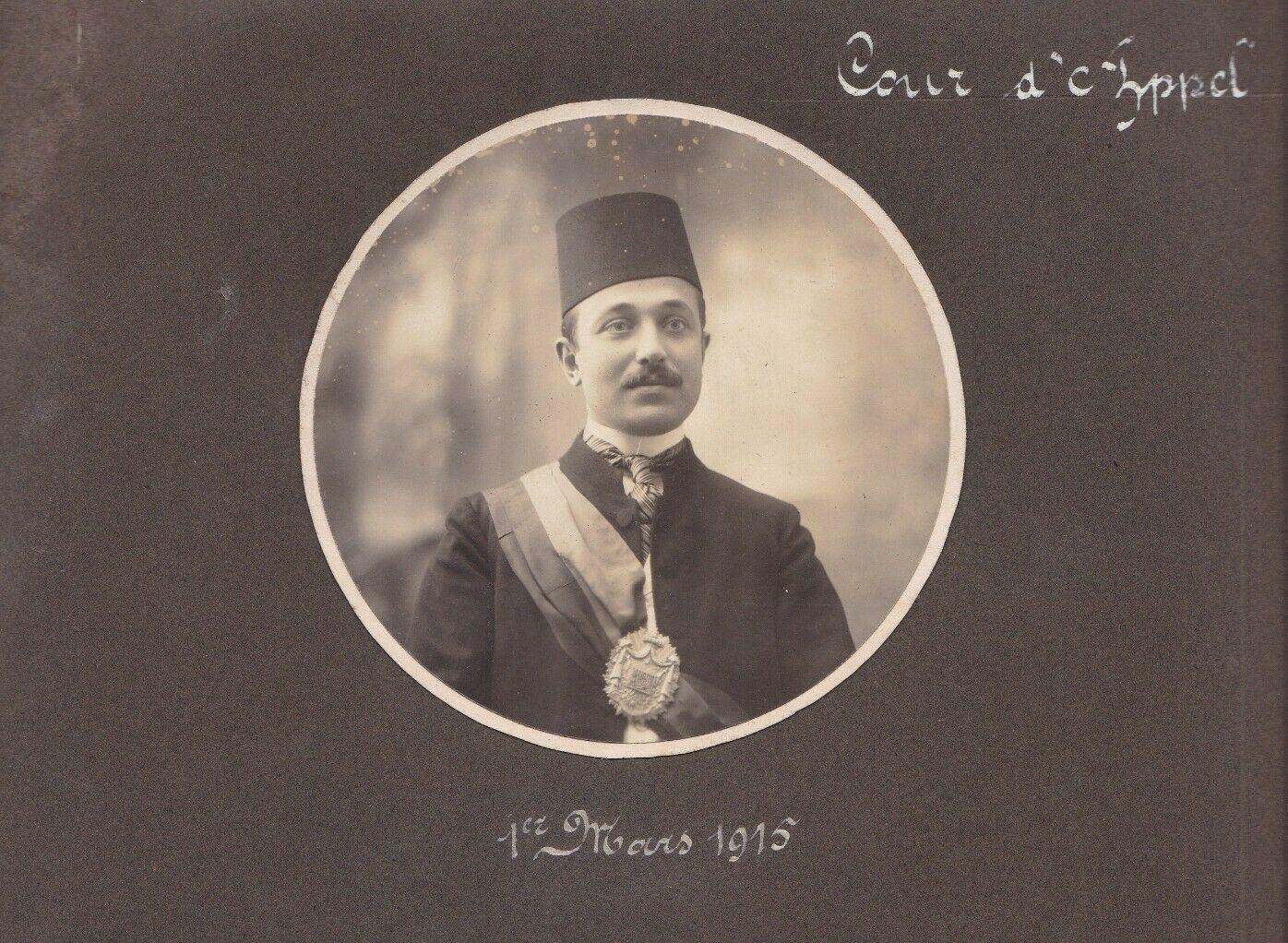
Adib Maakad identified as working in the Court of Appeals in a photo taken 1 March. 1915. Although he is not identified by name on the photo, his facial features and the large number of images of Makaad in this group of photos auctioned together on eBay indicates a grouping that included many photos of him throughout his career with the Mixed Courts. This is an original print, no dimensions are provided. For the same reasons as in the above portrait, the eBay description incorrectly identifies Adib Maakad as a judge of the Mixed Tribunals. This portrait again clearly shows the use of the stambouline coat, tarbush, along with a bicolored sash (with the green stripe uppermost) and a (silver?) judicial badge for greffiers serving the Appeals Court although the judicial costume for judges would differ in the use of a single color sash (green) and a gold judicial badge. (From:https://www.ebay.com/itm/EGYPT-VINTAGE-PHOTOGRAPH-mixed-jurisdictions-of-egypt-1915-Judge-With-medals/312613240155?hash=item48c9337d5b:g:H7QAAOSwOTZc3fR5)
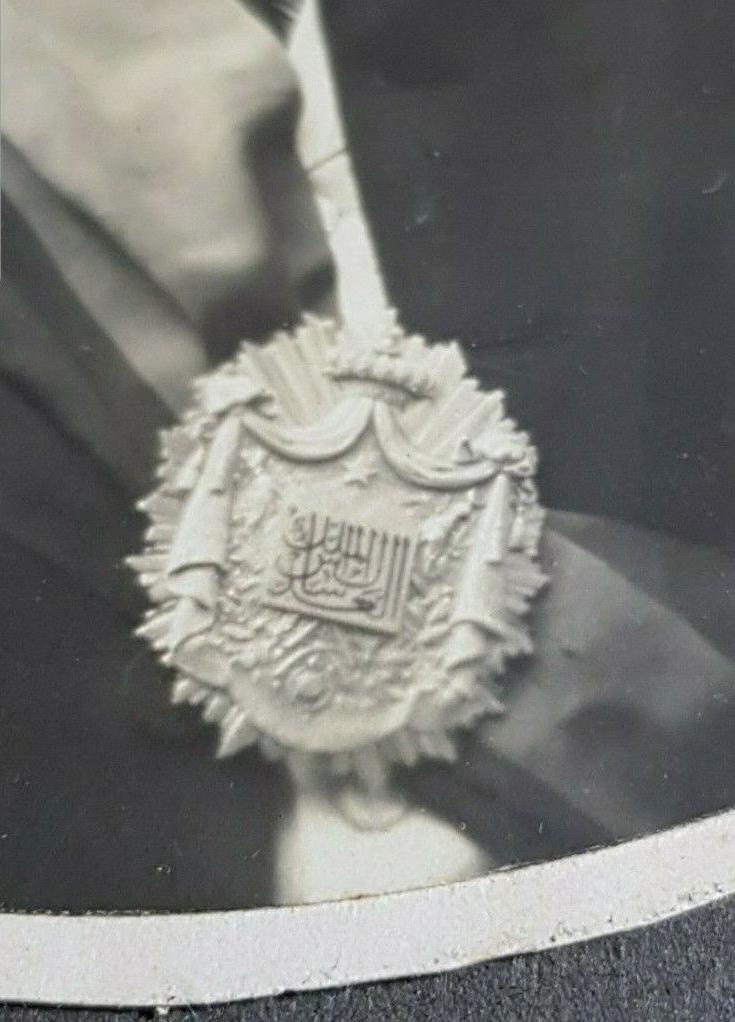
Close-up view of Adib Maakad’s judicial badge from this same 1915 portrait. The image clearly shows that the badge is silver.

Studio portrait of Adib Makaad Bey during his time working as Greffier en Chefof the District Court of Alexandria, dated Februrary, 1926. At this time period, the identification of his role from the Les Juridictions Mixtes d'Égypte 1876-1926 volume is appropriate for this date. In this image Makaad Bey is wearing white tie and a western style evening jacket with his court regalia that includes a bicolored sash (he appears to be wearing the green portion of the sash downwards) and what appears to be a gold and silver judicial badge (note the darker coloration of the central tablet with the inscription and probably the external rays of the embellishment of the badge). He also wears the 4th Class Officer medal of the Order of the Nile. The auction description identifies this as an original print that is 23 cm X 18 cm, and again identifies Makaad understandably as a judge rather than his correct role in the Alexandrian District Courts. (From: https://www.ebay.com/itm/EGYPT-VINTAGE-PHOTOGRAPH-mixed-jurisdictions-of-egypt-1926-Judge-With-medals/312613189879?hash=item48c932b8f7:g:RnwAAOSwgKtc3evi)
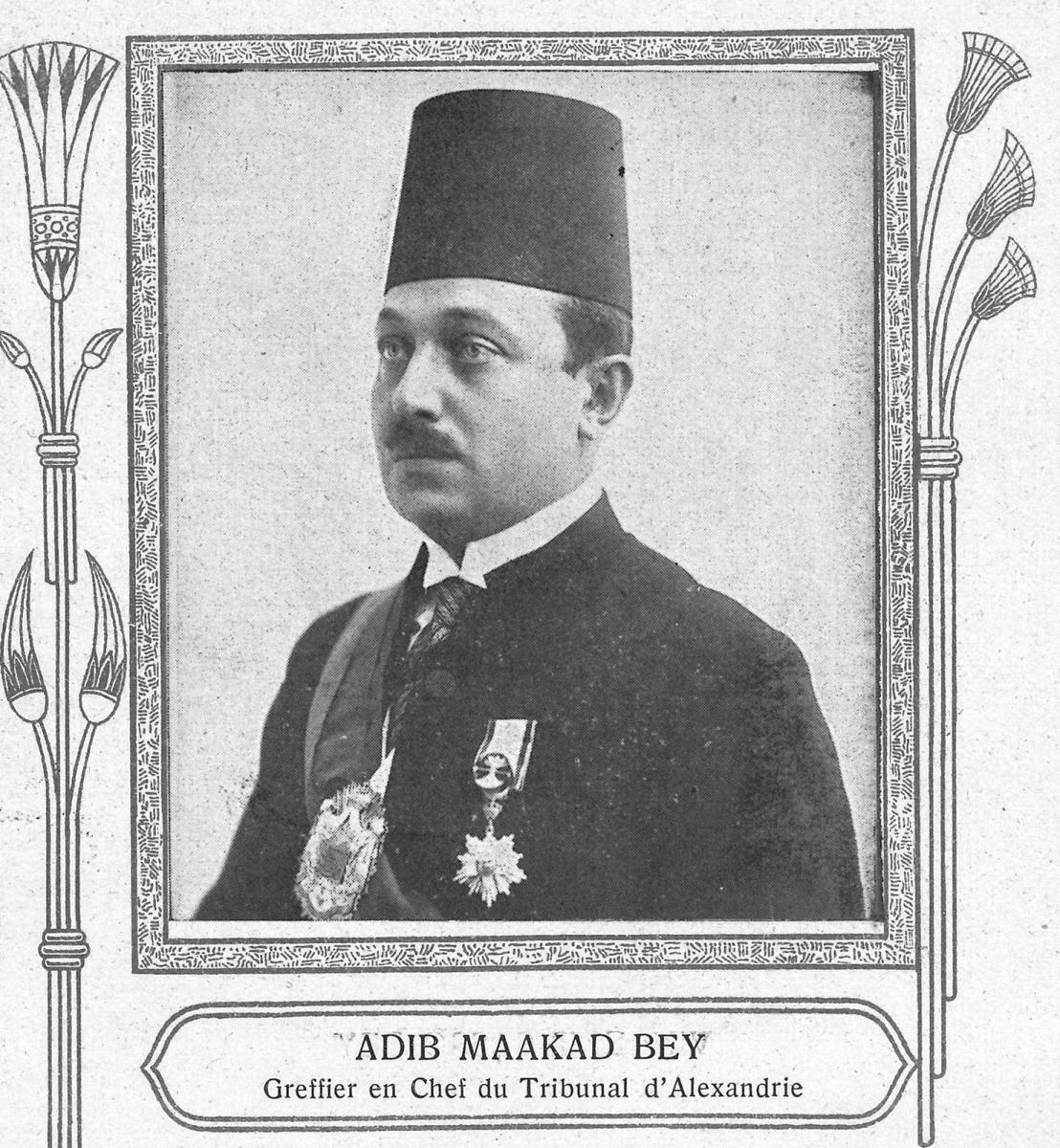
A similar portrait to the one above from Februrary, 1926 of Adib Maakad Bey in the Les Juridictions Mixtes d'Égypte 1876-1926: Livre d'or Édité sous le Patronage du Conseil de l’Ordre des Avocats á l’Occasion du Cinquantenaire des Tribunaux de la Réforme, par le: Journal des Tribunaux Mixtes. Alexandrie, Egypte, Février 1926 on page 389 in a section identifying the more senior current functionaries in the Mixed courts. In this similar image Makaad Bey is wearing the stambouline coat and a four-in-hand tie, along with the tarbush, bicolored sash (again apparently with green downwards), what appears to be a gold and silver judicial badge, and the same 4th Class Officer Order of the Nile.

Portrait that is almost certainly Adib Makaad Bey taken in January of 1929. This studio portrait again shows him in white tie and a western style evening coat rather than the stambouline coat. He also wears the court regalia of tarbush, bicolored sash (this appears to show the green stripe upwards) and what appears to be a gold and silver judicial badge. Makaad Bey also wears on his coat (from the viewer’s left–right) the 4th Class Officer Order of the Nile, the 4th Class Officer Belgian Order of Leopold II, the 4th Class Officer Italian Order of the Crown, and the Belgian (wartime?) Order of the Crown Palms (I cannot determine if they are gold or silver?). The black and white photography can make some of the ribbons difficult to identify. For example the central blue stripe of the Order of the Nile is not readily visible, the dark blue of the ribbon of the 4th Class Officer Order of Leopold II with a central black stripe appears lighter than might be expected, and the ribbon of the Belgian Order of the Crown Palms does not show the dark red central stripe in contrast with the white stripes at the edges. The eBay description identifies this as an original print with the dimensions 23 cm X 18 cm. Although a probable studio signature is visible in the upper left corner of the photograph, no studio is identified for this photo and I have not identified this photographer’s name yet. Again, the eBay listing understandably misidentifies Adib Makaad Bey as a judge of the Mixed Tribunals because of his regalia. (From: https://www.ebay.com/itm/EGYPT-VINTAGE-PHOTOGRAPH-mixed-jurisdictions-of-egypt-1929-Judge-With-medals/273857487692)
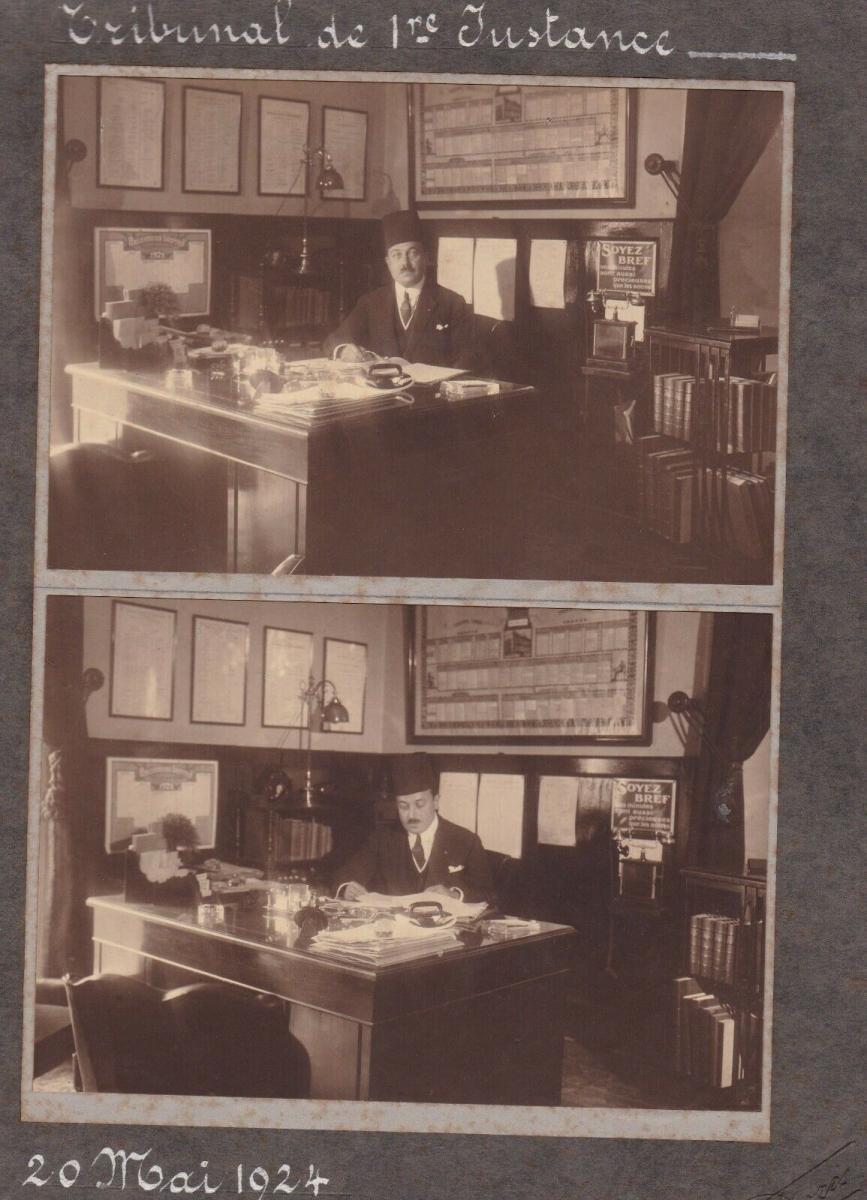
Two photos of a court official in his office of the District Court of Alexandria, dated 20 May, 1924. Although the individual not identified, it again appears to be Adib Makaad Bey, based on my assessment of this man’s facial similarity to other identified pictures of Makaad Bey (I find his eyebrows and eyes particularly distinctive) as well as the preponderance of images in this collection of photos that were all put up for sale at the same time. The eBay description identifies the individual as a judge of the Mixed Courts in these original prints whose dimensions are not given. (From: https://www.ebay.com/itm/EGYPT-VINTAGE-PHOTOGRAPH-mixed-jurisdictions-of-egypt-Judge-in-his-office-1924/312613211731?hash=item48c9330e53:g:XBEAAOSwG2Jc3fCB)
Below are 2 images of the greffiers and other court personnel, of the District Court of Alexandria. Both are dated to 31 January, 1925 (the 1st, 2nd, 4th, and 5th photos below). I am uncertain why different individuals are present in each of these 2 portraits. The second of these group photos shows a judge who is the President of the District Court of Alexandria, and several individuals' sashes in that portrait appear to possibly be a single color (indicating judges may also be present in this photo and not just greffiers or other court officials). I have seen additional images that depict some of the same individuals as in these eBay images. One such group photograph is shown in the 3rd photo below. Other photos of the District Court of Alexandria also feature the same architectural backdrop behind the court officials.
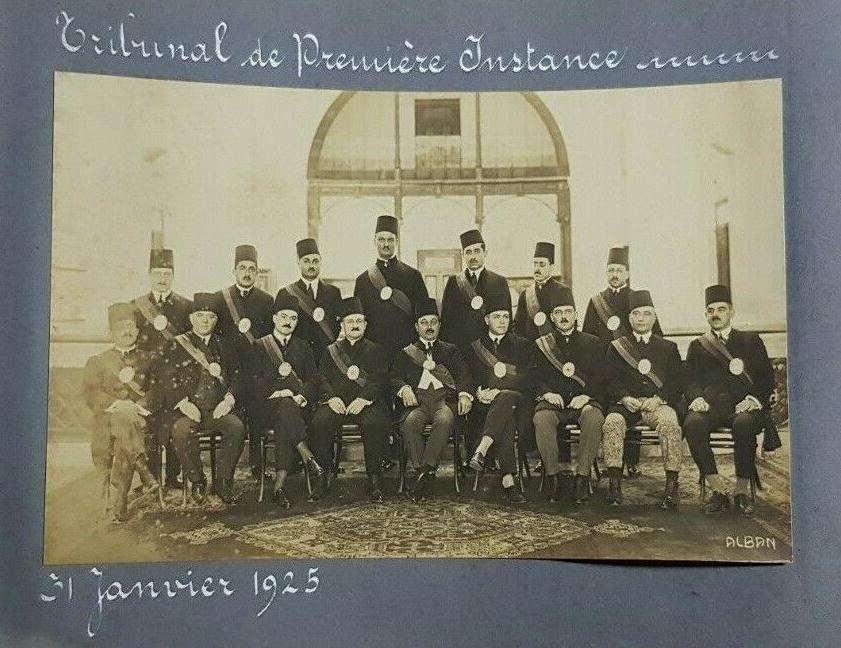
Above is the first of 2 matted photos form this same eBay auction of personnel of the District Court of Alexandria dated 31 January, 1925. All of these court officials are wearing the judicial regalia of the high collared long tunic coat, tarbush, sash, and judicial badges. All of the individuals appear to be wearing bicolored sashes, but only 5 are wearing them with the green stripe uppermost (1st row individuals 3rd, 6th and 9th from the left; 2nd row individuals 4th and 5th from the left).The eBay description identifies this as an original print by Alban Studio, Alexandria that measures 22 cm X 15 cm. As noted below, this is very similar to a photo of Functionaries of the District Court of Alexandria, on pg. 392 of the Les Juridictions Mixtes d'Égypte 1876-1926 volume (see below). All of the identifications and roles I have included here are based on the information in that 50th Anniversary volume. 1st row (L-R): ?; V. Cuzzer (Cis-Greffier); V. Anhoury (Greffier); A. Cauro (Conservateur des Hypothèques); Adib Maakad Bey (Greffier en Chef); F. Nourisson (Greffier-Notaire); C. Finardi (Greffier); J. Guarino (Cis-Greffier); and S. Mezaber (interprète). 2nd row (L-R)=?; ?; R. Loutfallah (Cis-Greffier)?; U. Finardi (Cis-Greffier); ?: J. Bichara (Cis-Greffier)?; and ? (From: https://www.ebay.com/itm/Armenian-photographer-in-Egypt-mixed-jurisdictions-of-egypt-PHOTO-ALBAN-LOT-3/273857487694?ssPageName=STRK%3AMEBIDX%3AIT&_trksid=p2060353.m1438.l2649)
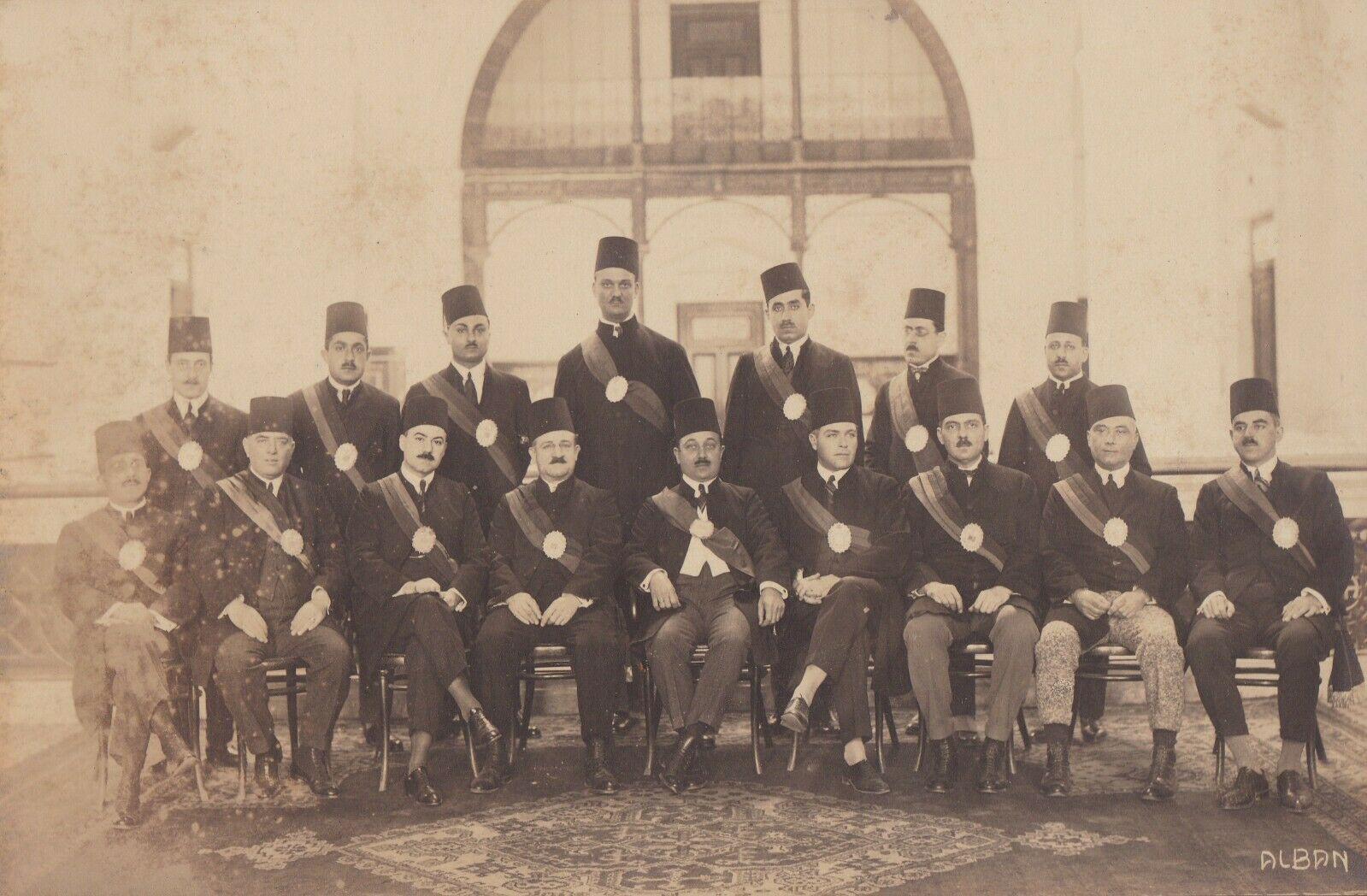
Cropped higher-resolution image of this same portrait photo of court officials from 31 January, 1925.
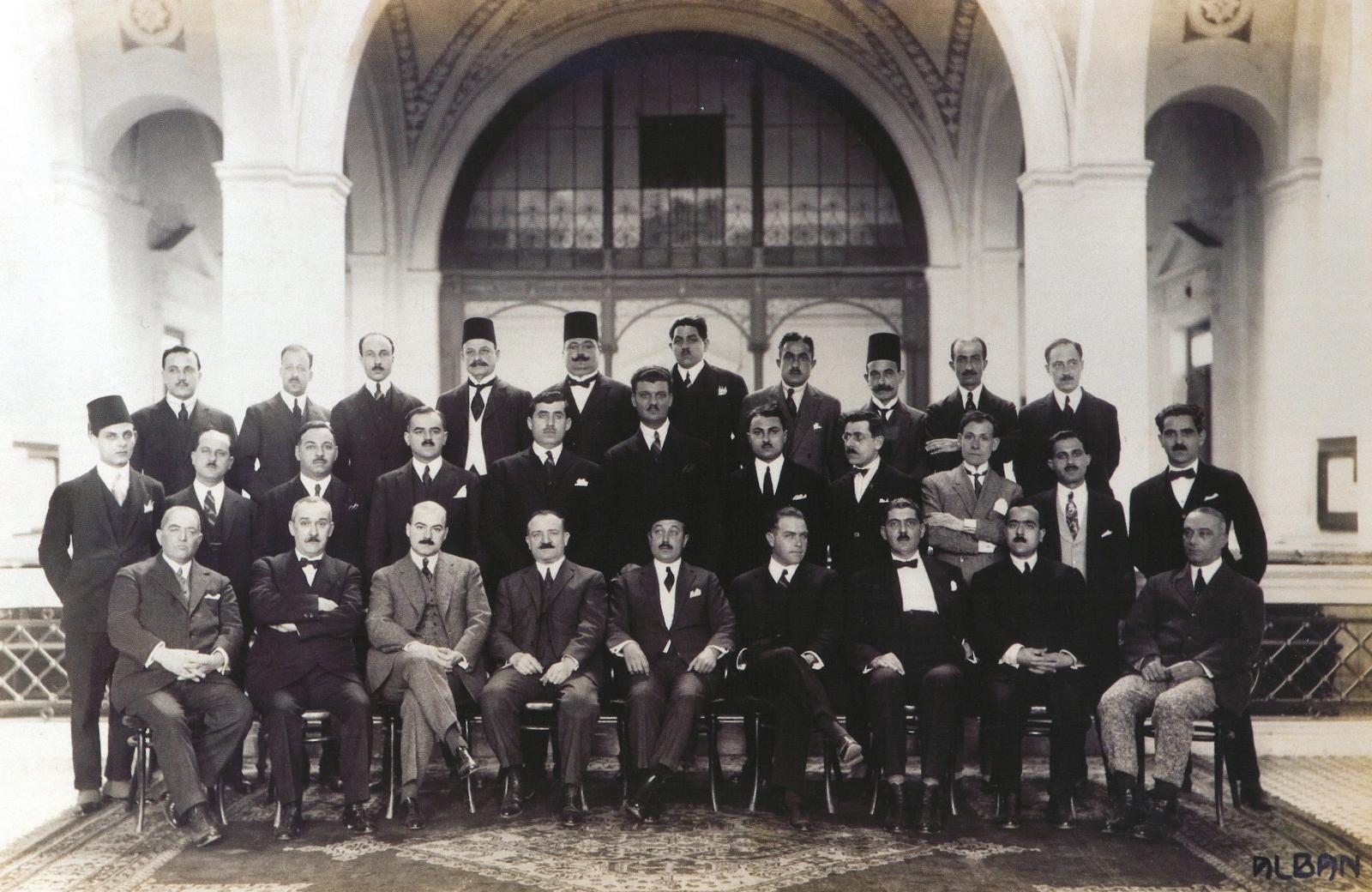
Above is a similar image of the greffiers of the District Court of Alexandria that is published in Vol 2 of Didier Hess and Rashwan’s 2016 Mahmoud Saïd: Catalogue Raisonné. The caption for this image (Plate A 201, pg. 871) identifies the group as “Members of the Mixed Tribunals, photographed by Alban, early twentieth century”. Given the other dates for the two similar images from the eBay offering, the date must be approximately the same, probably also January of 1925. This same photo is published at a lower resolution on page 392 of the Les Juridictions Mixtes d'Égypte 1876-1926: Livre d'or Édité sous le Patronage du Conseil de l’Ordre des Avocats á l’Occasion du Cinquantenaire des Tribunaux de la Réforme, par le: Journal des Tribunaux Mixtes. Alexandrie, Egypte, Février 1926 volume. That 50th anniversary publication identifies all of the individuals in the photo as: 1st row (L-R)= V. Cuzzer (Cis-Greffier); I. Rodriguez (Chef-Huissier); V. Anhoury (Greffier); A. Cauro (Conservateur des Hypothèques); Adib Maakad Bey (Greffier en Chef); F. Nourisson (Greffier-Notaire); C. Finardi (Greffier); S. Mezaber (Interprète); and J. Guarino (Cis-Greffier) in those same very natty pants. 2nd row (L-R)=M. Kedemos (Chef Dél. Hypoth. Tantah); G. Garsia (Côntroleur des Taxes); T. Khouzam (Interprète); R. Mercinier (Cis-Greffier); R. Azar (Cis-Greffier); U. Finardi (Cis-Greffier); R. Loutfallah (Cis-Greffier); J. Bichara (Cis-Greffier); C. Madaro (Côntroleur des Taxes); M. Chaoul (Cis-Greffier); and M. Nomicos (Côntroleur des Taxes). 3rd row (L-R)=M. Keif (Secrétaire de la Président); A. Sabella (Cis-Greffier); G. Rathle (Interprète); F. Awad (Interprète); V. Loutfallah (Chef Dèl. Huissiers Tantah); S. Fahmy (Interprète); M. Zalzal (Cis-Greffier); J. Azouz (Interprète); S. Serkis (Sous-Chef-Huissier); and I. Hailpern (Cis-Greffier). (From:Didier Hess, Valérie & Hussam Rashwan [eds.], 2016. Mahmoud Saïd: Catalogue Raisonné Volume 2. Drawings.Skira Editore, S.p.A., Milano. (distributed in the USA, Canada, & South America by Rizzoli International Publications, Inc. New York; distributed elsewhere by Thames & Hudson Ltd. London. ©2016 Valérie Didier Hess; ©2016 Dr. Hussam Rashwan; ©2016 Mahmoud Saïd Estate; ©2016 Skira editore).
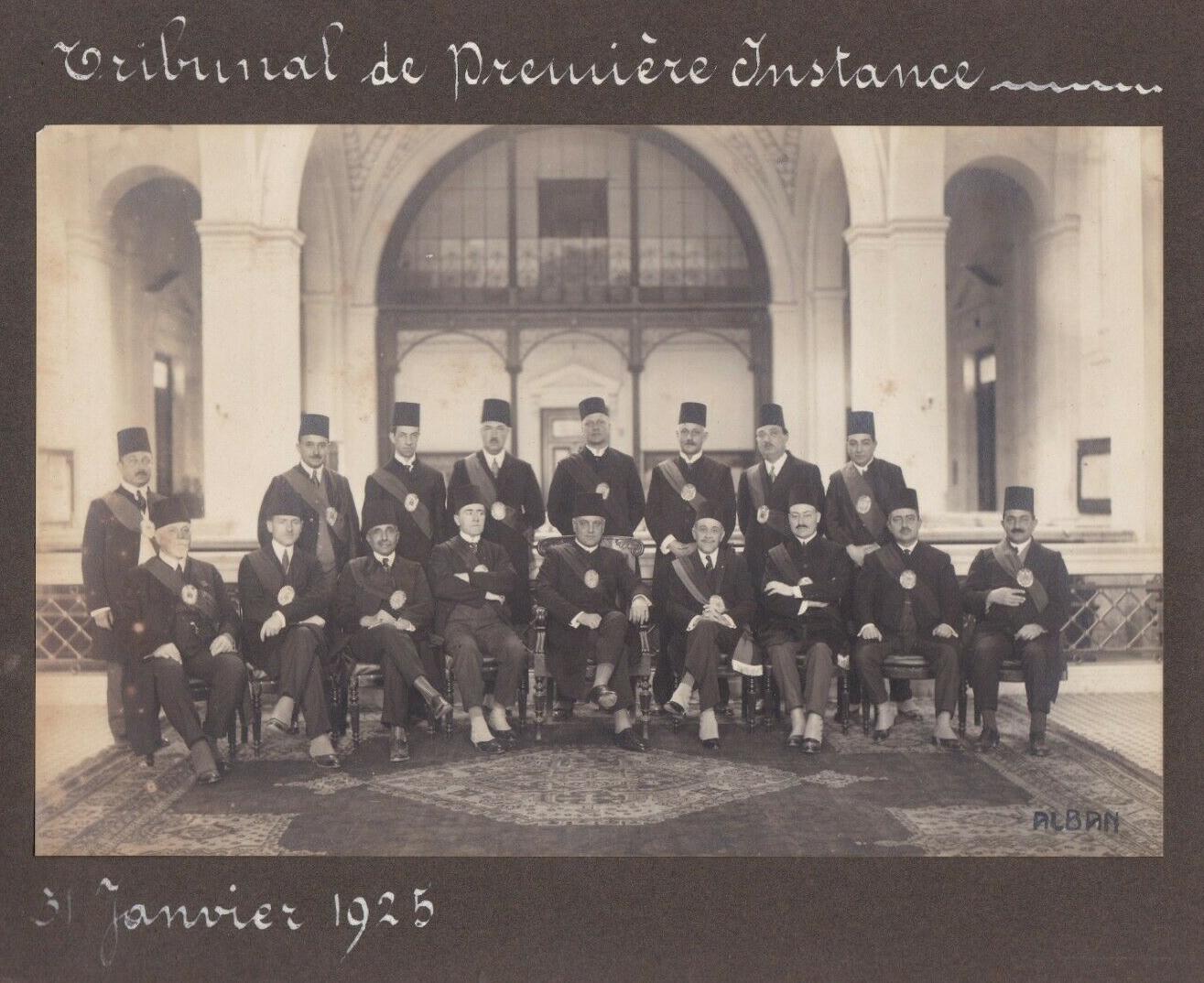
Portrait photo from the same eBay auction depicting a somewhat different group of court officials of the District Court of Alexandria that also is dated 31 January, 1925. The eBay description indentifies this as an original print by Alban Studio, Alexandria that measures 23 cm X 15 cm. All of the men appear to be wearing the stambouline coats over their suit jackets, but there appears to be mix of different sashes. Only the 6th man in the front row clearly has a red & green sash (red stripe uppermost). In the back row the 6th man appears to have a lighter colored sash. Given that the President of the District Court of Alexandria is in this image (see below), some of these individuals may be judges rather than just greffiers and other court officials. The very few identifications (only 4) I have been able to make of some functionaries in this image are based on comparisons with the versions of the above photo from Vol. 2 of Didier Hess and Rashwan’s 2016Mahmoud Saïd: Catalogue Raisonné (Plate A 201, pg. 871) and the Les Juridictions Mixtes d'Égypte 1876-1926 50th anniversary volume on page 392 that has a legend listing the court staff and their roles for that image. 1st row 1st from left - Judge Paul Joseph Randet (France); 5th from left - J. Guarino (Cis-Greffier)?. 2nd row=1st from left - Adib Maakad Bey (Greffier en Chef); 5th from left - Judge Erling Qvale of Norway, who was the President of the District Court of Alexandria at this time. Because the the Les Juridictions Mixtes d'Égypte 1876-1926 50th anniversary volume shows the Court of Alexandria seated around a table (see the 1st photo in this post), it is hard to get a good view of different judges' facial characteristics for comparison with this image. I was able to identify Judge Qvale because that anniversary publication shows him in a separate portrait that I have previously illustrated on this thread as the 2nd photo of my post of 29 April, 2019. (From: https://www.ebay.com/itm/Armenian-photographer-in-Egypt-mixed-jurisdictions-of-egypt-PHOTO-ALBAN-LOT-2/312613206728?hash=item48c932fac8:g:MGEAAOSwOxZc3e81)
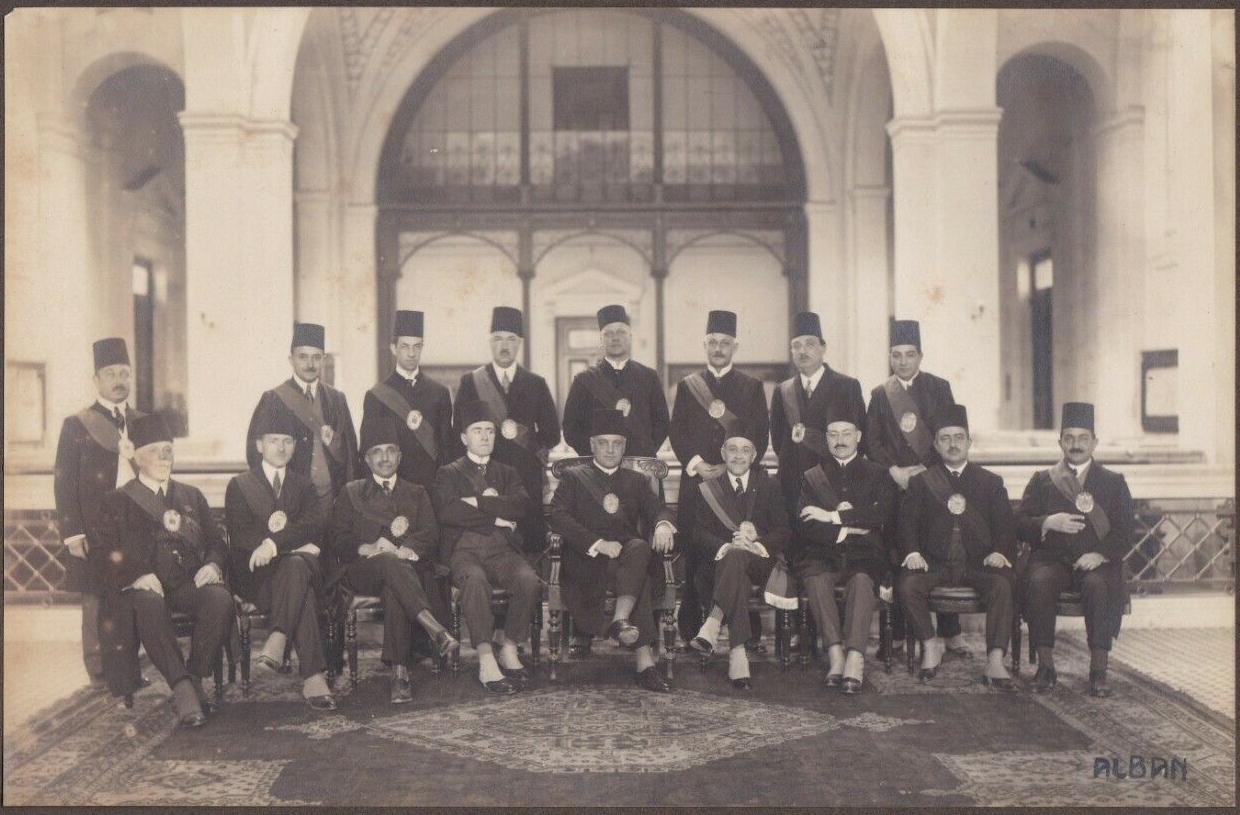
Cropped higher-resolution image of this same eBay portrait photo of this second group of court officials from 31 January, 1925 by Alban Studio.
0 -
I had a discussion with a friend who feels that the last photo of a man wearing the 4th Class Knight Order of Ismail and other awards with his Royal Guard uniform in my most recent post of 29 August 2019 is not a younger version of Osman El Mahdi Pasha. The 3rd individual from the left on the couch in the Life photo (2nd-to-last photo in my 29 August post), probably from 1944, was identified by a contributor to Zeinab Mohamed's Flickr photostream (not by Hassan Kamel-Kelisi-Moralias as I originally posted, but by Mohammad Ahmed) as Osman El Mahdi Pasha. My friend does accept this identification in the Life photo. My friend's objection is that the eBay photo is probably not the same the man as seen on the couch seated next to Omar Fathi Pasha. His objection is that El Mahdi would not have been invested with the kinds of awards shown in the eBay photo at such a potentially younger age as the man in this image appears to be. He also is uncertain whether El Mahdi was in the Royal Guard at that age as well. One reason I feel this may be the same person is that the Life images shows a 4th Class, Knight, Order of Ismail, a 4th Class, Officer, Order of the Nile), and apparently the medal and ribbon for the Italian Order of the Crown, although most of the other medals are very difficult to distinguish. I still think there is a fair facial similarity, and the greater number of medals in the Life photo still suggests to me an image of the same man as in the eBay photo, just at a later age with additional awards. Does anyone in the GMIC community have any additional information about Osman El Mahdi Pasha that is relevant to this question? For comparison, below is an enlargement of the individual in the Life image (however, this still is not a high resolution image) shown in the 2nd to last in my most recent post on this thread (of 29 August, 2019) seated 3rd from the left that is identified as Osman El Mahdi Pasha.

(Cropped image of Osman El Mahdi Pasha from an image by Life, archived on Zeinab Mohamed's Flickr photostream: https://www.flickr.com/photos/96884693@N00/3086912058/)
0 -
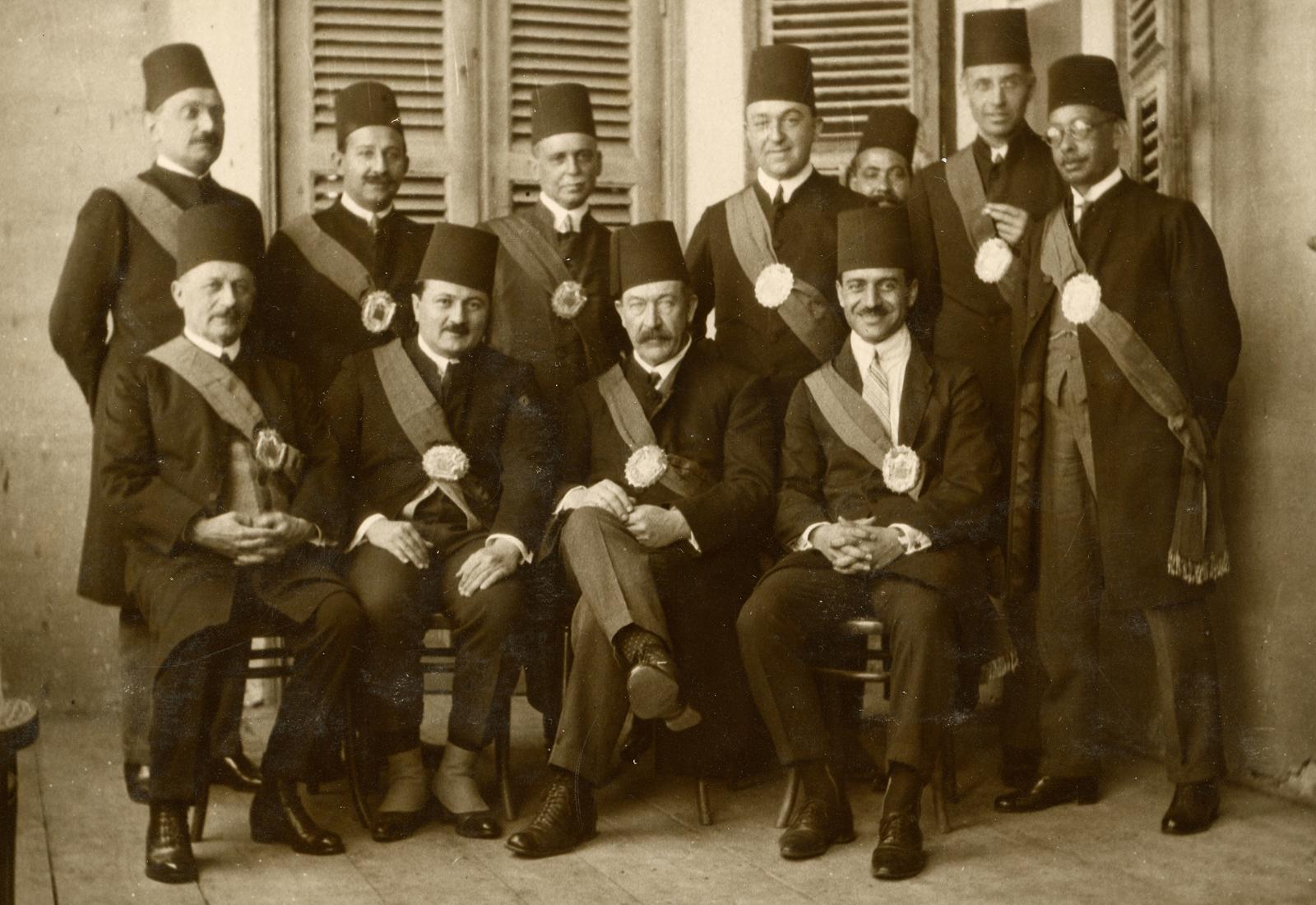
Above is a picture of one of the Egyptian Mixed District Courts from a flickr photostream of EivArch (https://www.flickr.com/photos/78721541@N00/8584780971/in/photostream/). This photo can be zoomed for greater detail. The photostream identifies the 3rd man from the left in the 1st row as Halvard Heggen. It appears this may be the District Court of Mansourah, taken sometime before 1926, probably between 1922 and 1925 (see the images of their court from 1926 in my post of 5 March, 2019, with all individuals identified, but at a lower resolution that the version I posted on in my last post here of August 2019; and in my post of 21 August, 2019, a higher resolution image bit with all the individuals identified). The Les Juridictions Mixtes d'Égypte 1876-1926 volume identifies Halvard Nicolaï (or Nikolaï) Heggen as a judge from Norway who was appointed to the District Court of Mansourah in January of 1903, and was transferred to the Court in Alexandria in November, 1906. He was re-appointed to the District Court of Mansourah in August of 1922, then transferred to Cairo in November of 1925. Heggen died in Cairo in January of 1926. I believe this is the District Court of Mansourah because at lest 3 individuals are present in this image who also appear in the 2 versions of the image of the Court of Mansourah that I have posted before (that probably was taken in 1926). The first person on the left in the 1st row is Julien Sheridan of Belgium (he is wearing the same vest as in the 1926 photo of the Court of Mansourah). The second man from the left in the 1st row is Ahmed Mazloum Bey (also shown in the Mahmoud Saïd portrait illustrated as the 2nd image of the of 21 August, 2019 post) and the 4th man from the left in the 2nd row appears to be Maurice de Wee of Belgium, who was the Vice-President of the Mansourah Court beginning in 1925 (also shown in a sketch portrait by Mahmoud Saïd in the 3rd image of my 21 August, 2019 post). In the second row, the man 2nd from the left may be Hassan Kamel (Egypt, Substitut du Procurer Général), who is standing in the same position in the 1926 photo shown above in the 1st photo of my 21 August, 2019 post). The apparently Egyptian man seated at the far right in the 1st row is the only individual with a bicolored sash, suggesting he may be a member of the Parquet or a functionary of the Mansourah Court. All of the other individuals in this photo are wearing a single color sash (red) and the badges of several men appear to be gold & silver, the design for the District Court judges' badges.
0 -
I believe that I have found identifications for 2 individuals I have previously illustrated on this thread wearing the Order of Ismail. On 31 October, 2018 the first photo of my post shows an individual identified only as a Royal Guard wearing the 4th Class Knight Order of Ismail. In a post of 23 March, 2019 I was unable to identify the man in the 2nd photo showing another uniformed individual wearing the 3rd Class Commander's neck badge of the Order of Ismail. I am including those previous photographs below with my probable identifications, along with a couple of additional images showing both men at different ages, if these identifications are correct. Except for the first image, all of the other photos can be zoomed for greater details.
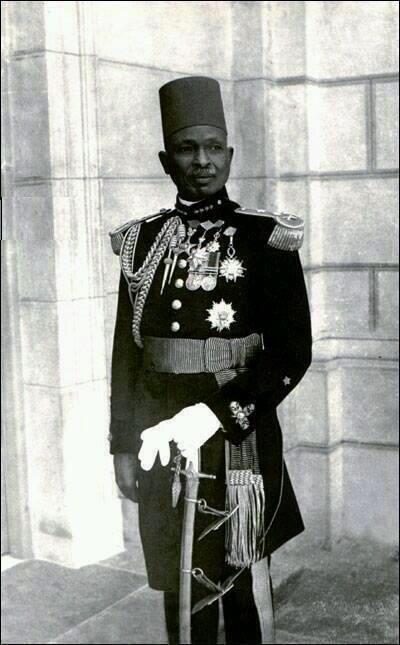
This above image (from: https://www.pinterest.com/pin/107945722297247055/) is one of these "unidentified" men that I posted on 23 March, 2019 without an information about who he was, nor the date of the photograph. This same photograph appears on several Arabic language websites with an apparent identification. This individual wearing a military uniform and a neck badge of the Commander Class (3rd) of the Order of Ismail (in addition to 6 other decorations) appears to be a well-known person. Most of the information I have been able to find is in awkward translations from Arabic websites, but I will try to outline what seems relatively secure bit of information about this person. I believe this is Abdullah Al-Nagoumi Pasha ("Nagoumi" is the preferred spelling among many appearing in English language texts), dressed in a uniform that 922F commented on 23 March, 2019 as likely being that of the Anglo-Egyptian Sudanese Condominium military services. I have been informed by an Egyptian friend whose grandfather served with Nagoumi Pasha in the Sudan that the uniform is actually similar to a Field Marshall uniform that the king wore, except that it has only 1 star on the sleeve instead of 3, as did the king's. He stated this is a uniform worn by high officials of the state to be worn on official state occasions (i.e., the opening of Parliament). My friend indicated this is the highest class of dress uniform, aside form the mess dress of evening wear. To the viewer's right of the Order of Ismail is an Order of the Nile (the 3rd Class, Commander's neck badge). 922F also identified the medals I am unfamiliar with in that same post as: "Jordan Independence, and Iran Taj [Crown]. Two breast medals appear to be UK Sudan & Khedive's Sudan. Star too washed out for me - maybe Jordan Independence". I also was told by the same Egyptian friend cited above that Nagoumi Pasha was certainly invested with the neck badge of the Order of the Crown of Iran (Nishan i-Taj-i-Iran) by Prince Reza Pahlavi, during his visit to Egypt to marry Princess Fawzia (see the 2nd photo, and the last image of the banquet in my post of 2 April, 2019 on this thread for an images of this event). Both of the first 2 websites cited below include the above photo and identify it as Abdullah Al-Nagoumi (there are probably addition Arabic language sites with this photo, but I am having trouble accessing them a second time to check through Google image search). A translation of the information on the website http://egyhistory.com/الحملة-العسكرية-على-السودان-1820م/ identifies him with the title “Major General”, however, it appears likely that he served in a brigade under Major General Muhammed Naguib, rather than holding this rank himself. The egyhistory.com website states that he served as the head of the Royal Guard until 1952, and then held a post as a board member on the first Fuad Institute for Desert Research. At least two additional Arabic language websites feature this same photo and contain apparently identical biographical texts with other details about Abdullah Al-Nagoumi Pasha: http://www.ahram.org.eg/News/51466/121/362829/تراث-و-حضارة/«عبد-الله-باشا-النجومى»-المثقف-الموسوعى.aspx. Both of these texts, and other sources, provide a range for his birth between 1880-1885 and identify his father as an Emir in the Madhi revolution, Abdul Rahman Al Nagoumi , who was killed in the Battle of Toshka on 3 August, 1889 (http://sudapedia.sd/en/content/399). Allegedly, young Abdullah was discovered asleep in the vicinity of the battlefield, taken by the army and handed over to Khadio Tawfiq. Abdullah was educated in the royal palaces and graduated from the military academy in 1918. He subsequently served with the brigade of Major General Muhammed Naguib. The translation available to me for this text is unclear about his subsequent career. However, it appears he may have had a role in relation to King Farouk I’s interest in hunting and a later association with animal conservation after the 1952 revolution. A couple of additional photos have turned up in my searches, both attached below, that may show what appears to be Abdullah Al-Nagoumi Pasha as an older man in a military uniform with King Farouk I. The facial features in these images of an older man to the viewer’s left of King Farouk I (shown below) are very similar to the earlier image above I previously posted. One other image from the news magazine Life also appears to show Abdullah Al-Nagoumi with other members of the Royal Guard in one of the Royal Palaces (Abdine Palace?)
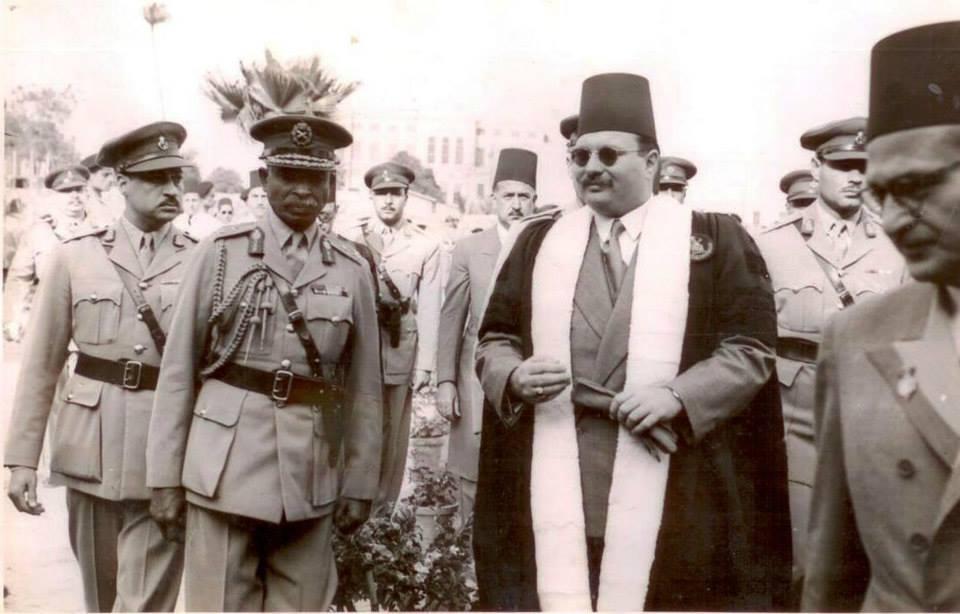
The above undated images shows the individual to the viewer's left of King Farouk I that I believe may be an older Abdullah Al-Nagoumi Pasha than shown in the above photo I previously posted of him. However, I would be interested if other individuals have a different identification of this man in a military uniform. I do not know the date of this photo and the next one below. A dated photo of King Farouk I attending the 25th anniversary of King Fuad I University in 1950 shows him in a darker suit than this one, although his mustaches and the dark glasses are identical. It is possible this is a different event associated with that jubilee celebration, but I currently cannot date this image. King Farouk I is wearing the ceremonial academic robes associated with his role as President of King Fuad I University (originally named as Egyptian University from its founding in 1908 until 1940, renamed as King Fuad I University from 1940 until 1952, and then renamed as Cario University [Gām‘et El Qāhira] after 1952 to the present). I illustrated a commemorative medal celebrating the 25th jubilee anniversary of King Fuad I University (1925-1950) showing busts of both Fuad I and Farouk I on the obverse face in my post of 22 July, 2018 on the GMIC thread "Egypt Khediveate Judge's Badge question" that I started on 17 November, 2016 here in the Middle East & Arab States section. Several other photos of King Farouk I's attendance of this jubilee also show him in the same Presidential academic robe. (From: https://www.pinterest.com/offsite/?token=165-195&url=https%3A%2F%2Fi.pinimg.com%2Foriginals%2F6f%2F9a%2Fe1%2F6f9ae18bbb8cf019606b0966395a221f.jpg&pin=4222193379989428&client_tracking_params=CwABAAAAEDcxMzE2OTI2MTk4MjE0NDYA~0)
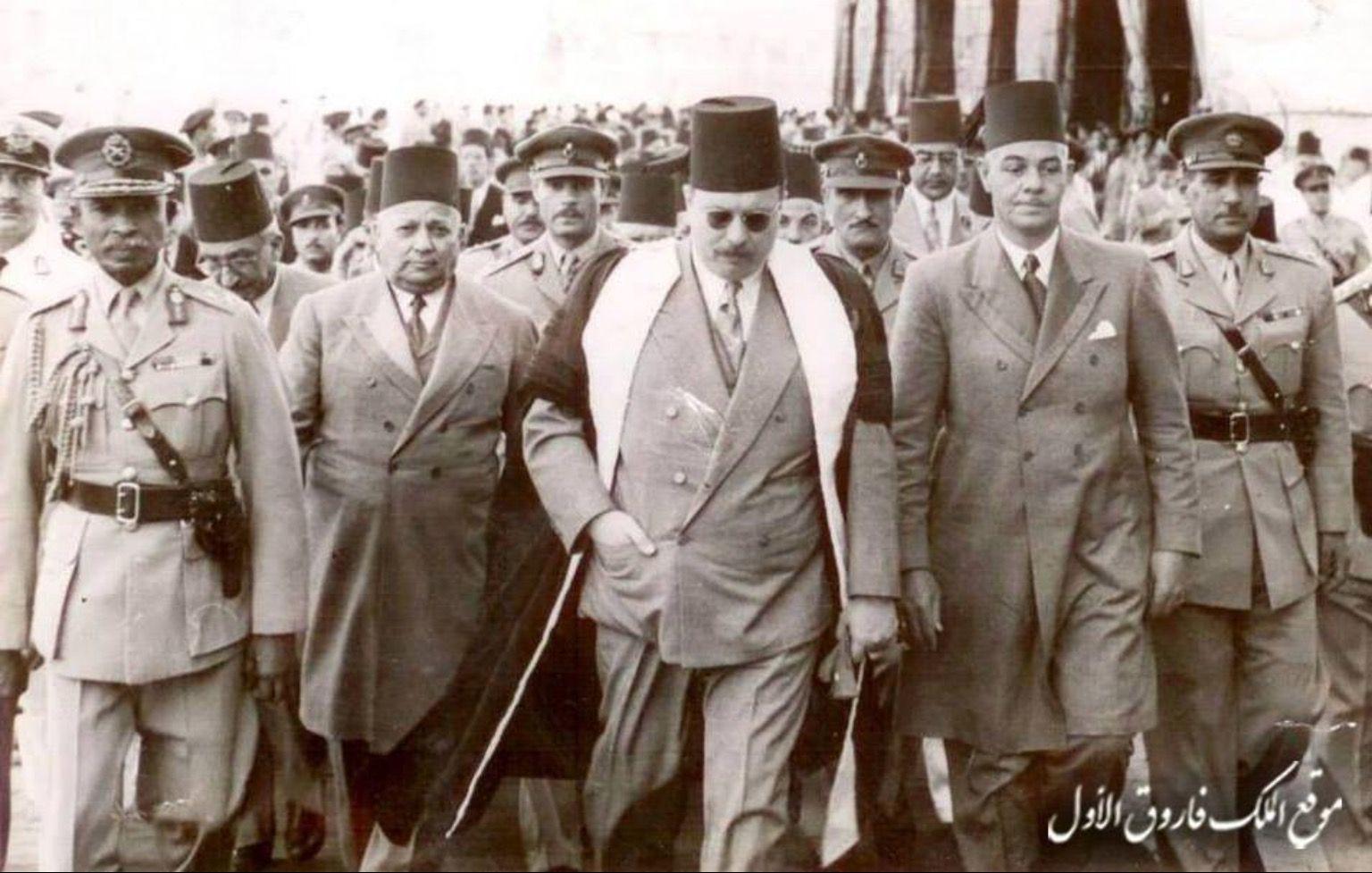
Another photograph, probably from this same event with King Farouk I wearing the Presidential academic robe of King Fuad I University, that shows the same man 2nd from the viewer's left of King Farouk I that I believe is the older Abdullah Al-Nagoumi Pasha. (From: https://i.pinimg.com/originals/2d/72/e4/2d72e40ee2bbe5a708ee6febde96fb2d.jpg)

This is the text associated with a version of the above image. I do not know if the Arabic provides any additional information about the photo. (From: https://i.pinimg.com/originals/2d/72/e4/2d72e40ee2bbe5a708ee6febde96fb2d.jpg)
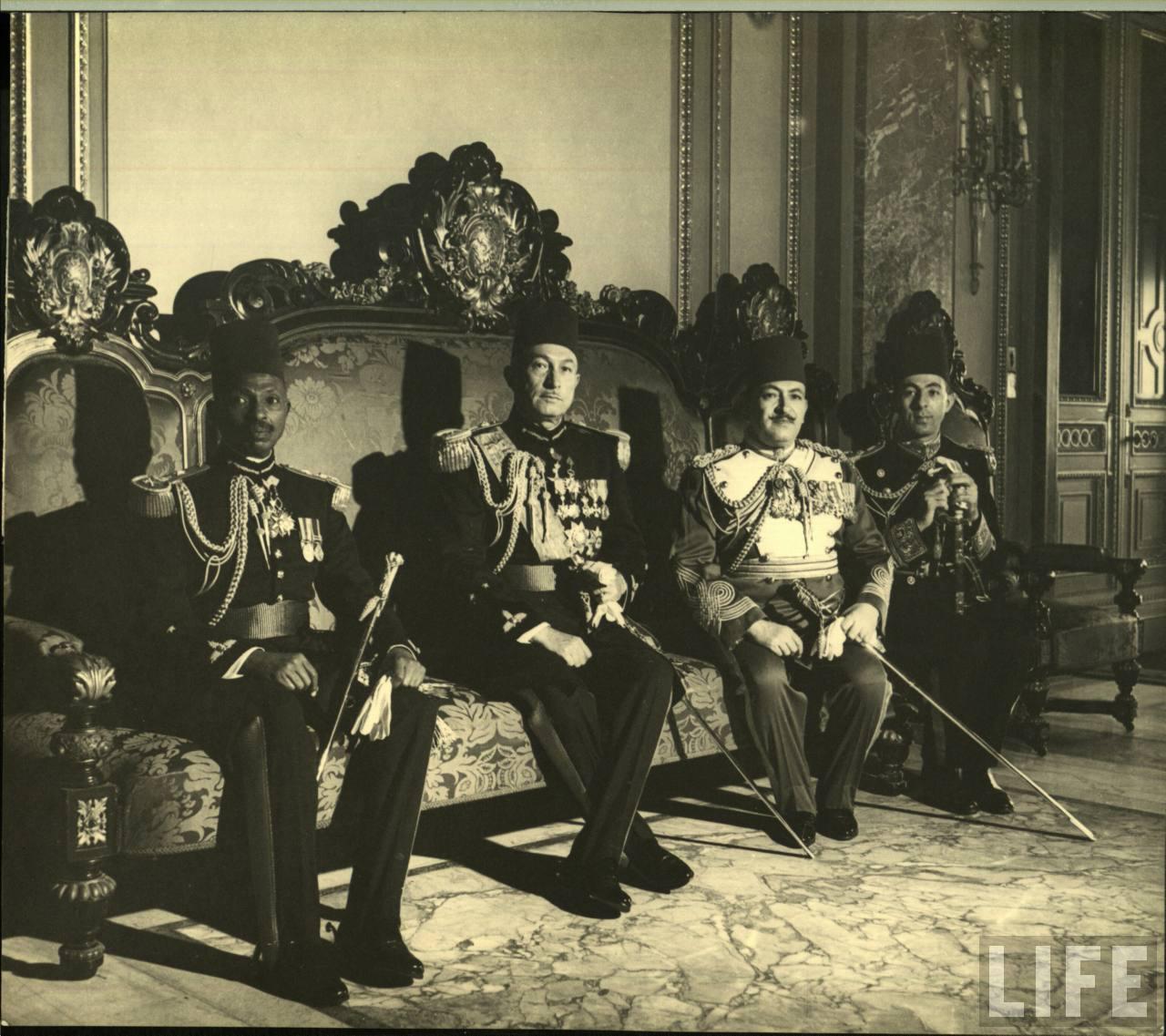
Photograph from the American magazine Life, showing an image of a younger Abdullah Al-Nagoumi Pasha at the far left on the couch, wearing the same dress uniform as in the first photo above. Nagoumi Pasha is not wearing his Order of Ismail (probably indicating this is prior to the award of the Order of Ismai), and appears younger than in the 1st photo above. He is wearing 4 of the same medals seen in the first image posted here: the 3rd Class Order of the Nile, the Order of the Crown of Iran (Nishan i-Taj-i-Iran), the Egyptian Khedive's Sudan medal, and what I believe is the the British Sudan Defense Force General Service medal (indicated by the ribbon configuration, exhibiting the wider central blue stripe than seen in some examples, bordered by yellow stripes and the outer black stripes are not visible in this and the above photo of Nagoumi Pasha). Hassan Kamel-Kelisi-Morali has identified the 3 men on the left in this image on Zeinab Mohamed's Flickr photostream as (L-R): HE Abdullah Al-Nagoumi Pasha, HE Omar Fati Pasha (and a contributor, Metro50, identified him as the King’s aide-de-camp); and Osman El Mahdi Pasha. The man on the far right is unidentified. Of additional interest in this photo, Osman el Mahdi is wearing on the viewer's left center of his uniform the 4th class Order of Ismail (with a ribbon bearing the rosette) and the 4th Class Order of the Nile (also showing the ribbon with its rosette). I cannot distinguish the other medals he is wearing. I believe that the photo I posted on 31 October, 2018 of an individual identified only as a Royal Guard may be a younger image of Osman El Mahdi Pasha. I do not yet know whether this photo was published in Life magazine, if it is part of photography taken by Life staff but not included in magazine publication, or used in some other Life publication. An article in the edition of Life from 10 April, 1944 of a unique set of photos from Abdine Palace (pp 85-93) shows various behind-the-scenes with service staff, but principally features the kitchen and dining room staff. 1944 is the most probable date for the above photograph. Several images of Abdine Palace with attributions to Life (as in the lower left of the above photo) appear to be associated with a date of 1933, but Najumi Pasha and El Mahdi Pasha only worked for King Farouk I, and were never in the service of King Fuad I. I cannot yet locate the publication or other reference for those 1933 images either . (From: Zeinab Mohamed's Flickr photostream: https://www.flickr.com/photos/96884693@N00/3086912058/)
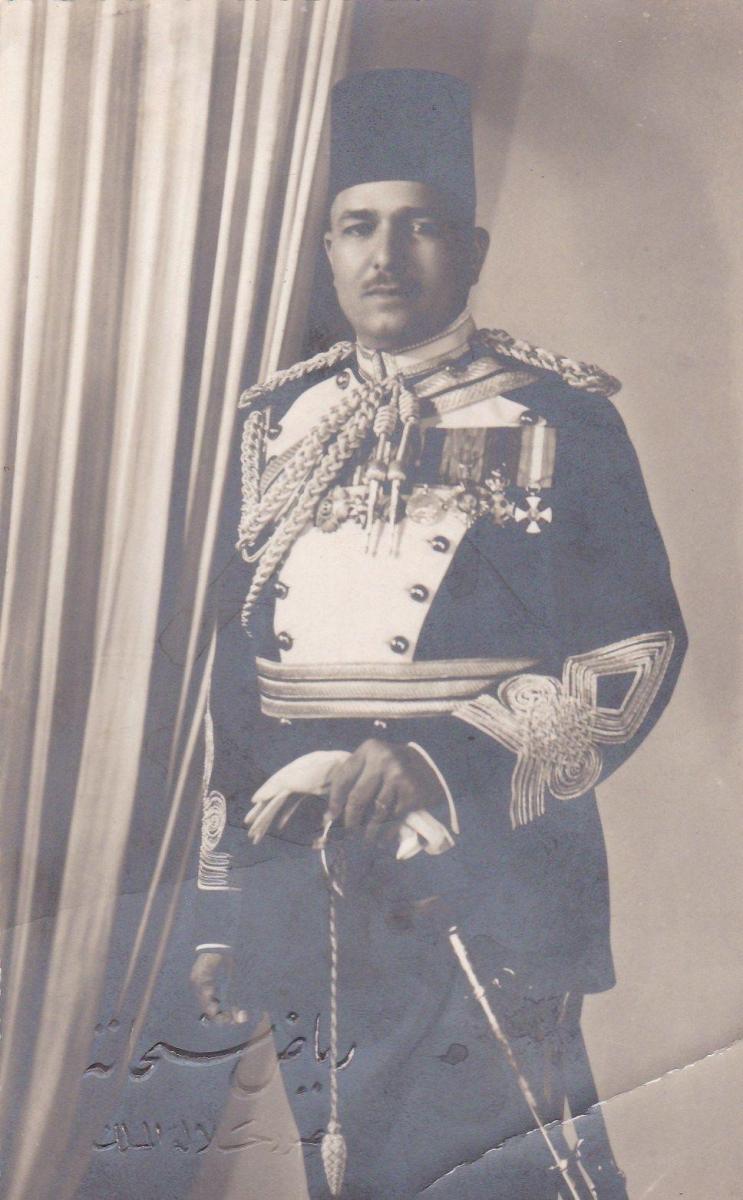
Above is the image I posted on 31 October, 2018 in this thread showing an unidentified man in a photo offered on an eBay auction. This photo is from the Riad Shehata Studio in Cairo, the official photographer to King Fuad I and King Farouk I. I do not know the founding date of the studio, but it did continue under that name for an unspecified time after Riad Shehata's death in 1942. I currently feel that this may be an photo of a younger Osman El Mahdi, shown in a somewhat later photo in the Life magazine image above. Although his mustaches are smaller in this eBay photo, several aspects of his facial features (especially his chin) are extremely similar. The individuals in both photos are wearing identical uniforms (this is Royal Guard uniform design was created by King Fuad I when Egypt became a Kingdom in 1922), and this earlier image shows several medals that also appear in the Life photo, although the low resolution of that photo makes identification of the additional awards very difficult. The Life photo clearly shows the rosettes on the ribbons for the Order of Ismail and the Order of the Nile that are partially obscured in this photo. 922F identified a couple of the medals in this photo that I did not know in his post on this thread of 31 October, 2018. He identified the 3rd medal (to the viewer's right of the Order of the Nile) as either the Egyptian Medal for Meritorious Actions or the Medal of Devotion; we both identified the 4th as the Khedive's Sudan Medal; 922F id'd the 5th as the Iranian Order of Homayoun [Humayun]; the 6th as the Belgian Order of Leopold II; and we both identified the 7th as an Italian Crown. (From: https://www.ebay.com/itm/EGYPT-VINTAGE-PHOTOGRAPH-MILITARY-OFFICER-WITH-SWORD-MEDALS-PHOTO-Riad-Shehata/273359918693)
0 -
The 2006 JOMSA article describing the Order of Ismail in Vol 54, No 4, in Figure 15 on pg 20 shows what appears to be a very similar clip used to attatch the sash badge of the Grand Cordon Class of the Order of Ismail as the illustration above in my post of 22 August, 2019, from a past eMedals auction .
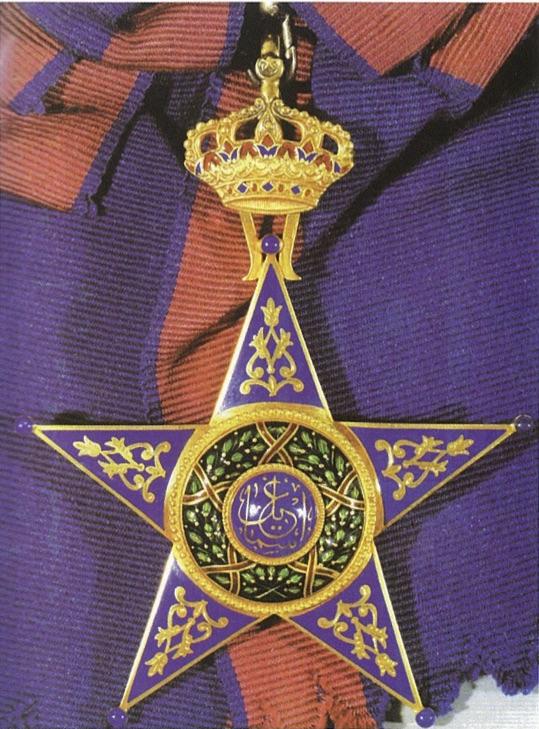
From: 2006. Journal of the Orders and Medals Society of America (JOMSA) 54 (4): Fig 15, pg. 20
0 -
I hope someone loves the above Yemeni Order of Saba'a medals, but given my interest in the Order of Ismail, their design looks like scary chimera of Frankensteined leftovers from defunct Egyptian orders. I have an identification of an individual I have shown wearing an Order of Ismail that I am putting together for a future post, but I just want to add another few photos of the Nishan al-Ismail to chase away how these Order of Saba'a images look like disarticulated insects to me.
Below are some moderate-low resolution images of what is identified as a 3rd Class Commander's neck badge of the Order of Ismail. These come from a July 2019 auction on the eMedals website(https://www.emedals.com/egypt-kingdom-an-order-of-ismail-in-gold-i-class-commander-by-j-lattes-c-1924). The badge was made by Lattes of Cairo and lacks the neck ribbon. The auction description calls it a "1st Class Commander" version of this award. The suspension loop on this example does appear to be that seen on the 3rd Class Commander configuration (but also see the variant shown in Owain's example made by Fahmy Tewfik Bichay in his post of 5 April, 2018 on this thread that clearly shows a circular loop attached to the crown suspension device attached that encircles the ribbon). However, that same form of suspension loop also was used for the neck badge of the 2nd Class Grand Officer Class and may be the most common form on the 1st Class Grand Cordon sash badge as well. Most examples of the 1st Class Grand Cordon sash badge seems to be attached with the same suspension loop, but they may be attached to the decorative knot of the sash slightly differently on some, although good images of this configuration are not common on auction sites, probably as fewer Grand Cordon sets are available. The Grand Cordon Order of Ismail in the photo of my post of 6 December, 2017 on this thread (by Lattes) is ambiguous in what kind of gold suspension loop is used to attach the sash badge to a cloth loop in the decorative knot of the sash. The example shown in the 4th photo of my post of 13 November, 2017 that also was made by Lattes exhibits the same suspension loop attachment of the sash badge, and the 3rd photo shows in that post shows it attached to a cloth loop on the sash's decorative bow. The Grand Cordon sash badge shown in the 3rd, 4th, and 5th photos of my post of 22 February, 2019 on this thread (made by Lattes) are the identical suspension loop to that used for the 2nd and 3rd Classes. The Grand Cordon set made by Tewfik Bichay illustrated in my post of 30 April, 2018 shows the same style of suspension loop as can be seen in the many available auction images of the 2nd and 3rd class badges of this award. The 28th and 29th photos (the 4th and 3rd from final images) in my post of 11 January, 2019 show the sash badge suspension loops for a Grand Cordon Grand Cordon sash badge made by Tewfik Bichay that also has the same style of suspension loop as the Lattes examples of the 1st, 2nd, and 3rd Class badges. The only clear suggestion of a different style of suspension loop unfortunately comes from an example of the Grand Cordon sash that lacks the sash badge. The last illustration in this post shows a suspension device attached to the cloth loop of the decorative sash knot from a past eMedals auction. I obviously cannot determine whether the normal suspension loop attached to the crown suspension device would have attached to this apparently brass (indicated by the green corrosion?) clip attached to the cloth loop on the sash bow by a circular loop.
The auction description states that this badge measures 59.38 mm wide X 81.77 mm high (including the suspension device and loop). The weight is given as 40.1 g. Although the photo resolution is not good enough to see any of the hallmarks in any of the photos of this piece (or other details of interest) other than those visible on the close-up of the reverse of the central boss, the eMedals description states that it is "...hallmarked on the reverse, suspension, suspension loop, crown reverse...", indicting all the normal locations for hallmarks as shown in several of my previous posts on this thread. As discussed in my post of 13 December, 2018, the dimensions of the Grand Cordon sash badge, the Grand Officer neck badge, and the Commander neck badge all show overlapping size ranges. Unlike the breast star that is consistency larger for the 1st Class of this award (mostly 80 mm in diameter, with reported variance of 81 or 82 mm on a few examples) compared with that of the 2nd Class (70 mm in diameter), where size alone can distinguish which class a breast star represents, other elements are needed to securely identify the Grand Cordon sash badge and the Grand Officer neck badge from the Commander neck badge. The 40.1 g weight of this eMedals example is quite a bit less heavy than the range reported for other 1st Class sash badges, 2nd Class neck badges, or the 3rd Class neck badges that vary from ~47-49 g.
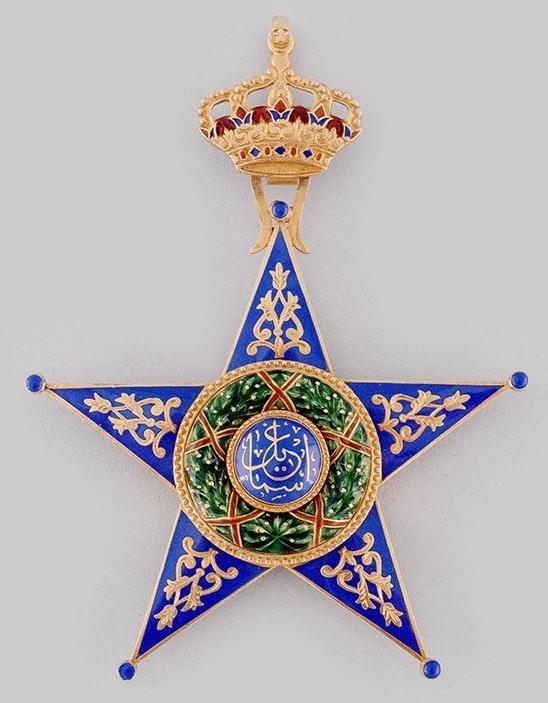
Obverse of the July 2019 eMedlas auction example identified as a 3rd Class Commander's neck badge. (From: https://www.emedals.com/egypt-kingdom-an-order-of-ismail-in-gold-i-class-commander-by-j-lattes-c-1924)
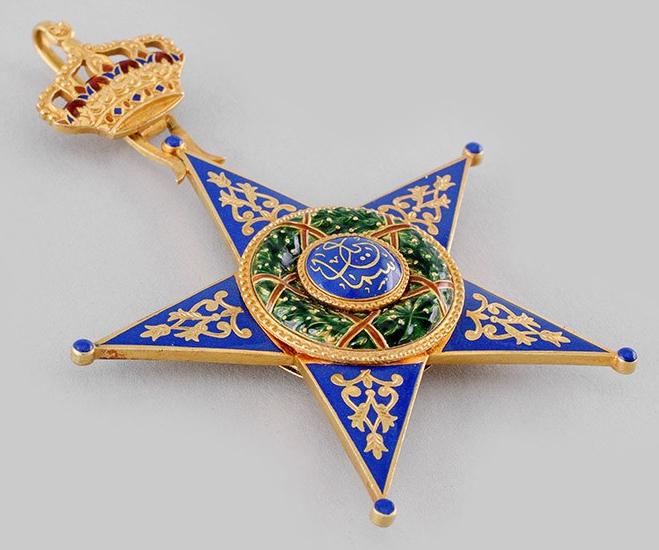
Oblique obverse view of the same eMedals July 2019 3rd Class neck badge showing some good detail of the construction of this badge.

Reverse view of this same eMedals 3rd Class neck badge.
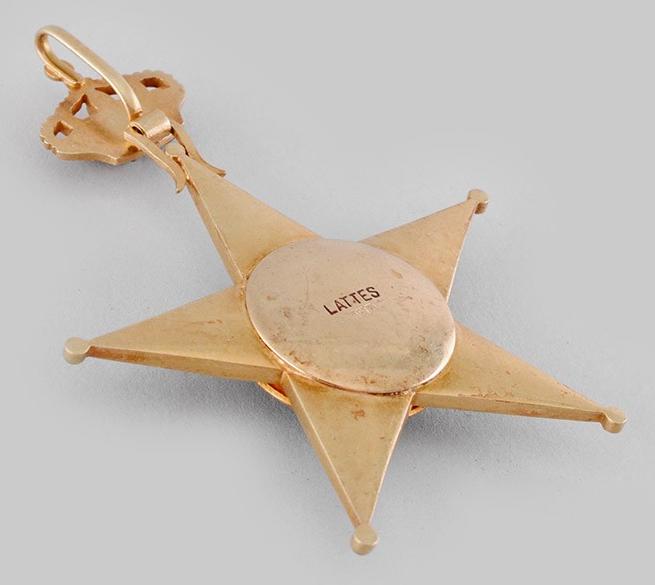
Oblique view of the reverse of this same Commander's neck badge, useful in shown some construction aspects of this badge.
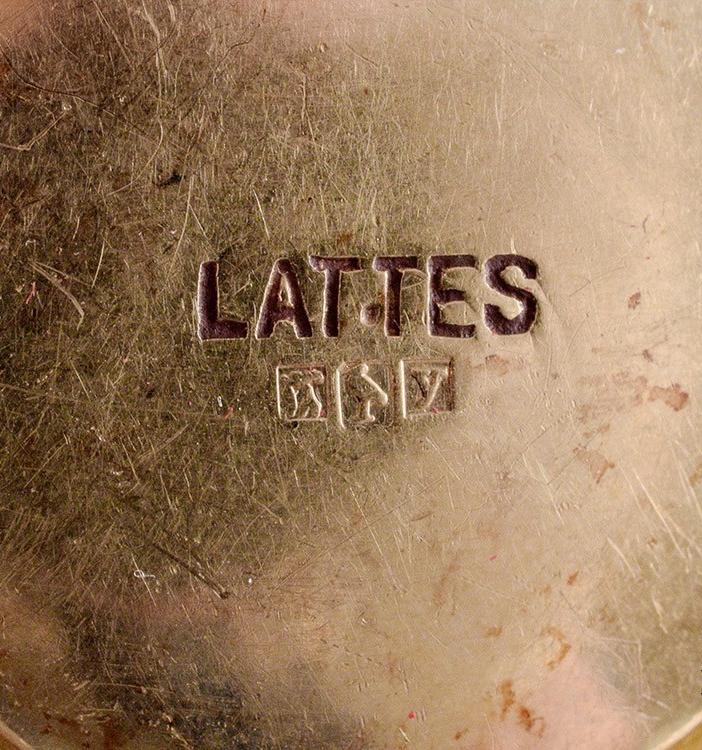
Close -up via of the reverse boss of this same Commander's neck badge showing the "LATTES" hallmark and below it the three Egyptian precious metal hallmarks, right-left: the Cairo assay office mark for 18 carat gold; the ibis mark identifying Egyptian produced gold work; and the date letter of "Y" indicating manufacture in 1923-1924. The auction description correctly identifies all of these hallmarks.
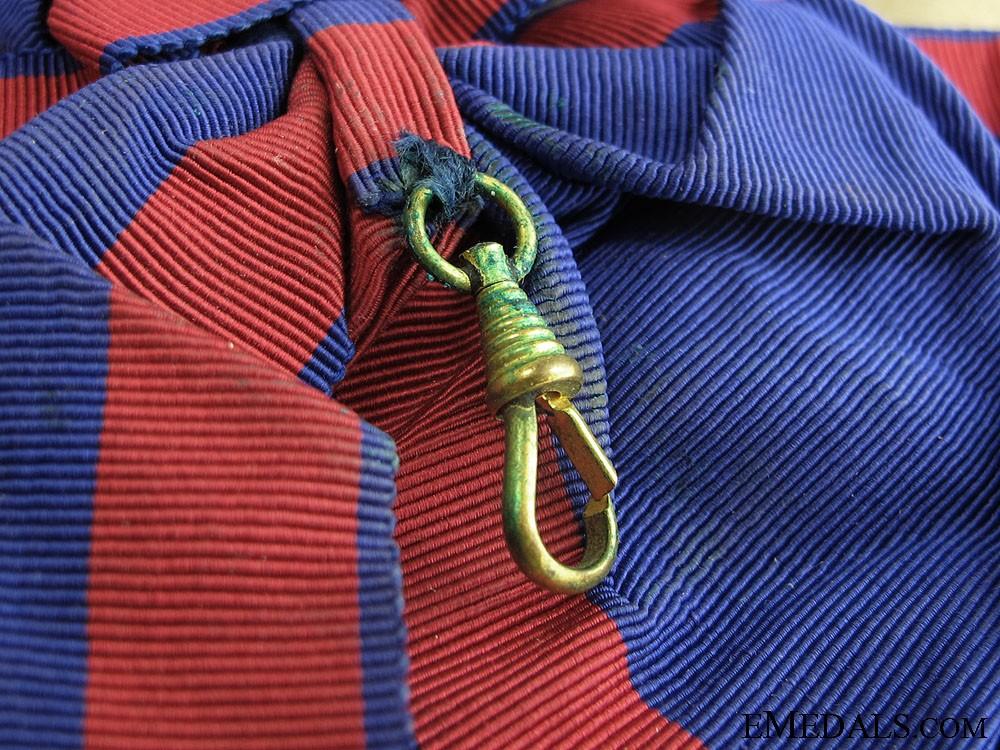 High-resolution image of the suspension clip attached by a circular loop to a cloth loop on a 1st Class Grand Cordon Order of Ismail sash from a past eMedals auction (https://www.emedals.com/order-of-ismail-1915-a-sash-w01278). The material the clip his made from is not identified in the auction description. This example of the sash did not have the sash badge nor a breast badge associated with it. No probable manufacturer for this sash is identified in the eMedals description. This is the only image I have found showing such an attachment clip. As noted in the text above, I still have several questions about the attachment configuration (and potential variation) that is represented for the sash badge of the Grand Cordon Class of this award compared with the attachment of the Grand Officer's or Commander's neck badges.
0
High-resolution image of the suspension clip attached by a circular loop to a cloth loop on a 1st Class Grand Cordon Order of Ismail sash from a past eMedals auction (https://www.emedals.com/order-of-ismail-1915-a-sash-w01278). The material the clip his made from is not identified in the auction description. This example of the sash did not have the sash badge nor a breast badge associated with it. No probable manufacturer for this sash is identified in the eMedals description. This is the only image I have found showing such an attachment clip. As noted in the text above, I still have several questions about the attachment configuration (and potential variation) that is represented for the sash badge of the Grand Cordon Class of this award compared with the attachment of the Grand Officer's or Commander's neck badges.
0 -
I have promised for some time to provide a higher resolution image of Judge Mahmoud Saïd in the District Court of Mansourah, and some other associated materials about Mahmoud Saïd. Although not famous for his legal career, Saïd was the son of a former Prime Minister of Egypt, Mohamed Saïd Pasha (1863-1928, served 1910-1914 and again for a short term in 1919), the uncle of Queen Farida of Egypt (Safnaz Zulificar, 1921-1988), Mahmoud Saïd is best remembered today as an important Egyptian modernist painter. He is most well-known for his works depicting rural scenes in early-mid 20thcentury Egypt, female nudes, and some portraits. A couple of simple websites about Mahmoud Saïd are: http://www.mahmoud-said.com/aboutMS.html and https://www.christies.com/features/10-things-to-know-about-Mahmoud-Said-8134-1.aspx. Many examples of his artwork, memorabilia, his judicial badge (shown below), his Order of the Nile, and his Order of Independence of the Republic (sans ribbon), in addition to several art medals awarded to him by Egypt and France are housed in the Mahmoud Saïd Museum in Gianaclis, Alexandria. The museum is located at 6 Sharia Mohammed Pasha Saïd (6 Mahmoud Saïd Pasha Street), Gianaclis; tlf: 03-582-1688. The hours are 10am-6pm Tue-Thu & Sat-Sun, visitors need to show a passport to get in.
As noted in my post of 5 March 2019, I do not yet have all aspects of Saïd's legal career identified securely. He worked principally in the Parquet, the prosecutor's office. He was appointed the deputy district prosecutor (Parquet) in 1921 (substitute) and promoted in that position in 1922. He was named Chief of the Parquet in Mansourah in 1925, and probably served on the district Courts in Alexandria starting in 1937, and retired from his legal career in 1949, the year of the closing of the Mixed Courts. Saïd was awarded the Egyptian Kingdom Order of the Nile (4th Class) probably after his retirement in 1949, the Republic-era Order of Independence of the Republic, the Egyptian State Merit Award for Arts in 1960 and the French Légion d'honneur in 1951 (although some biographical sources identify it as the "Medal for Honorary Merit").

Above is a higher resolution image of the District Court of Mansourah compared with the one I posted on 5 March, 2019 on this thread showing Mahmoud Saïd (1st row, 2nd from left, Egypt, Chef du Parquet, wearing what appears to be a bicolored sash, green uppermost and red below, that is appropriate for the Parquet, in contrast with what appear to be single color sashes, red, worn by all the other judges of District Court of Mansourah shown here), Ahmed Mazloum Bey (1st row, furthest right, Egypt), and Maurice de Wee (1st row, 2nd from left, (Belgium, Vice-Président). The names of the other judges in this image are provided in that post of 5 March. This and most of the images in this post can be zoomed for greater detail. (From : Les Juridictions Mixtes d'Égypte 1876-1926: Livre d'or Édité sous le Patronage du Conseil de l’Ordre des Avocats á l’Occasion du Cinquantenaire des Tribunaux de la Réforme, par le journal des Tribunaux Mixtes. Alexandrie, Egypte, Février 1926, pg.194)
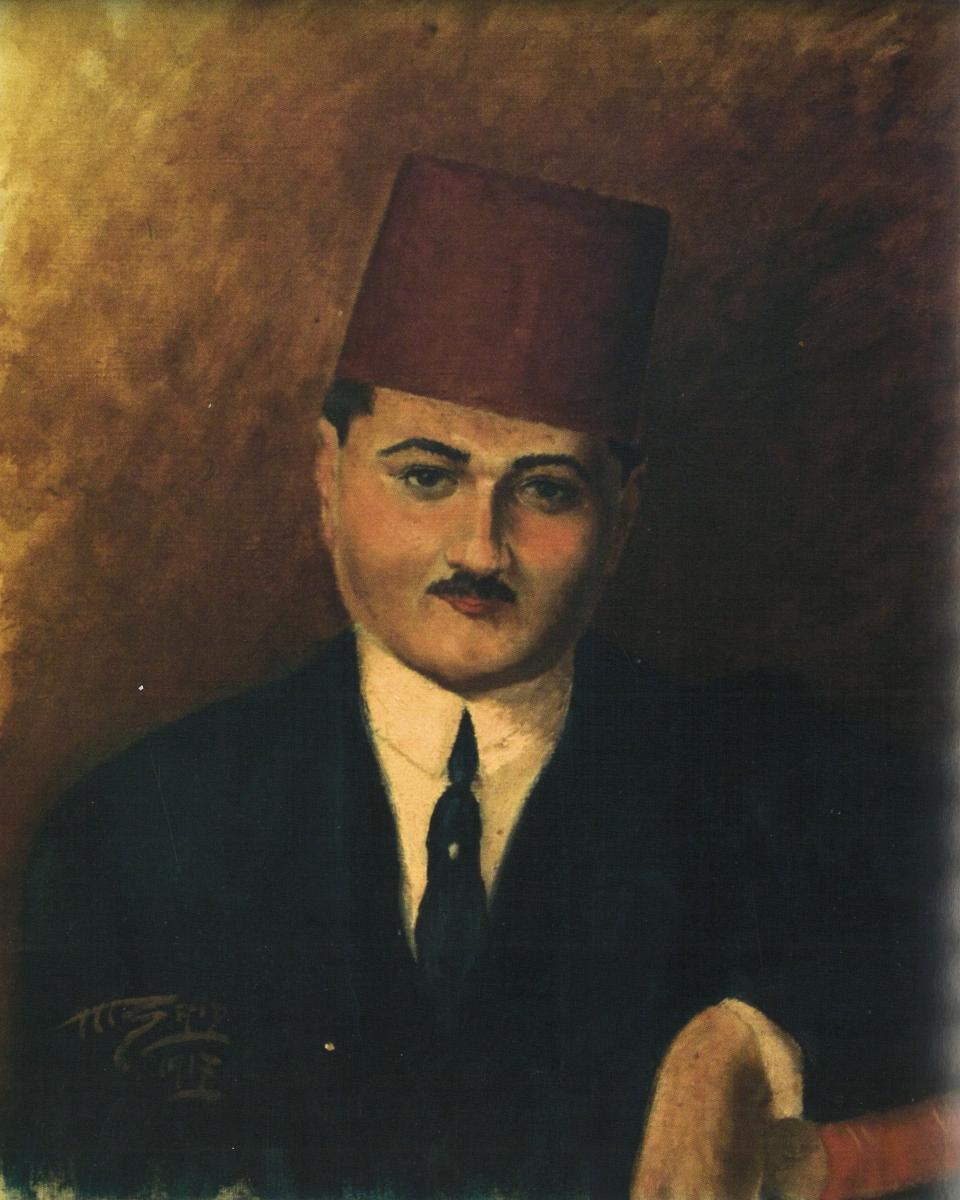
This is the portrait Mahmoud Saïd painted of Ahmed Mazloum Bey titled Portrait d’Ahmed Mazloum Pacha, 1917. From a private collection. As identified above, Judge Mazloum is seated in the first row, at the furthest right in the above photo of Le Tribunal de Mansourah, 1926 portrait. Please note that this portrait, and all the images from the two Didier Hess & Rashwan 2016 publications that I have included here, are copyrighted images and are presented on GMIC strictly for research purposes on the topic of the Egyptian Mixed Courts. (From: Didier Hess, Valérie & Hussam Rashwan (eds.), 2016. Mahmoud Saïd: Catalogue Raisonné Volume 1. Paintings. Skira Editore, S.p.A., Milano. [distributed in the USA, Canada, & South America by Rizzoli International Publications, Inc. New York; distributed elsewhere by Thames & Hudson Ltd. London]. Plate 7, pg 232. ©2016 Valérie Didier Hess; ©2016 Dr. Hussam Rashwan; ©2016 Mahmoud Saïd Estate; ©2016 Skira editore)

This is the Portrait of Maurice de Wee probably in 1924-26, titled Portrait de Mr. Maurice de Wee, painted by Mahmoud Saïd. This portrait is probably in the possession of the family of Maurice de Wee. Mahmoud Saïd’s signature is visible in the lower left of the painting. In the above photo of the District Court of Mansourah, Judge de Wee is seated in the 1st row, 3rd from left in the above photographic portrait of the Le Tribunal de Mansourah. (From: Didier Hess, Valérie & Hussam Rashwan (eds.), 2016. Mahmoud Saïd: Catalogue Raisonné Volume 1. Paintings. Skira Editore, S.p.A., Milano. [distributed in the USA, Canada, & South America by Rizzoli International Publications, Inc. New York; distributed elsewhere by Thames & Hudson Ltd. London]. Plate 79, pg. 278. ©2016 Valérie Didier Hess; ©2016 Dr. Hussam Rashwan; ©2016 Mahmoud Saïd Estate; ©2016 Skira editore)
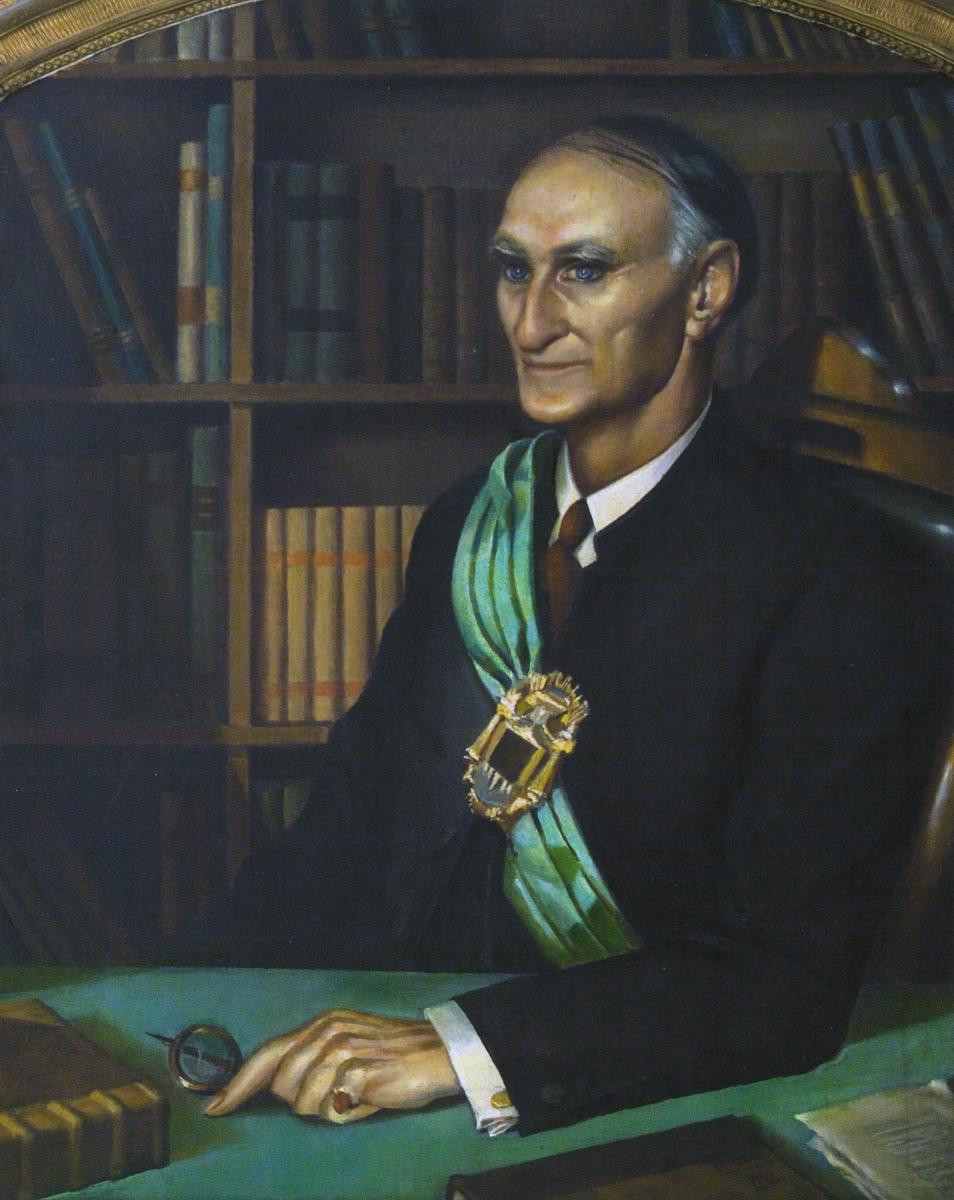
I have previously posted this portrait of Jasper Yeates Brinton by Mahmoud Saïd in the 1st photo of my post of 1 December, 2016, but here is a higher resolution image of the only portrait by Saïd of a judge of the Mixed Courts in his regalia, titled Portrait du president: Jasper Brinton, 1944. This portrait is in the collection of the Museum of Modern Art, Cairo, and it has been on loan to the Mahmoud Saïd Museum, Alexandria. (From: Didier Hess, Valérie & Hussam Rashwan (eds.), 2016. Mahmoud Saïd: Catalogue Raisonné Volume 1. Paintings. Skira Editore, S.p.A., Milano. [distributed in the USA, Canada, & South America by Rizzoli International Publications, Inc. New York; distributed elsewhere by Thames & Hudson Ltd. London]. Plate 237, pg. 442. ©2016 Valérie Didier Hess; ©2016 Dr. Hussam Rashwan; ©2016 Mahmoud Saïd Estate; ©2016 Skira editore)
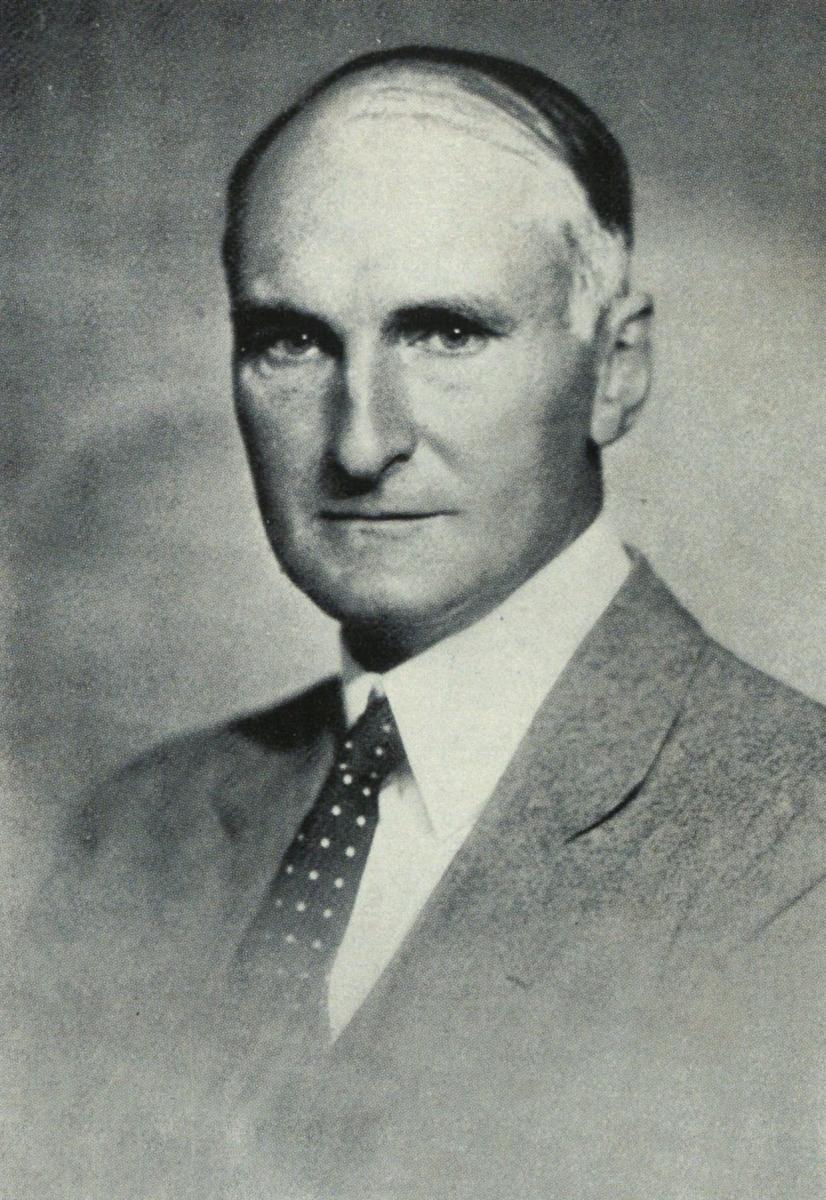
Above is a portrait photo of Jasper Yeates Brinton from the Yale University Press, in 1930 (used in his book: Brinton, Jasper Yeates, 1931 Revised Edition. The Mixed Courts of Egypt, 1931 Yale University Press, New Haven. Opposite page 340). Brinton also is shown in the 3rd photo of my post of 1 April, 2019 of the Mixed Court of Appeals in general assembly, seated at the table, 3rd from the right).

Mahmoud Saïd’s silver judicial badge (from the Mahmoud Saïd Museum, Alexandria). The bookplate legend incorrectly identifies this as a “Medal of Justice.” Mahmoud Saïd’s badge is silver because almost all of his court assignments that I can identify pertain to the Parquet, the prosecutor's office. No information is provided about the manufacturer of this badge. (From: Didier Hess, Valérie & Hussam Rashwan (eds.), 2016. Mahmoud Saïd: Catalogue Raisonné Volume 2. Drawings. Skira Editore, S.p.A., Milano. [distributed in the USA, Canada, & South America by Rizzoli International Publications, Inc. New York; distributed elsewhere by Thames & Hudson Ltd. London]. Plate A 177, pg. 865. ©2016 Valérie Didier Hess; ©2016 Dr. Hussam Rashwan; ©2016 Mahmoud Saïd Estate; ©2016 Skira editore)
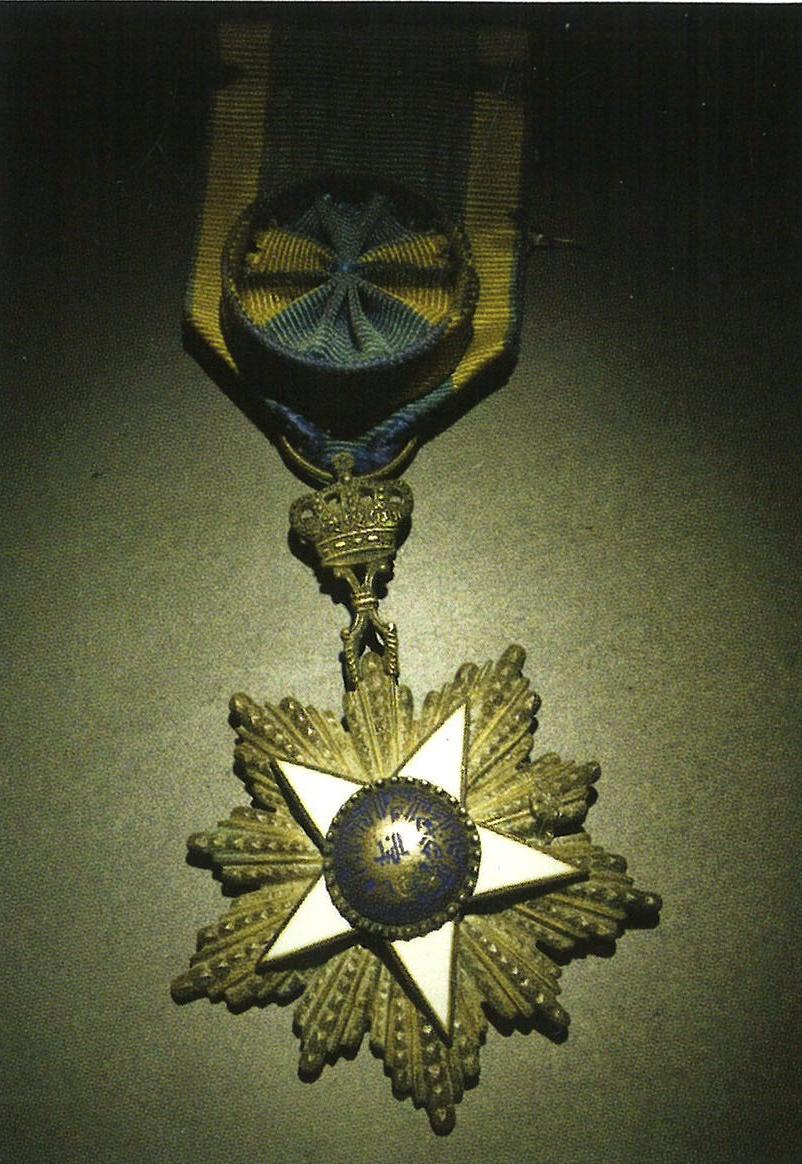 Mahmoud Saïd’s Order of the Nile, 4th Class, Officer (from the Mahmoud Saïd Museum, Alexandria). (From: Didier Hess, Valérie & Hussam Rashwan (eds.), 2016. Mahmoud Saïd: Catalogue Raisonné Volume 2. Drawings. Skira Editore, S.p.A., Milano. [distributed in the USA, Canada, & South America by Rizzoli International Publications, Inc. New York; distributed elsewhere by Thames & Hudson Ltd. London]. Plate A 179, pg. 865. ©2016 Valérie Didier Hess; ©2016 Dr. Hussam Rashwan; ©2016 Mahmoud Saïd Estate; ©2016 Skira editore)
Mahmoud Saïd’s Order of the Nile, 4th Class, Officer (from the Mahmoud Saïd Museum, Alexandria). (From: Didier Hess, Valérie & Hussam Rashwan (eds.), 2016. Mahmoud Saïd: Catalogue Raisonné Volume 2. Drawings. Skira Editore, S.p.A., Milano. [distributed in the USA, Canada, & South America by Rizzoli International Publications, Inc. New York; distributed elsewhere by Thames & Hudson Ltd. London]. Plate A 179, pg. 865. ©2016 Valérie Didier Hess; ©2016 Dr. Hussam Rashwan; ©2016 Mahmoud Saïd Estate; ©2016 Skira editore)

Mahmoud Saïd’s Order of Independence of the Republic (Order of Istiklal), probably the 1st Class, Grand Cordon. The suspension clip fitted onto the larger superior suspension ring (attached to the reverse of the triangular suspension device that is ornamented in blue enamel bands with the Eagle of Saladin on the obverse but is not shown in this photo) that is partially visible, but obscured by the red embellishment ray in the 11:00 o’clock position, appears to be that used to suspend the sash badge of the Grand Cordon Class of this award (from the Mahmoud Saïd Museum, Alexandria). The bookplate incorrectly identifies this as the “Medal of Merit” (from the Mahmoud Saïd Museum, Alexandria). (From: Didier Hess, Valérie & Hussam Rashwan (eds.), 2016. Mahmoud Saïd: Catalogue Raisonné Volume 2. Drawings. Skira Editore, S.p.A., Milano. [distributed in the USA, Canada, & South America by Rizzoli International Publications, Inc. New York; distributed elsewhere by Thames & Hudson Ltd. London]. Plate A 176, pg. 865. ©2016 Valérie Didier Hess; ©2016 Dr. Hussam Rashwan; ©2016 Mahmoud Saïd Estate; ©2016 Skira editore)
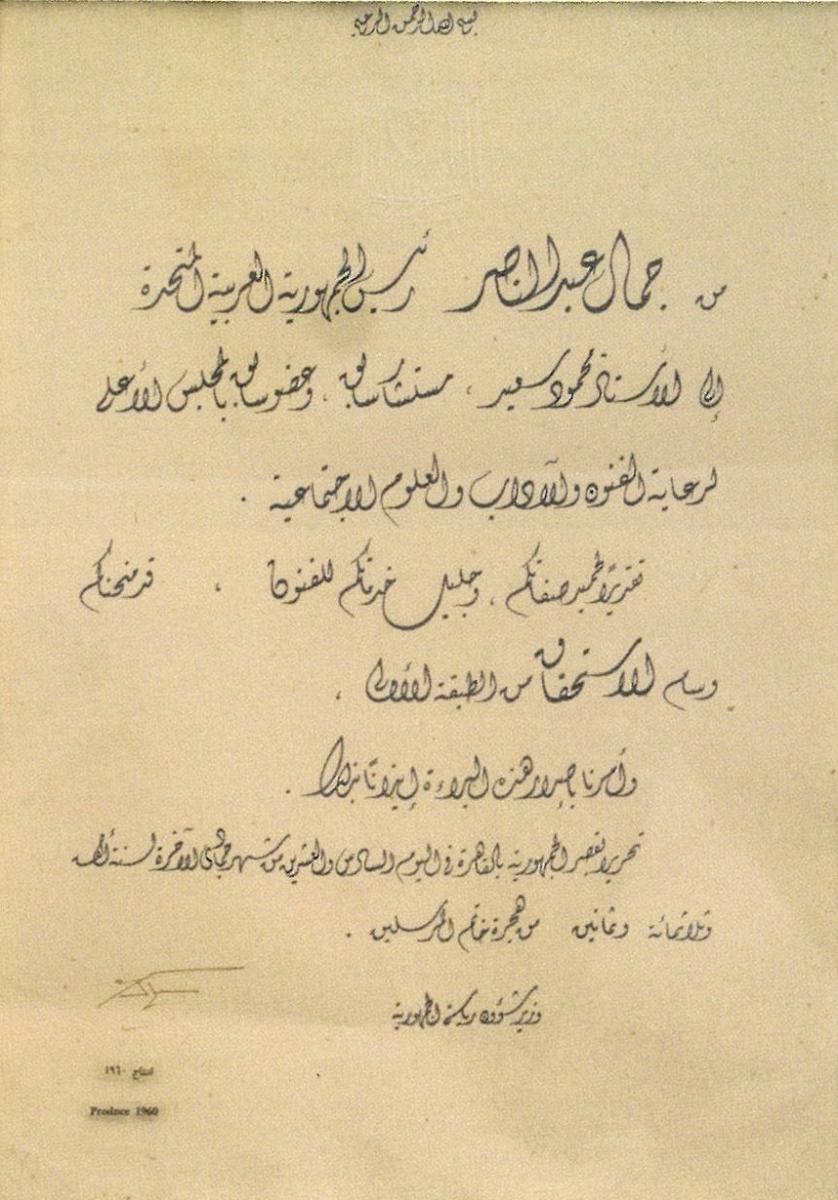
Award brevet for Mahmoud Saïd’s Order of Independence of the Republic, identified in the bookplate description as a “1st Class” award, probably meaning the Grand Cordon (but perhaps one of the GMIC experts who reads Arabic may clarify the class of this award?), dated 1960 (from the Mahmoud Saïd Museum, Alexandria). (From: Didier Hess, Valérie & Hussam Rashwan (eds.), 2016. Mahmoud Saïd: Catalogue Raisonné Volume 2. Drawings. Skira Editore, S.p.A., Milano. [distributed in the USA, Canada, & South America by Rizzoli International Publications, Inc. New York; distributed elsewhere by Thames & Hudson Ltd. London]. Plate A 30, pg. 794. ©2016 Valérie Didier Hess; ©2016 Dr. Hussam Rashwan; ©2016 Mahmoud Saïd Estate; ©2016 Skira editors)
Mahmoud Saïd did often make pencil sketches during his time in the courts. Some of these I am reproducing below that depict particular identified individuals (mostly lawyers) or provide some images of the lawyer's costumes. These sketches are apparently undated, and all are identified in the Didier Hess and Raswan volume only as having been made sometime probably in the 1920s. Mahmoud Saïd also sketched some general depictions of the activity in the District Courts. Most of these are probably from the District Court of Alexandria. I am not including them here as they provide only minimal detail of judges' or lawyers' costumes, but I may post some in the future.
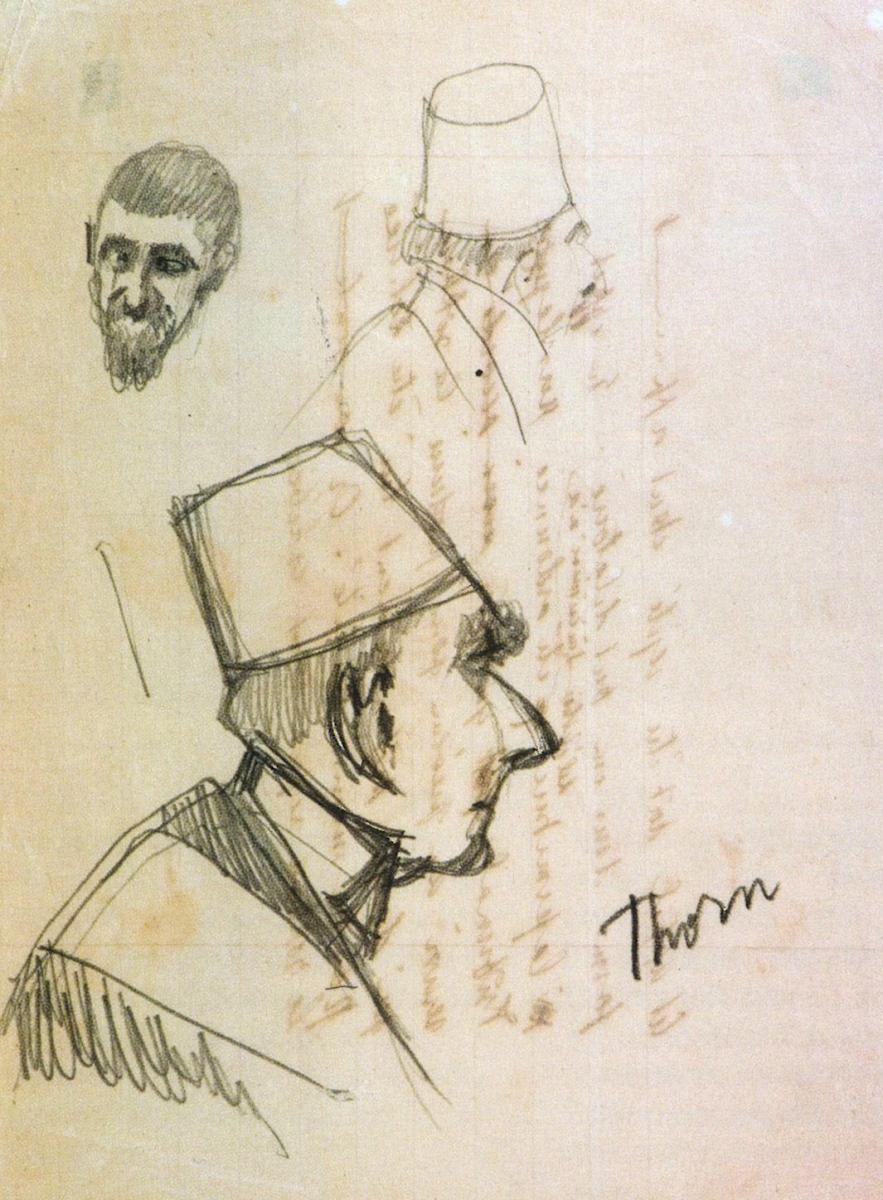
Above is a drawing by Mahmoud Saïd, that is identified as a study of a judge or lawyer. The name “Thorn” on the sketch suggests it is probably the Judge William Hobart Houghton Thorne of Britain, shown in the 5th photo of my post of 18 April, 2019 on this thread (depicting the Mixed District Court of Alexandria in general assembly, from the Les Juridictions Mixtes d'Égypte 1876-1926 volume pg. 192) sitting to the viewer’s right of Manuel Monteiro. The sash shown in the drawing is consistent with the judges’ costume, however as shown in my previous post of, some court functionaries also wore bi-colored sashes and the “judicial” badge. Judge Thorne was named to the District Court of Alexandria in October, 1916, he resigned in March of 1917, and re-appointed to the District Court of Alexandria in February, 1919 and was serving that court in 1926 at the time of the 50th Anniversary volume’s publication. (From: Didier Hess, Valérie & Hussam Rashwan (eds.), 2016. Mahmoud Saïd: Catalogue Raisonné Volume 2. Drawings. Skira Editore, S.p.A., Milano. [distributed in the USA, Canada, & South America by Rizzoli International Publications, Inc. New York; distributed elsewhere by Thames & Hudson Ltd. London]. Plate D 163, pg. 729. ©2016 Valérie Didier Hess; ©2016 Dr. Hussam Rashwan; ©2016 Mahmoud Saïd Estate; ©2016 Skira editors)
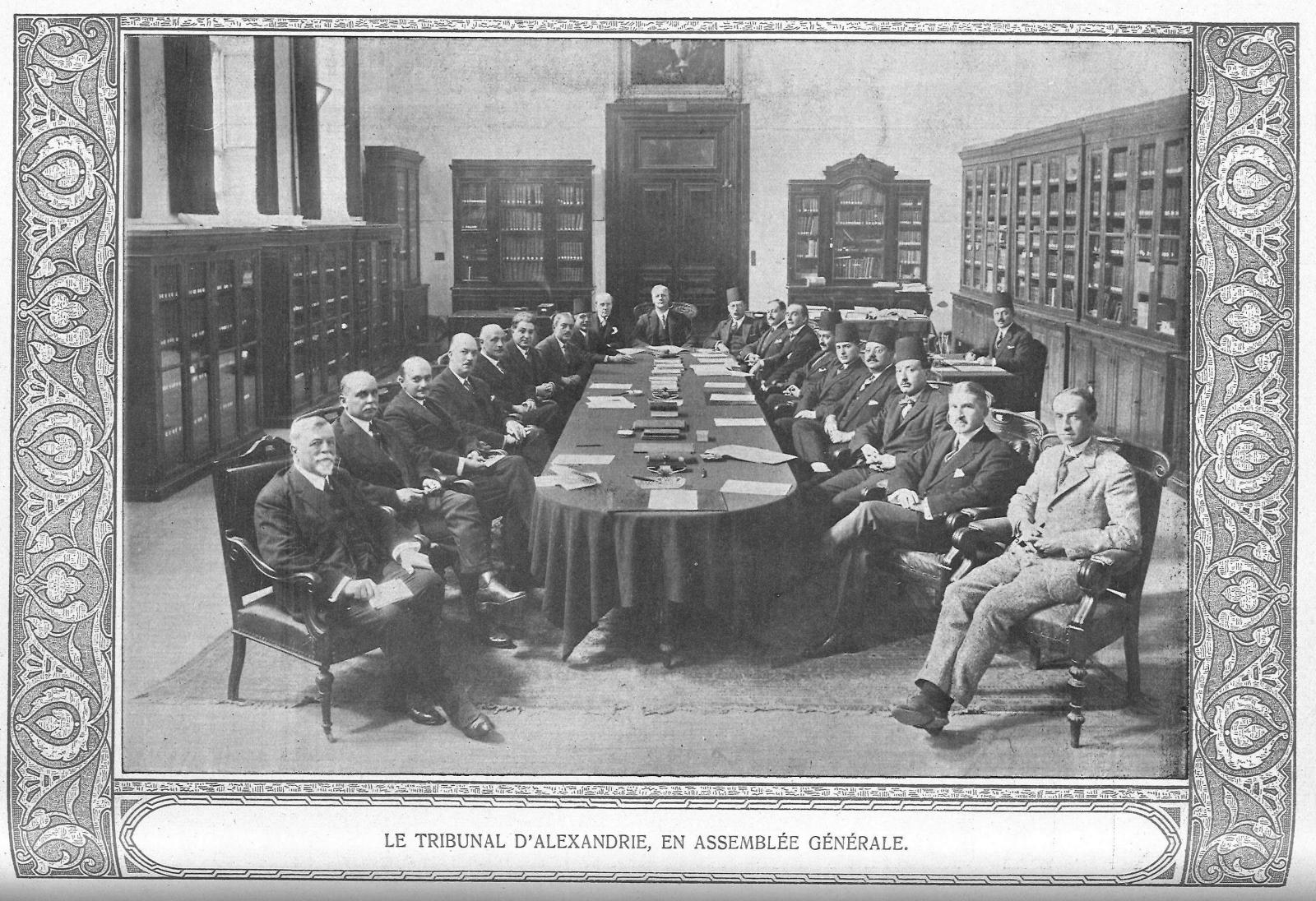
The photo of the District Court of Alexandria in general assembly that I included as the 5th photo in my post of 18 April, 2019 on this thread. Judge William Hobart Houghton Thorne of Britain is seated 3rd from the viewer's right of the person seated at the far head of the table, Judge Erling Qvale, from Norway, the President of the District Court of Alexandria at the time. The names of the other individuals are provided in the caption to this image in my post of 18 April. (From : Les Juridictions Mixtes d'Égypte 1876-1926: Livre d'or Édité sous le Patronage du Conseil de l’Ordre des Avocats á l’Occasion du Cinquantenaire des Tribunaux de la Réforme, par le journal des Tribunaux Mixtes. Alexandrie, Egypte, Février 1926, pg.194)
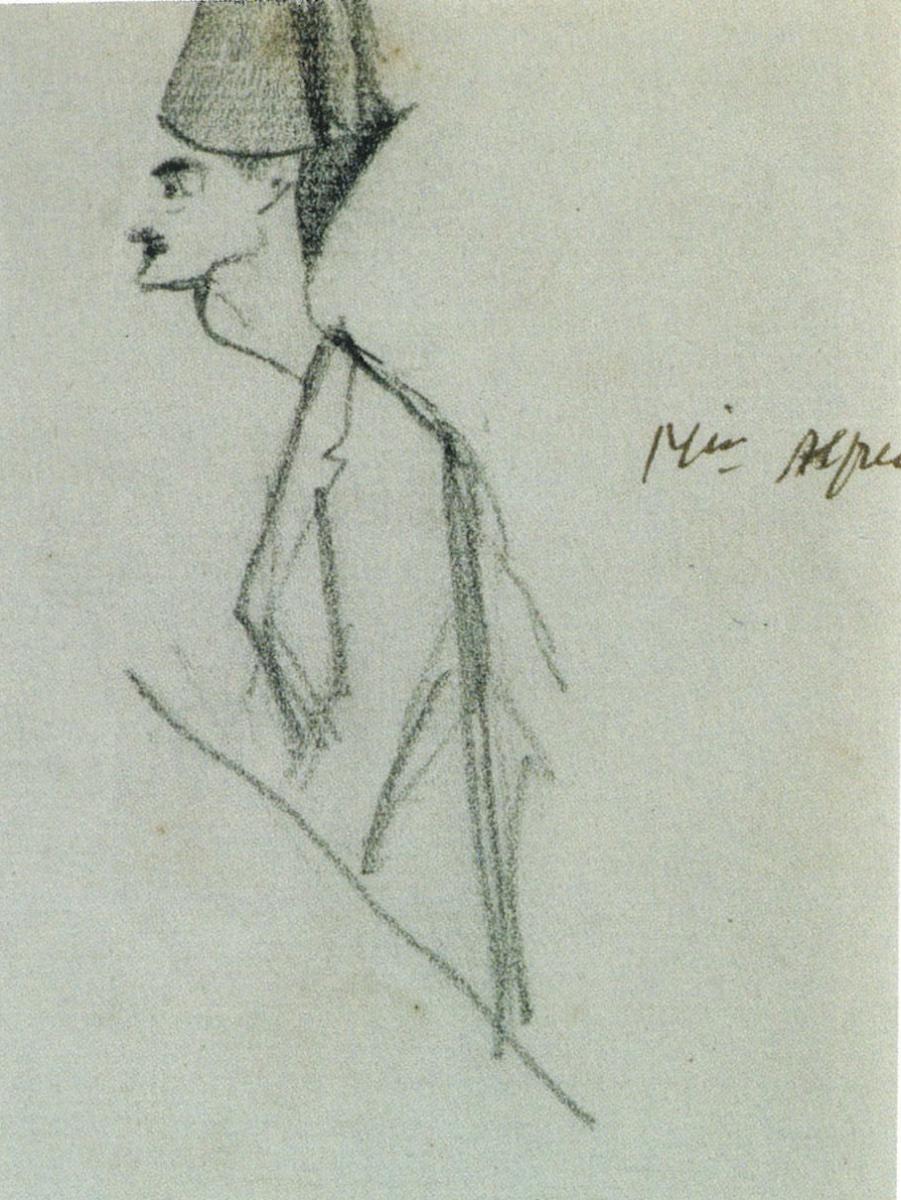
This is a caricature drawing by Mahmoud Saïd titled “Maître Alfred” showing a lawyer serving the Mixed Courts. This appears to be Alfred Tilche, who also appears in some of the photos in the Les Juridictions Mixtes d'Égypte 1876-1926 volume. (From: Didier Hess, Valérie & Hussam Rashwan (eds.), 2016. Mahmoud Saïd: Catalogue Raisonné Volume 2. Drawings. Skira Editore, S.p.A., Milano. [distributed in the USA, Canada, & South America by Rizzoli International Publications, Inc. New York; distributed elsewhere by Thames & Hudson Ltd. London]. Plate D 175, pg. 732. ©2016 Valérie Didier Hess; ©2016 Dr. Hussam Rashwan; ©2016 Mahmoud Saïd Estate; ©2016 Skira editors)
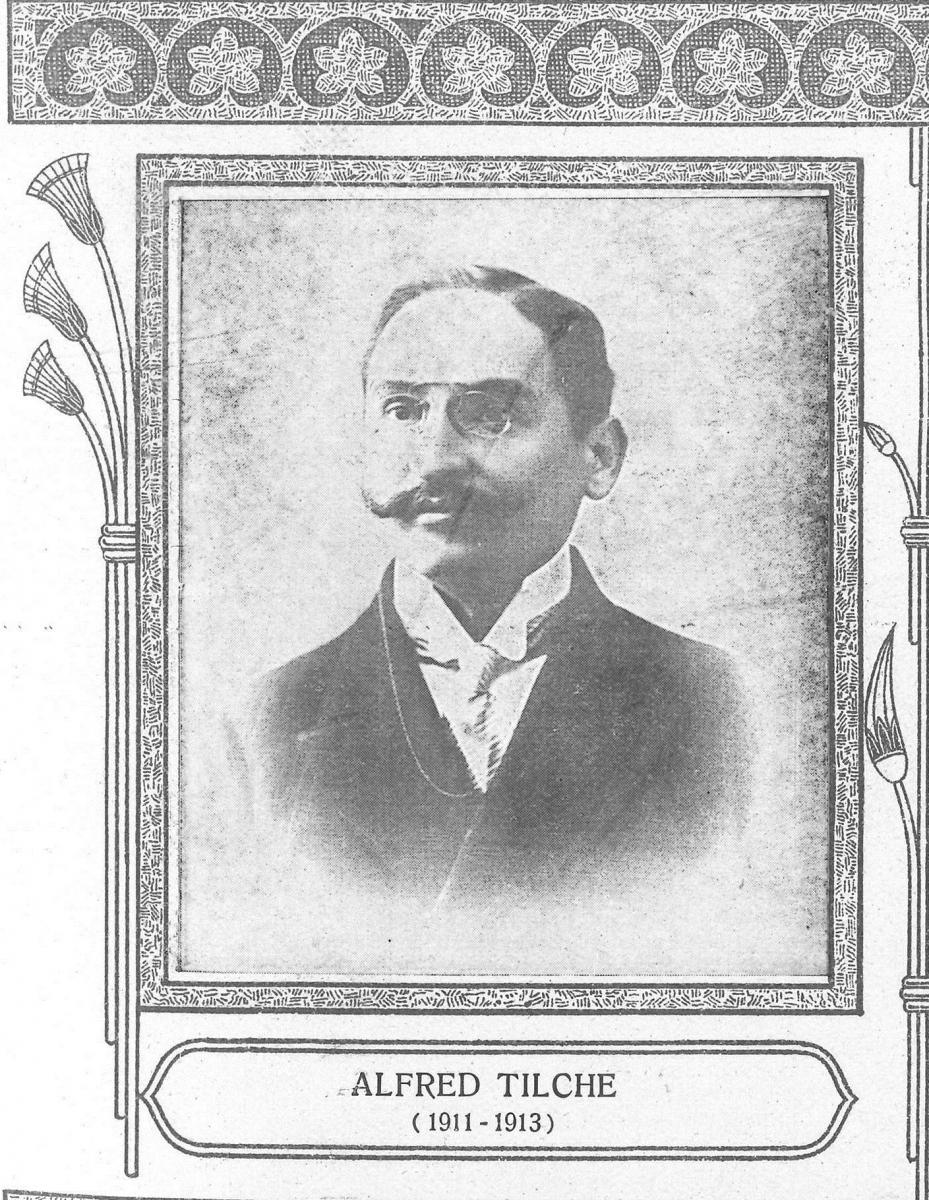
This is a portrait of Alfred Tilche in a section of photos of former and current heads (Bâtonnières) of the bar of the Mixed Courts, identifying Tilche as the Bâtonnière from 1911-1913. This photograph shows him at similar age to the sketch by Mahmoud Saïd shown above. (From: Les Juridictions Mixtes d'Égypte 1876-1926: Livre d'or Édité sous le Patronage du Conseil de l’Ordre des Avocats á l’Occasion du Cinquantenaire des Tribunaux de la Réforme, par le journal des Tribunaux Mixtes. Alexandrie, Egypte, Février 1926, pg. 211.)
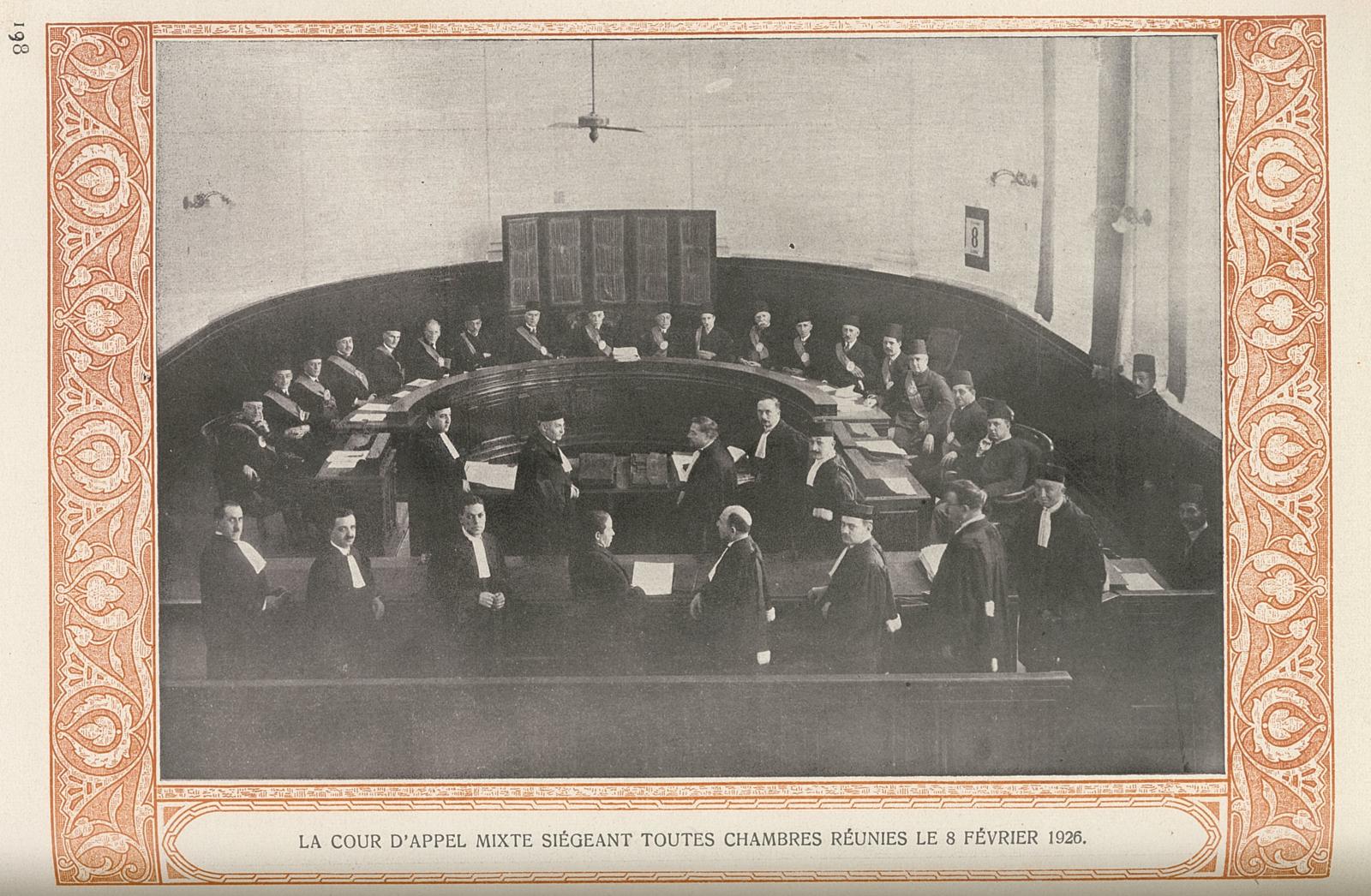
Alfred Tilche also is shown as an older man than in the above portrait in this photo that documents the full Appeals Court in session in February of 1926 (I previously included this as the 4th photo I posted on 1 April, 2019 in this thread). Tilche is in the row of lawyers nearest the semi-circular judges bench, 2nd from the left, with gray moustaches & glasses (in front of Judge Michael Hansson) wearing his lawyer’s gown, rabat, and beretta. The other lawyers in this row are identified as, left-right: M. Pupikofer, Alfred Tilche, Alberto Lusena, P. Colucci, & David Hazan. The names of the judges in this courtroom image are provided in my post of 1 April, 2019. (From: Les Juridictions Mixtes d'Égypte 1876-1926: Livre d'or Édité sous le Patronage du Conseil de l’Ordre des Avocats á l’Occasion du Cinquantenaire des Tribunaux de la Réforme, par le journal des Tribunaux Mixtes. Alexandrie, Egypte, Février 1926, pg. 198).
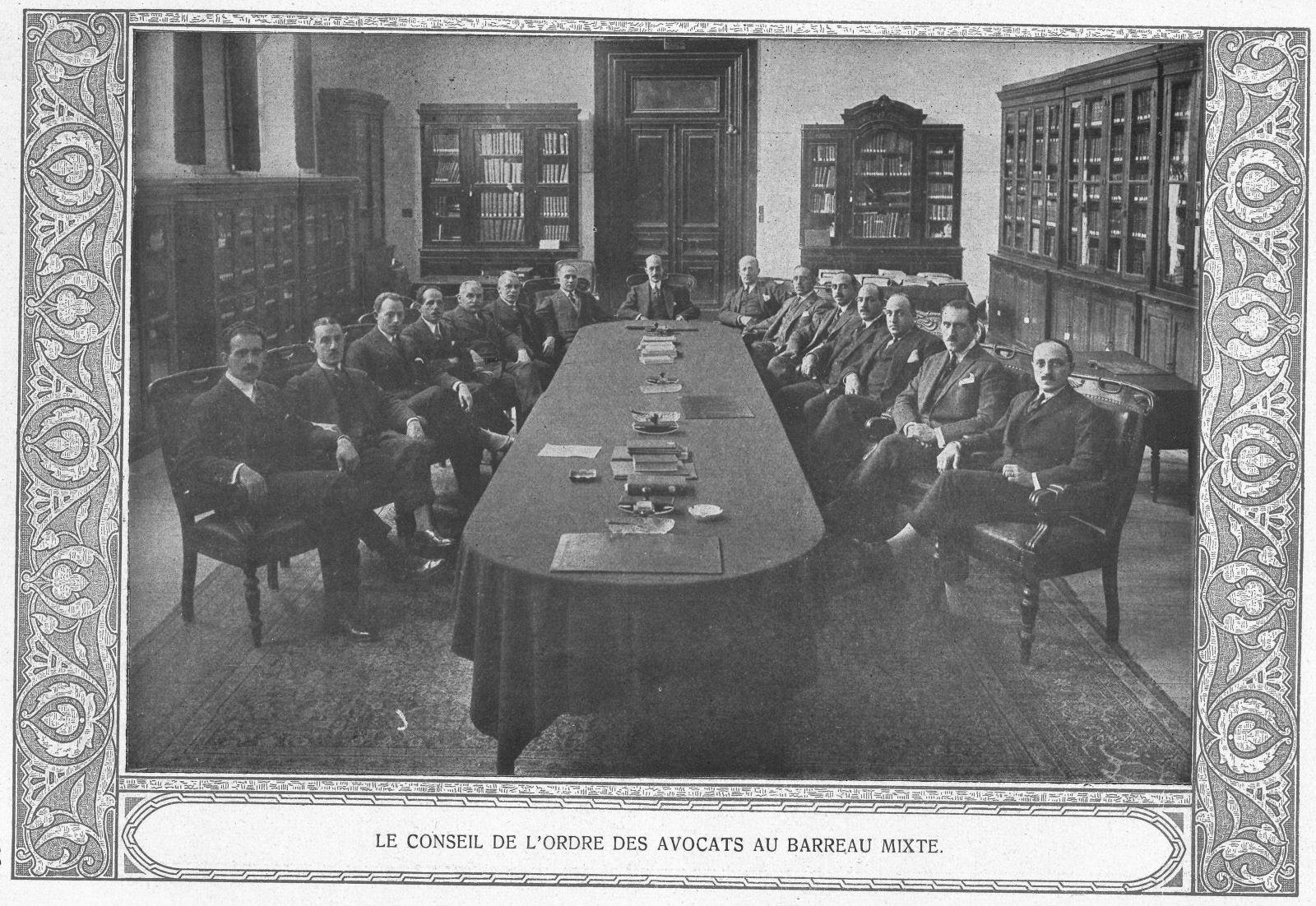
Alfred Tilche also is again shown as an older individual in the above photo of the Board of legal Advisors to the Mixed Courts lawyers on page 199 of that anniversary publication, which is reproduced above. Tilche is the 5th lawyer from the foreground seated on the left side of the table. The other lawyers, seated from left to right around the table are: A. Scordino, R. Chalom Bey, F. Bakhoum, Alfred Tilche (former Bâtonnière), Théodore Lebsohn (former Bâtonnière), M. Tatarakis (Subistitute), Giuseppe de Semo (Bâtonnière), Alfred Catzefils (former Bâtonnière), G. Merzbach Bey (Chef del la Délégaction du Caire), N. Orfall, S. Antoine, M. Pupikofer, C. Casdagli, & R. Schemeil. Alfred Tilche also is identified in a large, official group photo of lawyers who worked in Alexandria, wearing their court robes, rabat, and some wearing the beretta, on page 204 of the the Les Juridictions Mixtes d'Égypte 1876-1926 volume (it provides only low resolution of any individuals features because of the large number of lawyers in the photo, so I am not reproducing it here). Above image from: Les Juridictions Mixtes d'Égypte 1876-1926: Livre d'or Édité sous le Patronage du Conseil de l’Ordre des Avocats á l’Occasion du Cinquantenaire des Tribunaux de la Réforme, par le journal des Tribunaux Mixtes. Alexandrie, Egypte, Février 1926, pg. 199).
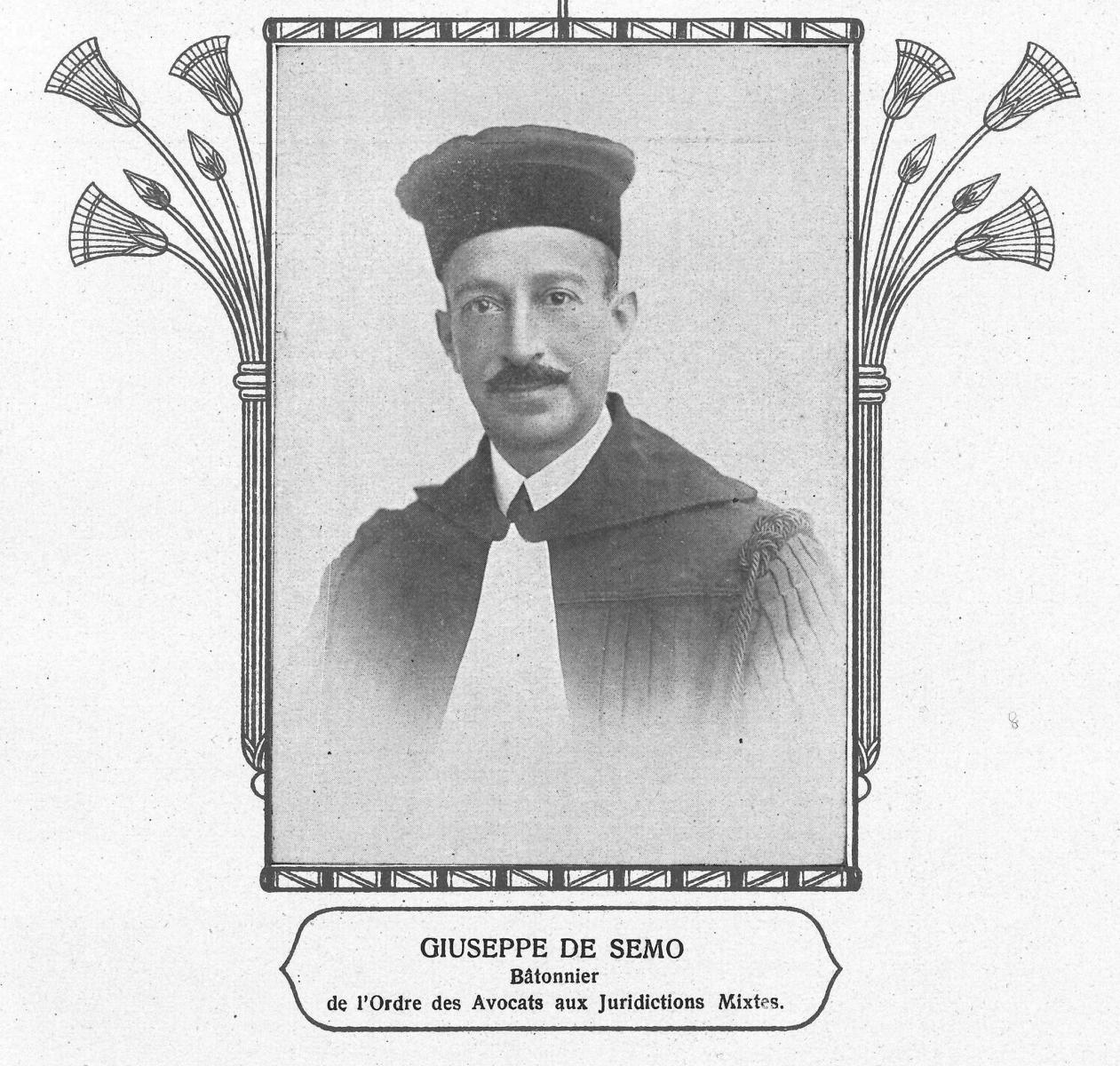
The above illustration shows Giuseppe de Semo, the Bâtonnière of the bar of the Mixed Courtsin 1926, shown seated at the head of the table in the previous photo of the advisory lawyers to the Mixed Courts in chambers. This image shows some details of his lawyer’s costume, including the robe, rabat (scarf), and beretta (legal cap). It is unclear whether some of the variation in lawyers' costumes shown in their 50th Anniversary volume may be associated with lawyers of different nationalities retaining their national legal regalia (see some of the variation in lawyers' costumes in the second picture above showing the full Appeals Court in session in February of 1926). If this is a possibility, it might explain the apparently erroneous statement by W. Burdick (W. Burdick,1939. Bench and Bar of Other Lands, pp. 495-496) stating that the costume of judges in the International Mixed Courts (both Egyptian and foreign) wore the judicial robes of their home countries (on pg. 412) that I mentioned again in my recent post of 15 August, 2019. He may have mistaken judicial for lawyers' robes in whatever observational basis he had for that statement that cannot be true of judges regalia at the period when he wrote that article. (From: Les Juridictions Mixtes d'Égypte 1876-1926: Livre d'or Édité sous le Patronage du Conseil de l’Ordre des Avocats á l’Occasion du Cinquantenaire des Tribunaux de la Réforme, par le journal des Tribunaux Mixtes. Alexandrie, Egypte, Février 1926, pg. 11).
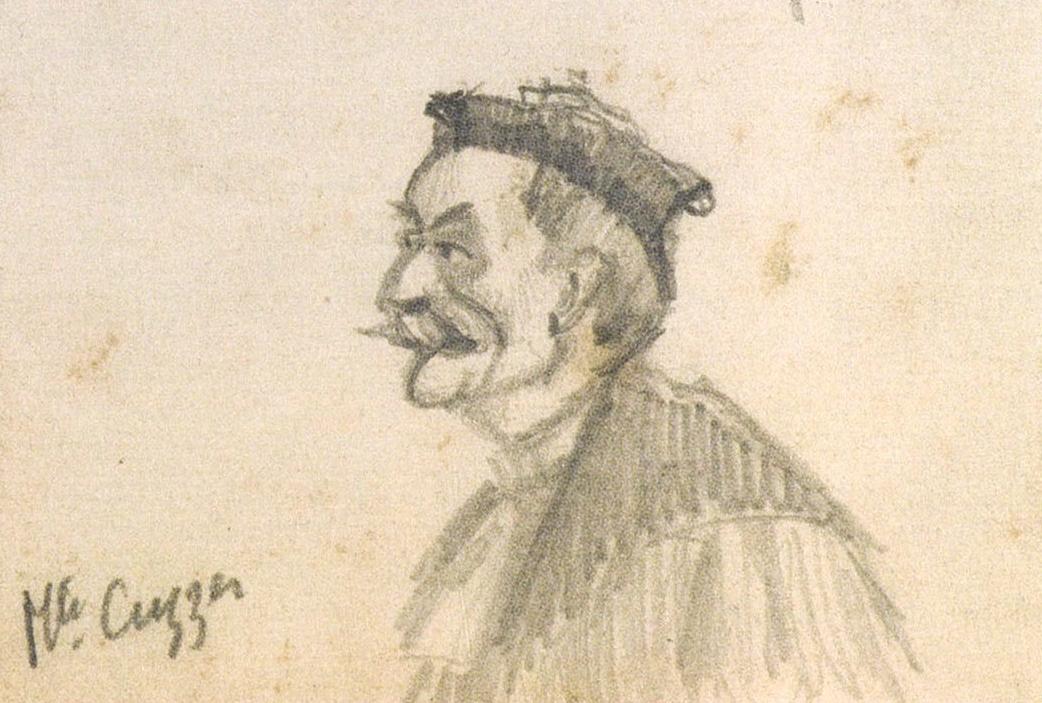
This is a drawing by Mahmoud Saïd made in the courts titled “Maître Cuzzer”, referring to Giulio Cuzzer. (From: Didier Hess, Valérie & Hussam Rashwan (eds.), 2016. Mahmoud Saïd: Catalogue Raisonné Volume 2. Drawings. Skira Editore, S.p.A., Milano. [distributed in the USA, Canada, & South America by Rizzoli International Publications, Inc. New York; distributed elsewhere by Thames & Hudson Ltd. London]. Plate D 198, pg. 737. ©2016 Valérie Didier Hess; ©2016 Dr. Hussam Rashwan; ©2016 Mahmoud Saïd Estate; ©2016 Skira editors)
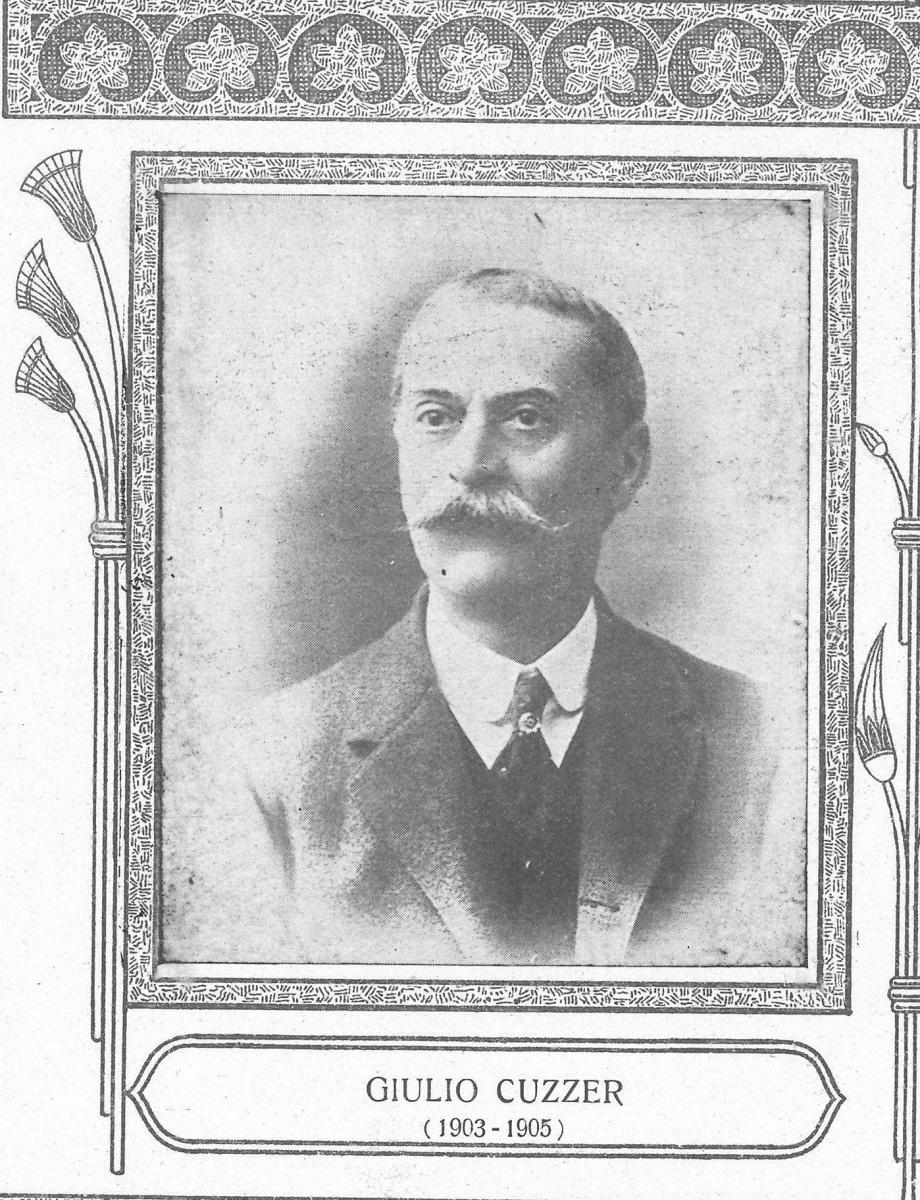
This is a portrait of Giulio Cuzzer in a section of photos of former and current heads (Bâtonnières) of the bar of the Mixed Courts. Cuzzer was a former Bâtonnière of the Mixed Courts’ Bar from 1903-1905. (From: Les Juridictions Mixtes d'Égypte 1876-1926: Livre d'or Édité sous le Patronage du Conseil de l’Ordre des Avocats á l’Occasion du Cinquantenaire des Tribunaux de la Réforme, par le journal des Tribunaux Mixtes. Alexandrie, Egypte, Février 1926, pg. 210).
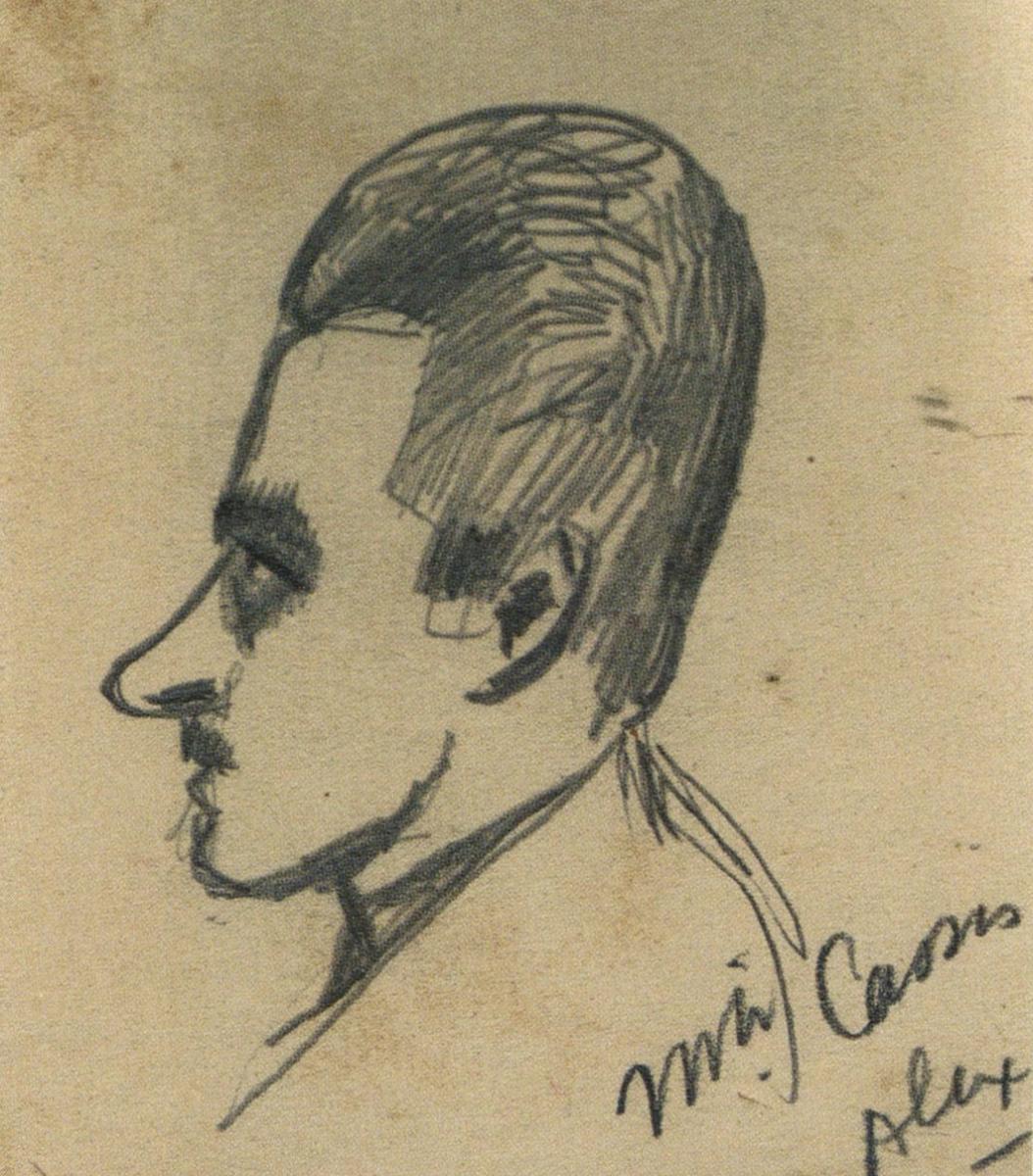
Court sketch by Mahmoud Saïd of the lawyer titled “Maître Cassis Alex”. Two lawyers with the surname Cassis were serving as lawyers to the District Court of Mansourah in ~1926, and are shown in a photo from the Les Juridictions Mixtes d'Égypte 1876-1926 volume (see photo the next photo shown below). One, named S. Cassis, exhibits a white mustache in the photograph of this corps of lawyers and the other is a younger man with smaller, dark mustaches named A. Cassis, who closely resembles this sketch portrait above. (From: Didier Hess, Valérie & Hussam Rashwan (eds.), 2016. Mahmoud Saïd: Catalogue Raisonné Volume 2. Drawings. Skira Editore, S.p.A., Milano. [distributed in the USA, Canada, & South America by Rizzoli International Publications, Inc. New York; distributed elsewhere by Thames & Hudson Ltd. London]. Plate D 177, pg. 732. ©2016 Valérie Didier Hess; ©2016 Dr. Hussam Rashwan; ©2016 Mahmoud Saïd Estate; ©2016 Skira editors)
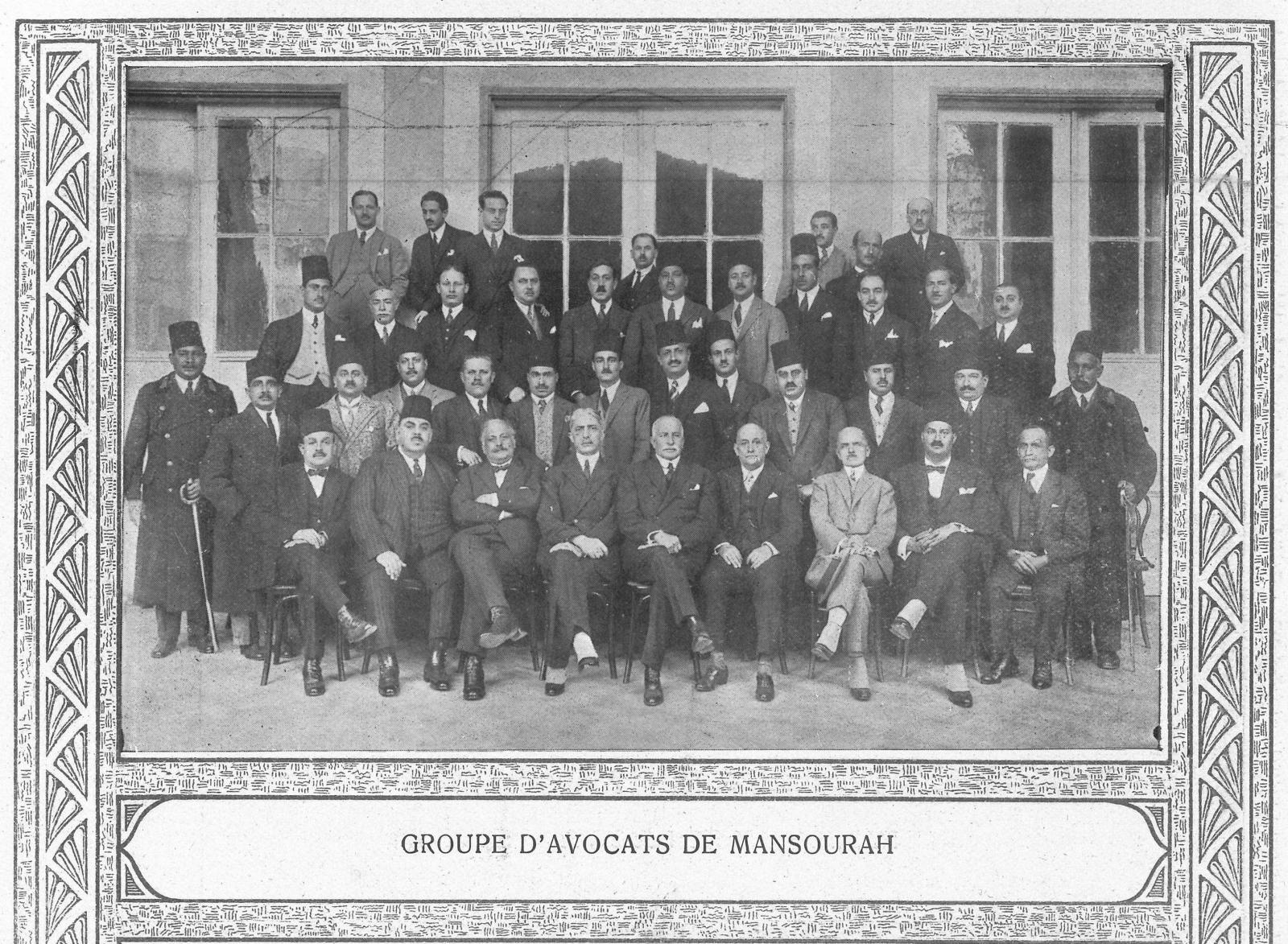
A. Cassis shown in 50th Anniversary volume as one of the group of lawyers of the Court of Mansourah (1st row, 1st from left=S. Cassis; 2nd row 6th from left=A. Cassis). The other individuals are names as (1st row, left-right: A. Gohargui, Camel Boutrous Bey, G. Mabardi, M. Michlopoulo, A. Maksud, A. Kindynékos, P. G. Bouboulis, Abdel Guélil Samra Bey, and S. Cassis; 2nd row left-right:H. Farag, A. Fadel, Z. Gaballa, J. Gouriotis, A. El Biali, A. Cassis, N. Bouez, S. Antoine, W. Salib, F. Michel, and R. Guirguis ; 3rd row left-right: S. Ekdaoui, D. de Botton, S. Lévy, A. Belloti, E. Daoud, Abdel Fattah Fahey, K. Tewfik, Abdel Bail Raglan , E. Sammé, B. Ghaliounghi, and M. Ebbo; 4th row left-right: P. Kindynécos, H. Maksud, B. Abboudy, M. Papadakis, Z. Picramenos, N. Kaznetsis, and C. Cottan. No roles or country affiliations are provided for these lawyers. (From: Les Juridictions Mixtes d'Égypte 1876-1926: Livre d'or Édité sous le Patronage du Conseil de l’Ordre des Avocats á l’Occasion du Cinquantenaire des Tribunaux de la Réforme, par le journal des Tribunaux Mixtes. Alexandrie, Egypte, Février 1926, pg.206).

Sketches by Mahmoud Saïd of a greffier "Chibli", possibly identified as serving in "Mansourah"(?) on the left and a goateed man identified as Maître “Massayardi (?) in the Didier Hess and Raswan volume 2 publication. “Massayardi’" is almost certainly Enrico Manusardi, identified in the 50th Anniversary volume as a Vétéran du Barreau on pg. 32 (with goatee). An Antonio Manusardi with a dark mustaches and no chin beard is shown as a former Bâtonnière of the Mixed Courts from the 1880s (pg. 207). Chibli is probably shown in 50th Anniversary volume in a photo on pg. 394 that I posted the 9th photo of my post of 29 April, 2019 as a Cis-Geffier of the Court of Mansourah (see the 3rd image below this one). (From: Didier Hess, Valérie & Hussam Rashwan (eds.), 2016. Mahmoud Saïd: Catalogue Raisonné Volume 2. Drawings. Skira Editore, S.p.A., Milano. [distributed in the USA, Canada, & South America by Rizzoli International Publications, Inc. New York; distributed elsewhere by Thames & Hudson Ltd. London]. Plate D 179, pg. 732. ©2016 Valérie Didier Hess; ©2016 Dr. Hussam Rashwan; ©2016 Mahmoud Saïd Estate; ©2016 Skira editors)
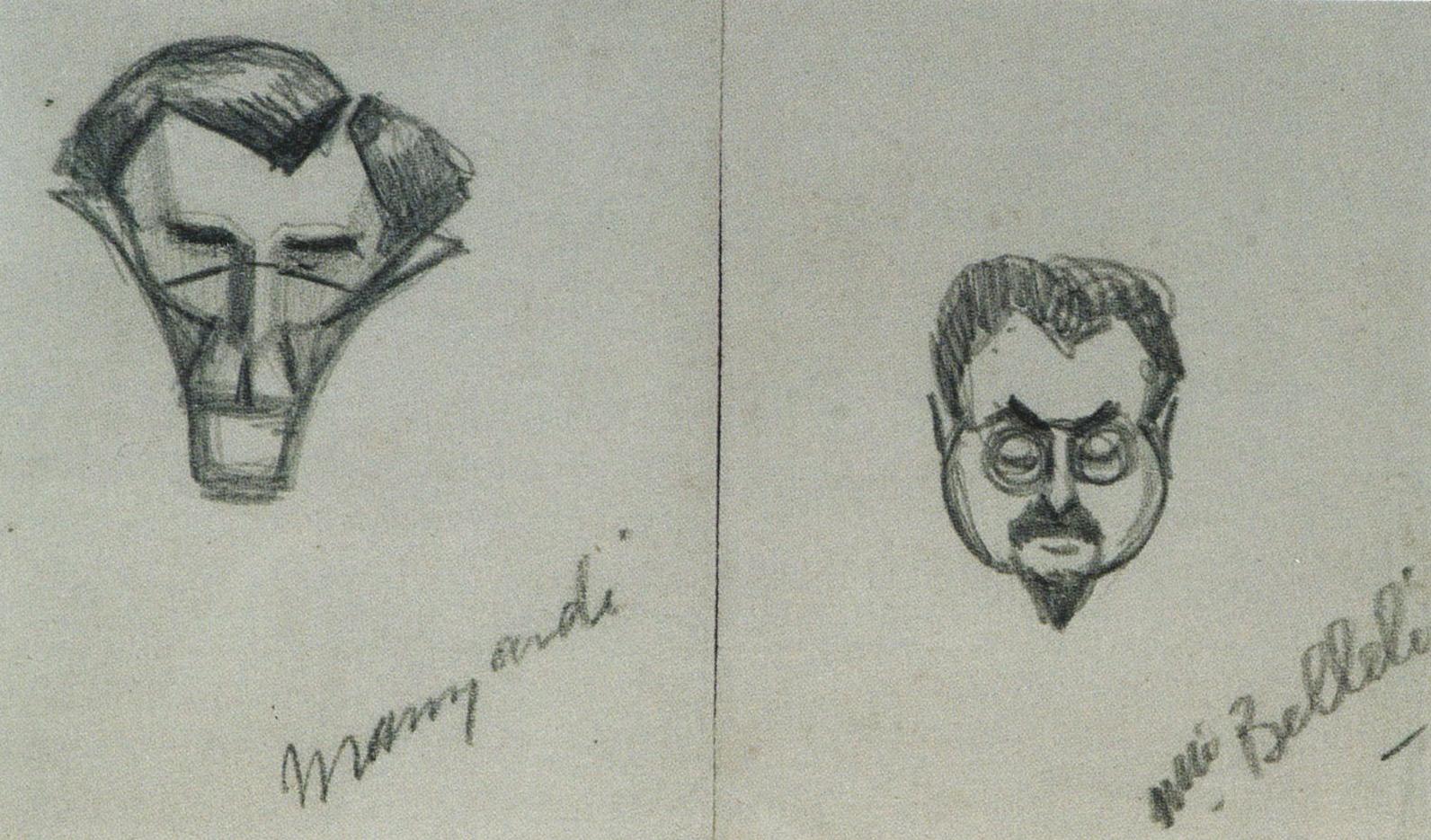
Another courtroom sketch by Mahmoud Saïd of Enrico Mansard (left, again with the idiosyncratic spelling or handwriting that Didier Hess and Rashwan transcribe as “Massayardi’") and of another individual named Maitre Belleli (right). The lawyer A. Belleli is shown in a large group photo of low resolution of Avocats to the Mixed Court in Alexandria on pg. 204 of the Les Juridictions Mixtes d'Égypte 1876-1926 volume (2nd row 3rd from the left), showing the same style goatee sketched here by Saïd. (From: Didier Hess, Valérie & Hussam Rashwan (eds.), 2016. Mahmoud Saïd: Catalogue Raisonné Volume 2. Drawings. Skira Editore, S.p.A., Milano. [distributed in the USA, Canada, & South America by Rizzoli International Publications, Inc. New York; distributed elsewhere by Thames & Hudson Ltd. London]. Plate D 178, pg. 732. ©2016 Valérie Didier Hess; ©2016 Dr. Hussam Rashwan; ©2016 Mahmoud Saïd Estate; ©2016 Skira editors)

Portrait of Enrico Manusardi in a section of the Les Juridictions Mixtes d'Égypte 1876-1926 volume showing Vétéran du Barreau. (From: Les Juridictions Mixtes d'Égypte 1876-1926: Livre d'or Édité sous le Patronage du Conseil de l’Ordre des Avocats á l’Occasion du Cinquantenaire des Tribunaux de la Réforme, par le journal des Tribunaux Mixtes. Alexandrie, Egypte, Février 1926, pg. 32)
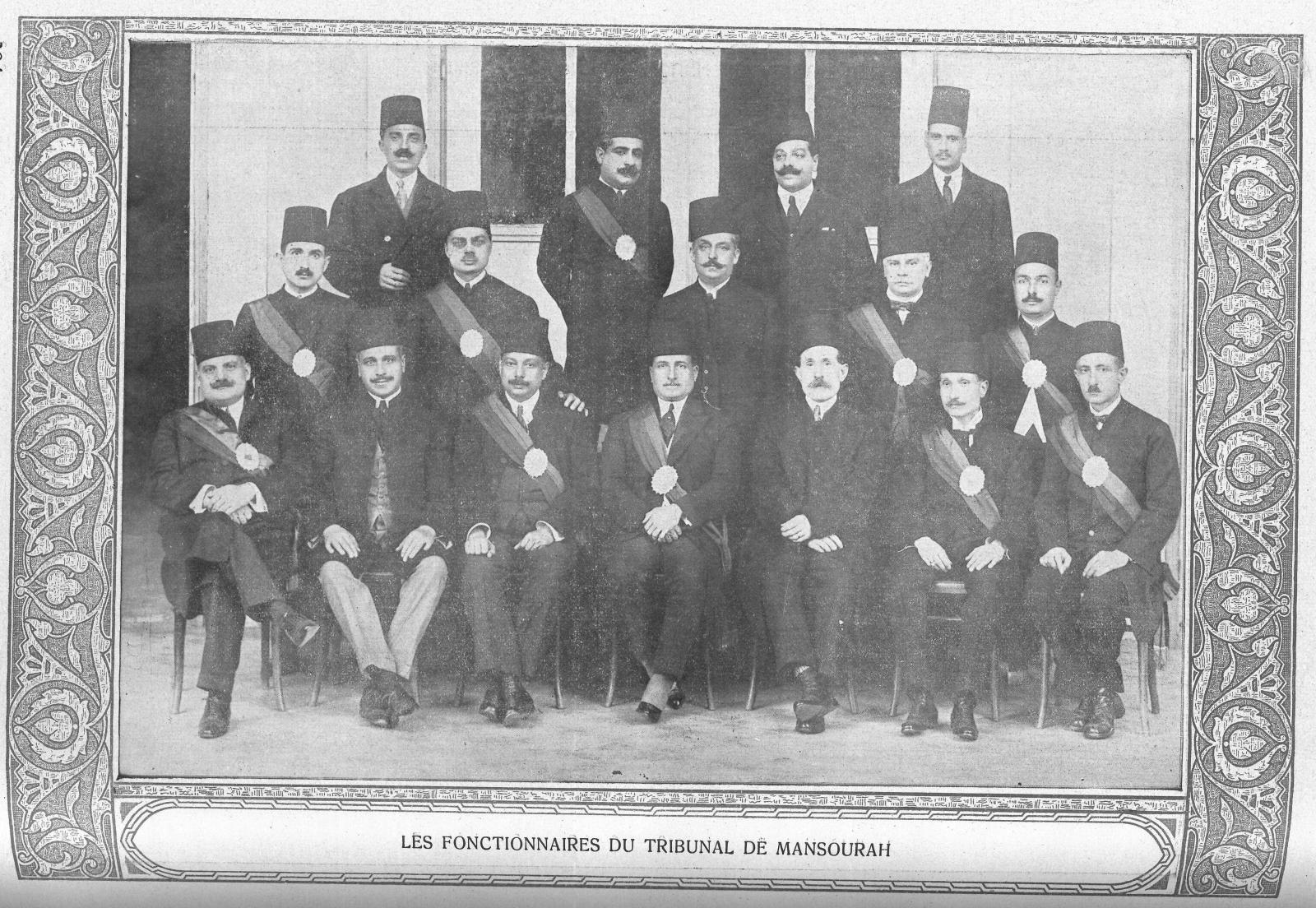
Portrait of functionaries serving the District Court of Mansourah in 1926 that I posted as the 9th photo of my post of 29 April, 2019 on this thread that shows an individual identified as Chibli (Cis-Greffier, no first initial or name given) in the second row, furthest to the right. It is unclear if this is the same individual sketched by Mahmoud Saïd in the 3rd picture above this photo. The names of the other individuals are provide in the legend to this image in my 29 April post. The functionary (Cis-Greffier) G. Cassis is shown in the 1st row, furthest left. (From: Les Juridictions Mixtes d'Égypte 1876-1926: Livre d'or Édité sous le Patronage du Conseil de l’Ordre des Avocats á l’Occasion du Cinquantenaire des Tribunaux de la Réforme, par le journal des Tribunaux Mixtes. Alexandrie, Egypte, Février 1926, pg. 394)

Mahmoud Saïd caricature sketch of unidentified lawyer (Alfred Tilche?) showing his robe and rabat. The curling lines and straight sketch lines on the lawyers left shoulder (the viewer's right) are probably the épitoge portion of the legal costume, rather than the braided cord shown on the same shoulder of Giuseppe de Semo's costume shown above. (identified by Didier Hess and Rashwan as a study of a lawyer or judge). (From: Didier Hess, Valérie & Hussam Rashwan (eds.), 2016. Mahmoud Saïd: Catalogue Raisonné Volume 2. Drawings. Skira Editore, S.p.A., Milano. [distributed in the USA, Canada, & South America by Rizzoli International Publications, Inc. New York; distributed elsewhere by Thames & Hudson Ltd. London]. Plate D 172, pg. 731. ©2016 Valérie Didier Hess; ©2016 Dr. Hussam Rashwan; ©2016 Mahmoud Saïd Estate; ©2016 Skira editors)

Mahmoud Saïd sketch of unidentified lawyer showing his robe and rabat. Corrctly identified as a lawyer. (From: Didier Hess, Valérie & Hussam Rashwan (eds.), 2016. Mahmoud Saïd: Catalogue Raisonné Volume 2. Drawings. Skira Editore, S.p.A., Milano. [distributed in the USA, Canada, & South America by Rizzoli International Publications, Inc. New York; distributed elsewhere by Thames & Hudson Ltd. London]. Plate D 252, pg. 746. ©2016 Valérie Didier Hess; ©2016 Dr. Hussam Rashwan; ©2016 Mahmoud Saïd Estate; ©2016 Skira editors)
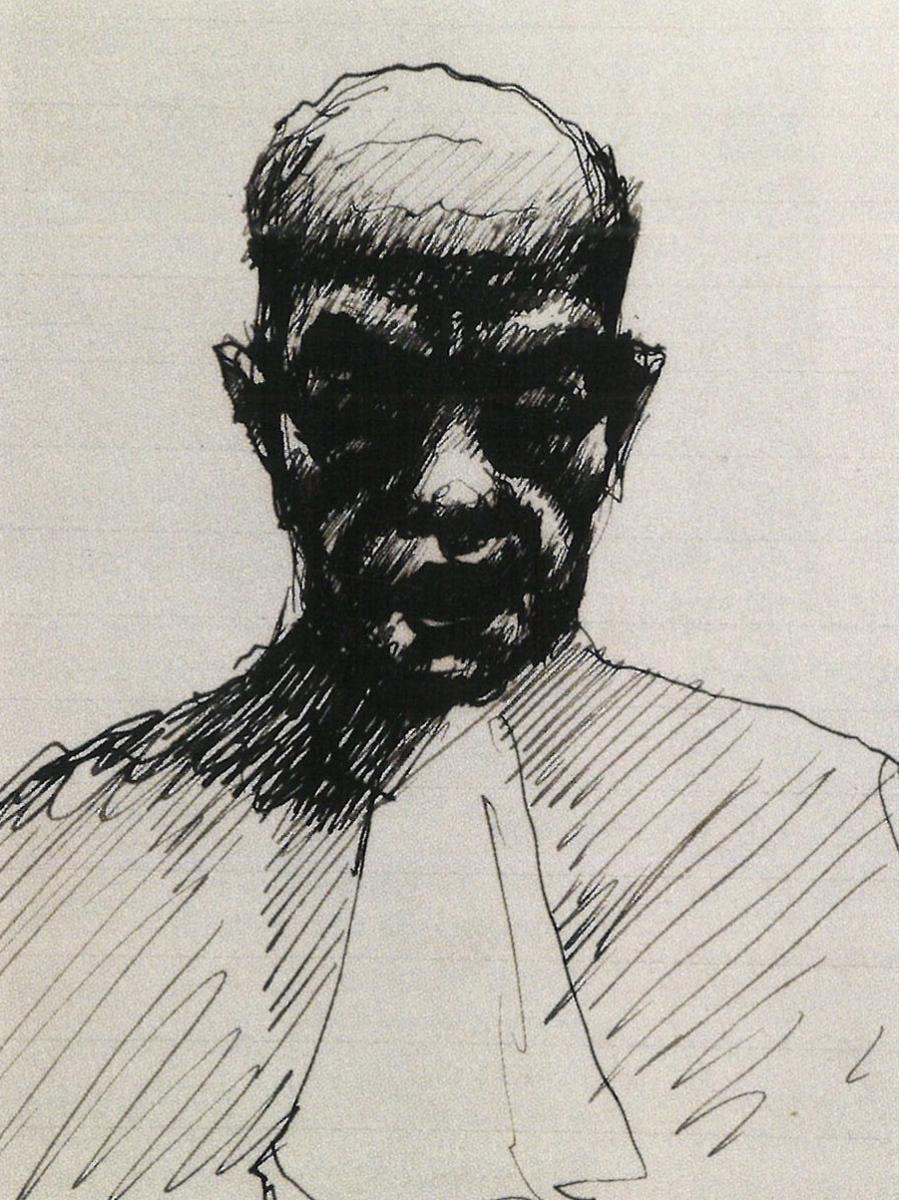
Mahmoud Saïd sketch of unidentified lawyer showing his robe and rabat. (From: Didier Hess, Valérie & Hussam Rashwan (eds.), 2016. Mahmoud Saïd: Catalogue Raisonné Volume 2. Drawings. Skira Editore, S.p.A., Milano. [distributed in the USA, Canada, & South America by Rizzoli International Publications, Inc. New York; distributed elsewhere by Thames & Hudson Ltd. London]. Plate D 189, pg. 735. ©2016 Valérie Didier Hess; ©2016 Dr. Hussam Rashwan; ©2016 Mahmoud Saïd Estate; ©2016 Skira editors)

Mahmoud Saïd sketch of unidentified lawyer showing his robe, rabat, and possibly part of the épitoge on his back. (From: Didier Hess, Valérie & Hussam Rashwan (eds.), 2016. Mahmoud Saïd: Catalogue Raisonné Volume 2. Drawings. Skira Editore, S.p.A., Milano. [distributed in the USA, Canada, & South America by Rizzoli International Publications, Inc. New York; distributed elsewhere by Thames & Hudson Ltd. London]. Plate D 164, pg. 730. ©2016 Valérie Didier Hess; ©2016 Dr. Hussam Rashwan; ©2016 Mahmoud Saïd Estate; ©2016 Skira editors)
Undated photo of an Egyptian lawyer from a May-July, 2019 eBay auction showing the lawyer's costume of the robe, rabat (scarf), beretta (cap), and the épitoge on the wearer's left shoulder The portion draped down his arm should normally be worn over the wearer's back (see the illustration of the full Appeals Court in session in February of 1926 posted above to show Alfred Tilche in court). The costume is derived from French legal and academic regalia. (From: https://www.ebay.com/itm/EGYPT-OLD-VINTAGE-PHOTOGRAPH-The-young-judge-with-the-scarf-PHOTO-KEROP/312570975092?hash=item48c6ae9374:g:BvgAAOSwumxcslyl)
Undated photo of a woman lawyer in Egypt showing the épitoge on the wearer's left shoulder, in this case with the crescent and one star seen in other images I have posted, probably suggesting early republic era legal regalia. The crescent and star attached to the épitoge also is shown in the picture of the young boy from the eBay auction (incorrectly titled "The Little Judge", showing 3 stars above the crescent) that Chris W posted on 8 August, 2019 and I posted on 31 October, 2018, both on this thread. These are the only images I have seen of these insignia attached to the French academic scarf (épitoge) and not on a sash, as several images I have uploaded here in this thread show (possibly for some judges and also for lawyers after the Mixed court was abolished in 1949 and before the eagle of Saladin was attached to judicial sashes, sometime after he 1952 revolution). (From: https://www.ebay.com/itm/EGYPT-OLD-VINTAGE-PHOTOGRAPH-CUTE-LAWYER-WITH-THE-SCARF-HAND-COLORED-/273361632578?nma=true&si=mpDX%2FvmJ3j93DINpvfI%2FS1m09vQ%3D&orig_cvip=true&nordt=true&rt=nc&_trksid=p2047675.l2557)
0 -
I came across the portrait of Émile Froment-Meurice shown below from the French language Wikipédia site this February, but have been so busy I never posted it. I have wanted to include it here, as small homage to the man who designed this beautiful badge for Khedive Isma'il Pasha. As I noted in my 28 February 2019 post on this thread about details hallmarks on the Egyptian Mixed Court badges (principally from available photographs and information on auction listings), Maison Froment-Meurice originated as a goldsmith workshop founded by François Froment (1773-1803) in 1801. The name Froment-Meurice derives from Émile’s paternal grandmother having married her husband’s (François Froment) partner (the goldsmith Pierre-Jaques Meurice) following her husband's death in 1804, changing the workshop name to Froment-Meurice. Émile’s father, François-Désiré Froment-Meurice took over the shop in 1832. He became a very successful goldsmith and jeweler. Most sources indicate that Émile Froment-Meurice took over the workshop following the death of his father, François-Désiré Froment-Meurice (born 1802), in 1855 (some sources suggest he assumed ownership in 1859). 1907 is the date when Émile Froment-Meurice retired and sold his business (although some sources indicate that he continued to run Atelier Froment-Meurice until 1913, this almost certainly is not true). His sons did not wish to continue in the business. When Émile Froment-Meurice ran the atelier he lived at 46 rue d'Anjou in Paris. He sold the workshop and his clientele to Georges Auger in 1907, a goldsmith-jeweler living in Paris. Maison Augere was founded by Alphonse Auger (1837-1904) and the shop was moved to 54 rue Etienne-Marcel in approximately 1890. Many of Alphonse Auger's jewelry pieces are markedly art deco in design, or French Art Nouveau. George Auger began to work with Alphonse in 1900. His workshops products after 1907 are known to bear the mark "Auger-Froment Meurice" for an unspecified time (it appears that later work is simply identified as "Auger"), although I have not seen any of the Mixed Court badges with this hallmark. The address 372 rue Saint-Honoré, 75001, Paris is the one that appears in all the the photos of cases I have seen images of (11th and 13th photos in my 28 February post). This location of the atelier dates to at least 1859 (see the advertisement below).
The date when Émile Foment-Meurice retired (1907) raises several questions about when Maison Froment-Meurice actually received the commission to design this badge and how long the workshop produced them. Although several sources (including Fritz Rudolf Künker GmbH & Co. KG's auction description of a Stobbe-manufactured District Court judge’s badge made of gold and silver) identified 1907 as the date of this commission by Khedive Abbas Hilmi II, this date must be incorrect. First, It would have been impossible for Froment-Meurice to have been commissioned to produce the badges in 1907 and create a sufficient number before he retired in that same year to represent the number currently available in auctions. Second, the Mixed Courts were created by Khedive Isma'il Pasha (Abbas Hilmi II's grandfather) in 1875 following the skillful and long campaign of judicial reform by his Foreign Minister Nubar Pasha. I have not yet found a reliable reference about the date when this badge was designed by Émile Froment-Meurice as a commission from Khedive Isma'il Pasha. However, it could not have been in 1907 when Émile Froment-Meurice retired. I noted in my second post on this thread on 21 November, 2016 that Richard Beardsley, (the Consul General for the US in Cairo from 1870 -1876) described the judicial costume of the Mixed Courts in a letter of 15 July, 1875 to Hamilton Fish (the US Secretary of State from 1869-1877) including the use of these judicial badges: "...Over the shoulder and around the body is worn a broad scarf, to which is attached a large and very handsome badge of office. The badge consists of a shield resting upon a drapery, bearing various appropriate devices, from beneath which radiate the rays of a many-pointed star. On the shield is engraved in Arabic 'Law is the foundation of justice.'..." (From: EXECUTIVE DOCUMENTS PRINTED BY ORDER OF THE HOUSE OF REPRESENTATIVES. 1875-'76. WASHINGTON: GOVERNMENT PRINTING OFFICE. 1876; PAPERS RELATED TO FOREIGN RELATIONS The United States, TRANSMITTED TO CONGRESS, WITH THE ANNUAL MESSAGE OF THE PRESIDENT, DECEMBER 6, 1875. PRECEDED BY A LIST OF PAPERS AND FOLLOWED BY AN INDEX OF PERSONS AND SUBJECTS. VOLUME II. WASHINGTON: GOVERNMENT PRINTING OFFICE. 1875. pp. 1347-1348). Egyptian Zogist provided a better translation of this motto in his post of 23 November, 2016 on this thread as "Justice is the foundation of kingship/governance". This indicates that the Froment-Meurice designed judicial badge was in use almost from the origin of the Mixed Courts. I also noted in my second post on 21 November, 2016 that another source (Wilner, Gabriel M. 1975. The Mixed Courts of Egypt: a study on the use of natural law and equity. Georgia Journal of International and Comparative Law vol 5 (no 2): pp. 407-430) quoted a statement by W. Burdick (W. Burdick,1939. Bench and Bar of Other Lands, pp. 495-496) which claimed that the costume of judges in the International Mixed Courts (Egyptian and foreign) were the judicial robes of their home countries (on pg. 412). However, Beardsley provides an eyewitness account in July1875 of the uses of a standardized national costume for judges of the Mixed Courts and the use of these large and beautiful judicial badges. At the time that Burdick was writing in 1939, photographic evidence clearly indicates that both Egyptian and foreign judges wore the standard stamboul coat, tarboosh, sash, and the heavy judicial badge of the Froment-Meurice design. I do not know whether the other manufacturers of these badges (Stobbe of Alexandria, Horovitz of Alexandria, M. Laurencin & Cie. of Alexandria, and Zivy Frères & Cie. of Alexandria) began to make them before Froment-Meurice's retirement in 1907, or only after this date. The Mixed Courts' judicial badges were apparently not made by his successor after Froment-Meurice sold the business to Auger. As noted above, following Georges Auger's purchase of the atelier, his pieces were marked "Auger-Froment Meurice" (see the last photo of this post showing an example with that name on the inside of the presentation case of a Laotian Order of the of the Million Elephants and White Parasol). The period when Froment-Meurice manufactured these badges is most likely between 1875 and 1907.
Émile Froment-Meurice and his wife Rose Tassin de Moncourt (1839-1913) both died in the catastrophic collapse of their mansion, located at No. 46 rue d'Anjou in Paris. Their son, Jacques Charles Francois Marie Froment-Meurice (1864-1947) was a sculptor who studied with Henri Michel Antoine Chapu, the celebrated French sculptor and medalist (1833-1891).
.jpg.30531849d18c777981a746af1c410f3e.jpg)
Pierre Henri Émile Froment-Meurice at the age of 48 (born 21 March, 1837 in Paris, died 21 April, 1913 in Paris) from Le mode illustré, 3 October, 1885. His profession is described as a goldsmith and jeweler, and both his father and grandfather also were goldsmiths. (From: https://fr.wikipedia.org/wiki/Émile_Froment-Meurice)
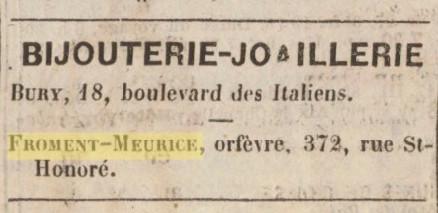
Advertisement by Émile Froment-Meurice from 1859 in the Courrier des Chemins de Fer identifying the 372 rue Saint-Honoré, Paris address for the workshop that appears on the case linings for the Mixed Court judges' badges made by Froment-Meurice. (From: https://www.richardjeanjacques.com/2019/02/les-froment-meurice-2-eme-partie-emile.html)

Page from Émile Froment Meurice's award as a Knight of the légion d honneur in 1869, following winning the gold medal in the 1867 Exposition universelle de Paris. His father had been awarded a Knighthood in the légion d honneur in 1832. (From: https://www.richardjeanjacques.com/2019/02/les-froment-meurice-2-eme-partie-emile.html)
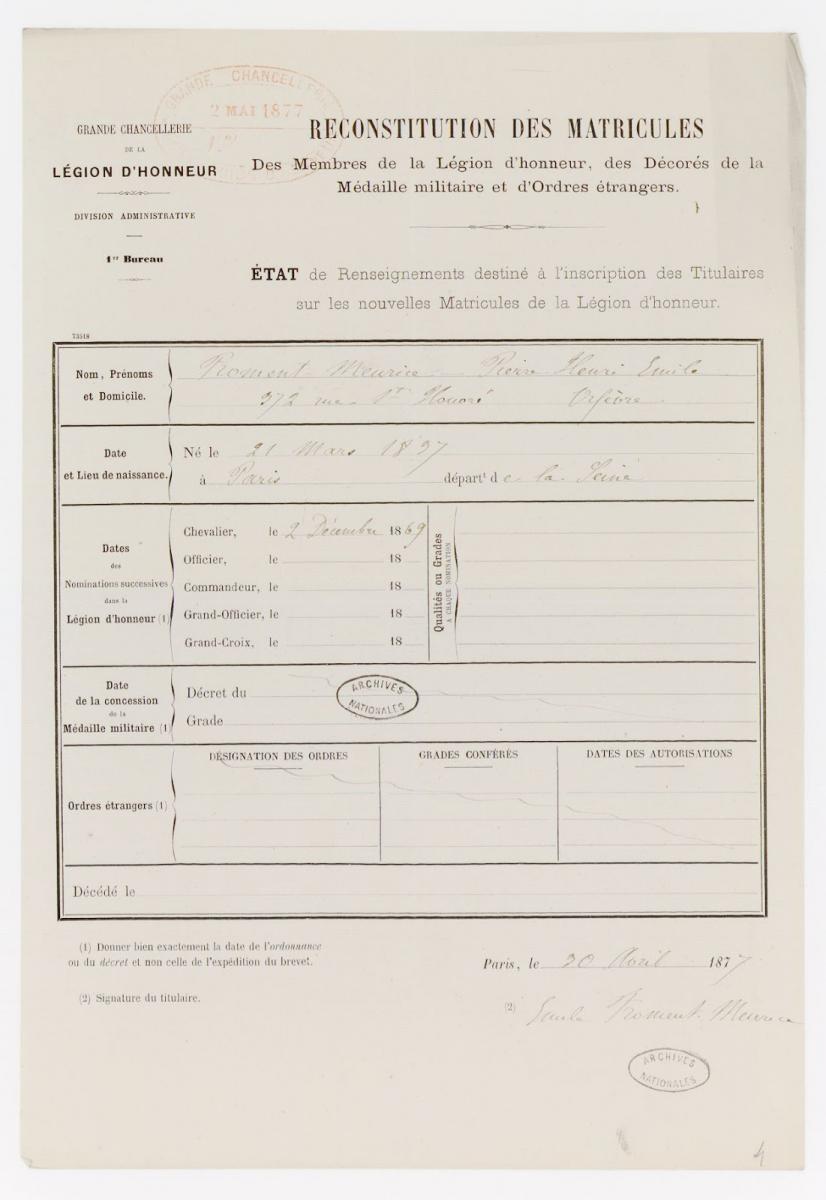
One of the extant pages from the reconstitution of Émile Froment Maurice's to the légion d honneur in 1877. (From: https://www.richardjeanjacques.com/2019/02/les-froment-meurice-2-eme-partie-emile.html)
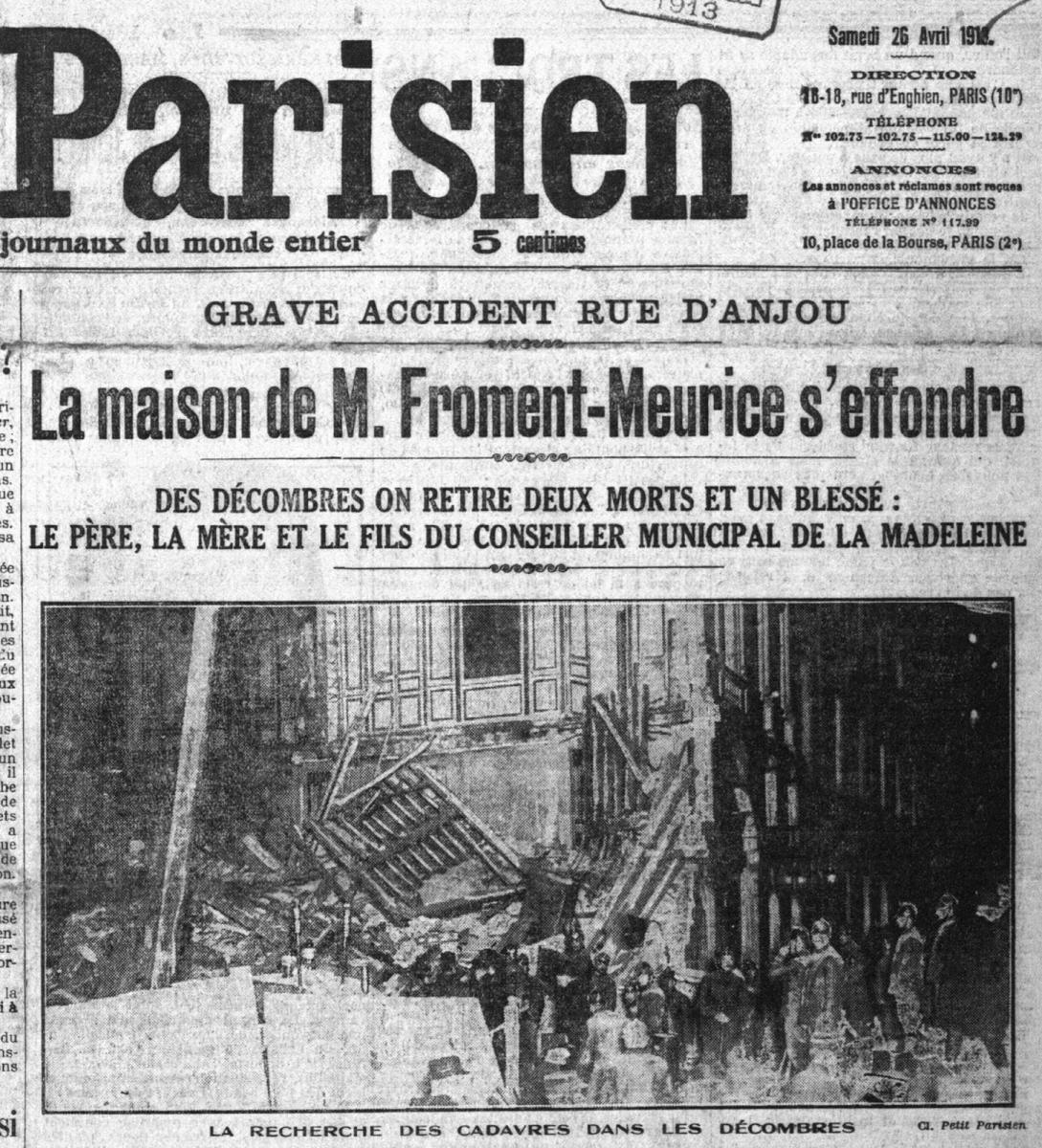
Front page of Le Petit Parisien of 26 April, 1913 carrying the story of the collapse of Froment-Meurice's mansion and Émile Froment Maurice's death. (From: https://www.richardjeanjacques.com/2019/02/les-froment-meurice-2-eme-partie-emile.html)
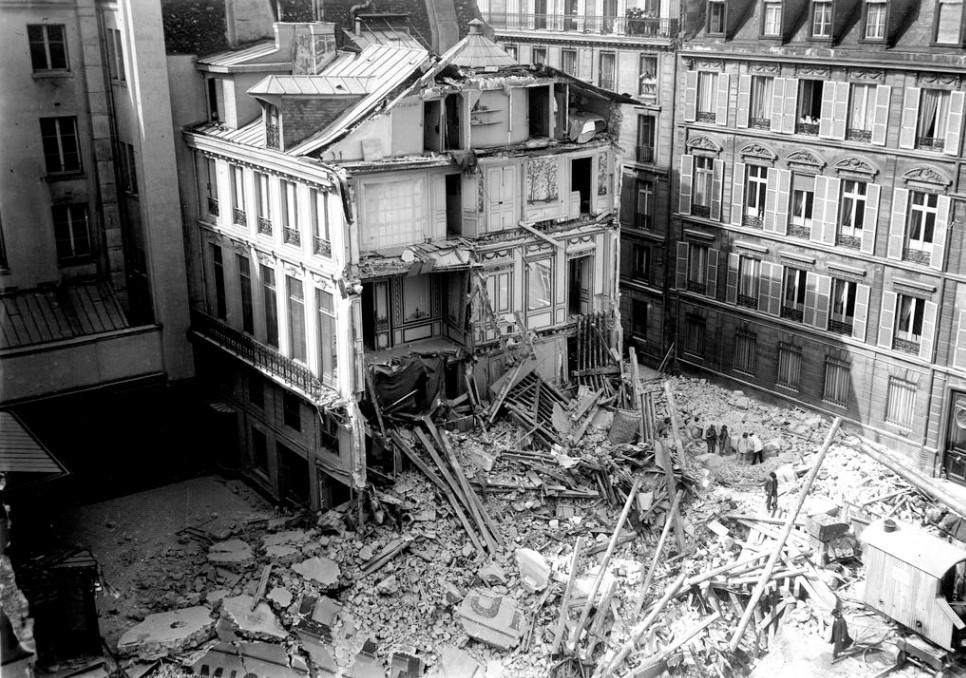 Photo of the collapsed Froment-Meurice mansion at 46 rue d'Anjou in Paris (From: https://www.richardjeanjacques.com/2019/02/les-froment-meurice-2-eme-partie-emile.html)
Photo of the collapsed Froment-Meurice mansion at 46 rue d'Anjou in Paris (From: https://www.richardjeanjacques.com/2019/02/les-froment-meurice-2-eme-partie-emile.html)
 Death certificate of Émile Froment Meurice (From: https://www.richardjeanjacques.com/2019/02/les-froment-meurice-2-eme-partie-emile.html)
Death certificate of Émile Froment Meurice (From: https://www.richardjeanjacques.com/2019/02/les-froment-meurice-2-eme-partie-emile.html)
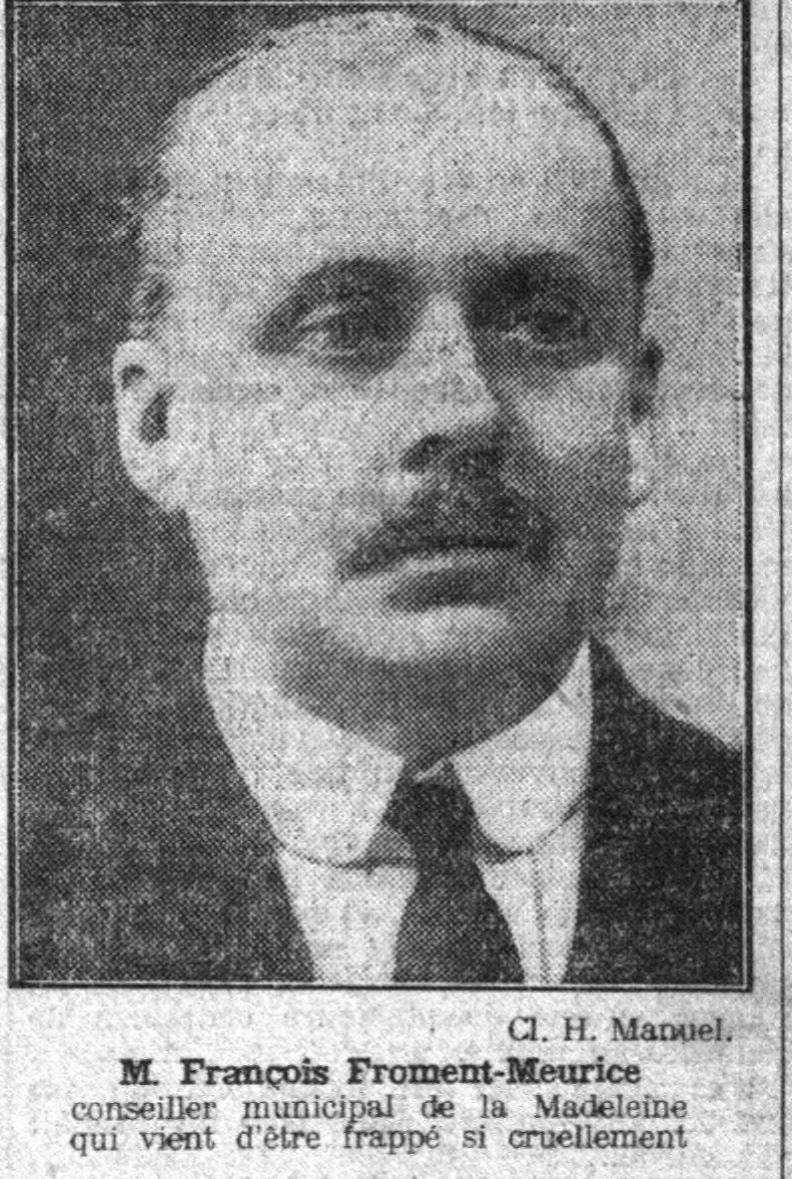
Newspaper photo from Le Petit Parisian of François Foment-Meurice, the 20 year-old grandson of Émile Froment Meurice, who was the only other person also buried in the mansion's collapse but survived. A cook and a valet de chamber in another part of the house also survived the disaster. (From: https://www.richardjeanjacques.com/2019/02/les-froment-meurice-2-eme-partie-emile.html)
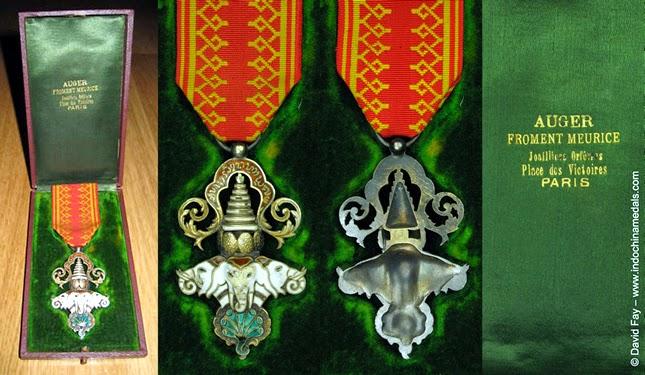
An example of a medal created by Maison Auger-Froment Meurice following Georges Auger's purchase of Maison Froment-Meurice: the Laotian Order of the Million Elephants and White Parasol made by Auger-Froment Meurice. I know nothing about this award, (but see GMIC links:
but it apparently was created on 1 May, 1909, by Royal Order of Laos, and amended 18 August, 1923 (or in 1927?) as 4 classes. On 10 October, 1936 a 5th class and a collar was added. The Order was abolished in 1975. It was awarded for civil and military merit relating to the Kingdom's development and dedication to France. The 1923 (1927?) amendment allowed the Order to be given to individuals with 10 years of military or civilian service in France, Indochina, or other French colonies. The address Place des Victories on the inside lid is simply a portion of the same address that Auger opened in 1900 at 54 rue Etienne-Marcel, place des Victories. (From: https://www.richardjeanjacques.com/2014/10/la-maison-de-joaillerie-auger-alphonse.html; copyright: David Fay-www.indochinamedals.com))
0 -
I just came across 2 examples of Mixed Tribunals judges' badges from a recent auction (June 2019) by Lugdunum GmbH that is archived on the CoinArchives.com website. One of these is a silver badge made by Froment-Meurice. The other badge is bit odd. It is described as made of bronze, and all elements of its design are executed in much less detail than any badge I have illustrated in this thread, except the strange "pin" version in my post of 8 December, 2018. All of these photos can be enlarged to see them in greater detail.
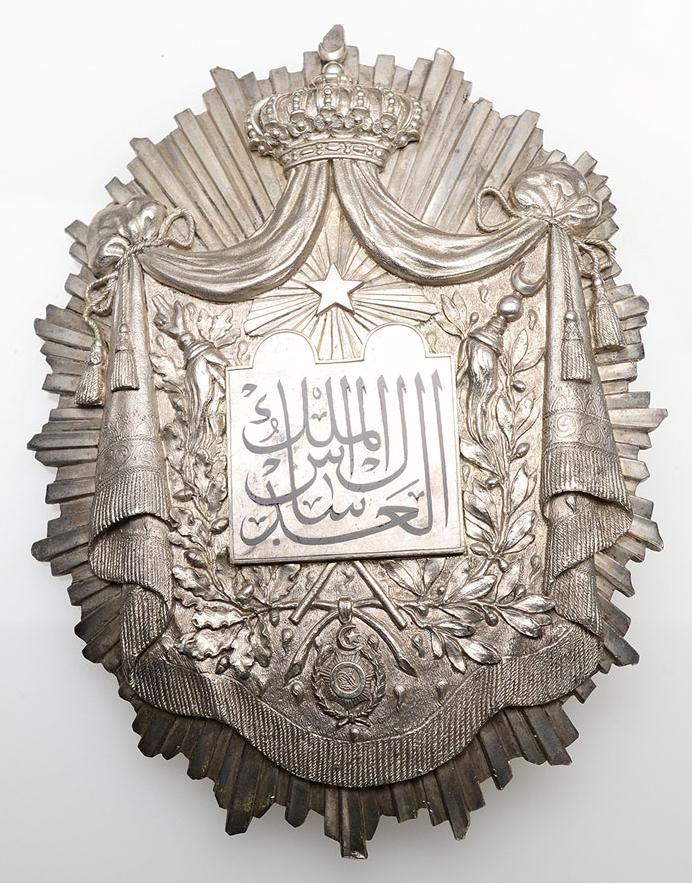
Obverse of a silver Mixed Courts judges badge (possibly from the Parquet) made by Froment-Meurice from a 19 June, 2019 auction by Lugdunum GmbH (Auction 16, Lot 288) archived on the CoinArchives.com website. The description states that this badge is from Alexandria and gives an approximate date of 1892 (probably "identified" simple as it is the year Abbas Hilmi II became Khedive of Egypt), although no basis for this identification is provided. As noted in my post of 28 February, 2019 on this thread, the auction house Fritz Rudolf Künker GmbH & Co. KG's auction description of a Stobbe-manufactured District Court judge’s badge made of gold and silver identified 1907 as the date of this commission by Khedive Abbas Hilmi II (a highly problematic date for this commission as the badges appear to have been in use by 1875 under the reign of Khedive Isma'il Pasha, who authorized the creation of the Mixed Courts-see my next post of 15 August). The creation of this badge for the Mixed Courts’ judges may have been associated with a judicial costume change from the earliest practice of each judge (foreign and Egyptian) wearing their own country’s judicial robes to a standardized Egyptian costume of tarboosh, stamboul coat, along with the differently-colored sashes and this large badge (also see my discussion in the 4th paragraph of my 24 March, 2017 post in this thread, but also the updated information in my next post of 15 August). The auction description says it is silver plated, however these badges are solid silver. The badge measures 85 mm wide x 115 mm high and weighs 141.76 g. (From: https://www.coinarchives.com/w/lotviewer.php?LotID=3972878&AucID=4100&Lot=288&Val=f97e5c722c28c73add7c029f374c845e)
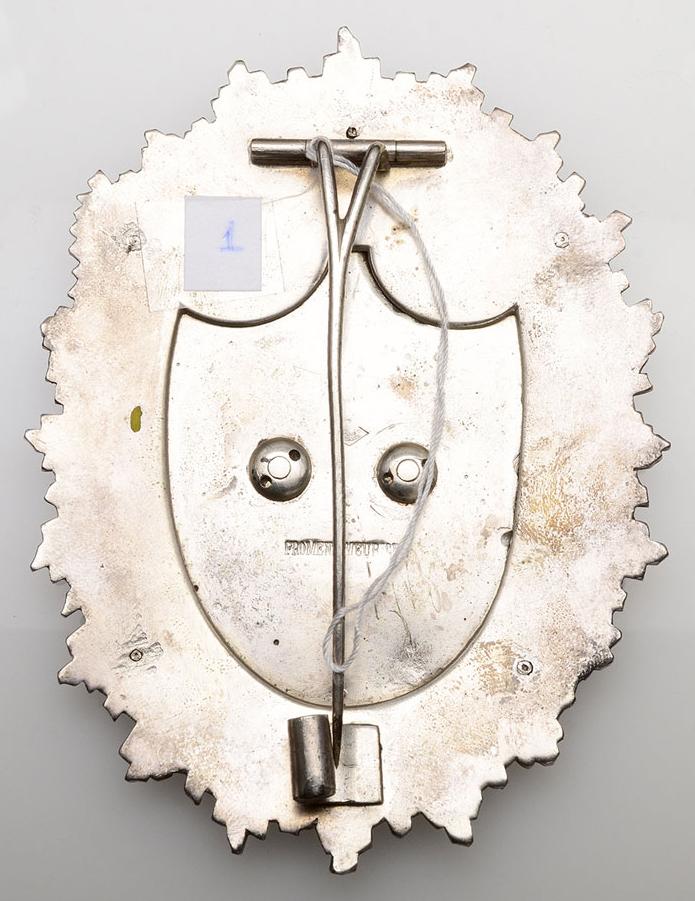
Reverse of the same silver badge from the June 2019 auction of Lugdunum GmbH showing the Froment-Meurice name in the lower third of the central depression and the diamond-shaped Froment-Meurice maker's hallmark just above the fasteners for the obverse tablet inscription piece and to the right of the tunic pin (the image is not high-enough resolution to see this hallmark even when enlarged). This is only the second example I have seen photos of that has this diamond-shaped hallmark and the "FROMENT-MEURICE" name in this lower position. The other example with the diamond-shaped hallmark and lower stamped name is shown in a higher resolution image on the 12th image of my post of 28 February, 2019 on this thread; on a named badge belonging to the Greek Judge Apostolo N. Gennaropoulo of the Mixed Tribunals' Parquet of Alexandria. Below is the illustration of this hallmark that I included in that 28 February post showing the design with the "FROMENT" name above a stylized rose with the bud toward the right, and "MEURICE" below the rose. As can be seen on this thread, all other examples of Froment-Meurice manufactured judges badges that have available photos of their reverse have the name " FROMENT-MEURICE" stamped above the central fasteners. There appear to be metal tool marks visible on the lower left rivet, and possibly on the upper left rivet as well. This may suggest an attempt to disassemble the badge elements. No assay marks are present, but I have not seen any on other photos of the reverse of Froment-Meurice made badges.

Drawing of the Froment-Meurice rose hallmark used by Maison Froment-Meurice. As noted in my original post of this hallmark on 28 February, 2019, I do not know the date ranges for the use of this hallmark, nor whether temporal use or other reasons are responsible for the lack of this hallmark and the higher position of the "FROMENT-MEURICE" stamped name on most examples of the judicial badge made by this Parisian workshop that created the original design of this badge. (From: https://www.langantiques.com/university/Froment-Meurice_Jewelry_Maker%27s_Mark)
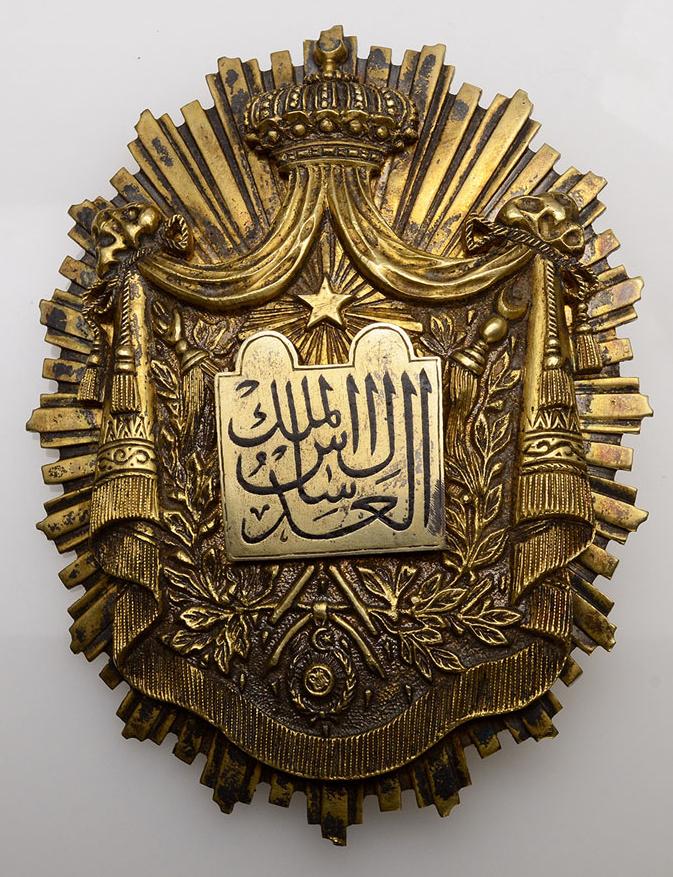
Obverse view of this unusual version of the Egyptian Mixed Courts judicial badge. This example also is from a 19 June, 2019 auction by Lugdunum GmbH (Auction 16, Lot 289) archived on the CoinArchives.com website. The auction description identifies the metal as bronze, a material not used for any authentic judicial badges of the International Tribunals (gold was used for the Appeals Court; silver & gold for the District Courts; and silver was used for the Parquet, but also see some complexities of costume outlined in previous posts on this thread). The description repeats the probably spurious association with Alexandria and a date of c.1892. This piece is the same size as all other judicial badges (85 mm wide x 115 mm high) and weighs 196.22 g. The offering is associated with a case identified as the original box of issue, but no manufacturer is identified. It is apparent that almost all aspects of the design of this badge are of much lower craftsmanship than any other genuine badges, with the possible exception of the rays forming the base embellishment. Even the example I posted on April 24, 2019 made by Zivy Frères & Cie. that exhibits the lowest level of detail of any badge is not of such poor artistry as this badge from the Lugdunum GmbH. The obvious jewelry mimic "pin" mentioned above and shown in my post of 8 December, 2018 in this thread was apparently never intended to be taken as a genuine judge's insignia of office, and is merely inspired by the form of the Mixed Court badges. The calligraphy on the central tablet above shows a number of differences and omissions compared with all other badges. The ornamental design in the folds of the drapery of the mantle are highly abbreviated and incompletely present on the long vertical folds. The laurel leaves on the right side of the tablet are hollowed and lack any realistic execution. The oak leaves on the left side of the tablet also are very poorly formed in comparison with all other examples. The horses' tails on the tughs (at each of the upper corners of the central inscribed tablet), the tasseled cords, the exterior mantle folds, the superior crown, the Order of Medjidie symbol, and even the star and its radiant surround above the tablet, all are much less detailed. Many of the small ermine tail embellishments on the interior of the mantle are missing, and all are made with no detail beyond mimicking the shape on other badges. The interior of the mantle is simply a rugose pattern, with no attempt to make it resemble the furred interior. It is clear this is not a genuine example used by a member of the Mixed Courts judiciary or other officials occasionally shown wearing this badge. The bronze material and poor detail are inconsistent with the range of variability seen across the several manufacturers of this insignia. I believe this could be an Egyptian manufactured replica for the tourist trade, but whether it comes from the early 20th century or was made more recently is unclear. This mock badge and the very abbreviated "pin" example shown in my 8 December, 2018 post are the only examples I have encountered of full-sized pieces based on the design of this judicial badge that are clearly not authentic regalia of the Mixed Courts. (From: https://www.coinarchives.com/w/lotviewer.php?LotID=3972879&AucID=4100&Lot=289&Val=efc6a2fa2700e6a994f8217cb7d28a9c)
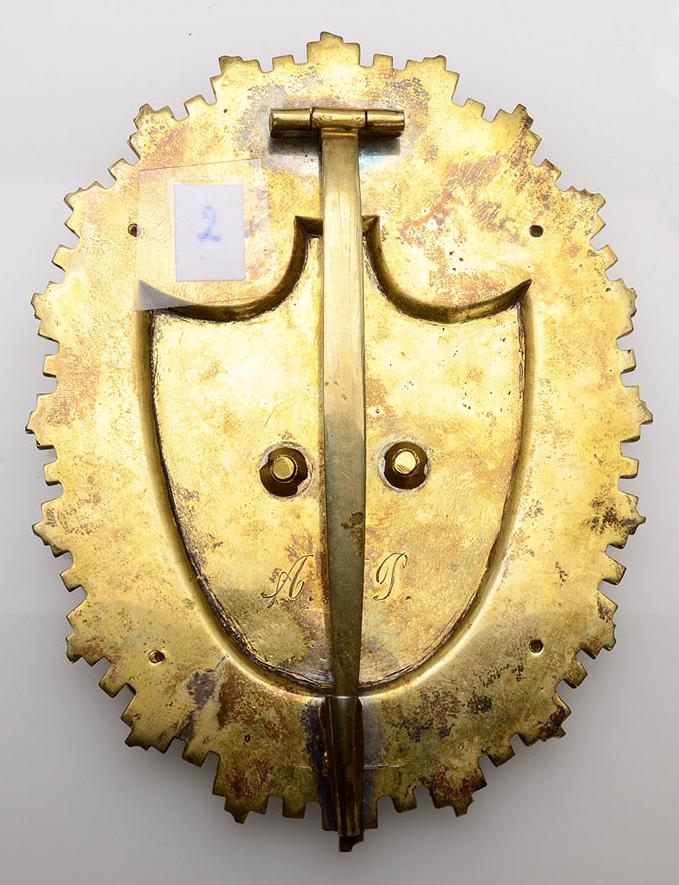
Reverse of the same bronze badge from the June 2019 auction of Lugdunum GmbH. The central fasteners may be somewhat different than most examples, but the broad and flat tunic pin is clearly unusual compared with all others seen on these badges (even the "pin' version has the narrower tunic pin seen on all other examples). There are no manufacture's or assay hallmarks (Egyptian bronze was probably excluded from the need to have assay, Egyptian manufacture, and date hallmarks as were required for gold, silver, and platinum). The two engraved letters, "A." and either "I." or "J.", "S.", "T.", or possibly "G.", likely are initials of an owner, or alleged owner, of this piece.
0 -
Chris, yes this image is still for sale on eBay and I posted this same image in my second post of 31 October, 2018 (4th photo). Although the seller titles this "The Little Judge", the accessory on the boy's left shoulder is actually an epitoge, the French academic equivalent of the British & American hood for academic costumes. In Egypt, this is worn by lawyers, not judges. I noted in that post of 31 October that this image represents a hybrid costume, but did not state that the tarboosh should be a biretta for a lawyer's costume. See the 4th photo of my post of 1 April 2019 showing several lawyers in front of judges in the Court of Appeals in February, 1926, showing several wearing the epitoge and some wearing the biretta. I have a few images of lawyers in the Mixed Courts that I am organizing to post in this thread soon, in relation to additional images associated with Mahmoud Saïd, the judge and Egyptian modernist painter.
0 -
Owain noted in his first post of 6 December, 2017 on this thread “Miniatures of the Middle East & Arab World” that some miniatures of the Order of Ismail were made by Gardino of Rome. I have not yet come across any images of Egyptian medals made by this manufacturer (but my investigations are limited to only a couple Egyptian awards), and I have not seen any manufacturer’s hallmarks for E. Gardino on any of the miniatures of the Order of Ismail, I wanted to provide some examples of Gardino’s hallmarks. I would be very interested in seeing photos of this hallmark on any Egyptian medals if some of the GMIC collectors have them.
The Gardino webiste (http://www.gardino.it/chi.html) identifies the Gardino name as associated with the original Fratelli Borani medalist company that first appears in written documents approximately in 1850 in Turin, although its founding date is unknown. A branch of that office was moved to Florence in 1864 when the capital was shifted, and later to Rome in 1871 following the unification of Italy. The Borani brothers got out of the precious metals trade, and the company was taken over by Domenico Cravanzola, who had been the director under the Fratelli Borani. He sold the business in 1913 to Luigi Raviolo and Enrico Gardino. Gardino’s son, Ettore, took over the business from Raviolo in 1927 and changed the shop name to “Gardino Succ.ri Ditta D. Cravanzola s.a.s.”
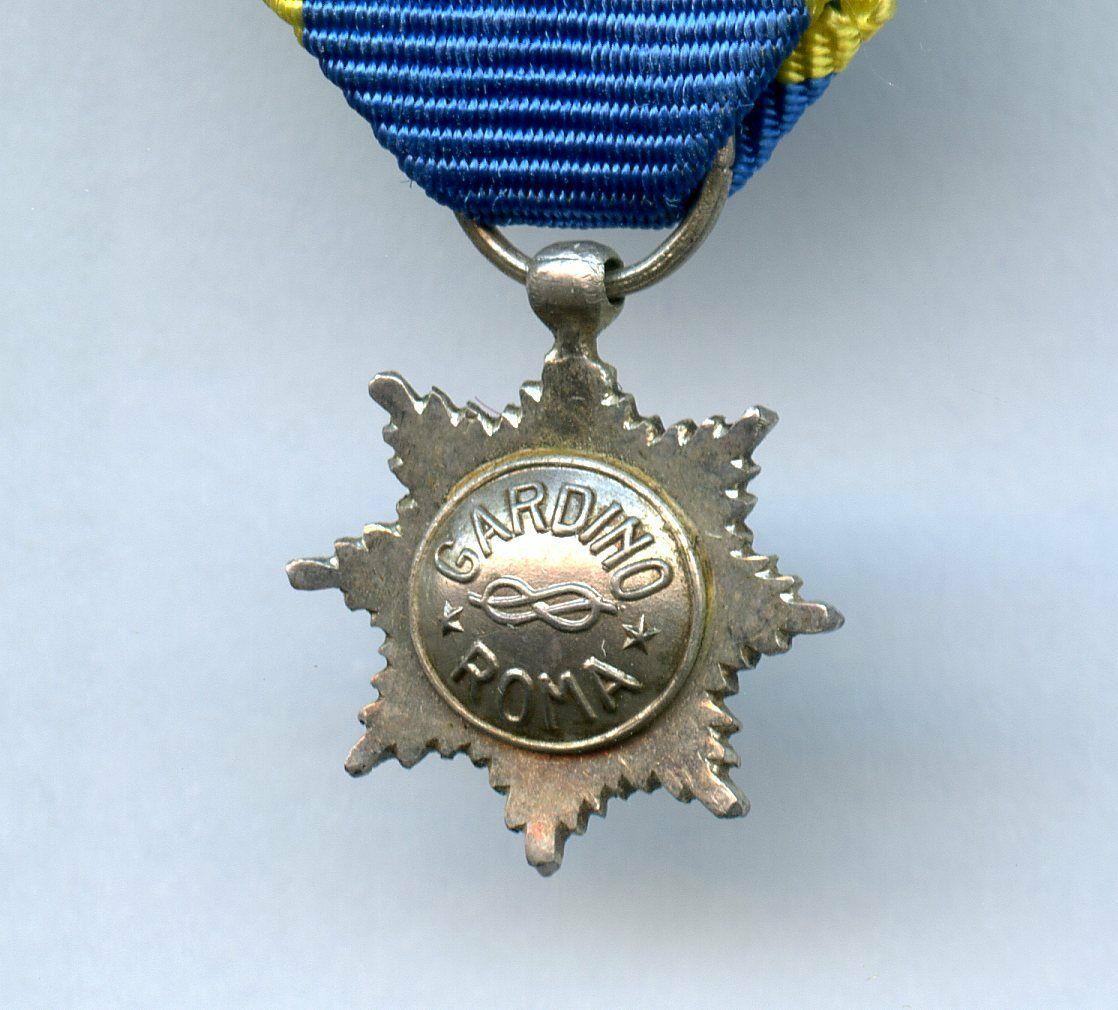
The above image is the only photo I have currently found that represents a miniature identified as having been made by Gardino showing a manufacturer’s hallmark. This is a photo of the reverse of a medal identified as a miniature of the Latvian Order of Three Stars. The photo comes from a current eBay auction (https://www.ebay.com/itm/371762626684?ul_noapp=true) and the description indicates a date range of 1924-1940, and suggests this is a “Grand Cross” breast star miniature. The knotted cord is a component of the wreath surrounding the central shield on several of the following hallmark photos, shown in the 5th, 8th, and 9th examples below (especially visible in the eMedals examples of the Italian Order of the Crown and the Albanian Order of Scanderbeg and less clearly on the Vatican Order of Our Lady of Bethlehem). This also is the only example of a hallmark I have come across attributed solely to Gardino and not linked to Cravanzola. The stars separating "GARDINO" and the knot from "ROMA" are seen on each side of the word "*ROMA*" in several examples of the most common form of the Gardino hallmark, also shown below in the 5th, 8th, and 9th photos. No dimensions are given for this particular miniature medal.
I am not familiar with the medals produced by these workshops nor with any of the medals shown below, but am including these to show available images of potentially relevant Gardino manufacturer’s hallmarks in the hope they may stimulate contribution of some examples on Egyptian awards, especially any miniatures, and/or some discussion of these medallists.
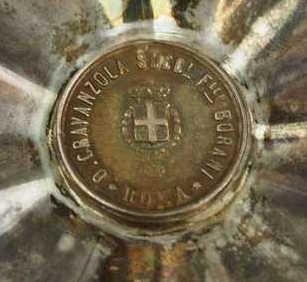
This is the reverse of full-sized Italian Order of St. Mauritius and St. Lazarus, Knight's Class from an April 2019 auction on the Very Important Lot website (https://veryimportantlot.com/en/lot/view/italy-knight-of-the-order-of-st-mauritius-and-st-174877). It reads: "D. CRAVANZOLA SUCC. F...[Frat?] BORANI *ROMA*". This is the only example of a hallmark showing the name of the Fratelli Borani linked with the name Cravanzola, that I have come across so far in my investigations. The coat of arms is the same as seen on (later?) hallmarks of "Gardino succ. Cravanzola" (see below), but there are few details visible in the wreath to determine whether the knots are present in this version or not.
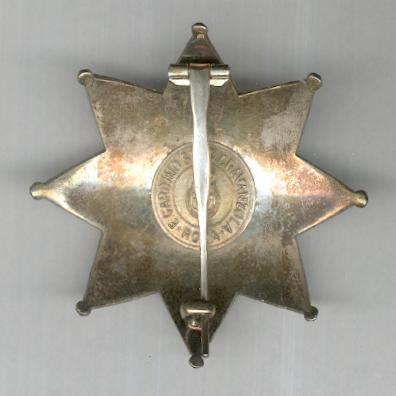
Reverse of a full-sized Italian Order of the Crown breast star showing the placement and approximate size of the manufacturer's hallmark. While much of the hallmark is obscured by the Tunic pin, the legend "E. GARDINO SUCC. CRAVANZOLA *ROMA*" can be read. This example is very similar to several shown below (see the 5th, 8th, and 9th photos below). Like most of the hallmarks for this medallist, they are attached cartouches not stamped hallmarks. The breast star in this cased set with the neck badge measures 74.88 mm in diameter. From a past auction archived on the Medal-Medaille website: (http://www.medal-medaille.com/sold/product_info.php?products_id=8448).

Inside of the case lid for this same example of the Italian Order of the Crown from the Medal-Medaille website showing the name of "E. Gardino succ. D. Cravanzola, Gioielliere, Roma"
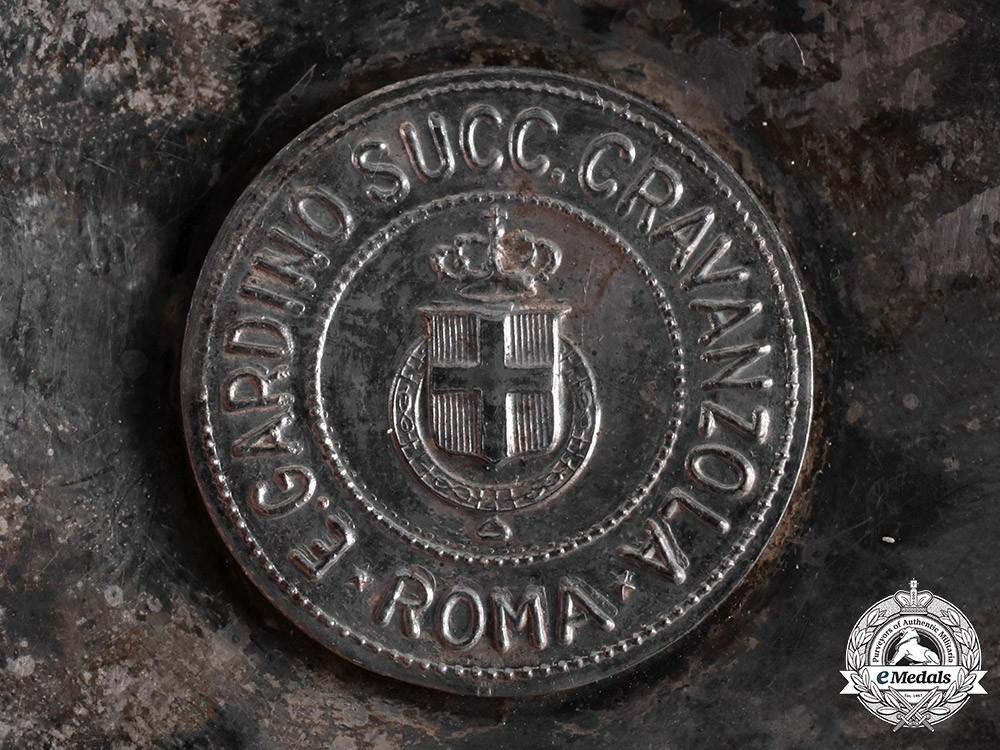
The "E. GARDINO SUCC. CRAVANZOLA *ROMA* " manufacturer's hallmark cartouche on the reverse of full-sized breast star of the Italian Order of the Crown showing good detail of this cartouche. The knotted cords making up part of the interior design of the band around the central shield can be clearly seen in this photo, which is the symbol shown in the first photo of the Latvian miniature of the Order of Three Stars. This breast star measures 77.21 mm high X 77.76 mm wide. The auction description suggest this example may date to c.1930. From a current eMedals auction (https://www.emedals.com/italy-kingdom-an-order-of-the-crown-in-gold-commander-by-cravanzola-c-1930).
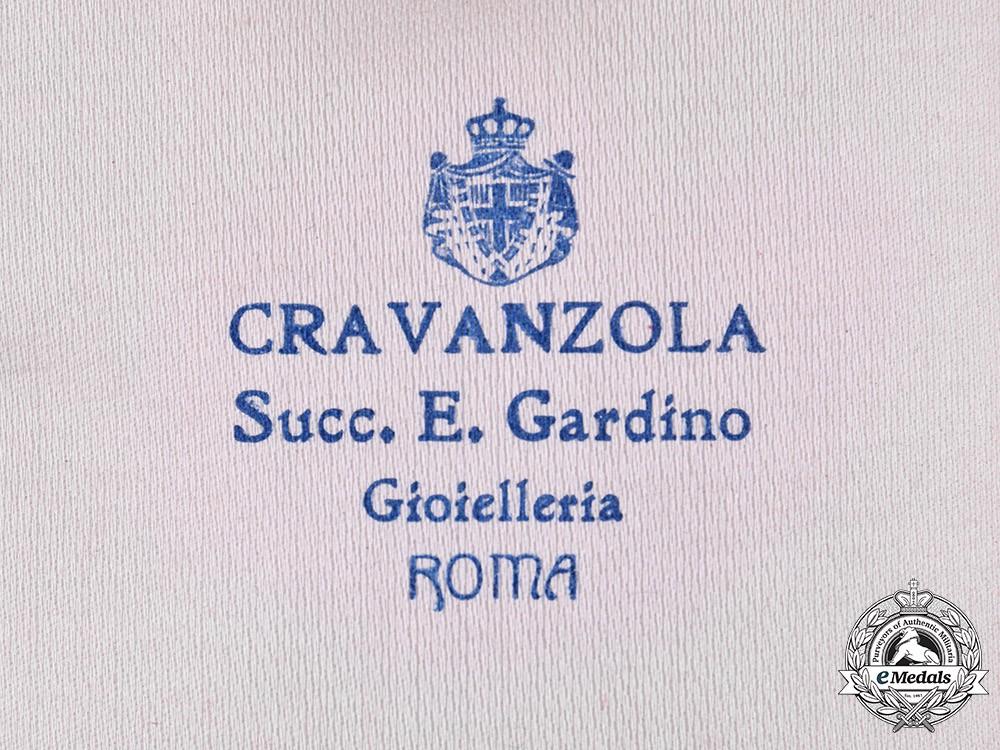
The Gardino/Cravanzola name on the inside of the upper lid of the case of this same eMedals example of the Italian Order of the Crown with the spelling "Gioiellieria", in contrast with "Gioiellerie" on the Medal-Medaille example above.

Another version of the Cravanzola succ. Gardino name on the inside of the upper lid of a case of a Grand Officer Class of the Italian Order of Merit of the Republic of Italy. I cannot tell if the spelling is "Gioiellerie" or "Gioiellaria" on this image. From a June 2019 auction of Bene Merenti Auktionen, archived on the Very Important Lot website (https://veryimportantlot.com/en/lot/view/italy-order-of-merit-of-the-republic-of-italy-gr-174887).
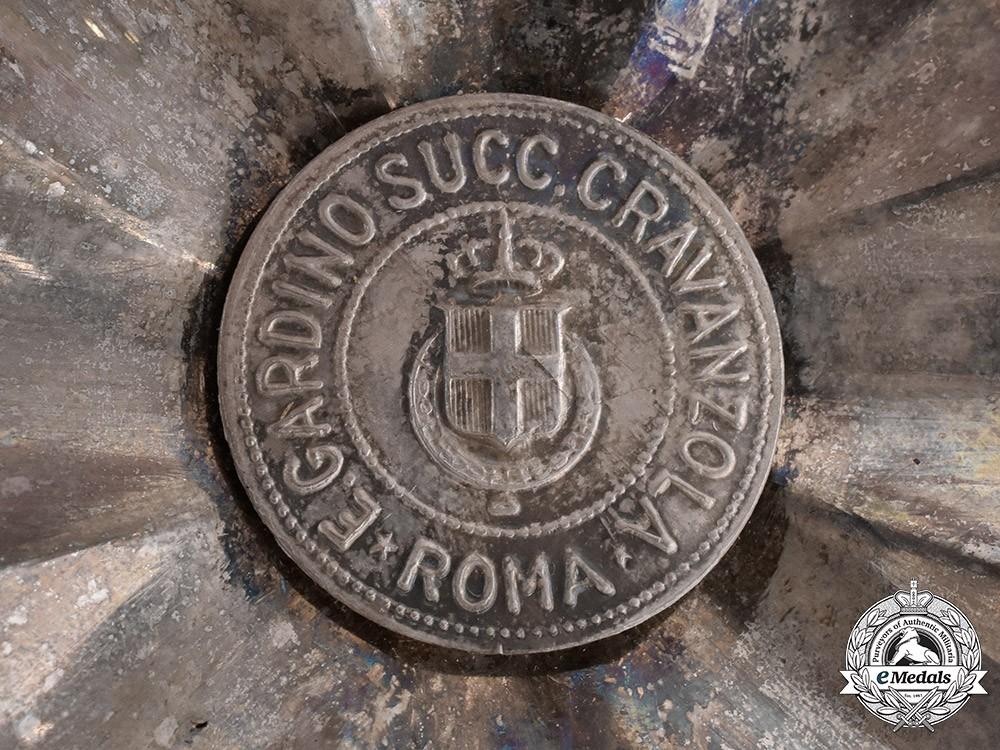
The above image shows the reverse of a full-sized Vatican Order of Our Lady of Bethlehem showing a similar manufacturer’s hallmark to those above for "E. GARDINO SUCC. CRAVANZOLA *ROMA* ". The wreath in this example are more worn, and the knots are not as visible as in other hallmarks. This medal is 86.27 mm high X 87.24 mm wide. This example (Item: EG2665) comes from a past eMedals aucition and is described as dating to c.1930 and made by Gardino and Cravanzola (From: https://www.emedals.com/vatican-an-order-of-our-lady-of-bethlehem-grand-officer-s-star-by-gardino-and-cravanzola-c-1930)

Good image of the E. GARDINO SUCC. CRAVANZOLA *ROMA*" hallmark cartouche on the reverse of a full-sized sash badge of an Albanian Order of Scanderbeg, identified in the eMedals description as a Grand Cross sash badge and sash (no breast star is associated with this example). The knots in the wreath around the central shield are quite visible in this image. The badge measures 75 mm X 53 mm. The manufacturer is identified as "RAVIOLO & GARDINO ROMA". From a current eMedals auction, Item:EU11564 (https://www.emedals.com/an-albanian-order-of-scanderbeg-grand-cross-badge-by-raviolo-gardino-roma).
.jpg.d9e79a7d38865e5450b19f3618d561e4.jpg)
An alternative form of the "E. GARDINO SUCC. DITTA CRAVANZOLA ROMA" hallmark on a full-sized neck badge of an Albanian Order of Scanderbeg. This example is identified as a Knight Grand Cross Class of this award (the neck badge suggests it is the Grand Officer or Commander Class of this award). No dimensions are provided for this badge. From a past auction curated on the Kubel 1943 website (https://www.kubel1943.it/eng/dettaglio.php?id=3729)

Another example of a slightly different lunate form of the "E. GARDINO SUCC. DITTA CRAVANZOLA ROMA" hallmark on the reverse of the breast star of a full-sized Italian Highest Order of All Saints Annunciation, chain and breast star. This breast star measures 83 mm in diameter. From an April 2019 auction of Bene Merenti Auktionen, archived on the Very Important Lot website (https://veryimportantlot.com/en/lot/view/italy-the-highest-order-of-all-saints-annunciatio-174869).
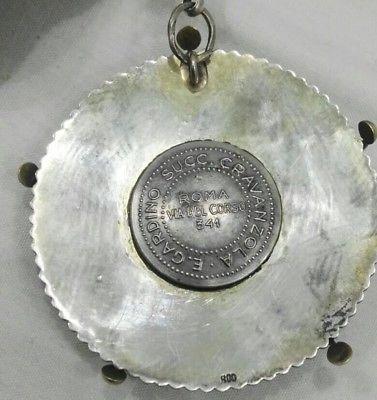
A different form of the "E. GARDINO SUCC. CRAVANZOLA" hallmark that also includes an address "ROMA VIA DEL CORSO 341" in the center of the attached manufacturer's cartouche instead of the coat of arms. This example is on the reverse of a Libyan Order of the House of Representatives medal, and is identified in the auction description as a Grand Cross sash badge, possibly dating to 1951. This piece is 61 mm in diameter. From a past auction on The Orient Treasures website (https://www.theorienttreasures.com/shop-now/orders-medals-decorations/kingdom-of-libya-order-of-house-of-representatives-grand-cross-sash-king-idriss).
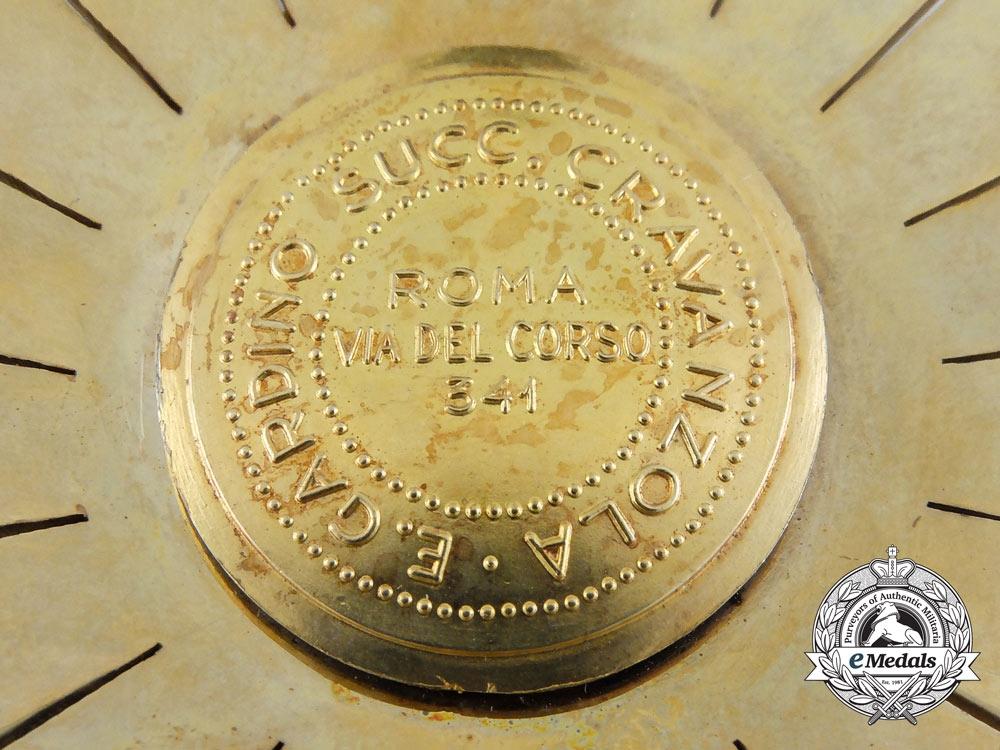 The same form of hallmark as above, but executed in gold, lacking the shield and wreath with knots and having the address of the medallist in Rome. This is on the reverse of a Peruvian Order of the Sun, identified in the description as the breast star of a Grand Cross Class of this award, possibly dating to 1930. This piece measures 78.8 mm in diameter. (From: https://www.emedals.com/a-1930-peruvian-order-of-the-sun-grand-cross-star-by-e-gardino-roman).
The same form of hallmark as above, but executed in gold, lacking the shield and wreath with knots and having the address of the medallist in Rome. This is on the reverse of a Peruvian Order of the Sun, identified in the description as the breast star of a Grand Cross Class of this award, possibly dating to 1930. This piece measures 78.8 mm in diameter. (From: https://www.emedals.com/a-1930-peruvian-order-of-the-sun-grand-cross-star-by-e-gardino-roman).
detail.jpg.78876450653d8f93d42661bb74e444d9.jpg)
detail.jpg.eb17c374c26fbd7eef5d7df94b85d350.jpg)
An additional variant of a E. Gardin hallmark is the square attached plate shown above with just the words "E. GARDINO ROMA", with a scrolling decor but lacking the knot design from the wreath around the shield. These are 2 examples of this attached cartouche on the full-sized Albanian Order of Fidelity (Urdhëri Besa). I have only seen this form of the Gardino cartouche on the Order of Fidelity. The example on the L is from a neck badge of a 3rd Class award of this Order (also in the double eagle shape), and this badge is identified as measuring 87 mm X 52 mm. From an August 2016 auction by La Galerie Numismatique archived on the Sixbid.com website (https://www.sixbid.com/en/la-galerie-numismatique/2873/albania/2399793/b-order-of-fidelity-urdheri-besa-b-br?term&orderCol=lot_number&orderDirection=asc&priceFrom&displayMode=large&auctionSessions=). The example on the R is a 5th Class breast badge of the Albanian Order of Fidelity and shows the placement and size of the hallmarked plate on the reverse of this badge. The badge is identified as measuring 45 mm X 36 mm. From the same August 2016 auction by La Galerie Numismatique archived on the Sixbid.com website as the image on the right: (https://www.sixbid.com/en/la-galerie-numismatique/2873/albania/2399794/b-order-of-fidelity-urdheri-besa-b-br?term&orderCol=lot_number&orderDirection=asc&priceFrom&displayMode=large&auctionSessions=).

Reverse of full-sized Albanian Order of Fidelity sash badge for the Grand Cordon Class with the square "E. GARDINO ROMA" cartouche. This sash badge measures 88 mm high x 51 mm wide. The hallmark on the breast star of this set is the round version (like the 3rd, 5th, 8th, & 9th photos in this this post) with the inscription "E. GARDINO SUCC. CRAVANZOLA *ROMA*", with a central shield & wreath (see below). From an April 2019 auction of a set of sash badge, breast star, and sash by Bene Merenti Auktionen, archived on the on the Very Important Lot website (https://veryimportantlot.com/en/lot/view/albania-order-of-the-loyal-besa-order-2-model-174759)
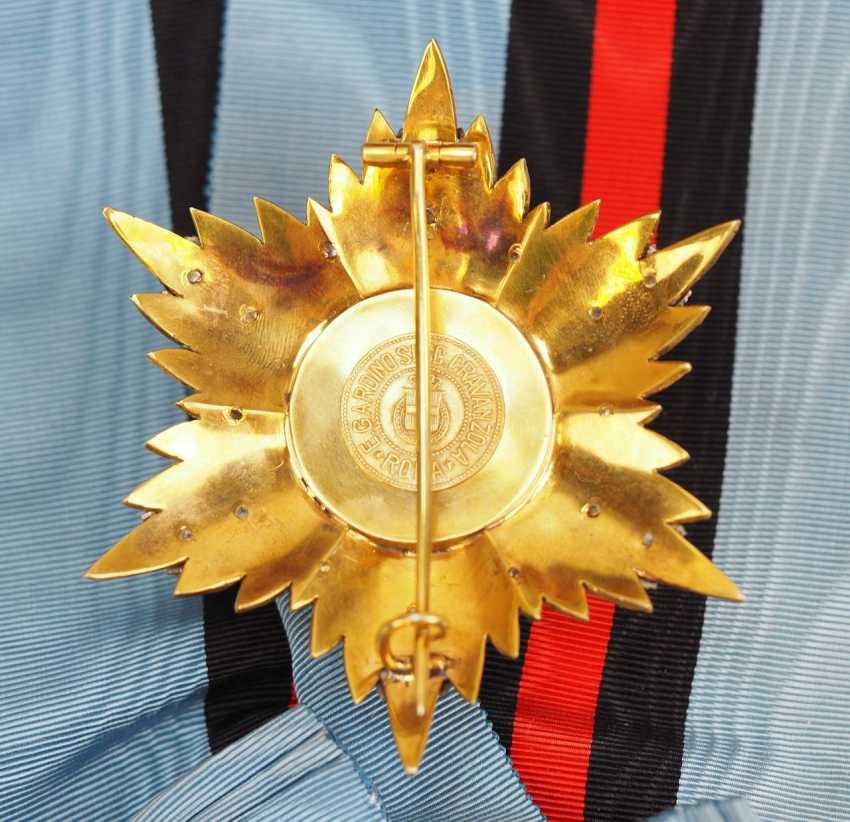
Reverse of the full-sized breast badge of the same Grand Cordon Class set of the Albanian Order of Fidelity. This shows the contrasting hallmark compared with the more abbreviated square cartouche on the double eagle-forms of the sash badge, neck badge, or chest medals for this Order. It is unclear from this photo whether it shows lower detail of the knots within the wreath than other examples shown in this post. From the April 2019 auction of a set of sash badge, breast star, and sash by Bene Merenti Auktionen, archived on the on the Very Important Lot website. The breast star measures 87 mm high X 76 mm wide.
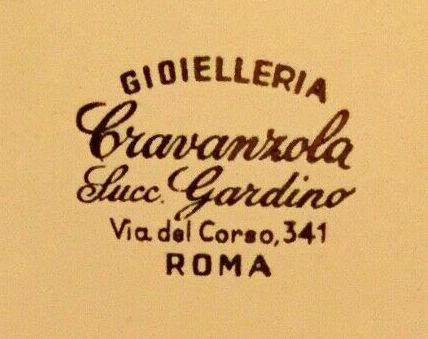
Inside of the upper lid of a case holding 5 miniatures from a current eBay auction (https://www.ebay.com/itm/183840989020), using the word "Gioielleria". The description of the miniatures suggests they all were made by Gardino/Cravanzola, however none are Middle Eastern miniatures and no images are provided of the reverse of any of the five miniatures to show the form of any potential hallmarks. They include: "The Orders listed include the Sovereign Military Hospitaller Order of St. John of Jerusalem, of Rhodes and of Malta (Order of Malta), the Equestrian Order of the Holy Sepulchre of Jerusalem (Holy See), the Sacred Military Constantinian Order of St. George of the Royal House of Bourbon of the Two Sicilies, the Order of Merit of the Royal House of Savoy of Italy and the Patriarchal Order of the Holy Cross (a decoration of the Melkite Patriarchate), listed in precedence."
0 -
Owain, that is a very interesting variant of a miniature of the Order of the Nile! The single piece construction is uncommon. The only example I illustrated with facets only on the central rays of the embellishment (the 4th post of 2 April, 2018 on this thread) has many others design differences from this unique example. Sorry for my long silence, I was working in Mexico in a remote Maya community with no internet or phone connections for a couple months. I have a couple bits of research to update over the next couple weeks. I'll start with the usual examples of some additional miniatures of the Order of the Nile awards, none as interesting as yours from 5 March.
Two obverse views of this miniature of the Egyptian Order of the Nile, 4th Class (rosette with no galon), from a March 2019 eBay auction (https://www.ebay.co.uk/itm/OBE-BRITISH-WAR-MEDAL-EGYPT-ORDER-OF-THE-NILE-MINIATURE-MEDAL-GROUP-OF-3-/143152249054?nma=true&si=cPHwS%252FtTJRlY2xkoq1HOZakCN%252Bw%253D&orig_cvip=true&nordt=true&rt=nc&_trksid=p2047675.l257
Reverse the same miniature of the Order of the Nile from an eBay March 2019 auction. No hallmarks are visible on the reverse.
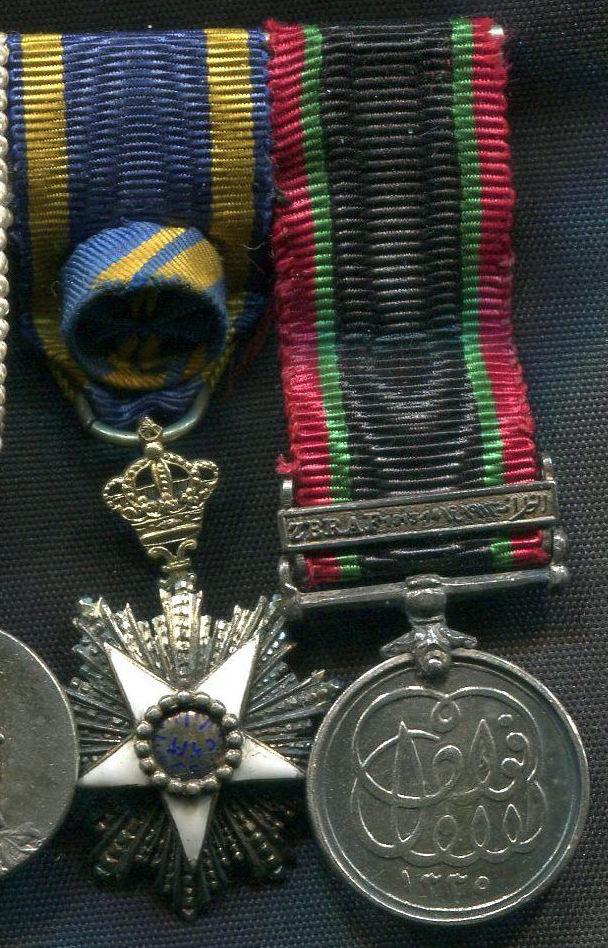
Obverse of 2 Egyptian miniatures in a grouping of 5 medals (that also includes: a British War Medal 1914-1918 [silver]; a King George V Jubilee Medal 1935 [silver]; and a Queen Elizabeth II Coronation Medal 1953 [silver]). On the L is a miniature of the Order of the Nile, 4th Class (rosette with no galon), and on the R=a Khedive's Sudan Medal, 1910, in silver with a clasp inscription for "Zeraf 1913-14". From a December 2018 eBay auction (https://www.ebay.co.uk/itm/Miniature-Medal-Group-Egypt-Order-Nile-Khedives-Sudan-Medal-1910-Zeraf-1913-14-/372518376249?nma=true&si=cPHwS%252FtTJRlY2xkoq1HOZakCN%252Bw%253D&orig_cvip=true&nordt=true&rt=nc&_trksid=p2047675.l2557).

Reverse of the same two Egyptian miniature medals, L=the Khedive's Sudan Medal (silver) and R= the Order of the Nile on a Spink & Sons bar.
0 -
I recently came across some interesting recycled use of design elements of the Order of Ismail in the Order of Saba'a (Nishan Wissam) of Yemen. I am not very familiar with this Order, so any comments by other learned members of GMIC would be greatly appreciated. The award appears to be part of a couple that were "sponsored" by Egypt during the first period of the Yemen Arab Republic (YAR) from ~1962-1967. Owain notes in a post of March 26, 2011 in "ARAB MEDALS-Yemen" (started February 7, 2007 by Antonio Preto in this section of Middle East & Arab States) that: "I would surmise that following the overthrow of Sallal in 1967 [Abdullah al-Sallal, the first president of the YAR from September 1962-November 1967] the Egyptian sponsored awards of Saba, Marib and medals of Bravery and Liberation became obsolete and the ruling Republican Council instituted a new award of Marib to replace the previous series and thereby make a break with the Sallall (Nasser supported) regime." As can be seen in the illustrations below, this award combines a couple elements form past royal Egyptian Orders. The rayed backing embellishment appears to be from the Egyptian Order of the Nile. Hallmarks illustrated on these clearly indicate Egyptian manufacture, and the couple of examples I have seen with readable date hallmarks were manufactured within the first few years of the founding of the YAR. The central arms of the blue & gold star are those of the Order of Ismail design, lacking gold & enameled finals at the distal end of each arm of the star. The photographs show clearly that the gold floral designs within the arms are not in relief, something that is seen only on examples of the Order of Ismail made by Fahmy Tewfik Bichay, and possibly on some examples by his father Tewfik Bichay.
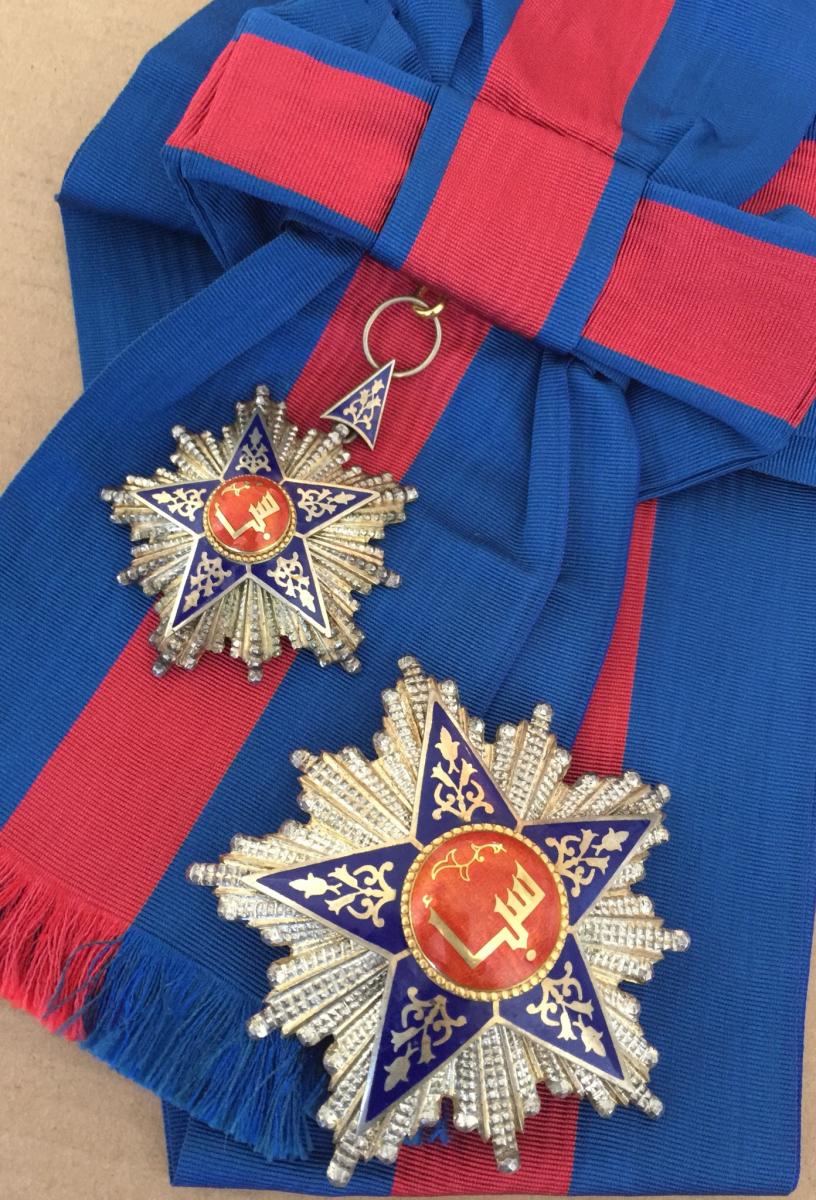
Obverse of the YAR period Order of Saba'a, Grand Cordon sash badge, sash (replacement sash, the Order Saba'a uses the same colors as the Order of Ismail sash or ribbon, but there is a single central red strip on the Order of Saba'a in contrast with the edge stripes on each margin for the Egyptian award), and breast star, from a current auction on The Treasures of the Orient website (https://www.theorienttreasures.com/shop-now/orders-medals-decorations/yemen-order-of-saba-a-grand-cross-set-sash-breast-star-badge-medal-nichan-wissam). Note the lack of any engraving on the gold floral designs on each of the arms of the central star. The suspension device on the sash badge is made from another piece of the same design as each of the arms of the blue & gold star. The rayed embellishment is identical to many seen on the royal award version of the Order of the Nile. The gold margin of the central boss is quite similar to the form of this feature on the Order of the Nile, lacking an inner band seen on both the sash badges (& the 2nd & 3rd Class neck badges) and breast stars of the Order of Ismail. The gold line where the crotch of each blue & gold arm of the star meet also is not an aspect of the design seen in the Order of Ismail. The sash badge of this example is identified as being 70 mm in diameter and the breast star is 90 mm in diameter. This set is identified as allegedly coming from the 1950s, however, it appears most likely that this award was only created after 1962 when the Egyptian-backed revolutionary YAR troops took over North Yemen and deposed Crown Prince Muhammad al-Badr (and consistent with the date hallmark, see the discussion of the photo of the reverse of this set below).
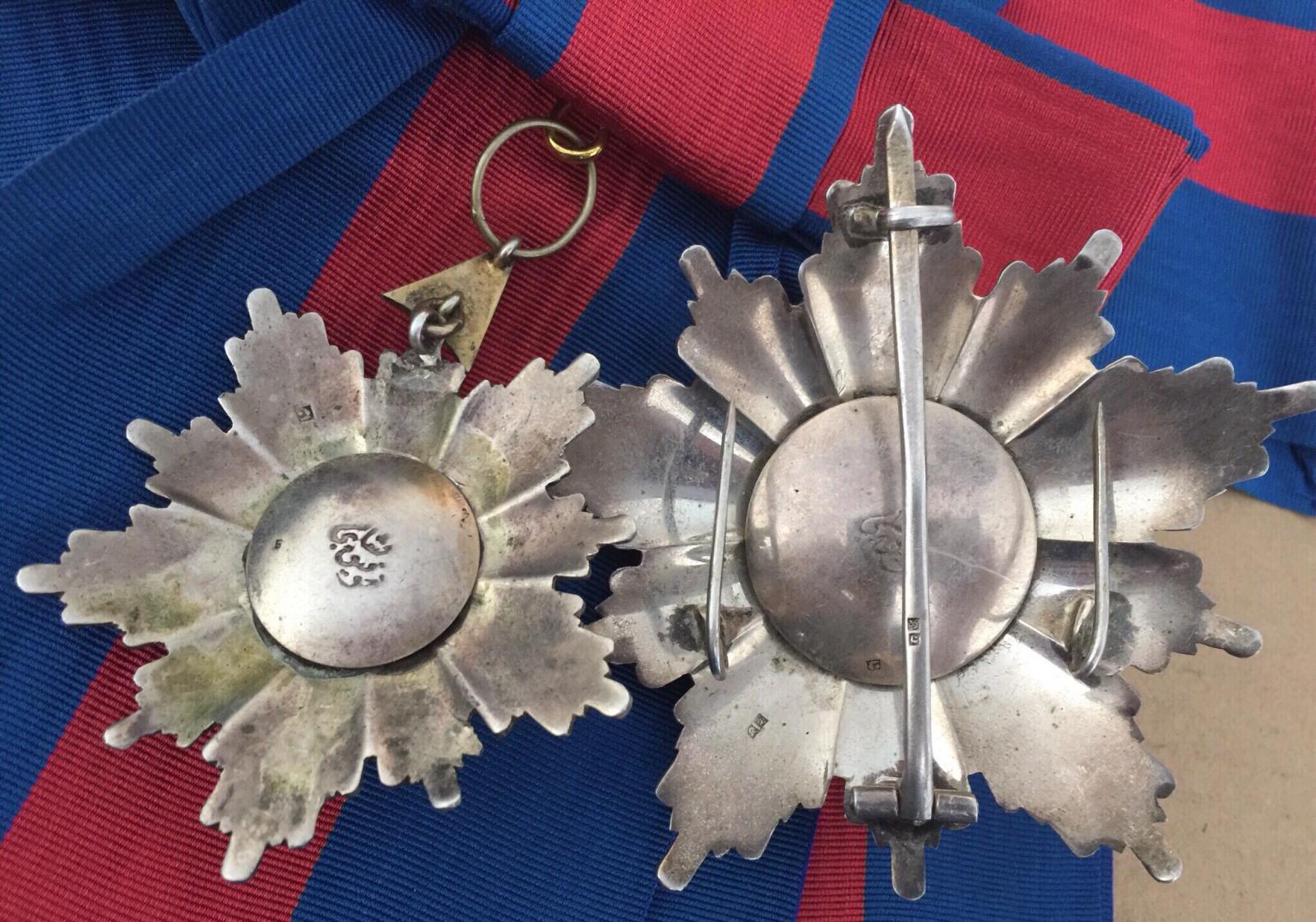
Reverse view of the same Grand Cordon set of the Order of Saba'a from the current The Treasures of the Orient auction showing the Egyptian hallmarks. The sash badge on the L exhibits Tewfik Bichay's hallmark, in addition to a silver hallmark at the far right on the central silver boss on the reverse (a purity hallmark, but I cannot read it), and a mark on the 10th ray (counterclockwise from the 12:00 position where the suspension device is attached) that is a purity hallmark identifying the Cairo assay office determination of 900 silver (90% pure). On the R, the breast star has 2 hallmarks on the tunic pin, that are a Cairo office assay mark of 900 silver and an Arabic letter date of 1962-1965. Just below and to the left of those hallmarks on the tunic pin, a hallmark on the central boss is a Cairo assay office mark for 900 silver. The 2 hallmarks on the 6th ray from the 12:00 position( again following counterclockwise) include the Cairo assay office identification of 900 silver and the Arabic date letter for1962-1965. Note the the suspension device (an arm element of the 5-pointed star) of the sash badge is gold, as in the construction the blue & gold star of the Order of Ismail. The reverse morphology of the silver embellishment looks identical to those seen on pre-egyptian Revolution versions of the Order of the Nile.
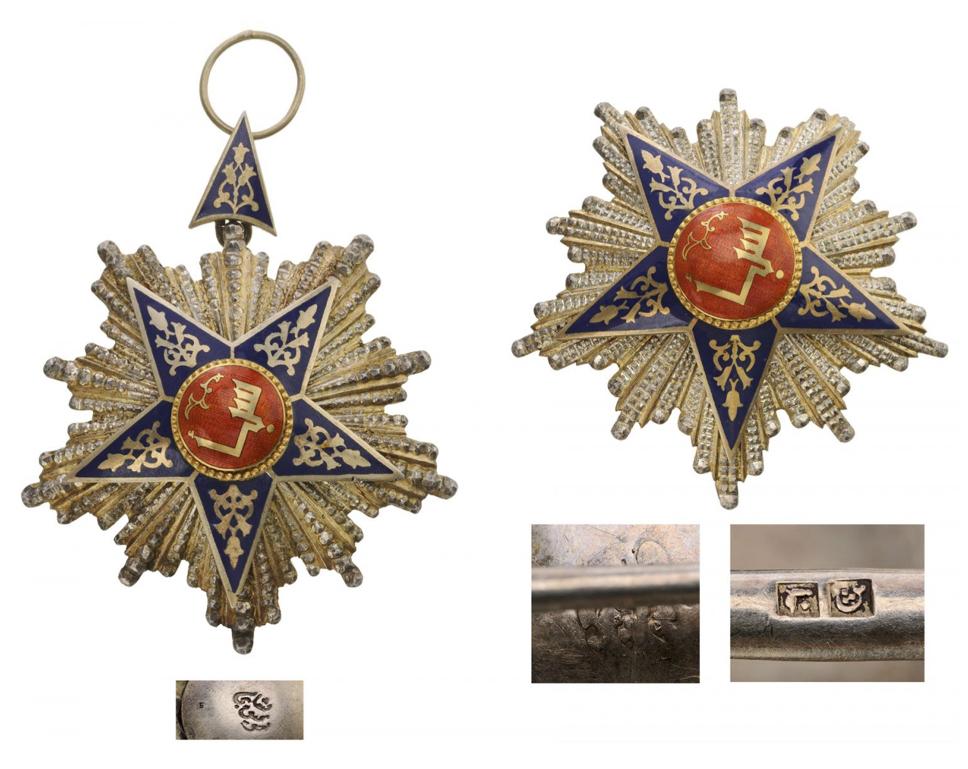 Obverse of a set of the sash badge and breast star of the Grand Cordon Class of the Order of Saba'a, showing the same design similarities to pre-revolutionary Egyptian awards in the arms of the blue & gold star (to the Order of Ismail) and the rayed backing embellishment (to the Order of the Nile). This example comes from a March 2019 auction (Auction XLIV, Lot 3461) by La Galerie Numismatic, archived onto Sixbid.com website (https://www.sixbid.com/en/la-galerie-numismatique/5835/yemen/4879721/order-of-saba-a?term&orderCol=lot_number&orderDirection=asc&priceFrom&displayMode=large&auctionSessions=). The sash badge is identified as 79 mm X 62 mm, and the breast star is 91 mm in diameter. The maker's hallmark shown in the lower left of the photo montage is that of Tewfik Bichay, oriented incorrectly, ~90 deg counterclockwise from the correct position. The illustration above of The Treasures of the Orient example also shows this same orientation of the maker's hallmark in relation to the orientation of the suspension device. All of the examples of the Order of Ismail with the Tewfik Bichay hallmark show a correct orientation, but I am unsure if this is generally true of the Order of the Nile awards. The 2 hallmarks shown on the far R in the lower right of the photo montage include (L-R): the Cairo assay office mark for 900 silver, and the Arabic date letter for 1962-1965.
0
Obverse of a set of the sash badge and breast star of the Grand Cordon Class of the Order of Saba'a, showing the same design similarities to pre-revolutionary Egyptian awards in the arms of the blue & gold star (to the Order of Ismail) and the rayed backing embellishment (to the Order of the Nile). This example comes from a March 2019 auction (Auction XLIV, Lot 3461) by La Galerie Numismatic, archived onto Sixbid.com website (https://www.sixbid.com/en/la-galerie-numismatique/5835/yemen/4879721/order-of-saba-a?term&orderCol=lot_number&orderDirection=asc&priceFrom&displayMode=large&auctionSessions=). The sash badge is identified as 79 mm X 62 mm, and the breast star is 91 mm in diameter. The maker's hallmark shown in the lower left of the photo montage is that of Tewfik Bichay, oriented incorrectly, ~90 deg counterclockwise from the correct position. The illustration above of The Treasures of the Orient example also shows this same orientation of the maker's hallmark in relation to the orientation of the suspension device. All of the examples of the Order of Ismail with the Tewfik Bichay hallmark show a correct orientation, but I am unsure if this is generally true of the Order of the Nile awards. The 2 hallmarks shown on the far R in the lower right of the photo montage include (L-R): the Cairo assay office mark for 900 silver, and the Arabic date letter for 1962-1965.
0 -
Here is a nice image of the 2nd Class, Grand Officer breast star of the Order of Ismail from Egypt's Royal Jewelry Museum in Alexandria (From: https://www.flickr.com/photos/96884693@N00/37385197782/in/photostream/). I have been meaning to add this photo, but lost it in my computer files for quite a while and just stumbled across it again. So many of the images I can find are from auction sites that I like to show a few museum examples that are available for anyone to visit, see, & enjoy.
0 -
I have identified the individual wearing the 4th Class, Knight, Order of Ismail shown in the portrait of the 1st photo in my post of 23 March, 2019 on this thread. I am duplicating that image as this version is just very slightly higher resolution than the March image I posted and also includes the name of the studio.
This portrait is of Rear Admiral (Amir el Bahr) Galal Eddin Allouba Bey, commander of the H.M.S. Mahroussa, the ship that took King Farouk I into exile in Italy. The studio name is Ahkar, but I do not know which city that studio was located in at the time of this photo. His uniform is the Egyptian Navy gala frockcoat, adopted in 1905 and apparently based upon the Ottoman Navy frockcoat. From: http://www.photorientalist.org/easymedia/exiled-king-farouk-and-narriman/narriman-farouk/
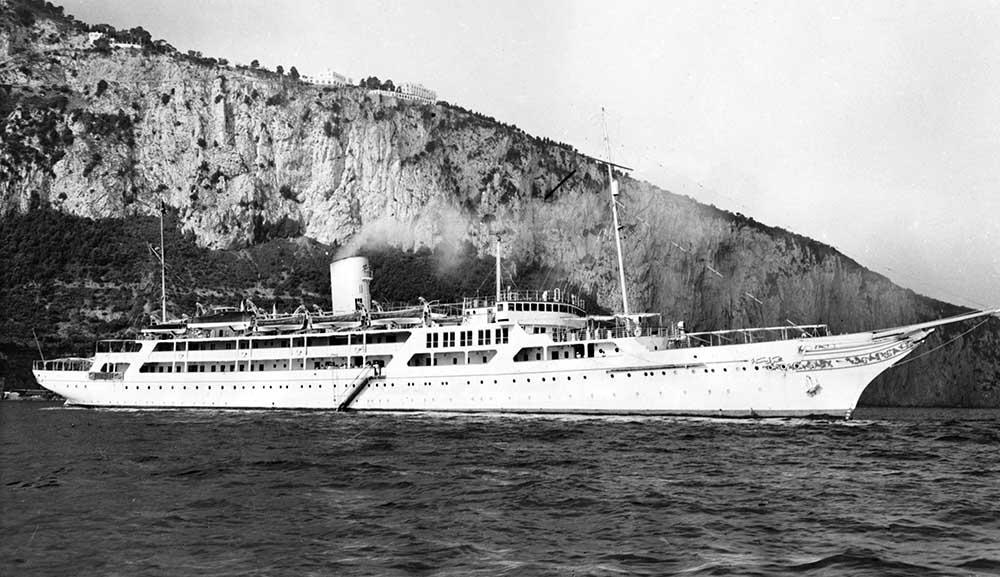
An image of the Egyptian Royal Yacht H.M.S. Mahroussa from a press photo dated 2 August, 1952 with the caption: "Brings Exiled King to Capri. Off the Isle of Capri: The Egyptian royal yacht Marroussa rides at anchor off Capri, July 29, after bringing King Farouk of Egypt and his party to their Italian haven. In the background, on Mt. Tiberio is the Hotel Augusto Cesare, where the exiled ruler spent his honeymoon with Queen Narriman. Farouk was forced to abdicate by a surprise military coup. He abdicated in favor of his infant son, King Ahmed Fuad II, who was brought by Farouk and the queen to Capri." H.M.S. Mahroussa ("Guarded by God's Blessing") was commissioned by Khedive Ismail, and was completed in 1865. It lead the inauguration ceremony opening the Suez Canal in 1869, was the ship Khedive Ismail took into exile in 1879, it also brought Khedive Abbas Hilmi II into exile in 1914, President Muhamad Anwar el-Sadat made extensive use of the yacht, visiting the US for the country's Bicentennial celebration, and taking it to the peace negotiations with Israel in 1979. The 6th photo of my post of 24 March, 2019 on this thread showing King Farouk I (wearing a similar admiral's uniform to that above of Rear Admiral Galal Allouba) and Ahmed Hassanein Pasha both wearing the Grand Cordon Class Order of Ismail decorations marks the reception greeting King Abdul Aziz Al-Saud who came to Egypt in January 1946 aboard the Mahroussa. Recently, it was the first ship through a new extension of the Suez Canal in 2015. H.M.S. Mahroussa is the oldest operating motor yacht in the world and among the 10 largest (411 ft when built and extended to 451 ft in 1970). From: http://www.photorientalist.org/exhibitions/farouk-and-narriman-egypts-last-royal-romance/photographs/
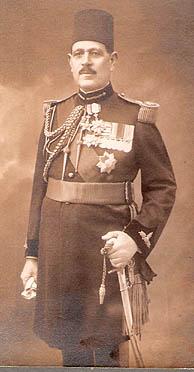
A low-resolution image of a military Pasha in full regalia, identified as Hassan Raafat Pasha in the jpg's title, wearing what appears to be an Order of Ismail (From: http://www.egy.com/historica/06-03-01.php). If this is an Order of Ismail, it is a configuration of wearing the 3rd Class Commander's neck badge similar to that shown in the 2nd photo of my 23 March, 2019 post, worn with what appears to be a shortened ribbon like a chest badge, but in the position that a neck badge would be worn. To the viewer's right is an Order of the Nile that also appears in the position of a neck badge (3rd Class, Commander's badge), but also worn on a short ribbon. As the resolution of this image is not good, I cannot be certain whether this is an Order of Ismail, but its' precedence over the Order of the Nile also suggest it may be the Nishan al-Ismail. Hassan Raafat Pasha's position is identified on the same website as an MD of the Royal Military Household. He was invested as Pasha on 1 June, 1923 (http://www.egy.com/historica/pashalst.php).
0 -
I have several additional photos from the volume Les Juridictions Mixtes d'Égypte 1876-1926: Livre d'or Édité sous le Patronage du Conseil de l’Ordre des Avocats á l’Occasion du Cinquantenaire des Tribunaux de la Réforme, par le: Journal des Tribunaux Mixtes. Alexandrie, Egypte, Février 1926 that relate to aspects of the costumes of individuals associated with different court bodies and roles in the Egyptian Mixed Courts system. I will first post a couple portraits of individuals whose roles in the Mixed Courts are identified in 1926 and show them in their court dress. The second set of 4 images include some group portraits of judges in the District Courts of Alexandria in 1909, one of the Parquet in 1891, court functionaries associated with the District Court of Mansourah (mostly clerks and interpreters, showing clerks wearing the bicolored sash and judicial badges but not other court functionaries), and a group photo of lawyers from Port Said in their court garb along with one clerk wearing the bicolored sash and "judicial" badge. These images principally address how sash colors (that have been slightly complicated given that only some of the roles of particular judges or other functionaries are identified in other literature and may not match available photos of those individuals) and judicial badges were worn by personnel of the Mixed Courts who were not judges. These images do help resolve some of the questions I have had about variation in sash colors and whether individuals other than judges also wore the large Mixed Courts badge. This information also may help explain the greater abundance of silver badges on auction sites, that my previous research information suggested were principally associated with prosecutors of the Parquet. It is apparent from these photographs that clerks serving the Appeals Court, the District Courts, and the Parquet also wore bi-colored sashes and judicial badges (probably all silver), potentially identifying these functionaries as other sources for many auction badges that are usually attributed to judges of the Mixed Courts. All of these images can be enlarged for greater details.
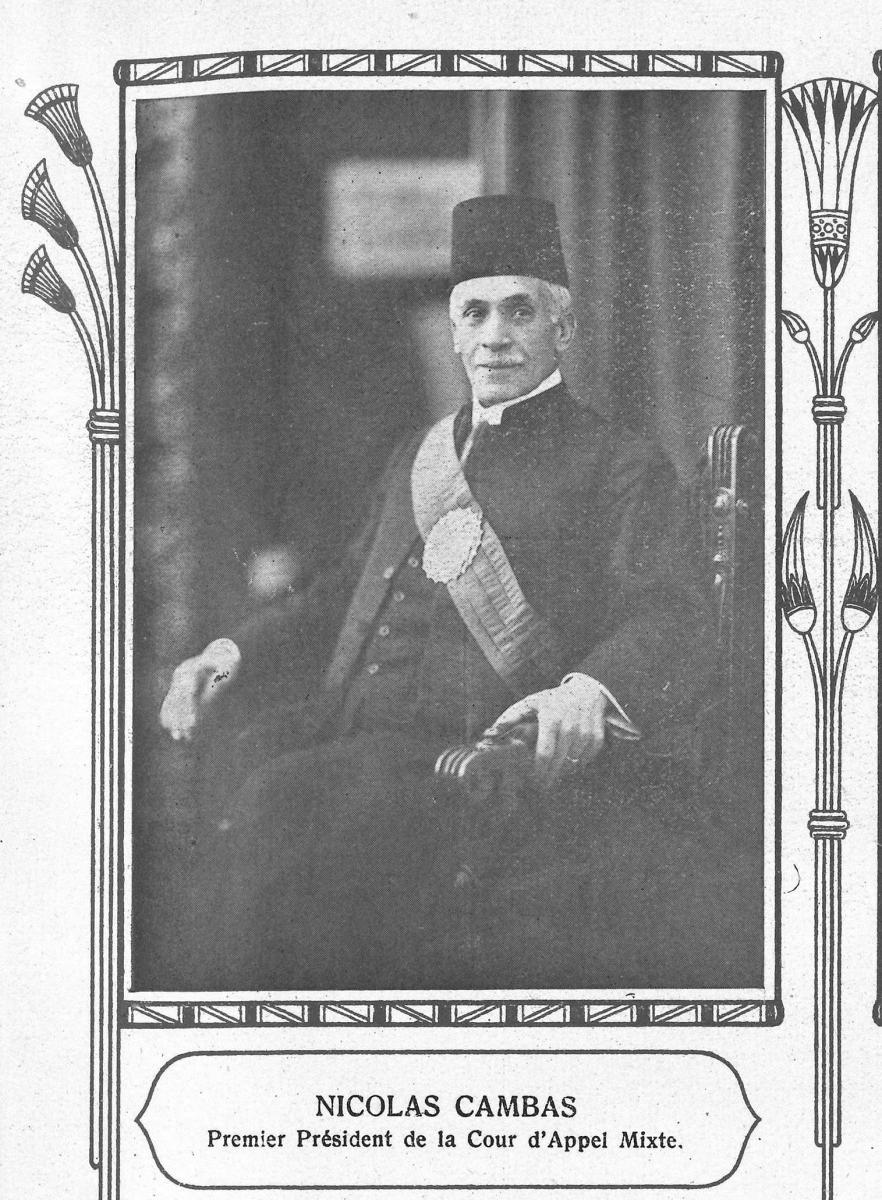
The above photo shows Judge Nicolas Cambas (Greece) in his judicial costume as president of the Mixed Court of Appeals in 1926. He wears the green sash of the Appeals Court and his judicial badge should be gold. Cambas was elected as Vice-President of the Appeals Court in January 1922, and named President of that court in October 1924. From: Les Juridictions Mixtes d'Égypte 1876-1926: Livre d'or Édité sous le Patronage du Conseil de l’Ordre des Avocats á l’Occasion du Cinquantenaire des Tribunaux de la Réforme, par le: Journal des Tribunaux Mixtes. Alexandrie, Egypte, Février 1926, pg. 11.
I have previously illustrated Judge Michael Hansson (Norway) in his judicial costume as the Vice-President of the Mixed Court of Appeals in the 9th photo of my post of 18 April, 2019 on this thread (wearing the green sash and probably a gold badge) and dressed as the President of the District Court of Mansourah in the 7th photo of that 18 April post (wearing a red sash and a what should be the gold & silver badge, although his badge is not visible in that portrait). That costume, as President of the Mansourah District Court, would be the same as the other portrait of Hansson in his red sash and what is likely a gold & silver badge in the 6th photo of the 18 April post.
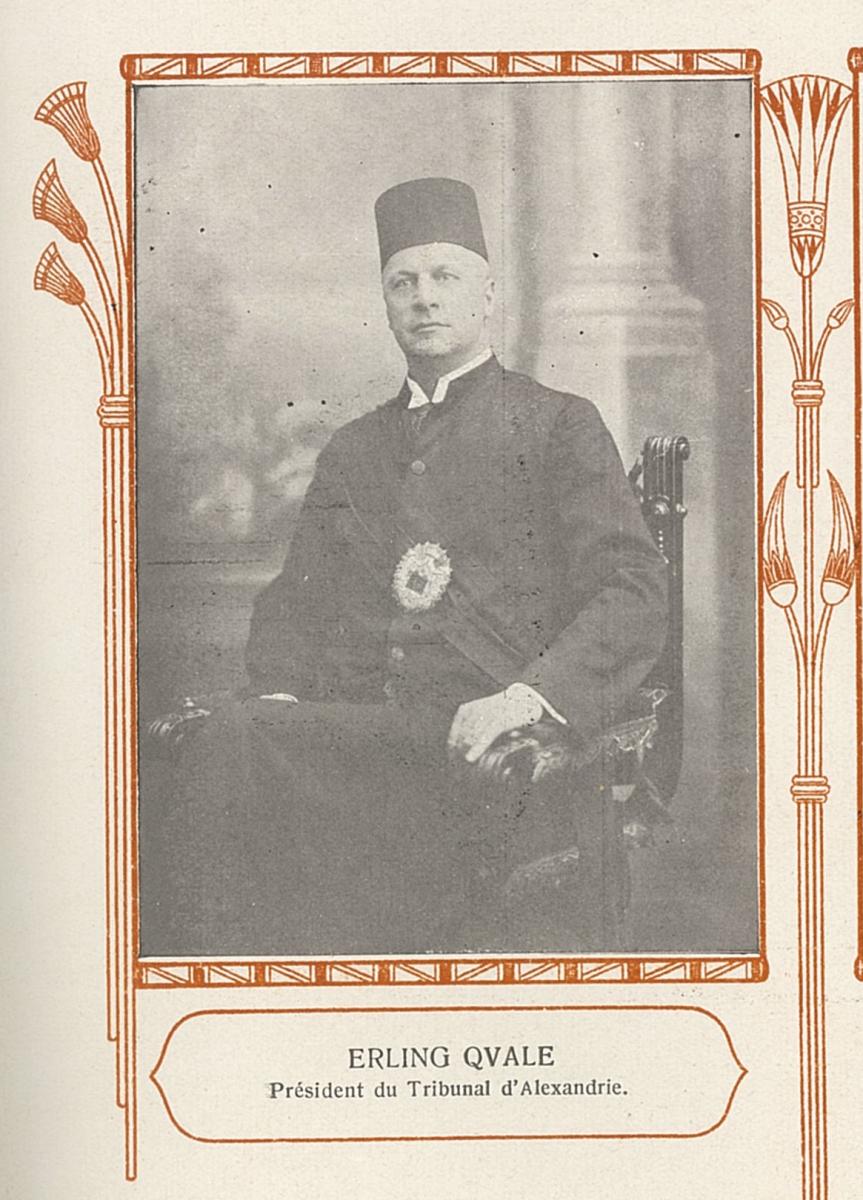
Above is a portrait of Erling Qvale (Norway) President of the District Court of Alexandria in 1926. His sash is solid red and the badge should be gold & silver (the central tablet with inscription does appear to be a darker color than some of the surrounding silver of the badge in this photo). Judge Qvale was named to the District Court of Mansourah in October of 1913, he transferred to the District Court of Alexandria in January of 1917, and was made president of the District Court of Alexandria in February of 1925. He is shown seated at the head of the table of judges, all in civilian dress, in the 5th photo of my post of 18 April, 2019 on this thread showing the personnel of the District Court of Alexandria serving in 1926. From: Les Juridictions Mixtes d'Égypte 1876-1926: Livre d'or Édité sous le Patronage du Conseil de l’Ordre des Avocats á l’Occasion du Cinquantenaire des Tribunaux de la Réforme, par le: Journal des Tribunaux Mixtes. Alexandrie, Egypte, Février 1926, pg. 35.

Above is an image of Hangs Gram Bechmann (Denmark) as President of the District Court of Mansourah in 1926. His sash is solid red and the badge (not very visible) should be gold & silver. Beckmann was named a judge on the District Court of Mansourah in October 1922, delegated to the District Court of Alexandria in October of 1922, returned to the District Court of Mansourah in November of 1922, and elected President of the District Court of Mansourah in November 1925. Judge Bechmann is shown as the President of the District Court of Mansourah (either in 1925 or 1926) with the other judges on that court in the 1st photo of my post of 5 March, 2019 on this thread. From: Les Juridictions Mixtes d'Égypte 1876-1926: Livre d'or Édité sous le Patronage du Conseil de l’Ordre des Avocats á l’Occasion du Cinquantenaire des Tribunaux de la Réforme, par le: Journal des Tribunaux Mixtes. Alexandrie, Egypte, Février 1926, pg. 36.

The above portrait is of Firmin Van Den Bosch (Belgium) in his role as the Procureur Général (the Chief Prosecutor) associated with the office of the Parquet in 1926. In this portrait, Van Den Bosch is wearing a European-style evening jacket (possibly a tailcoat?) along with white tie and a white vest, rather than the Egyptian long tunic with a high collar (the stambouline, the former costume of all employees of the Ottoman Turkish Government, the name derived from Stamboul/Stambul as in Istanbul). This image shows clearly that he is wearing bi-colored sash as a member of the Parquet (with a green stripe in the superior position and a red stripe on the inferior portion of the sash) and what should be a silver badge. This is one of the photos from this anniversary reference volume showing an individual sporting medals in association with his judicial regalia. Van Den Bosch's portrait is bit unusual as most of the photos of men wearing medals with their judicial garb date to earlier periods of the Mixed Courts' existence, not at the 1926 time of this publication. Jasper Yeates Brinton (1930, The Mixed Courts of Egypt, Yale University Press, New Haven; pg. 87, note 14) states that there was a general proviso that judges not receive any honorary or material distinctions from the Egyptian Government during their tenure on the bar. However, a formal proposal was made in 1927 to codify this practice and include other officials on the Mixed Courts, especially in relation to the awarding of the tiles of "Bey" to recognize long service. At the time of the publication of Brinton's book, this proposal by the Egyptian government had not yet been voted on by the different foreign governments with legal representatives on the Courts, and apparently was not supported by many members of the Courts. It appears that Van Den Bosch is wearing insignia of the 2nd Class Grand Officer of the Order of the Nile (neck badge and breast star) and his other neck badge appears to be the 3rd Class Commander's Cross of the Belgian Order of Leopold. His two chest medals include: a 4th Class Officer's Cross (civil division) of the Belgian Order of Leopold; and probably the 4th Class Officer's Cross of the Belgian Order of the Crown. Van Den Bosch previously served as a judge on the District Court of Mansourah from October 1910 until February 1916 when he was transferred to the District Court of Cairo. He was named to the Procureur Général role on the Parquet in April of 1920. From: Les Juridictions Mixtes d'Égypte 1876-1926: Livre d'or Édité sous le Patronage du Conseil de l’Ordre des Avocats á l’Occasion du Cinquantenaire des Tribunaux de la Réforme, par le: Journal des Tribunaux Mixtes. Alexandrie, Egypte, Février 1926, pg. 11.
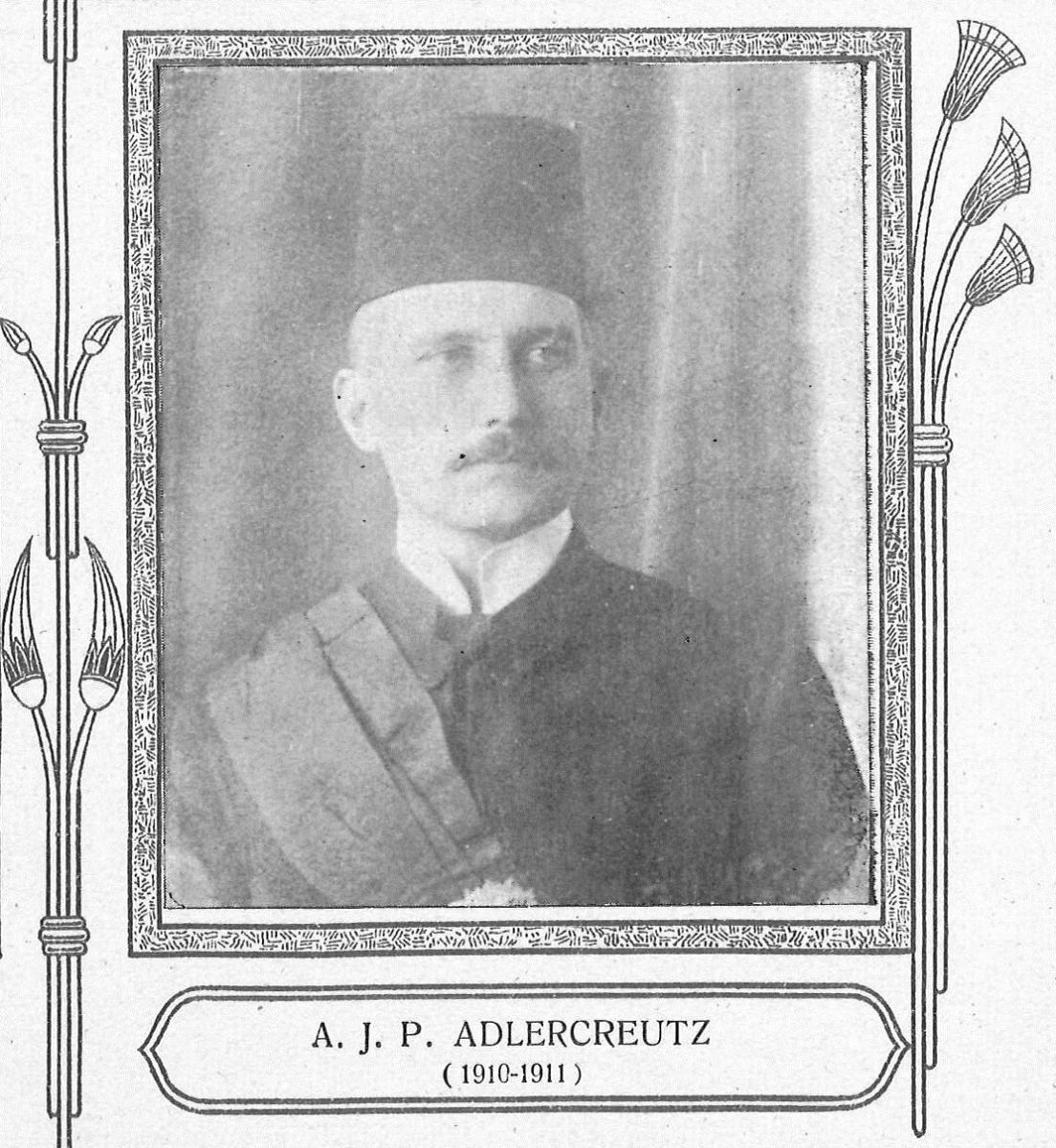
Portrait of Axel Johan Patrick Adlercreutz (Sweden) as former President of the District Court of Mansourah from 1910-1911. He is wearing a solid red sash and, although only partially visible, his badge should be gold & silver. Adlercreutz was named to the District Court of Mansourah in January 1907. After serving as President he was transferred to the District Court of Cairo in April 1912 and retired from the Courts in February of 1917. From: Les Juridictions Mixtes d'Égypte 1876-1926: Livre d'or Édité sous le Patronage du Conseil de l’Ordre des Avocats á l’Occasion du Cinquantenaire des Tribunaux de la Réforme, par le: Journal des Tribunaux Mixtes. Alexandrie, Egypte, Février 1926, pg. 49.
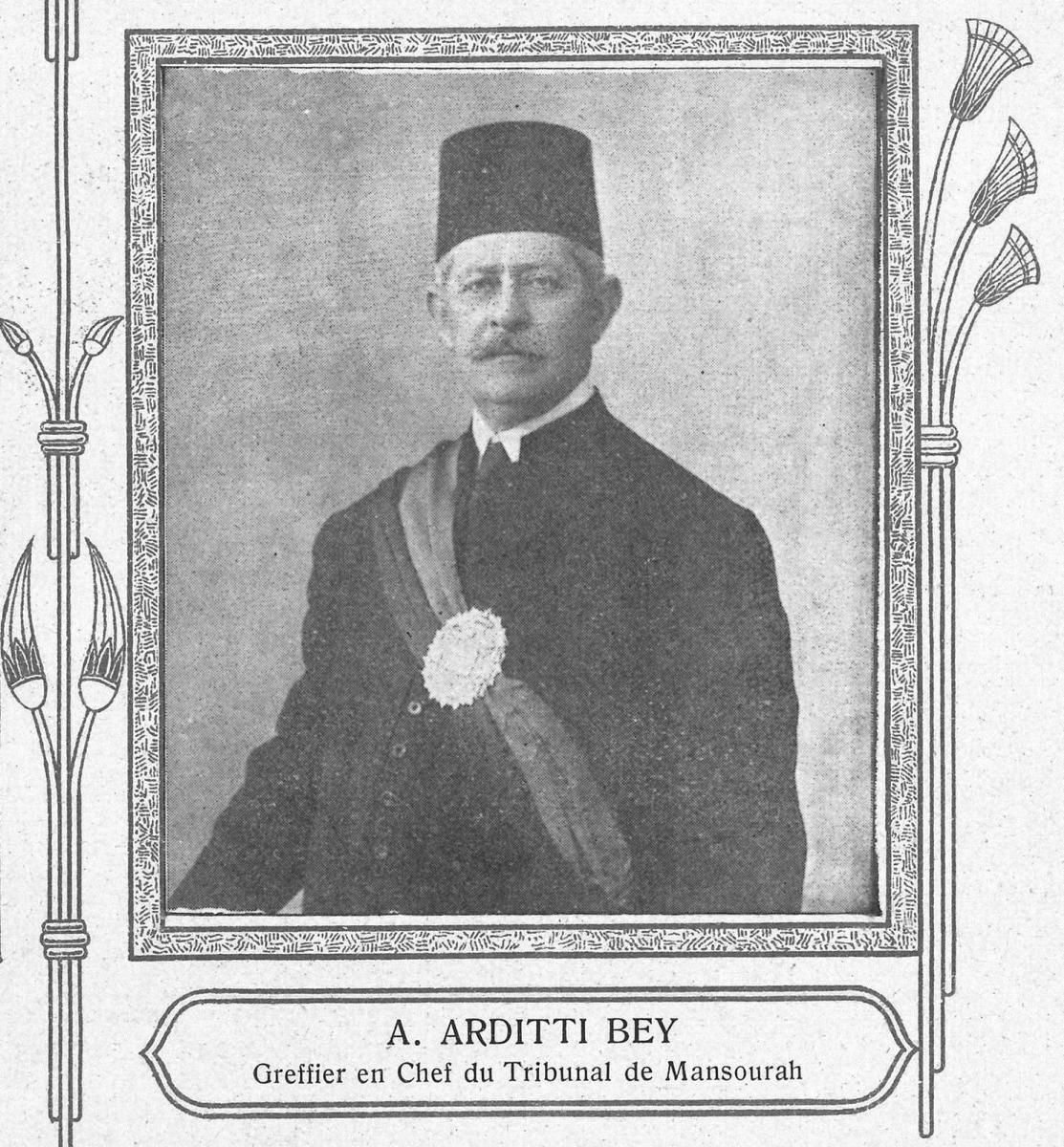
A. Arditti Bey (Egypt), the Chief Clerk of the District Court of Mansourah in 1926. This image shows that not only judges, but some of the high functionaries of the courts also wore similar regalia. Arditti Bey wears the tarboosh, high-collared tunic, as well as a sash and judicial badge. His sash is similar to that of the Parquet, with a green superior stripe and a red inferior stripe, and his badge should be silver. From: Les Juridictions Mixtes d'Égypte 1876-1926: Livre d'or Édité sous le Patronage du Conseil de l’Ordre des Avocats á l’Occasion du Cinquantenaire des Tribunaux de la Réforme, par le: Journal des Tribunaux Mixtes. Alexandrie, Egypte, Février 1926, pg.389.

The District Court of Alexandria in 1909 showing judges in their judicial regalia that should be the solid red sash and a gold & silver badge. While most individuals are wearing the high-collared Egyptian tunic coat, a few judges are wearing European style jackets. The individuals in the front row are, from L-R: Mohamed Mustafa Bey (Egypt), Aly Mazloum Bey (Egypt), Ismail Maher Bey (Egypt), Adalbert Bela de Zoltan (Austria-Hungary), Ernest Eeman (President, Belgium), Carlo Otto Montan (Sweden), Manoël Augusto Pereira e Cunha (Portugal), and Marius Joseph Paulin Suzanne (France) and Othon de Bulow (Germany). The back row includes, from L-R: Dimiltriades (Greece, no first name given in any part of this volume), an unnamed guard, Alexandre Sorokin (Russia), Halvard Nicolai Heggen (Norway), Fedor Andrew Satow (Britain), Giovanni Paulucci de Calboli (Italy), Soubhi Ghali Bey (Egypt), Abdel Messih Simaika Bey (Egypt), William-Grant Van Horne (USA), Raghb Ghali Bey (Egypt), an unnamed guard, and Salone (the Chief Clerk, also wearing a sash [I cannot tell if it is a solid red or possibly bi-colored in this poorer quality photograph] and Mixed Court badge, his nationality is not identified). From: Les Juridictions Mixtes d'Égypte 1876-1926: Livre d'or Édité sous le Patronage du Conseil de l’Ordre des Avocats á l’Occasion du Cinquantenaire des Tribunaux de la Réforme, par le: Journal des Tribunaux Mixtes. Alexandrie, Egypte, Février 1926, pg. 189.
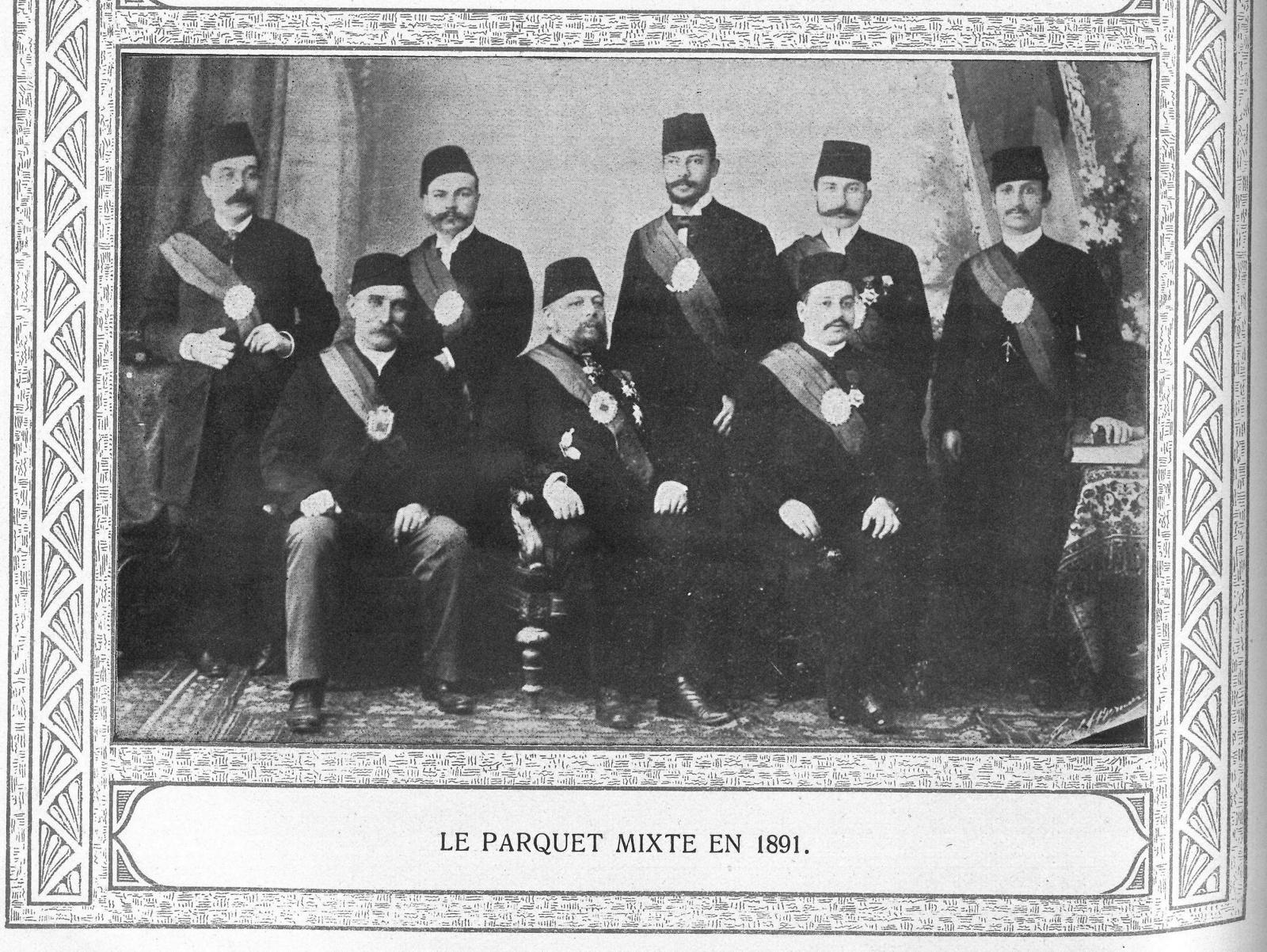 Functionaries of the Parquet in 189, showing these prosecutors wearing regalia similar to that of judges, but wearing the bi-colored sash and probably the all-silver badge. While several photos of individuals serving in the Parquet show them wearing their sashes with the green stripe uppermost (i.e., Firman Van Den Bosch above; Mahmoud Said as Chief of the Parquet in the first photo of my post of 5 March 2019 shown get District Court of Mansourah in ~1926; and Ismail Gazzarine in that same photo as the Subsitute for the the Procureur Général), almost all of these individuals above are wearing theirs so that the red stripe appears to be superior and the green stripe is inferior. Note the 3 individuals who are wearing decorations on their jackets at this date along with the official Parquet regalia. The individuals in the front row L-R are: Lemaire Bey (Inspector of the Clerk, nationality not identified), Guillaume Edward Emile Marie de Brower (Procurer General, Belgium), Emin Ghali Pacha (Chief of the Parquet of Alexandria, Egypt), In the back row are L-R: Luigi Colucci Bey (nationality not identified), Edgar Mercinier (Secretary, nationality not identified, who may be wearing a solid red-colored sash), Soubhil Ghlai Bey (who appears to be wearing his sash oriented with the green stripe uppermost and the red stripe in the inferior position, Egypt), Ahmed Zulificar Bey (Egypt), Ismail Chimi Bey (Subsitute for the the Procurer General, Egypt), From: Les Juridictions Mixtes d'Égypte 1876-1926: Livre d'or Édité sous le Patronage du Conseil de l’Ordre des Avocats á l’Occasion du Cinquantenaire des Tribunaux de la Réforme, par le: Journal des Tribunaux Mixtes. Alexandrie, Egypte, Février 1926, pg. 190.
Functionaries of the Parquet in 189, showing these prosecutors wearing regalia similar to that of judges, but wearing the bi-colored sash and probably the all-silver badge. While several photos of individuals serving in the Parquet show them wearing their sashes with the green stripe uppermost (i.e., Firman Van Den Bosch above; Mahmoud Said as Chief of the Parquet in the first photo of my post of 5 March 2019 shown get District Court of Mansourah in ~1926; and Ismail Gazzarine in that same photo as the Subsitute for the the Procureur Général), almost all of these individuals above are wearing theirs so that the red stripe appears to be superior and the green stripe is inferior. Note the 3 individuals who are wearing decorations on their jackets at this date along with the official Parquet regalia. The individuals in the front row L-R are: Lemaire Bey (Inspector of the Clerk, nationality not identified), Guillaume Edward Emile Marie de Brower (Procurer General, Belgium), Emin Ghali Pacha (Chief of the Parquet of Alexandria, Egypt), In the back row are L-R: Luigi Colucci Bey (nationality not identified), Edgar Mercinier (Secretary, nationality not identified, who may be wearing a solid red-colored sash), Soubhil Ghlai Bey (who appears to be wearing his sash oriented with the green stripe uppermost and the red stripe in the inferior position, Egypt), Ahmed Zulificar Bey (Egypt), Ismail Chimi Bey (Subsitute for the the Procurer General, Egypt), From: Les Juridictions Mixtes d'Égypte 1876-1926: Livre d'or Édité sous le Patronage du Conseil de l’Ordre des Avocats á l’Occasion du Cinquantenaire des Tribunaux de la Réforme, par le: Journal des Tribunaux Mixtes. Alexandrie, Egypte, Février 1926, pg. 190.

Functionaries serving the District Court of Mansourah in 1926 showing the use of similar regalia to that worn by judges for individuals serving the courts in other capacities. Most of these individuals appear to be wearing bi-colored sashes as do the personnel on the Parquet, and probably should be wearing all-silver badges. Almost all of the men are wearing their sashes oriented with the green stripe in the superior position and the red stripe in the inferior position. All of the interpreters in this photo are not wearing sashes and badges. The other individuals not wearing sashes and badges include the Chief Bailiff (5th from L in front row) and the Secretary to the President (3rd from L in the middle row). The first names and nationalities of most of these individuals are not given. The individuals in the front row are L-R: G Cassis (Clerk), Yacoub Salib (interpreter), Zaki Saleh (Clerk), G. Sabeh (Conservator of Mortgages), Poli (Chief Bailiff), Cosséry (Clerk), and Garzoni (Clerk). In the middle row from L-R are: B. Finan (Clerk, apparently wearing his sash with the red stripe uppermost and the green stripe in the inferior position, unlike all the other bi-colored sashes in this photo), Boutari (Clerk), Jourdan (Secretary to the President), Vibert-Roulet (Clerk), and Chibli (Clerk). The back row includes L-R: Bonnicci (interpreter), Habib Salem (Clerk, his sash may be solid red rather than bi-colored), Faiez Gress (interpreter), and Youssef Boutros (interpreter). From: Les Juridictions Mixtes d'Égypte 1876-1926: Livre d'or Édité sous le Patronage du Conseil de l’Ordre des Avocats á l’Occasion du Cinquantenaire des Tribunaux de la Réforme, par le: Journal des Tribunaux Mixtes. Alexandrie, Egypte, Février 1926, pg. 394.
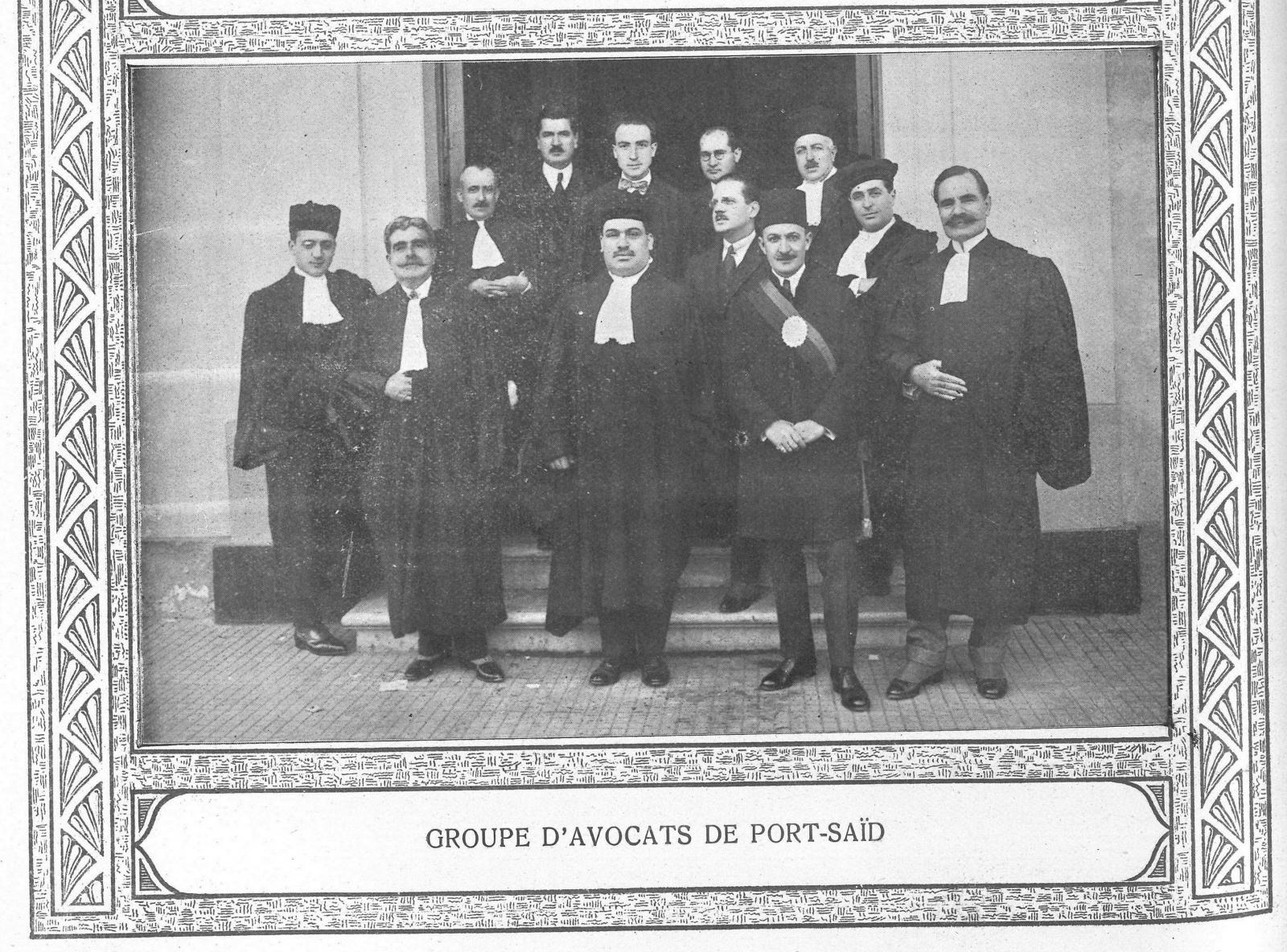
Portrait of the lawyers (avocats) serving the District Court of Port Said showing one individual who is a clerk with garb similar to judges or functionaries of the Parquet and the court costume for the lawyers. The lawyers wear silk robes, the legal cap (beretta), and the white scarf (rabat) based on that of the French bar. The first name of the clerk of interest in the first row wearing a sash and "judicial" badge is not identified and the nationalities of these men are not given. The individuals not identified with other roles all are lawyers. The individuals in the front row are L-R: Christo Medinas (wearing a beretta), Joseph Zalout, George Mouchbahani, (Delegate), Spagnolaki (Clerk in the bi-colored green & red sash and probably silver "judicial" badge), and George Anasassiadis. In the middle are L-R: Pascal Gabelli, Nicolas Zizinia, and Domenico Mascagni. The back row includes L-R: Jean Papayoannou, Charles Bacos, Kimon Valendi, and Camillo Corsetti. Also see the 4th photo in my post of 1 April, 2019 showing lawyers in the courtroom of the Appeals Court in 1926 wearing their legal costumes, including the French epitoge, the French version of the academic hood, partially visible on the backs of the 3 lawyers in the right foreground of the photo. From: Les Juridictions Mixtes d'Égypte 1876-1926: Livre d'or Édité sous le Patronage du Conseil de l’Ordre des Avocats á l’Occasion du Cinquantenaire des Tribunaux de la Réforme, par le: Journal des Tribunaux Mixtes. Alexandrie, Egypte, Février 1926, pg. 206.
0 -
I have had minimal luck finding background information about J. Lattes, the manufacturer of the most beautiful examples of the Order of Ismail, as well as other Egyptian medals. I have previously given a short synopsis in my post of 14 November, 2017 on this thread of a brief mention in The Jewelers Circular and Horological Review, Vol 34, No. 24, of 14 July, 1897, pg. 9 of the shop of J. Lattes as a small but attractive store at the margin of the market area (the Muski) and what the author (Chas Crossman) termed the foreigner's quarters. I have recently been searching some advertisements relative to manufacturers of the Mixed Courts judicial badges, and came across an example of an undated folding business card for J. Lattes in English from an 18 July, 2018 eBay auction (https://www.ebay.com/itm/163133205268?rmvSB=true). The listing included low-resolution images of the 3 illustrations that make up the folding advertisement card pages measuring 4" X 5-3/8" when folded and 5-3/8" X 8" when opened. The first page is an advertisement , possibly for liquidation sale of some of Lattes' stock. This is the only information I have found identifying the founding date of Lattes' shop as 1860. The back page shows 7 coins, apparently with prices. When opened, the inside page shows a map of Cairo indicating the location of Lattes' shop on Sharia el Manakh street. There is a slightly higher resolution image of the first page of this card that I have included as the first image below.
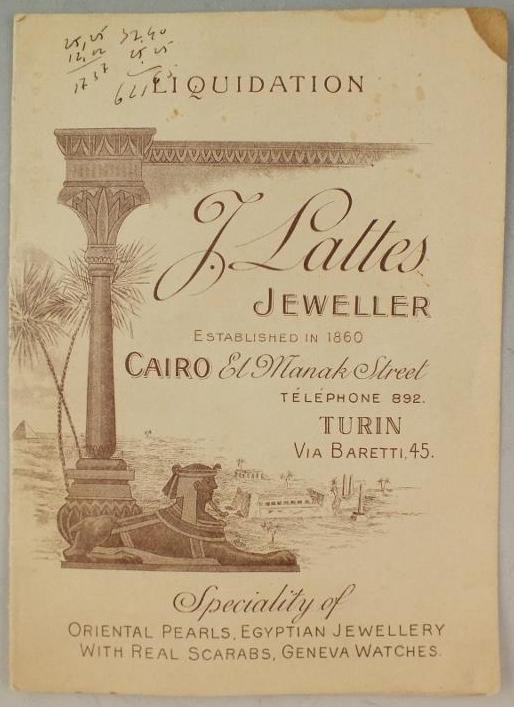
Page 1 of the J. Lattes folding trade card.

Low-resolution image of the back page of this folding trade card.

Low-resolution photograph of the interior map of the J. Lattes folding card showing the location of Lattes shop.
Above is a roughly contemporary map of Cairo for tourists from the inside of a folding advertising flyer for the Victoria Hotel & New Khedival showing the location of that Hotel with the main street route of Sharia Kamel to Opera Square continuing to Sharia Abdine and a couple tram routes (from:https://www.flickr.com/photos/kelisli/12708781123/in/dateposted/). In comparison with the poor quality image of the eBay auction map image above, this higher-resolution map (that can be enlarged) does show the approximate location where J. Lattes shop was located on Sharia el Manakh (on the north side of the street?) between Sharia el Imad el Din on the west and probably an unnamed alleyway on the east side that is approximately 1/3 of a block west of Opera Square. In a listing of shops selling European wares for travelers to visit in Cairo from the 1908 book Egypt and the Sûdân: Handbook for Travellers, 6th Edition, by Karl Baedecker, Karl Baedeker Publishers, Leipzig (Dulau & Co., London; Charles Scribner's Sons, New York ) the author identifies the address of J. Lattes shop as "Sharia el-Manâkh 30". A telegraph office was located at the most western end of this block, identified as the "Eastern Telegraph Office" in a very good map from 1920 (titled: General Map of Cairo; created by the Survey of Egypt, 1920; Contributor Names: Egypt. Maṣlaḥat al-Misāḥah; Call Number: G8304.C2 1920 .E4; Digital ID: http://hdl.loc.gov/loc.gmd/g8304c.ct002478; Library of Congress Control Number: 200958102) available online though the US Library of Congress Geography and Map Division, Washington, D.C. 20540-4650 USA at https://www.loc.gov/resource/g8304c.ct002478/?r=-0.524,-0.324,2.049,0.835,0. This location also is listed as the "foreign telegraph office" located at "15 Sharia-el-Manakh" on page 21 of the travel guide: Cairo of To-Day: A Practical guide to Cairo and its Environs , 1898, by E. A. Reynolds-Bali, London, Adams and Charles Black (printed by R.& R. Clark, Limited, Edinburgh).
Below are two stereo views of this market area taken on unidentified streets in the early 20th century.
Stereo image titled: "The 'Muski'. The great street of Cairo and one of the most interesting in the world, Egypt", taken on approximately 21 September 1903 by William Hermann Rau. From the US Library of Congress Prints and Photographs Division, Washington, D.C. 20540, USA. Call Number: LOT 13980, no. 38; Digital ID: stereo 1s01871 http://hdl.loc.gov/loc.pnp/stereo.1s01871; Library of Congress Control Number: 2009631292; LCCN Permalink: https://lccn.loc.gov/2009631292 (From: https://www.loc.gov/item/2009631292/).

Stereo view titled: "The Muski, Cairo Egypt", from the Keystone-Mast Collection at University of California Riverside Museum of Photography. Taken September 2, 1931by George Lewis (https://oac.cdlib.org/ark:/13030/kt6f59q0kj/?docId=kt6f59q0kj&order=2&brand=oac4&layout=printable)
0 -
Les and Jocktamson provide the most knowledgeable discussions of this topic. Their advice and warnings are the best suggestions about whether to treat older leather or not.
An antique furniture restoration craftsman in Massachusetts recommended Skidmore's Leather Cream to me for treatment of the leather seat on a Campeche chair made by William Spratling in the 1940s (Spratling was from New York, educated as an architect in New Orleans, and made his name by reviving the Mexican silver industry in Taxco combining indigenous and art deco elements, he also made some furniture; Marilyn Monroe bought several pieces of furniture from Spratling shortly before her suicide; Spratling also assisted Diego Rivera in obtaining some of his early commissions for murals). This leather cream is made in Port Townsend, Washington state, USA. It contains no animal products, silicone, or driers. It has unspecified compounds from plants, trees, and beeswax. Skidmore also makes other beeswax products for wood finishes. As Peter Monahan noted, beeswax is used in some museum curation for attachments, rests, and holding items together as it is very reversible. The chair seat had suffered much use, some water damage, flaking, etc. I have found the treatment with Skidmore's Leather Cream (on both faces of the leather) to be most successful in restoring suppleness and protecting this leather. Skidmore's Leather Cream is, of course, not a museum curatorial product, but it is a good compromise between my wish to protect this valuable item for the future and enjoy sitting in it. This is not a product I use on the cattle or exotic leathers of my shoes, western boots, belts, etc. (where I use Lexol brand cleaner, conditioner, and then colored or neutral shoe creams for maintenance and protection of items in everyday use).
0 -
An example of a Mixed Courts judicial silver badges manufactured by a jeweler I have not seen represented before is listed (Lot 74177) on a current auction by Heritage Auctions (https://fineart.ha.com/itm/silver-smalls/an-egyptian-silver-magistrate-s-badge-from-the-reign-of-abbas-ii-egypt-circa-1900marks-unidentified-cipher-zivy-fr/a/5403-74177.s) and also listed on liveauctioneers.com website (https://www.liveauctioneers.com/item/70835139_74177-an-egyptian-silver-magistrate-s-badge-from-the-r). This badge was made by Zivy Frères & Cie., a Swiss jewelry house, watchmaker, and goldsmith with addresses in Paris and at 10 rue Chèrif Pacha, Alexandria (the same street where Horovitz had a storefront at 26 rue Chèrif Pacha, see my post of 1 December, 2018 where I illustrated a silver badge made by Horovitz, and the last image in that shows a photo from ~1900 of the rue Chèrif Pacha). In addition to being the only badge made by Zivy Frères & Cie. that I have found photos of, this example has some interesting differences in the detail of its execution, and one very odd missing symbolic element.
Obverse of the Mixed Courts badge made by Zivy Frères & Cie., Alexandria. The auction description calls this a "Magistrates badge from the reign of Abbas Hilmi II", identifies the manufacturer as Zivy Frères, considers the hallmark ("cipher") as unidentified, and gives the measurement as 4-5/8" (117.5 mm) high X 3-5/8" (~92 mm) wide, and provides a very approximate date of c.1900.
The Zivy Frères & Cie. example shows some very significant variation in many details of its design compared with other Mixed Courts badges. The above image can be zoomed for additional detail. A couple aspects appear more detailed and three-dimensional; specifically, the depth of relief in the crown (although the superior crescent appears to be less detailed, the inferior band of the crown also shows less crisp definition of its design elements, and possibly other crown components are slightly different) and the execution of the tasseled cords at each of the upper corners of the mantle in the coat of arms. The interior loops (those on the crown side of the mantle corners) of the tasseled cords each form heart-shaped loops, compared with the more triangular ovals seen on all other examples. The exterior loops of these two cord elements also show somewhat greater detail (especially the left exterior loop) and relief. There is a raised "cord" border to the fringe and interior of the mantle that I also have not seen on other badges. Such a cord is present on the exterior portions of the mantle in other badges, between the embroidered portion of the mantle and the fringe, but not on the interior. The Zivy Frères badge also has a raised cord border on the two superior lateral exterior drapery folds of the mantle between the first (lower) panel of spiral "embroidery" next to the fringe and the more superior embroidery panel of triangular designs, also not seen on other examples. In contrast, many other elements of this Zivy Frères badge are much less detailed in their design. All 4 tassels are rendered in lower relief and detail, and each of the interior tassels lacks the longer, straight section of cord seen in all other examples. Both finials of the two tughs, as well as the horsetail embellishments, are executed in less detail, especially compared with the Froment-Meurice and Stobbe examples, and even compared with the Horovitz badge (the one Horovitz example I have seen photos of seems to be made with less careful craftsmanship than Froment-Meurice or Stobbe, but still is much more detailed the this Zivy Frères badge) that I illustrated in my post of 1 December, 2018 on this thread. The oak leaves on the L and the laurel leaves on the R of the tablet with inscription are much less detailed than on other examples, even less so than the Horovitz example. The superior star and rays above the inscription tablet may be lower relief and appear less finely designed. The ermine tail relief elements distributed across the interior of the mantle are executed in larger and much coarser fashion than on any other examples, and several that normally appear across other designs are missing (i.e., the two that appear below the oak & laurel branches and above the margins of the Order of Medjidie badge element; the 2 just below the cut ends of the oak & laurel branches; and the two on either side of the hand of justice on the superior finial of the L tugh, all of which are visible even on the less-detailed Horovitz example. The most dramatic differences from other badges are apparent in the lower portion of the badge. Below the union of the union of the oak & laurel branches, a ring is present, but the crescent and star is completely missing. This seems quite an odd omission of an important symbolic element. No other example I have seen lacks this Ottoman emblem. The Order of Medjidie is missing the full circumference of the 7-pointed, multi-rayed, star embellishment, and the central medallion frame is much thinner than on other badges. Its surrounding wreath also appears to be much less detailed in its execution. The auction description notes some damage to the enamel (of the central tablet’s inscriptions), but in comparing the inscription with other examples, there appears to be some lower elegance in the calligraphy of this example even before such damage occurred.
Although the height dimension of this badge is not that anomalous (117.5 mm, compared with more common measurements of 115, or 116 mm, although at least one other example is identified as 117 mm), the width of 92.07 mm is slightly larger than almost all other examples from auction sites providing measurements that generally are 85 mm or maximally identified as 88 mm. The multi-rayed embellishment does appear to extend further beyond the mantle margins than on other manufacturer's examples.
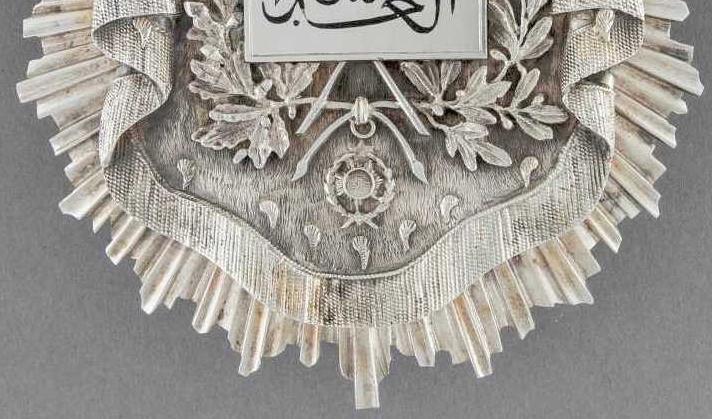
Close-up of the inferior portion of the Zivy Frères badge showing the missing crescent & star element below the tied oak & laurel branches and the much less detailed execution of the Order of Medjidie symbol. The coarser ermine tail decorations, the less well-modeled "fur" relief of the mantle interior, and less well-executed oak & laurel leaves also are apparent in this view.
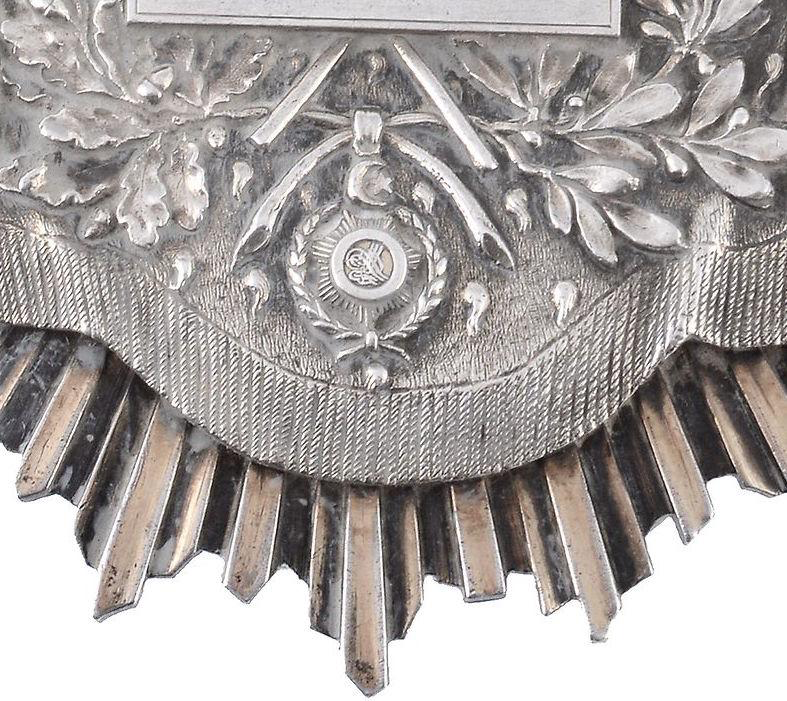
For comparison, above is the inferior design portion of the silver judicial badge made by Froment-Meurice and attributed to Judge Herbert Hills (http://www.dreweatts.com/auctions/lot-details/?saleId=13863&lotId=175).
Reverse of the Mixed Courts badge made by Zivy Frères & Cie., Alexandria. Note that the 5 rivet fasteners normally visible on the reverse where the mantle component is attached to the multi-rayed embellishment are not present on this example, suggesting a soldered attachment rather than rivets (areas of solder may be visible along the joint between the central shield-shaped portion and the multi-rayed embellishment). .
Reverse of the Mixed Courts badge made by Zivy Frères & Cie. with the tunic pin opened showing the placement of the name "ZIVY FRERES" and their manufacturer's hallmark. No silver assay hallmarks are visible on the reverse.
Close-up view of the name "ZIVY FRERES" and probably their manufacturer's hallmark (unfortunately not detailed enough to be able to see clearly, but it does not appear to be a silver purity hallmark). The Zivy Frères name shows a double strike in its application. I have found very few internet images of Zivy Frères silver pieces, and none so far that show the firm's hallmark.
Business card of Zivy Frères & Cie. (https://www.flickr.com/photos/kelisli/25209863512/in/dateposted/). Examples of this card also are currently offered on an eBay auction (https://www.ebay.com/itm/EGYPT-FRANCE-Zivy-Freres-Co-The-provider-of-Jewelries-to-HM-King-of-EGYPT/303120051239?hash=item46935cec27:g:YCIAAOSwWrNcFTNE). The crown in the upper left of the card is a version of the Egyptian Royal Crown.
Advertisement for Zivy Frères & Cie. from pg. XX of Alexandrie: Reine de la Mèditeranèe, No 1, Juillet 1928, 1ère Partie (http://www.cealex.org/pfe/diffusion/PFEWeb/pfe_068/PFE_068_002_1_w.pdf(http://www.cealex.org/pfe/diffusion/PFEWeb/pfe_068/PFE_068_002_1_w.pdf).
1 -
I have some additional photos and information from the volume Les Juridictions Mixtes d'Égypte 1876-1926: Livre d'or Édité sous le Patronage du Conseil de l’Ordre des Avocats á l’Occasion du Cinquantenaire des Tribunaux de la Réforme, par le: Journal des Tribunaux Mixtes. Alexandrie, Egypte, Février 1926 that I wish to share. In this post, I want to include images and information associated with individuals I have mentioned in past posts. I will treat each person that I have found something about in the order that they appeared on this thread. The only individual I have not been able to get any additional information about from this publication is the Greek Judge Apostolo N. Gennaropoulo, whose cased silver judicial badge made by Froment-Meurice and a portrait photo appeared on an eBay auction of September, 2014. I first illustrated Judge Gennaropoulo’s badge and portrait in the final photo of my post of 24 March, 2017, and the reverse of his badge is shown in the 7th photo of judicial badges (the 3rd to last of the illustrations of Froment-Meurice manufacturer’s marks) in my post detailing manufacturer’s and assay hallmarks of 28 February, 2019. It may be that Judge Gennaropoulo was not appointed to the court until after 1926, when the Les Juridictions Mixtes d'Égypte 1876-1926 volume was published. So far, I have not found information about this individual in other research sources I have consulted. I have scanned the photos from the Les Juridictions Mixtes d'Égypte 1876-1926 volume that I am including below in black and white as that seems to provide better detail of the images. Each of them have the decorative ancient Egyptian frame motifs around the photos in a rose color as shown in the scanned images from my 1 April, 2019 post, although they do not appear in color here. All of the scanned photos from the Les Juridictions Mixtes d'Égypte 1876-1926 volume can be zoomed for somewhat greater details.
Herbert Augustus Hills (1837-1907) I illustrated the obverse of the silver judicial badge identified as belonging to Herbert Hills of Great Britain, in the 1st photo of my post of 24 March, 2017. I illustrated the reverse of that badge that has a hand-written note attributing the badge to Judge Hills in my post of 7 November, 2017. I have included images of both the obverse & reverse of that badge below. Herbert Hills is identified in the Les Juridictions Mixtes d'Égypte 1876-1926 volume’s appendix listing of personnel for the District Courts. Hills is identified (pg. XII) as having been appointed in November of 1875 as a judge to the District Court in Alexandria, and promoted to Conseiller (legal advisor) to the Court of Appeals in October 1882 (Mark S. W. Hoyle, a moderately prolific recent scholar of the Egyptian Mixed Courts identifies his initial appointment year as 1876, probably an incorrect date, in his 1986 article: The structure and laws of the Mixed Courts of Egypt. Arab Law Quarterly, Vol 1 (3): 327-345). In the appendix list of personnel serving the Appeals Court, Hills is identified (pg. IV) as a former judge in Alexandria, and promoted to the Appeals Court in October, 1882, and he resigned in February, 1904. That section also states he was awarded the 2nd Class Order of Mejidie (he received this in either 1904 or 1905, a note in The Law Times: The Journal of the Law and The Lawyers, Vol CXIII of March 11, 1905, pg. 442 states that "Mr. Herbert Augustus Hill, late Judge in the Egyptian Mixed Court of Appeal at Alexandria, has received the Royal license and authority to accept and wear the Insignia of the Second Class of the Imperial Ottoman Order of the Medjidieh"). No photo of Judge Hills is included in the Les Juridictions Mixtes d'Égypte 1876-1926 volume, and I have not found any images of him in y other research. This information does not resolve the question I mentioned in both posts about why Judge Hills would have a silver badge when his appointment to the District Court of Alexandria should have meant his regalia included a gold and silver badge. It also puzzles me whether as a Conseiller in his later appointment to the Appeals Court he might have worn a gold judicial badges (the design for the Appeals Court), or retained a previous badge (again what should have been a gold & silver badge from his service on the District Court) as he was not a judge on that highest court. In both cases, this silver badge remains either an anomalous example of regalia associated with his identified roles on the Mixed Courts or a problematic attribution to Judge Hills.
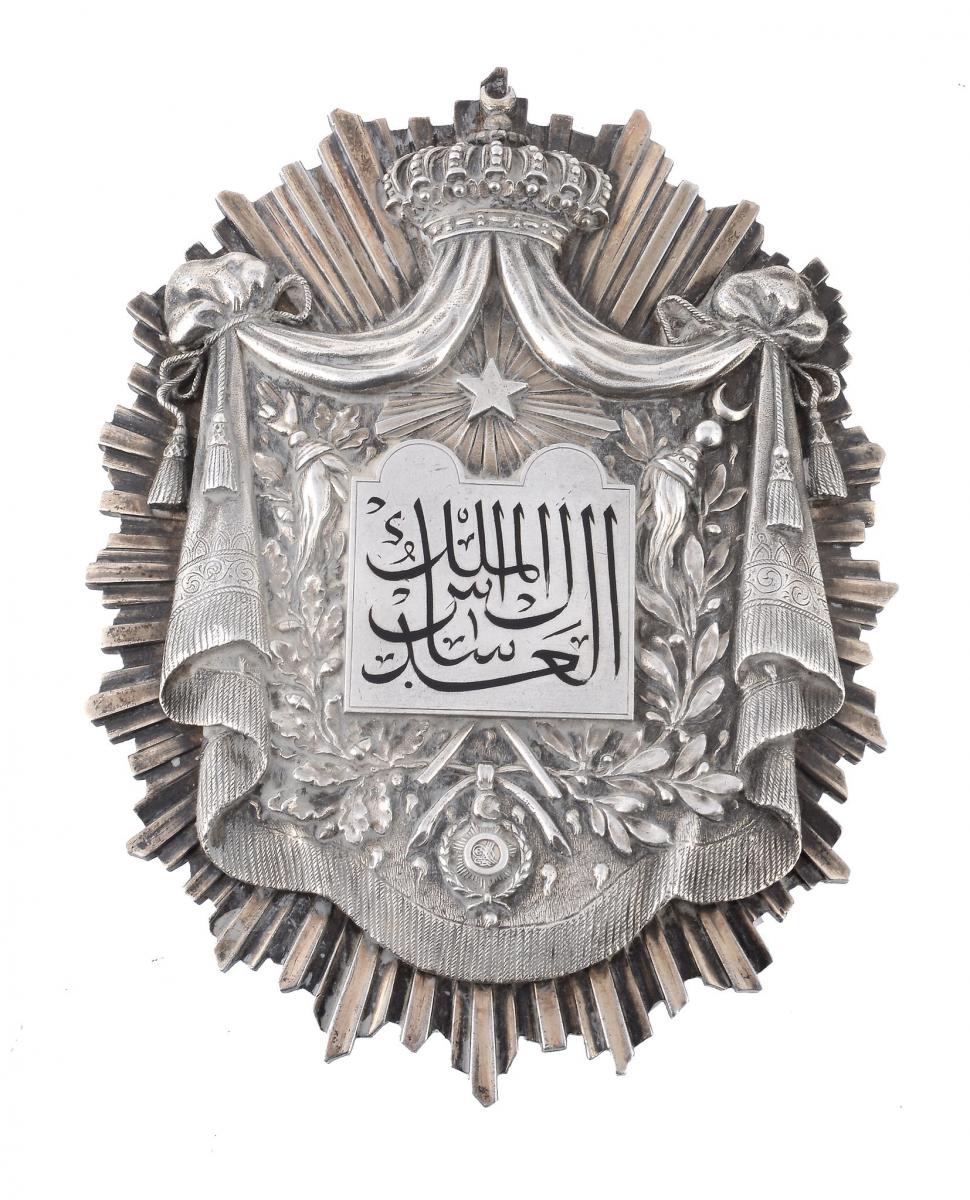
Obverse of the silver judicial badge attributed to Judge Herbert A. Hills of Great Britain (From a June 2015 auction : Dreweatts Bloomsbury Auctions; lot 175; formerly listed at: http://www.dreweatts.com/cms/pages/lot/13863/175, but archived on The Saleroom website: https://www.the-saleroom.com/en-gb/auction-catalogues/dreweatts/catalogue-id-drewea10199/lot-d2a1fe08-3bbf-4c29-a53d-a4aa00a27910). Identified as made by Froment-Meurice and measuring 12 cm high X 8.5 cm wide and weighing 173 g.
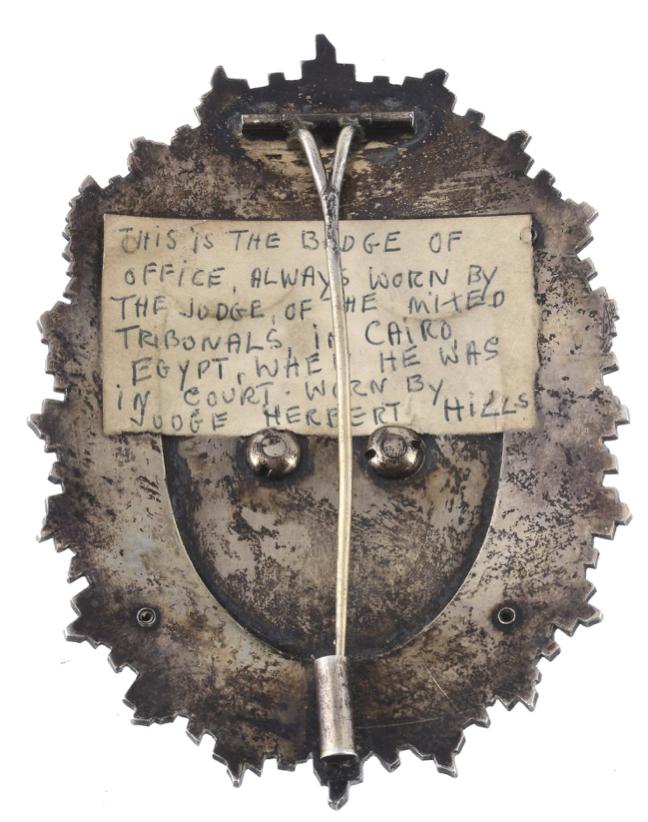
Reverse of the badge attributed to Judge Hills, showing the note that is the basis for identifying this badge with Herbert Hills. It is uncertain whether the reverse has any hallmarks for Froment-Meurice. This image is a higher-resolution photo of the reverse than the version I uploaded in my may 7 November, 2017 post on this thread and can be zoomed for better details of the attached note.
Alexander Cockburn McBarnet (1867-1934) Egyptian Zogist posted a link (in his post of 4 November, 2017) to an auction by Brightwells of November, 2017 that is archived on The Saleroom website (https://www.the-saleroom.com/en-us/auction-catalogues/brightwells/catalogue-id-srbr10077/lot-b19bfcb8-19b4-41fd-808e-a81900b1168c) of medals and clothing belonging to Alexander Cockburn McBarnet. I commented on the information about the judicial badge in this lot (282) in my 2 posts of 6 December, 2017 but did not illustrate the badge as it is a very low-resolution image. Owain commented on potential dating of some of McBarnet’s other awards in his post of 7 November, 2017 on this thread. The Brightwells’ auction of November 2017 identifies McBarnet as having been appointed as a District Judge in to the Indigenous (“Native”) Court of Appeals in 1913, as a judge in the District Court of Asyut (also indigenous?) in 1906, and as holding various other legal offices in Egypt subsequently. The appendices in Les Juridictions Mixtes d'Égypte 1876-1926 volume that identify past & current officials of the Appeals Court lists McBarnet (pg. V), of Great Britain, former Conseiller (legal advisor) to the Indigenous Court of Appeals (no starting date is given in this entry), but does identify him as having been appointed in December 1920 to the Mixed Appeals Court, and working in that office at the time of the 1926 publication. McBarnet is not in the photograph of the Appeals Court that I posted on April 1, 2019 in this thread. No photos of Judge McBarnet are featured in the Les Juridictions Mixtes d'Égypte 1876-1926 volume, and I have not yet encountered any others in my research. In regard to the question about McBarnet’s other awards discussed by me in both my posts of 6 November, 2017 and by Owain on 7 November, 2017, I previously overlooked the information in the Brightwells’ auction listing the original bestowal documents as April 14, 1914 for receipt of the 3rd Class Order of Medjidie, and the August 7, 1917 receipt of the 3rd Class Order of the Nile (additionally, his OBE was awarded on March 30, 1920 and CBE on March 24, 1922). Jasper Yeates Brinton's comment about restrictions on serving judges from receiving honors from the Egyptian government during their service (Brinton, Jasper Yeates, 1968. The Mixed Courts of Egypt, 2nd Edition. Yale University Press, New Haven, pp. 53-54) may not have been fully in effect at this time, or McBarnet may have received these during intervals between his different court service. I have photographs for future posts of earlier Mixed Courts judges wearing medals along with their judicial costumes, a practice that appears to have ended sometime in the earliest 1900s. Note in my discussion above that Judge Herbert A. Hills was not awarded the Order of Mejidie until after his retirement from the Egyptian Mixed Courts. Also in relation to this question, the entry for Pierre Crabitès in the Les Juridictions Mixtes d'Égypte 1876-1926 volume appendix listing personnel of the District Courts (pg. XI) does not identify his reciept of the Grand Officer Class of the Order of Ismail, consistent with Brinton's statement that, at least at this time, honors and awards were not given to sitting judges until the end of their tenure on the bench.
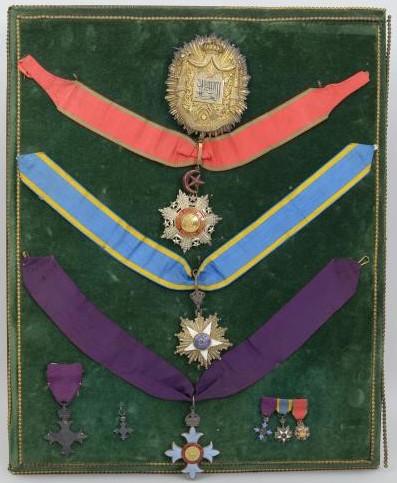
Low-resolution image of awards of Alexander Cockburn McBarnet from the November 2017 Brightwells’ auction. From top to bottom: McBarnet’s judicial badge (identified in the auction description as 115 mm high X 85 mm wide, silver, & silver gilt), 3rd Class neck badge of the Order of Medjidie, 3rd Class neck badge of the Order of the Nile, Commander’s neck badge of the British CBE (civil). On the bottom left are his OBE breast badge and miniature of that award lacking its ribbon. On the lower right are miniatures of his OBE, Order of the Nile, and Order of Medjidie.
Santos Manoël Jaoquim Rodrigues Monteiro (1879-1952) I illustrated a Portuguese commemorative medal celebrating the life of Dr. Manual Monteiro (of Portugal) in my post of 26 April, 2018 that identified him as a former judge on the Egyptian Mixed Courts. In the Les Juridictions Mixtes d'Égypte 1876-1926 volume, Santos Manoël Jaoquim Rodrigues Monteiro is identified as a judge in the District Court of Mansourah beginning in October, 1916 and was transferred to the District Court of Alexandria in February of 1921. He was still serving in that office at the time of the 1926 publication (pg. XV). Additional information about Dr. Monteiro is in my 26 April, 2018 post (i.e., he was made Vice-President of the Alexandria District Court in 1930, and resigned in 1940 to return to Portugal).
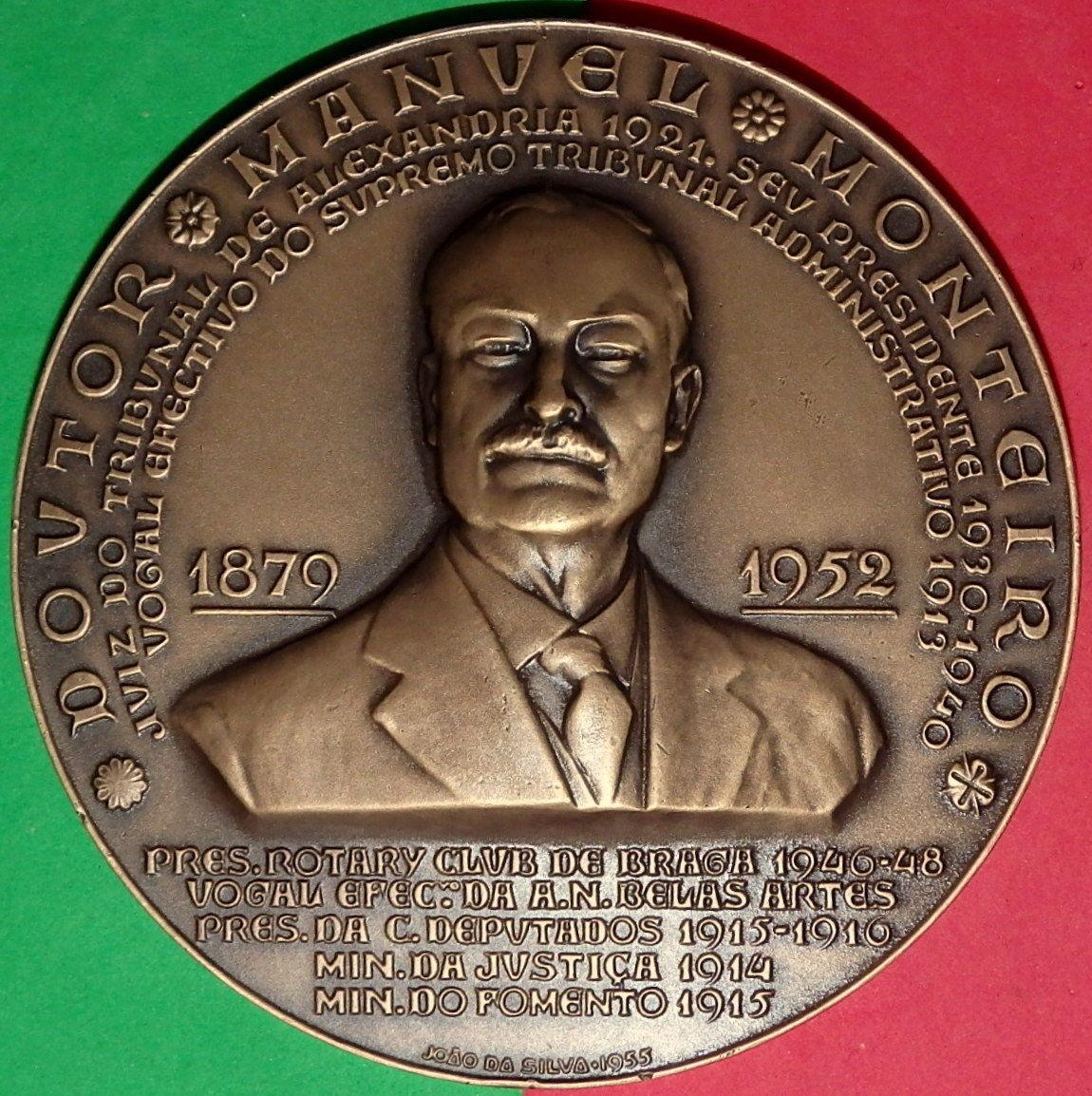
Obverse of the table medal commemorating the life of former Mixed Courts Judge Dr. Manuel Montero, who also was an historical archaeologist, ethnologist, and art historian of Romanesque Portuguese art.
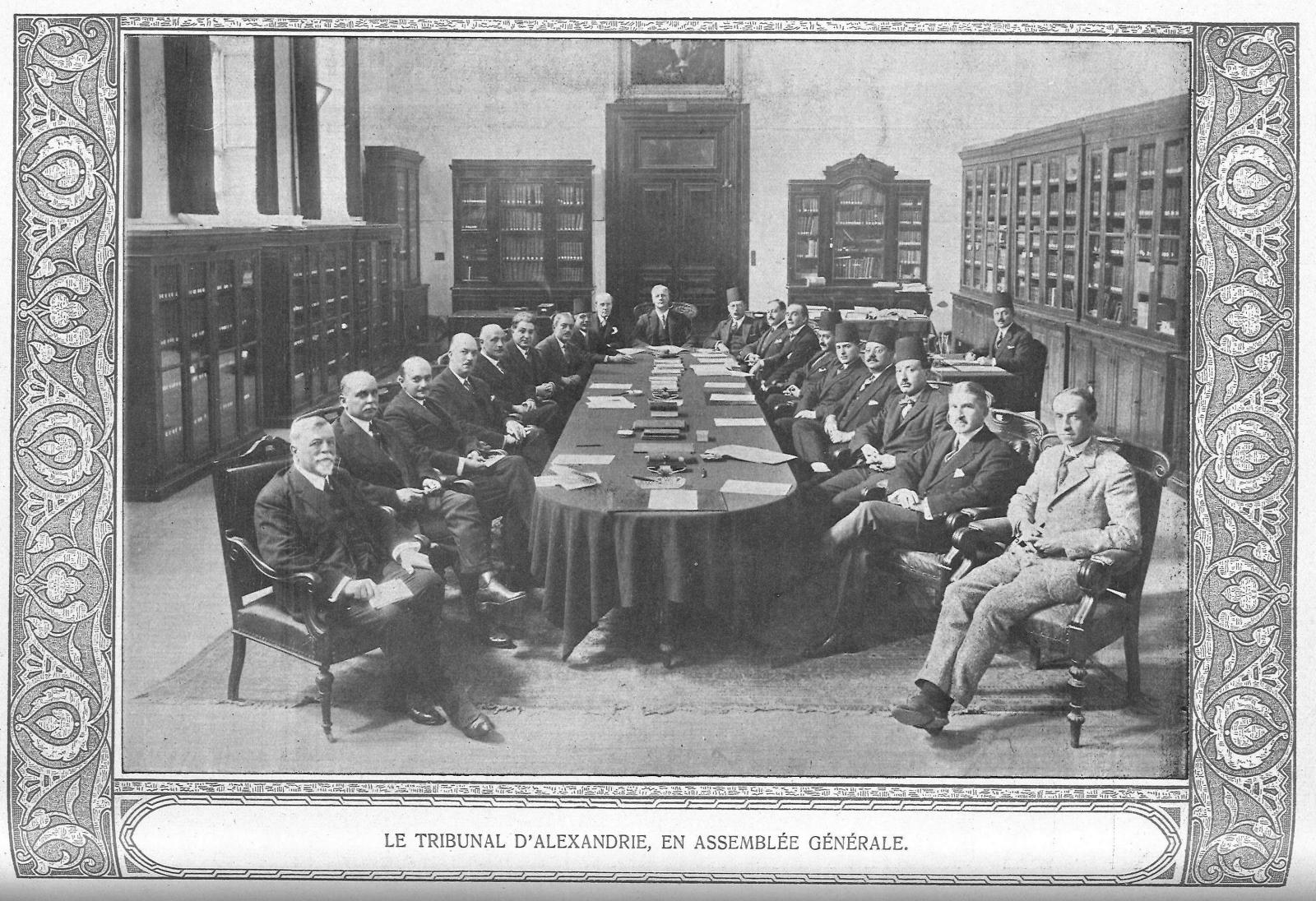
Photo of the District Court officials of Alexandria, probably from 1925 from the Les Juridictions Mixtes d'Égypte 1876-1926 volume (pg. 192). This image can be zoomed for better details. Judge Monteiro is seated second from the viewer's right of the Court President, seated at the head of the far end of the table. The judges in this photo include, from the foreground left running clockwise around the table: Paul Joseph Randet (France); Dr. Alvaro da Costa Machado Villela (Portugal): Stavros Ange Vlachos (Greece); Adrian Theodor Louis Allard Heyligers (Netherlands); Dr. Jonkheer Hubert Williem van Asch van Wyck (Netherlands); Salvatore Messina (Italy); Paul Beneducci (Russia); Ragheb Bey Ghali (Egypt); Don Alfonso Aguirre y Carrer, Comte de Andino (Vice-President, Spain); Erling Qvale (President, Norway); Ahmed Fayek Bey (Chief of the Parquet, Egypt); Manuel Monteiro (Portugal); William Hobart Houghton Thorne (Britain); Antoine R. Keldany Bey (Egypt); Youssef Zulificar Bey (Egypt, later Pasha as he was the father of Queen Farida & father-in-law to King Farouk I, Youssef Zulificar also married the sister of fellow Mixed Court judge and Egyptian modernist artist Mahmoud Said); Mohamed Tewfik Zaher Bey (Egypt); Khalil Ghazalat Bey (Egypt); Mohammed Aly Zaki Bey (Egypt); and Rober Llewllyn Henry, Jr. (USA). The Chief Clerk, M. Adib Maakad Bey (Egypt), is shown sitting at the right away from the main assembly table.
Michael Hansson (1875-1944) I illustrated a photo of the Norwegian Judge Michael Hansson wearing his judicial costume in my post of 3 May, 2018. This photo came from a Norwegian biographical website (https://nbl.snl.no/Michael_Hansson). This same portrait also appears in Hansson’s posthumously-published popular book on this life in Egypt: 25 år i Egypt, 1946. Forlagt Av. H. Aschehoug & Co., (W. Nygaard), Oslo (opposite page 17). I am including again this 1912 photo of Michael Hansson in his judicial costume below. He was apparently a prominent member of the Courts, and several additional photos and information are available in the Les Juridictions Mixtes d'Égypte 1876-1926 volume. In the listings of personnel in the District Courts, Hansson is identified (pg. XIV) as having been appointed in January 1907 to the District Court in Mansourah, transferred to District Court of Alexandria in October 1913, and promoted to Conseiller (legal advisor) to the Mixed Court if Appeals in April 1915. He is identified in the appendix listing personnel of the Appeals Court (pg. V) as a former judge to the Mixed Tribunals of Alexandria from April 1915, as Vice-President of the Mixed Court of Appeals in October 1924, and in 1926 he was still serving as Vice-President of the Appeals Court. Additional information on Hansson is in my 3 May, 2018 post; including his promotion to President of the Court of Appeals in 1927, his retirement from the Courts in 1931, and subsequent career with the the Permanent Court of Arbitration at the Hague, other international arbitration commissions, and 1938 Nobel Prize acceptance speech on behalf of the Nansen International Office for Refugees. Hansson also was probably awarded his Grand Cordon Class Order of Ismail and Order of the Nile after his retirement from the International Mixed Courts in Egypt, neither of this honors are mentioned in the Les Juridictions Mixtes d'Égypte 1876-1926 volume's descriptions of his career in Egypt.
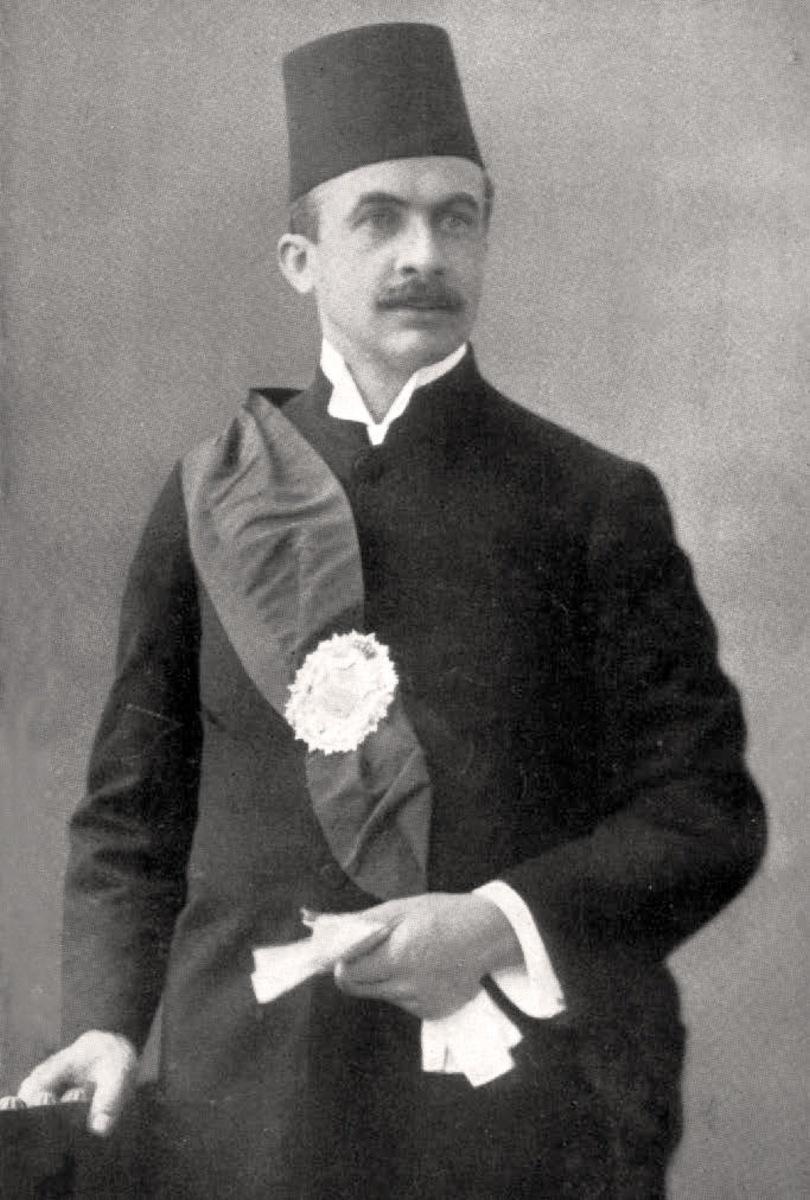
Portrait of Michael Hansson, from 1912 as a District Court Judge in Mansourah. In relation to the question I had about whether his sash is a single color or bi-colored, the appointment information in the Les Juridictions Mixtes d'Égypte 1876-1926 volume indicates his sash is a solid red as he was appointed to the District Courts at the time of this portrait.
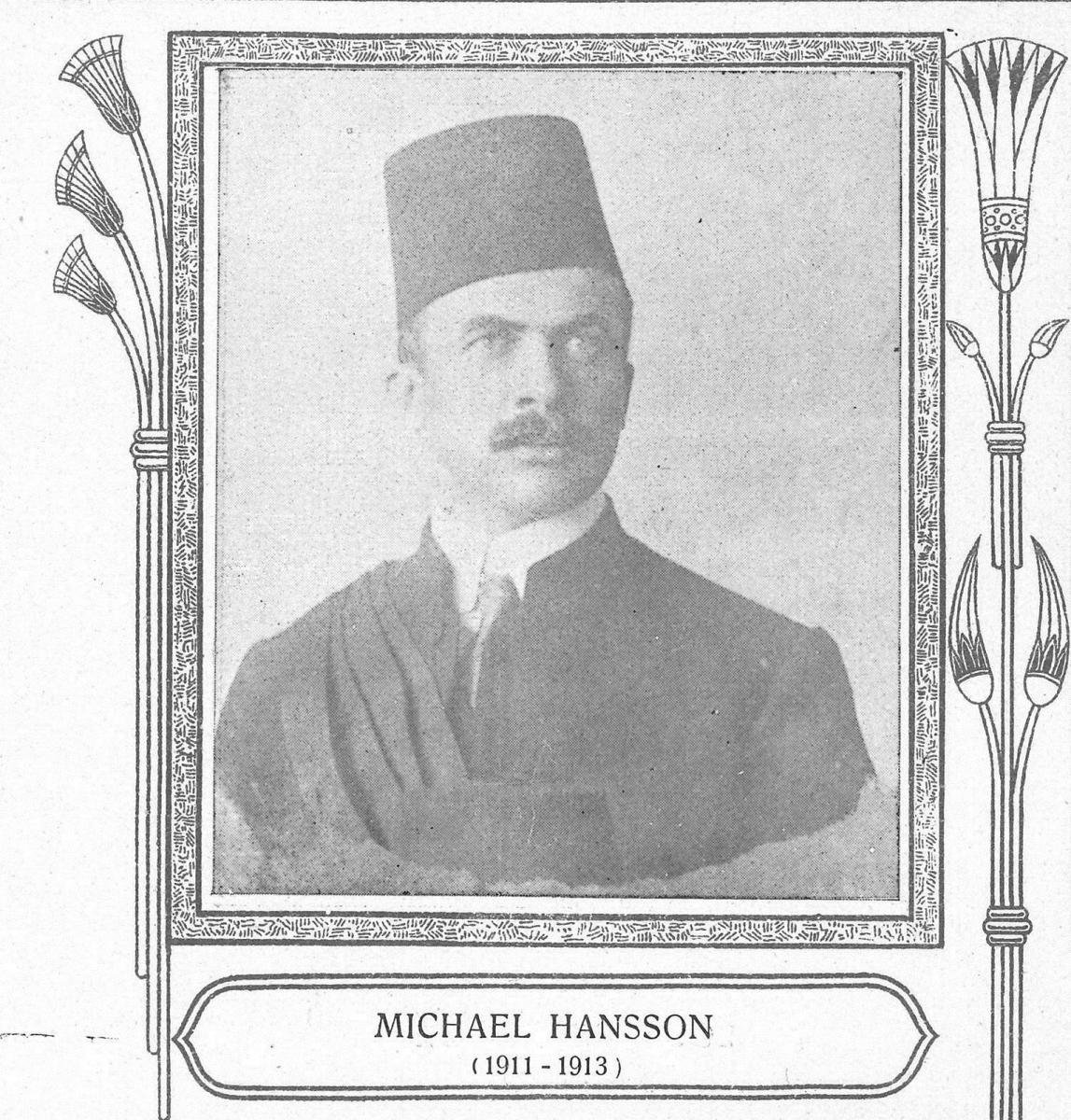
Portrait of Michael Hansson from a section in Les Juridictions Mixtes d'Égypte 1876-1926 volume listing past presidents of the Tribunal of Mansourah (pg. 50). The dates 1911-1913 identify his term as President of the District Court of Mansourah. The pleats in the sash in this image show that this was a feature of the District Courts sash as well, an aspect not always visible in other images of the Mixed District Court judges.

Hansson also is illustrated in the above photo from pg. 190 of the Les Juridictions Mixtes d'Égypte 1876-1926 volume with the Tribunal in Mansourah in 1907, with all judges wearing their Court attire. Hansson is the 4th judge from the L in the back row. A much younger Mahmoud El Toayar Bey (thinner & with much more robust mustaches, compared with the 3rd and 4th photos in my post on this thread of 1 April, 2019, that I believe help identify him as the unnamed judge in the first 2 photos in that post) is standing next to him (identified as the Substitut du Procureur Général), the 3rd judge from the L in the back row. Mahmoud El Toayar Bey would have been at least 15 years younger in this image than the studio portraits I believe show him near the time of his initial appointment to the Court of Appeals (1922) and almost 19 years younger than the photos from the Les Juridictions Mixtes d'Égypte 1876-1926 volume identifying him in the assembly and in court that I posted on 1 April. This image can be zoomed for greater detail. When enlarged, this photo shows nicely the single color of the judges sashes (red) and the contrasting gold & silver coloration of the District Court badges. The other individuals are: Front row L-R: Youssouf Soliman Bey (Egypt); Anastase N. Stoupis (Greece); Luis Comulada (President, Spain); Boutros Youssef Bey (Egypt); Ovidio de Cergueira-Borges Cabral d’Alpoïm (Portugal). Back row L-R: an unnamed Egyptian guard; Moustapha Fathy Bey (Egypt); Axel Johan Patrick Adlercreutz (Sweden); Mahmoud El Toayar Bey (Egypt); Michael Hansson (Norway); Hussein Kamel Sourour Bey (substitute for the Procureur Général, Egypt); and an unnamed Egyptian guard.
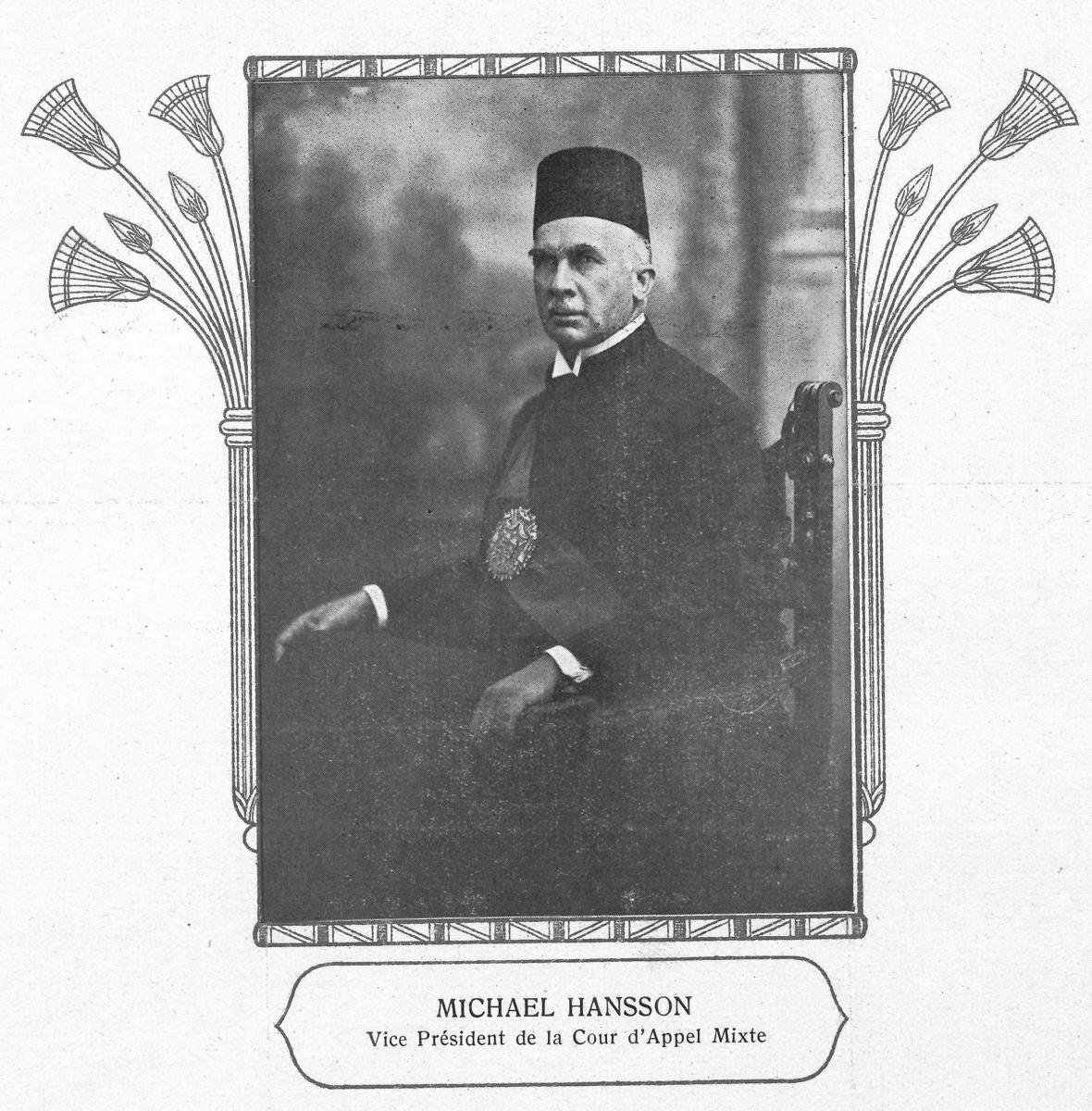
Portrait from the front matter of the Les Juridictions Mixtes d'Égypte 1876-1926 volume listing current high officers of the Mixed Courts (pg. 12). As Vice-President of the Court of Appeals, Hansson’s sash in this image should be green. It is a bit unclear whether he also would is wearing the gold badge of the Appeals Court, rather than what should have been the gold and silver badge of the District Courts. However, when enlarged this photo appears to show a badge of a single hue, lacking contrasting dark and lighter areas such as are visible as in the previous image of the badges worn by the Mansourah Court judges in 1907.
Joseph Timmermans (born=?/d. 1897) On 31 October, 2018 I illustrated a Mixed Courts judicial badge that was from a September, 2014 auction by Jean Elsen & ses Fils archived on the acsearch.info website (https://www.acsearch.info/search.html?id=3990624). This badge was identified as having been used in the Courts of Alexandria and belonging to Joseph Timmermans who was correctly identified in the auction information as a Belgian who served as the Procureur Général prés les Juridictions mixtes á Alexandrie. Another part of the auction description gave his name as “Jules” Timmermans. His name is correctly Joseph Timmermans. He is identified in the Les Juridictions Mixtes d'Égypte 1876-1926 volume’s appendix listing of personnel on the District Courts (pg. IX) as Belgian, appointed as a judge to the District Court in Alexandria in April 1883, as a past Procureur Général prés les Jurisdictions Mixtes in June 1892, and in February 1894 was re-appointed as Judge in Alexandria. He died in Alexandria on 10 February, 1897. On pg XXII (in the listing for personnel of the Parquet) Timmermans’ entry confirms his positions as a former judge of the Mixed Tribunal of Alexandria, his appointment as Procurer Général starting in June, 1892, and resumption of his position as a judge on the Mixed District Court in Alexandira in February, 1894. In the Parquet listing on pg. XXII he also is identified as a recipient of the Order of Osmanieh, 3rdClass.
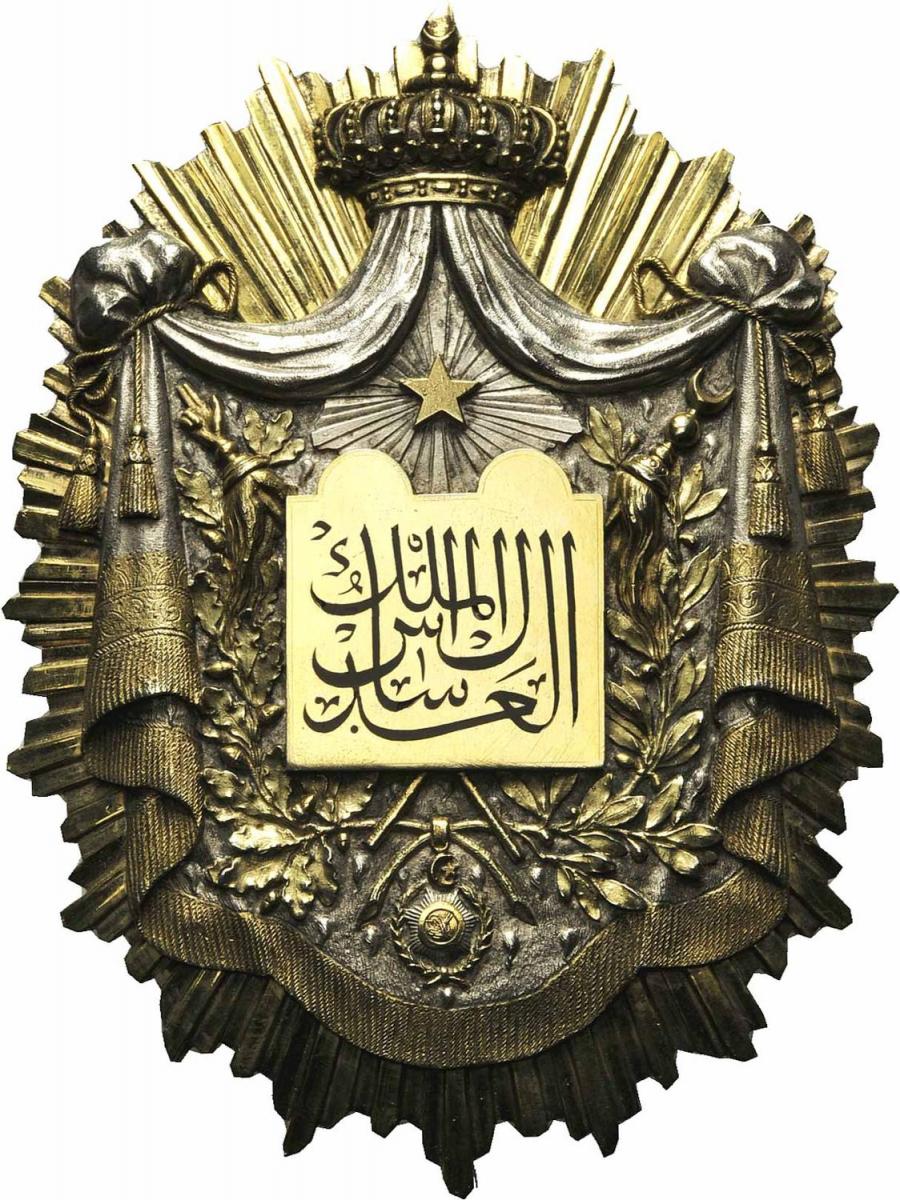
The gold & silver District Court badge made by Froment-Meurice from the Jean Elsen & ses Fils auction of September 2014 attributed to Joseph Timmermans. The auction lot also included the award letter of Timmermans’ 3rd Class Order of Osmanieh, dated 16 March, 1893, apparently with a hand-written translation by the Khedive Abbas Hilmi II. In my post of 31 October, 2018 I was curious whether the appropriate badge for a Procureur Général associated with the office of the Parquet, should have been a silver badge. This question is resolved, at least partially, by the fact that Timmermans spent a significant amount of his career serving on the District Court of Alexandria. He would have appropriately been issued the gold & silver District Court badge for his initial appointment to the court in Alexandria, and may have used it (or another?) for his final 3 years on the District Court in Alexandria. Whether he retained this gold & silver badge during his time serving as Procurer, or whether he would have been issued another different badge (all silver) is still unclear to me, but perhaps the role of Procureur associated with bringing cases before the District Courts might have arrayed him in the regalia of the District Courts (gold and silver badge, but what color sash?)
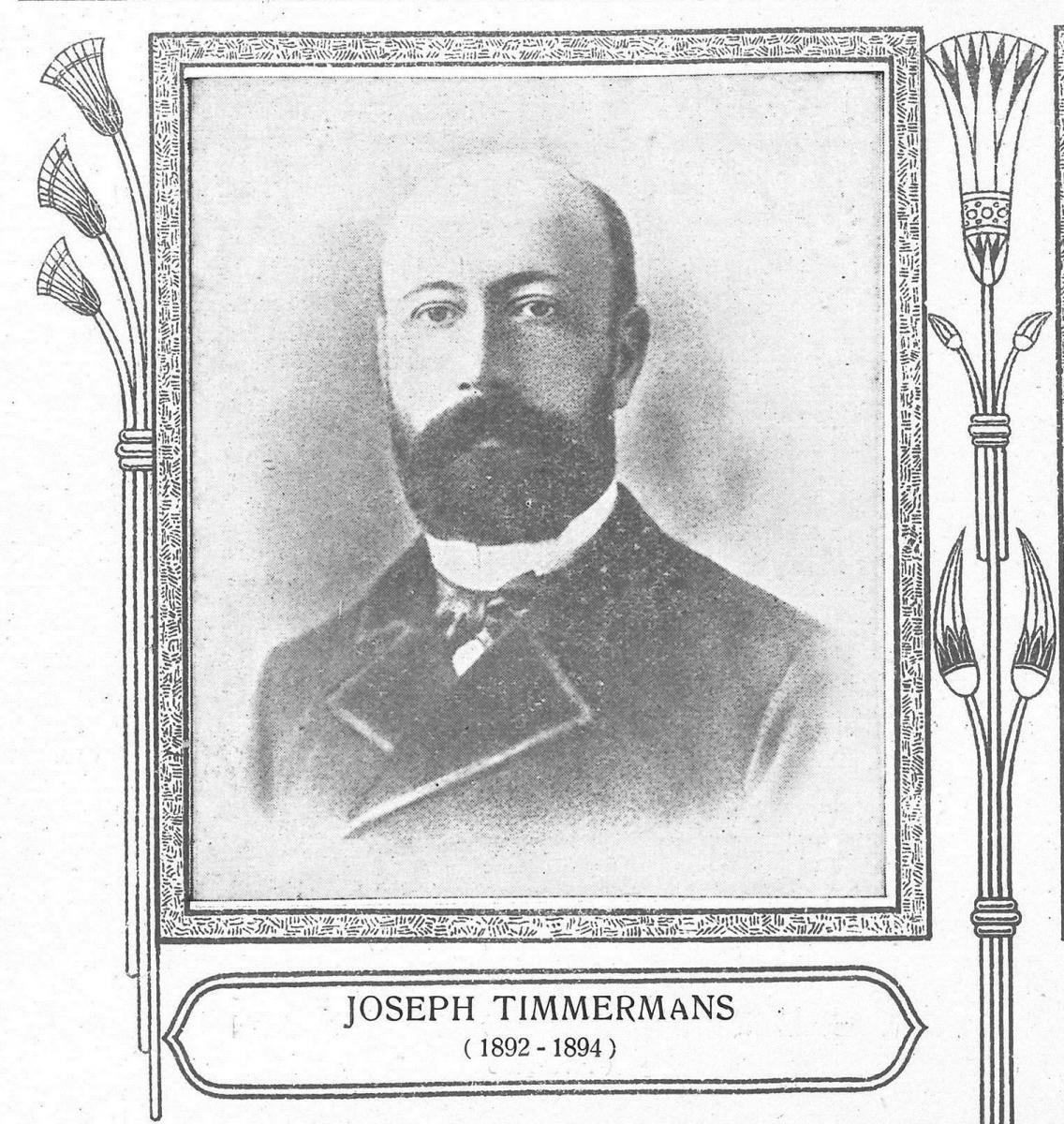
Portrait from the Les Juridictions Mixtes d'Égypte 1876-1926 volume identifying past Procureur Généraux of the Mixed Courts (pg. 42). The dates 1892-1894 are those of his service as a prosecutor.
Carl Valdemar Kraft (1849-1924) In the 2nd photo of my post of 5 March, 2019 I included a postcard image of the Danish Judge Carl Valdemar Kraft. Additional images and a small amount of information about him also are available in the Les Juridictions Mixtes d'Égypte 1876-1926 volume. Kraft is identified as having been named to the District Court in Mansourah in January, 1896. He was transferred to District Court of Cairo in June of 1901. He reached the age of majority for court service in 1920. He was awarded the Grand Officer Class of the Order of the Nile (pg. X).
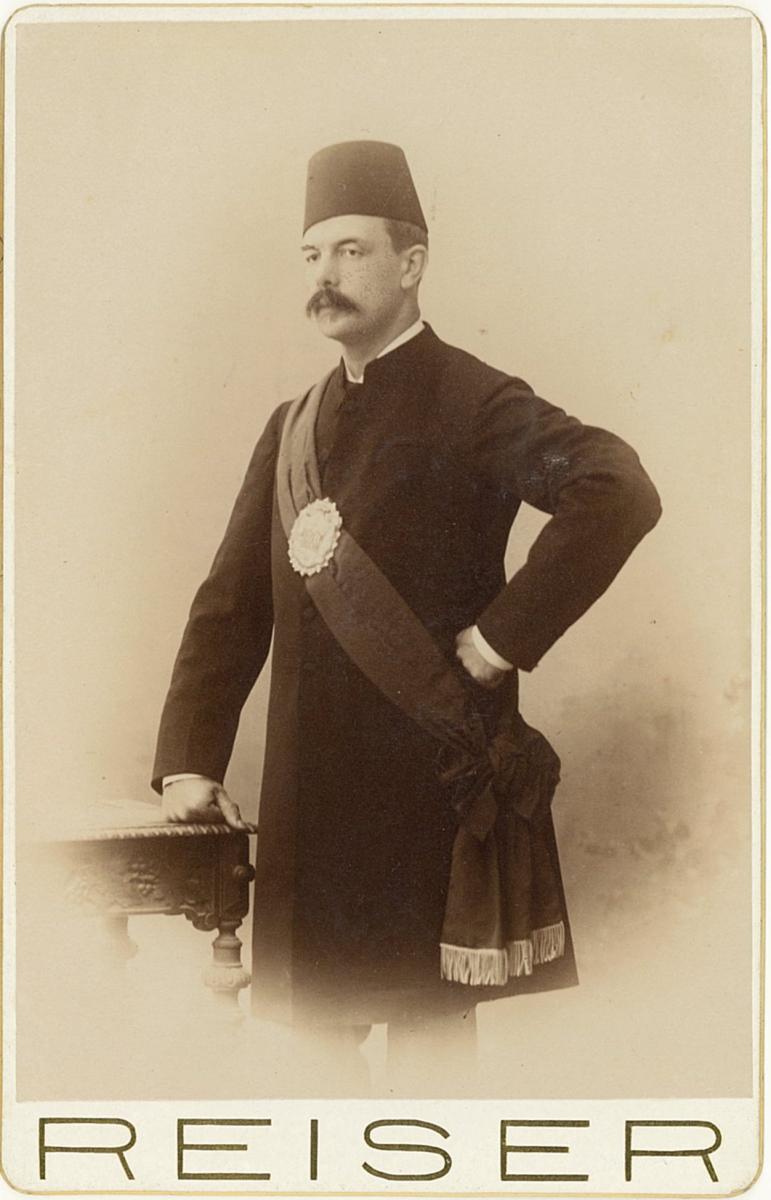
Postcard portrait of Carl Valedemar Kraft found tucked into a copy of Michael Hansson’s: 25 år i Egypt, 1946. Forlagt Av. H. Aschehoug & Co., (W. Nygaard), Oslo that was owned by Rudolph Kraft (a brother of Carl Valdemar Kraft), that has Rudolph Kraft's name inside the front cover, dated 1948. See my post of 5 March that provides bracketing dates for why this portrait probably was made between Kraft's initial appointment in Mansourah in 1896 and 1914 when Atelier Reiser was relocated to Munich, either just before or after WWI broke out. This portrait was made in Reiser's studio in Alexandria (another was located in Cairo).
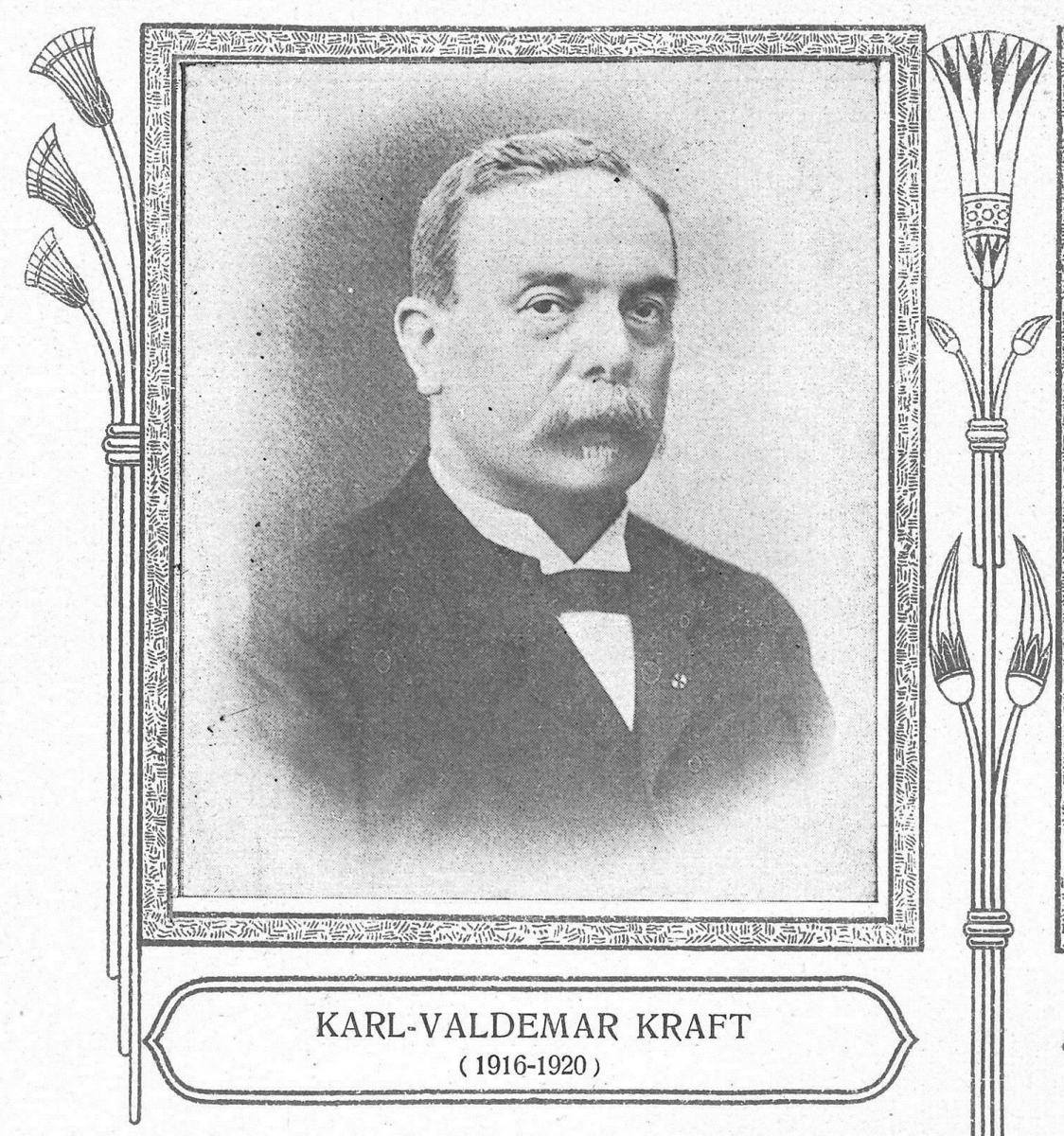
Portrait of Carl Valdemar Kraft from the section of the Les Juridictions Mixtes d'Égypte 1876-1926 volume identifying past Presidents of the Mixed Tribunals of Cairo (pg. 48). The dates 1916-1920 are the period of his tenure as President of the District Court of Cairo. The Les Juridictions Mixtes d'Égypte 1876-1926 volume spells his name “Karl”, which appears to be incorrect. All other sources I have located spell his name “Carl”, including hand-written information on the back of the Reiser postcard portrait of Kraft (shown above) in the handwriting of his brother Rudolph Kraft. The Les Juridictions Mixtes d'Égypte 1876-1926 volume does have some discrepancies in the spelling of Egyptian and foreign names between the legends on portraits, group photos of courts and functionaries, and the listing of career highlights in the appendices. I have used the spellings in the appendices, as they provide the full names of individuals who often are listed by the letter of their first names and surnames, surnames only (almost exclusively for foreign personnel only), partial honorific, or with alternative spellings to those in some of the figure captions.

Carl Valdemar Kraft is shown in the above group photo in the Les Juridictions Mixtes d'Égypte 1876-1926 volume (pg. 189) of the Cairo Tribunal in 1909, seated second from L in the first row. This image can be zoomed for better details. The other individuals in the photo are, front row L–R: Mohamed Sadek Bey (Egypt); Carl Valedemar Kraft (Denmark); Dr. Frédéric Herzbruck (President, Germany); Diderik-Galtrup-Gjedde Nyholm (Denmark); and Achille Adolph Eeman (Belgium). 2nd row L-R: Herbert Welk Halton (Britain); Youssouf Aziz Bey (Egypt); Cornelis Bernardus Johannes Aloysius Wierdels (Netherlands); Walter Van Renssalaer Berry (USA); Francis Laloë (France); and Julius Cornélis Théodorus Heyligers (Netherlands). Back row L-R: Luis Comulada (Spain); Mohammed El Naggari Bey (Egypt); Fuad Gress Bey (Egypt); and Ahmed Raguib Badre Bey (Egypt).
2 -
Below is a cased example of the 3rd Class, Commander, Order of Ismail from Lot 1027 in an April, 2019 auction on Very Important Lot (https://veryimportantlot.com/en/lot/view/egypt-ismail-order-nischan-al-ismail-3-class-175085). This example is made by Lattes of Cairo. The dimensions of this example are given as 83 mm high X 61 mm wide, and it weighs 49.0 g. The description identifies this piece as 750 gold, correctly as 14 k gold. These are not high resolution images, but they confirm the hallmark placements on the Lattes-made Order of Ismail as seen in other examples I have illustrated on this thread.
Obverse of this Commander Class Order of Ismail in its case.
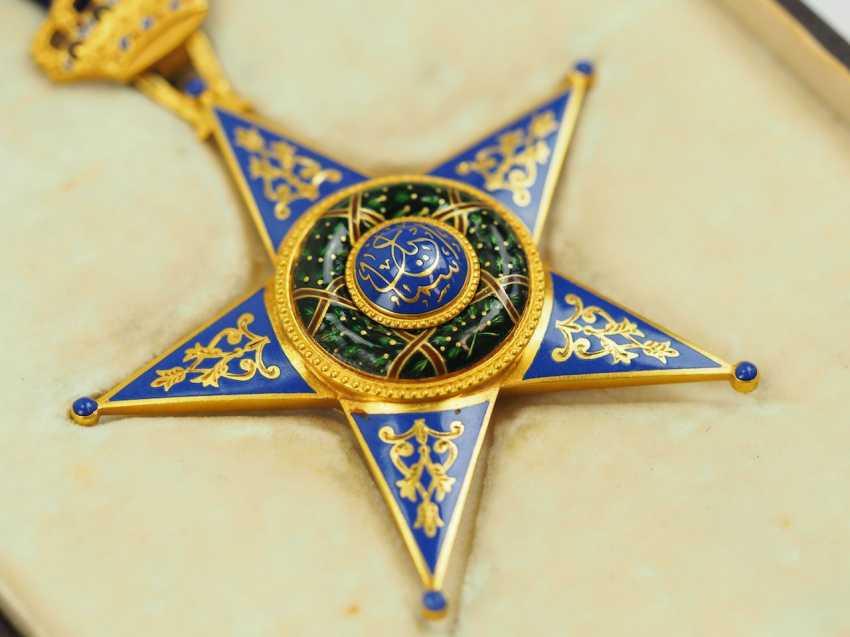
Oblique view of the obverse of this 3rd Class Order of Ismail in its case.
Reverse of this 3rd Class Order of Ismail showing the full set of 3 hallmarks on the suspension clip to the ribbon, the single hallmark for Cairo manufacture of 18 k gold, and the full set of 3 hallmarks on the reverse boss of the central medallion. The resolution is low, but all appear to match the close-up image of the hallmarks on the suspension clip (shown below).
Detail of the obverse of the crown suspension device, showing the placement of the 3 hallmarks on the right side of the suspension device arm connecting the superior ray of the star with the crown suspension device.
Close-up detail of the reverse of the crown suspension and suspension clip showing the only good resolution image of the hallmarks on this example of a Commander Class of the Order off Ismail. The 3 hallmarks on the suspension clip indicate the Cairo assay office identification of 18 k gold, the ibis for Egyptian manufacture, and the letter "A" indicating manufacture in 1925-1926. The single hallmark on the reverse the crown device shows the Cairo assay office designation of 18 k gold.
Inside of the superior lid of the case associated with this Commander Class Order of Ismail showing the inscriptions.
View of the exterior upper lid of the case for this Order of Ismail.
Lot 1028 from the same April 2019 auction by Very Important Lot also included the example below that is erroneously listed as a miniature of the Order of Ismail (https://veryimportantlot.com/en/lot/view/egypt-ismail-order-nischan-al-ismail-and-the-m-175086). This is the same design as an item from a December 2017 auction by Spink & Son, archived on the Salesroom website (https://www.the-saleroom.com/en-us/auction-catalogues/spink/catalogue-id-srspi10156/lot-bd1c4e4c-7dc1-4560-a3c7-a83200ba36e7) that I previously illustrated in the 2nd photo of my first post on 6 December, 2017 on this thread (also identified by Spink & Son as a miniature of the Order of Ismail). Owain identified this as the Order of the Star of Ethiopia in his post here of 6 December, 2017. See his comments in that post on the poor workmanship of this particular design (probably the same Spink & Son example).
Obverse of this Order of the Star of Ethiopia that is misidentified in the Lot 1028 description on the Very Important Lot website as a miniature of the Order of Ismail. The ribbon is that for the Order of Ismail, rather than the red, yellow, & green appropriate for this Ethiopian medal. There are several significant similarities in this example to the one I illustrated on 6 December 2017 indicating it is probably the same piece from the Spink & Son December, 2017 auction. That auction description by Spink & Son identified what may be this exact piece as 25 mm high including the crown suspension X 16 mm wide.
Reverse of this same Order of the Star of Ethiopia misidentified as a miniature Order of Ismail on the Very Important Lot auction site for Lot 1028. The description states that the silver purity mark on the reverse reads "935", however, it is probably "925", as identified in the Spink & Son auction description.
0 -
Wow, what a fun assortment of chamberlain's pins! Of course, I also appreciate your putting a photo in with a silver Parquet version of the Mixed Courts judicial badge. This appears to be the same judicial badge that Mohamed Eissa illustrates in an artsy photo from Abdine Palace on his flickr site (https://www.flickr.com/photos/eissaphotos/3396138687/in/pool-egyptianroyalty/). Many thanks Owain.
Below are a few images of chamberlains wearing these pins. Unfortunately none of the images provide any details of the pins, and they can only be recognized by their position and shape. Most of these images can be zoomed for at least some additional detail.
Above is an undated photo of Queen Farida visiting the National Library. To the viewer's R is a Chamberlain wearing the chamberlain's pin on his R lapel. The Chamberlain looks a lot like an older Ismail Teymour Pasha. (From: https://www.flickr.com/photos/kelisli/1002210535/in/photostream)
This scene is at the at the foot of the Tashrifah staircase, the 2 chamberlains on the far right are Said Zulificar Pasha (Grand Chamberlain) at the far R, and Ahmed Hassanein Pasha (Premier Chamberlaisn) just to the viewer's left of the Grand Chamberlain. Both can be seen wearing the chamberlains' pins on their R lapels. (From: https://www.flickr.com/photos/12889139@N08/3010690482/in/photostream/)
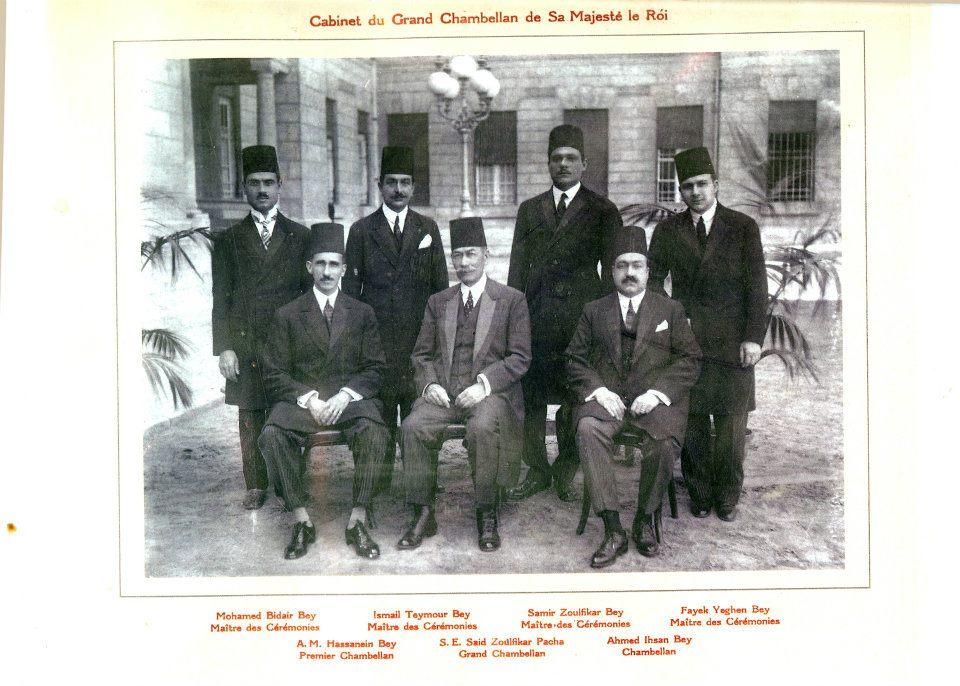
King Farouk I's Grand Chamberlain's Cabinet in the 1920s. This image can be zoomed to making reading the names & titles easier. (From: https://www.flickr.com/photos/kelisli/8155481320, courtesy of Mrs. Dahlia Zulfikar)
A higher resolution image of the same Grand Chamberlain's Cabinet of King Farouk I, but lacking the identifications of all the individuals as in the above, lower-resolution image. (From: ttps://www.flickr.com/photos/kelisli/2819700285/in/photostream, courtesy of Ms. Maha Mahmoud)
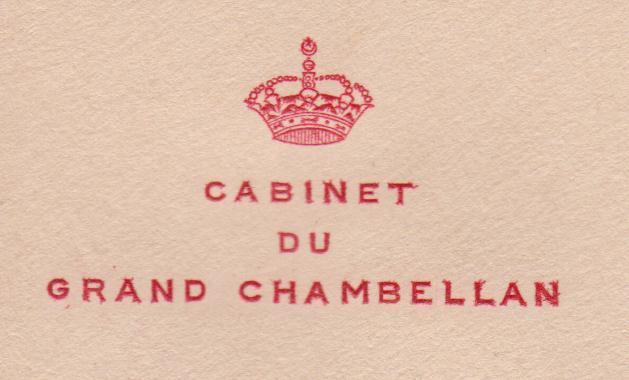
Letterhead for the Cabinet of the Grand Chamberlain (From: https://www.flickr.com/photos/kelisli/9011781015/in/pool-egyptianroyalty/)
A group of Court Officials during King Farouk I's reign wearing what appear to be chamberlain's pins on their R lapels. (From: https://www.flickr.com/photos/kelisli/8395692018/in/pool-egyptianroyalty/, courtesy of Mr. Aly Zulfikar)
To get back to the Order of Ismail, below are 2 images of named individuals wearing the Order of Ismail, a couple photographs of King Farouk I's personal regalia of the Grand Cordon Order of Ismail, and a photo of an individual wearing the Order of Ismail at a royal banquet whose name is given in an Arabic label above him.
A photo from King Farouk I's 18th birthday celebration in 1938. From L to R are: Princess Nimatalla Mukhtar (1876–1945), Farouk's paternal aunt; King Farouk I wearing the Collar, sash, and breast star (visible in other photos from this celebration) of the Order of Mohamed Ali; Queen Farida (1921-1988) wearing the Grand Cordon sash and badge of the Order of el-Kamal in brilliants; Sultana Melek (1869–1956), widow of Sultan Hussein Kamel, Farouk's paternal uncle; wearing the Grand Cordon sash and badge of Order of el-Kamal; Prince Soliman Daoud wearing the breast star of the Order of Ismail, possibly with the sash of that Order indicating the Grand Cordon Class. (From: https://www.flickr.com/photos/kelisli/5666876587/).
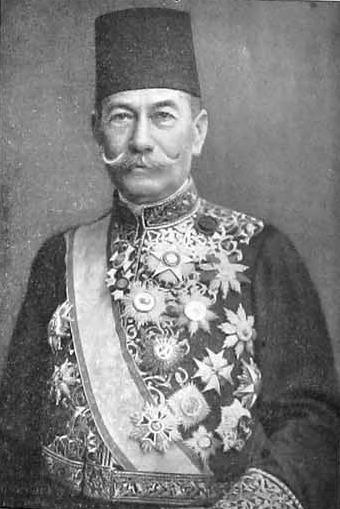
The Grand Chamberlain Said Zulificar Pasha in his Chamberlain's coat wearing the breast star of the Grand Cordon Class of the Order of Ismail in superior position on his right breast, along with his many other awards. This is a cropped image from pg. 206 of The Graphic, November 12, 1930 that features a number of Egyptian "Notables". At the time, Said Zulificar was the Grand Chamberlain to King Fuad I. The Le Mondain Ègyptien: the Egyptian Who's Who: L' Annuaire de l' Elite d' Egypt. F. E. Noury & Fils, le Caire for 1939 identifies the following awards for Said Zulificar Pasha (pg. 388): Grand Cordon of the Order of Mohamed Ali, Grand Cordon of the Order of Ismail, Grand Cordon of the Order of the Nile, Grand Cordon of the Belgian Order of Leopold II, Grand Cordon of the Iranian Order of Homayoun, the 1st Class Syrian Medal of Honor, and the 1st Class Lebanese Medal of Honor and Merit. (cropped from: https://www.flickr.com/photos/kelisli/7762810122/in/pool-egyptianroyalty/)
Photo of the 3 awards belonging to King Farouk I that he probably wore more than any other decorations. Upper L is the sash and sash badge of the Grand Cordon Order of Mohamed Ali, upper R shows detail of some of the Collar of Mohamed Ali, lower R is a piece that was worn inside of the pendant on the Collar of the Order of Mohamed Ali featuring King Farouk I's cypher surmounted by Egypt's royal crown; middle row far L is the breast star of the Grand Cordon Class of the Order of Mohamed Ali; middle center is King Farouk I's breast star of the Grand Cordon Order of Ismail; lower L is the breast star of the Grand Cordon Class of the Order of the Nile. From: : https://www.flickr.com/photos/27031646@N08/2521809470/in/pool-egyptianroyalty/)
A low-resolution photo of King Farouk I's Grand Cordon Order of Ismail breast star (L) and sash badge (R). These are identified as from the Alexandria National Museum. (Cropped from: https://www.flickr.com/photos/36914349@N04/4397389512/in/pool-egyptianroyalty/)
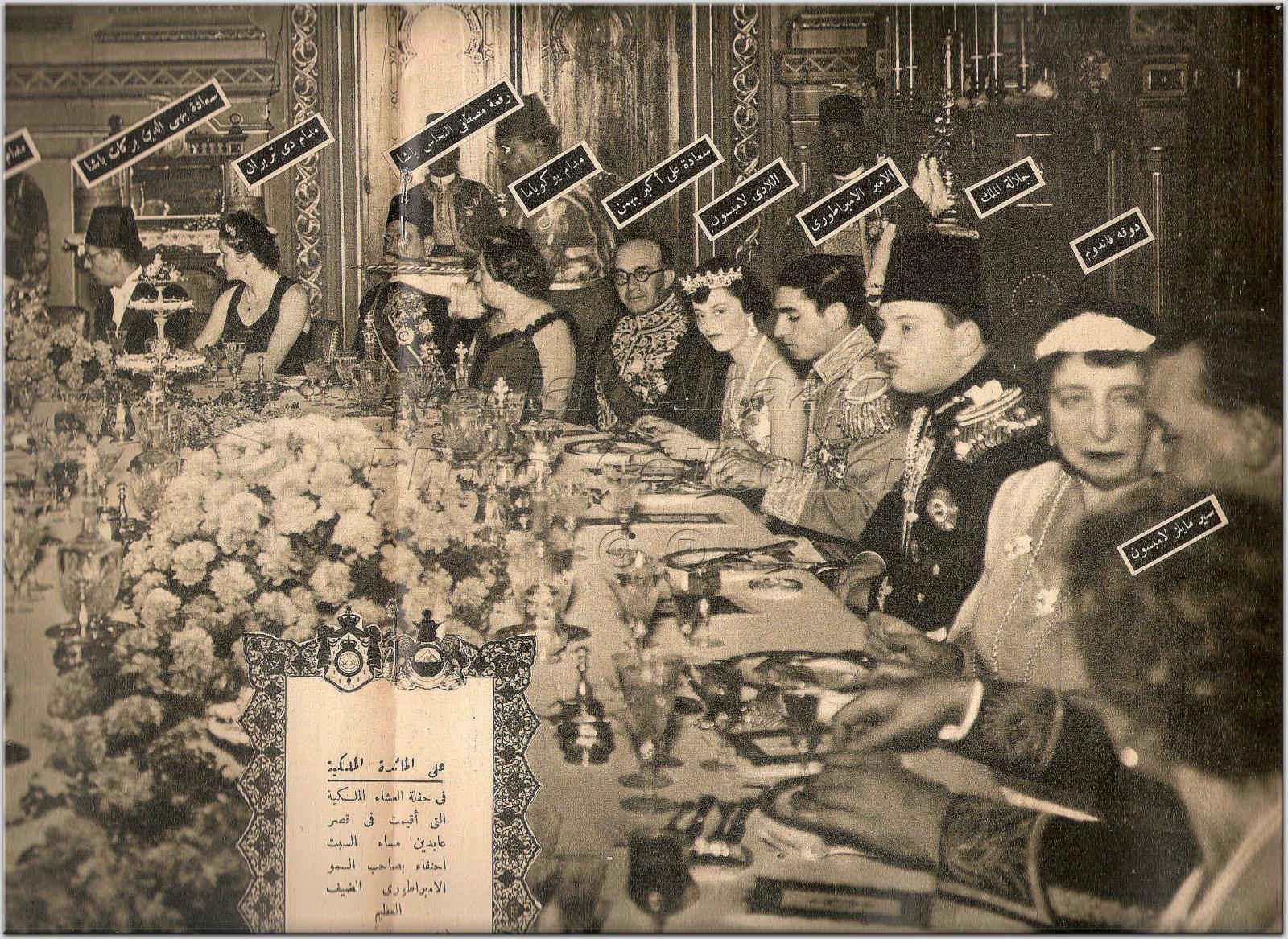
A photo of a Royal Banquet in honor of the Crown Prince Mohammad Reza Pahlavi of Iran (5th from R, next to King Farouk I). The man in round glasses 3rd from King Farouk I's R is wearing a breast star of the Order of Ismail. Perhaps one of the Arab speakers on GMIC could provide the name of this individual by zooming this image. (From: https://www.flickr.com/photos/43829903@N02/4047823450/in/pool-egyptianroyalty/)
0




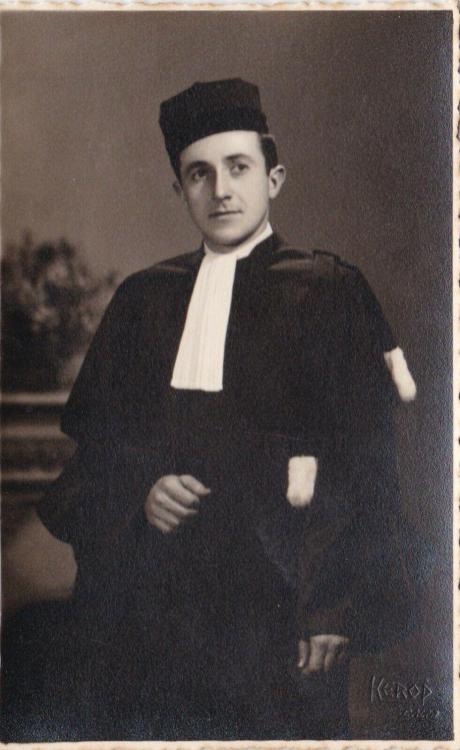
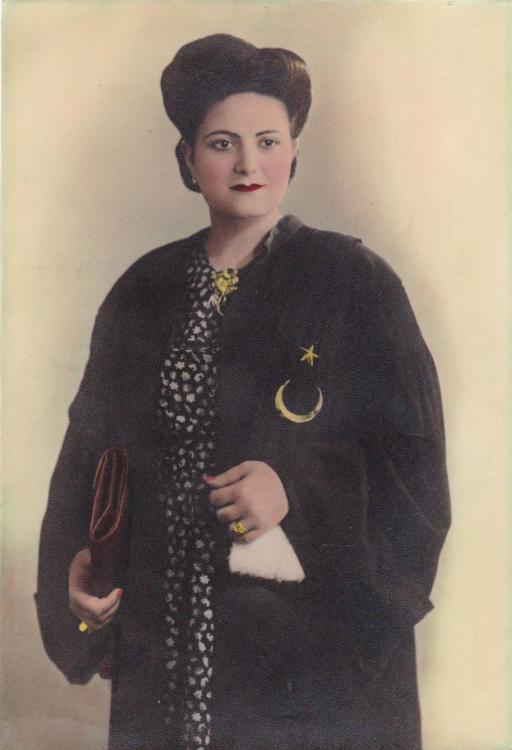
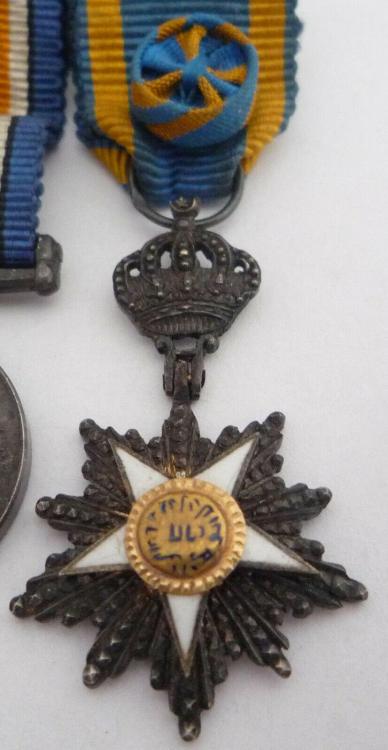

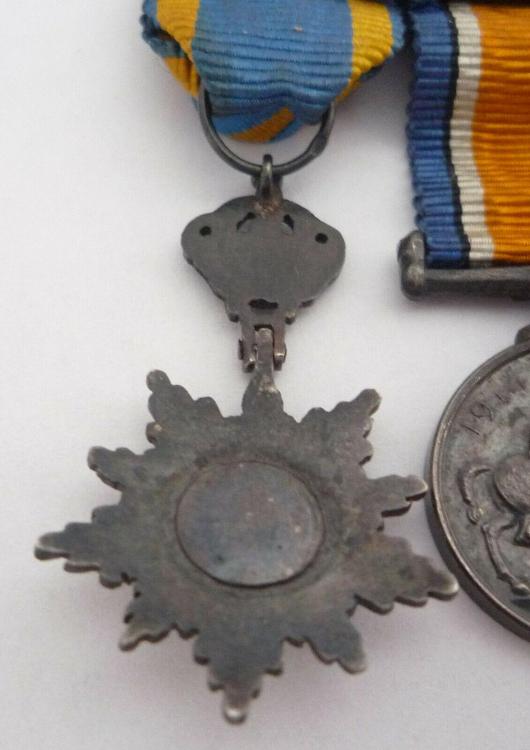
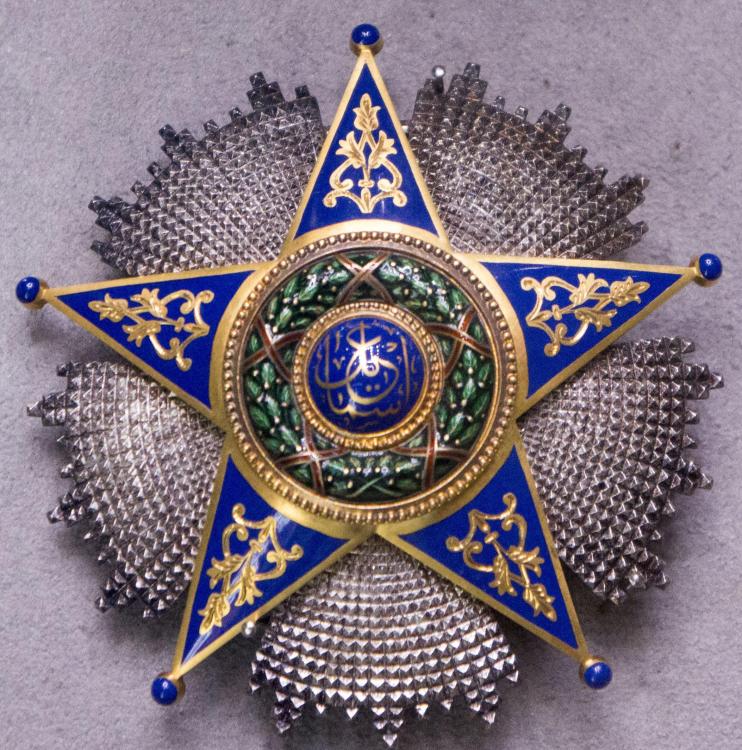

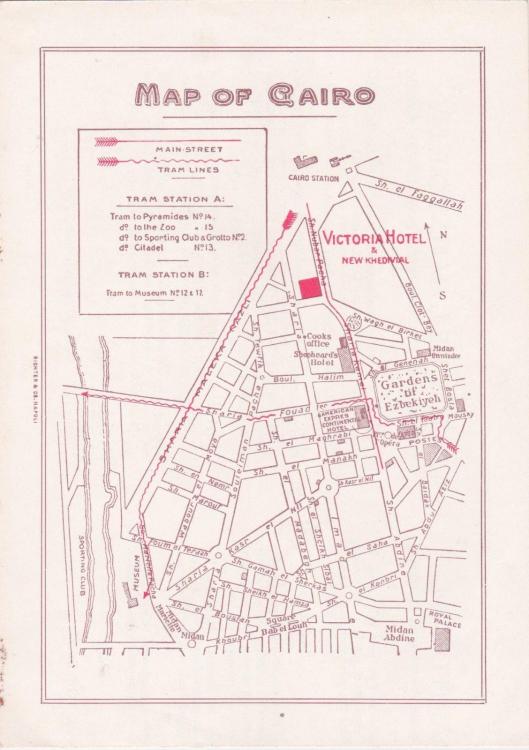

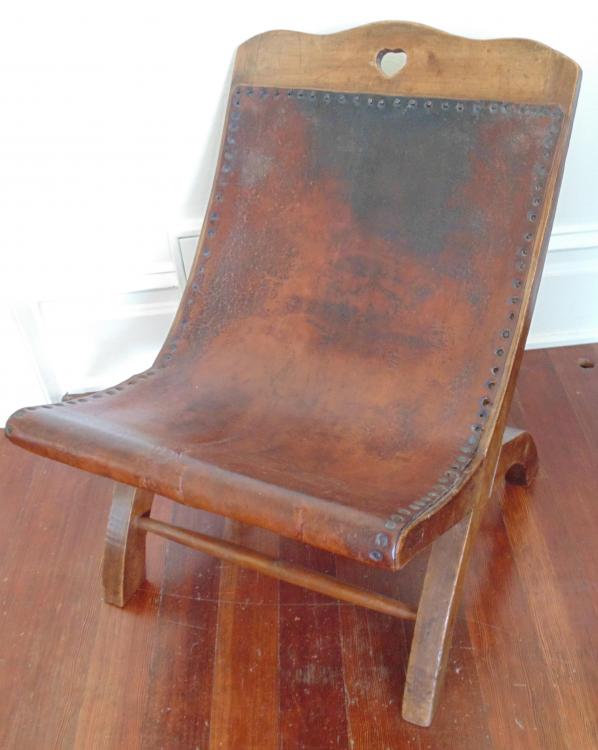
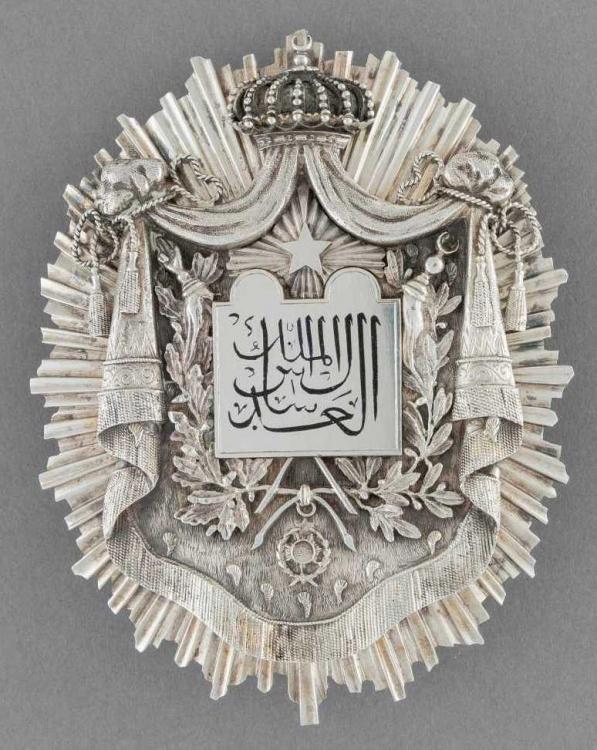

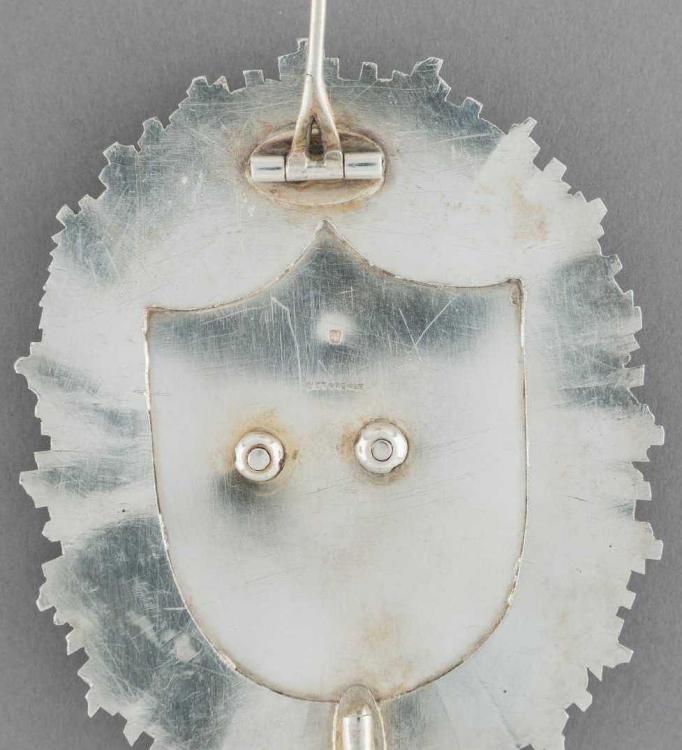
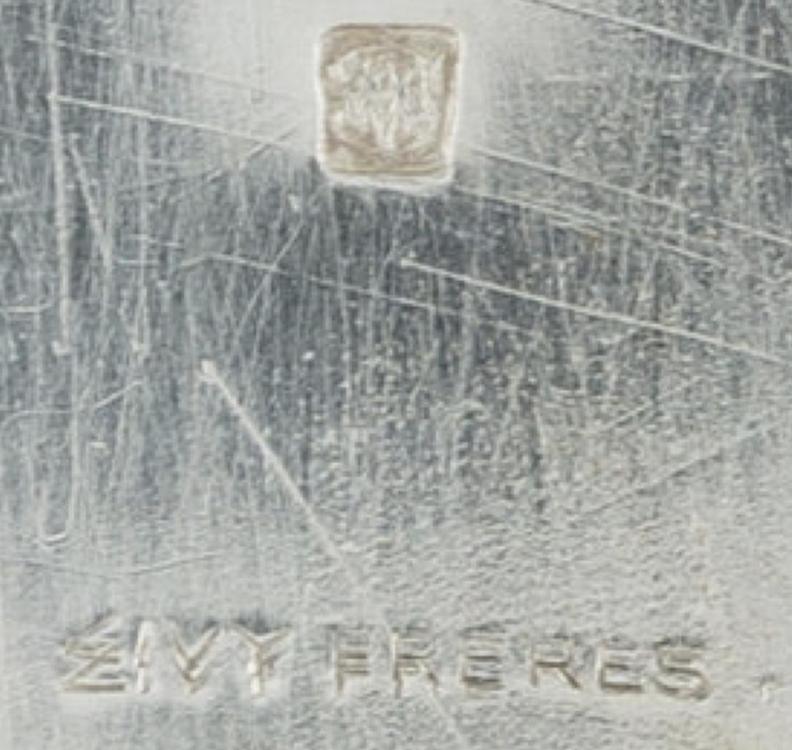
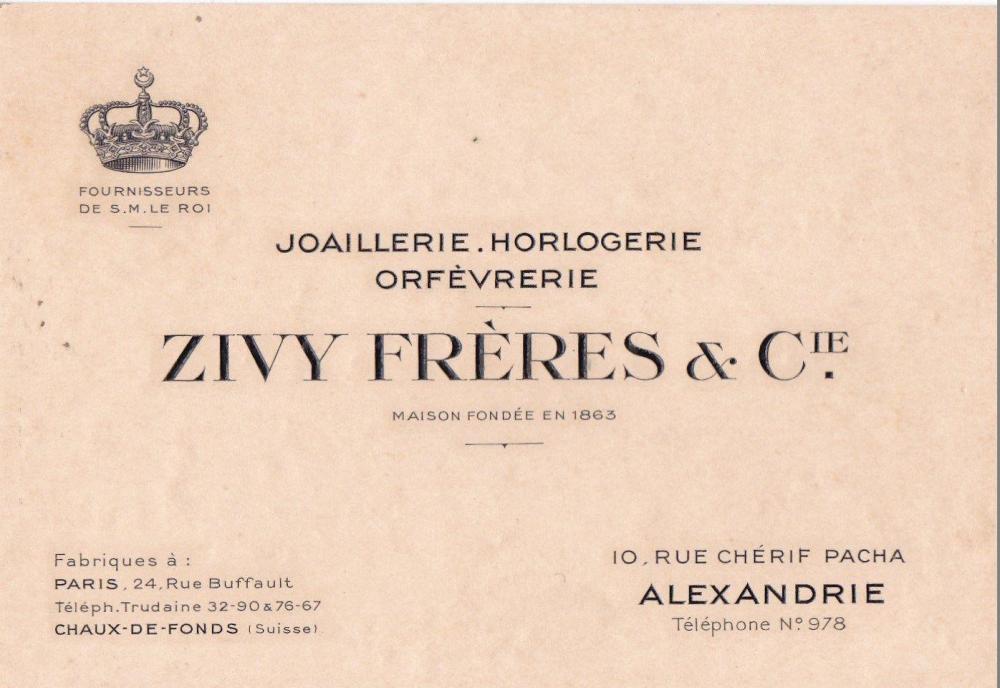
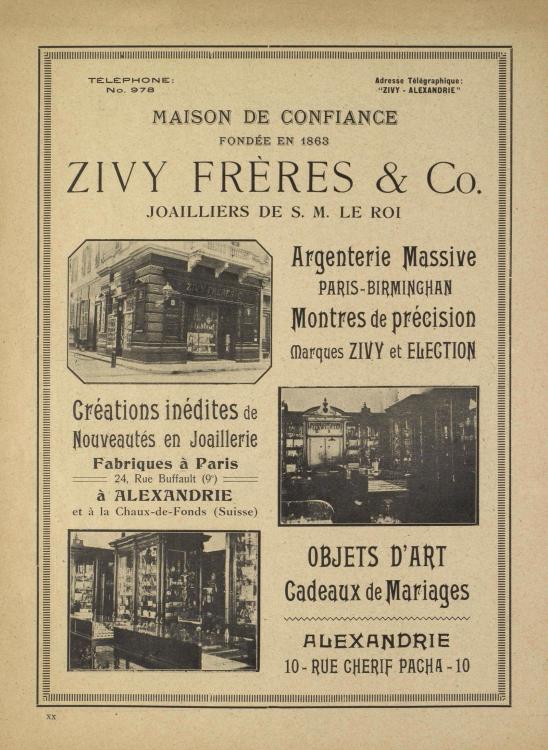
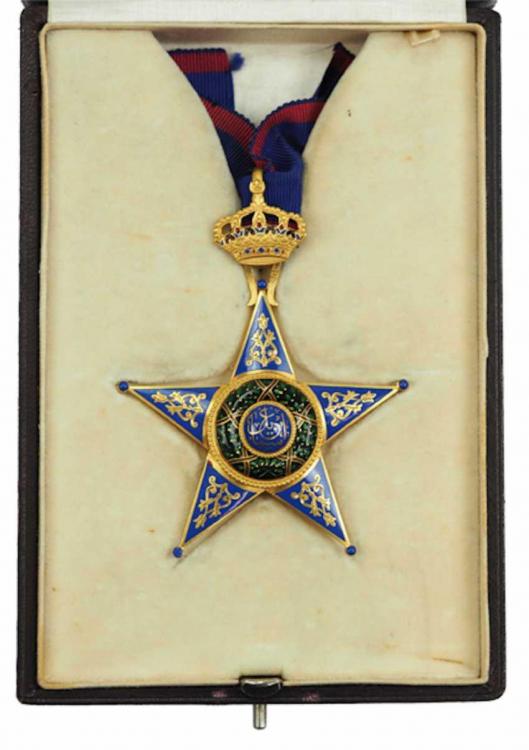


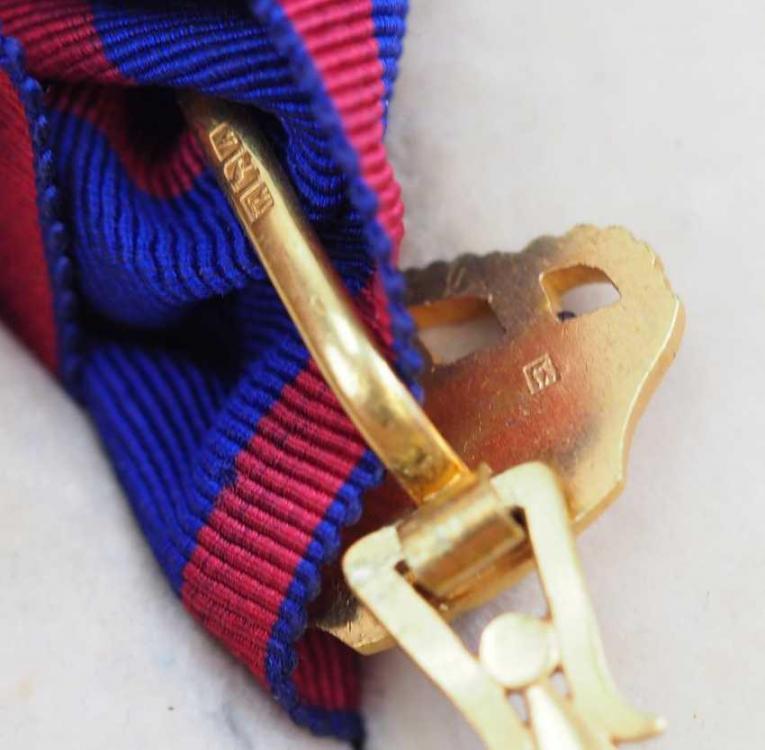
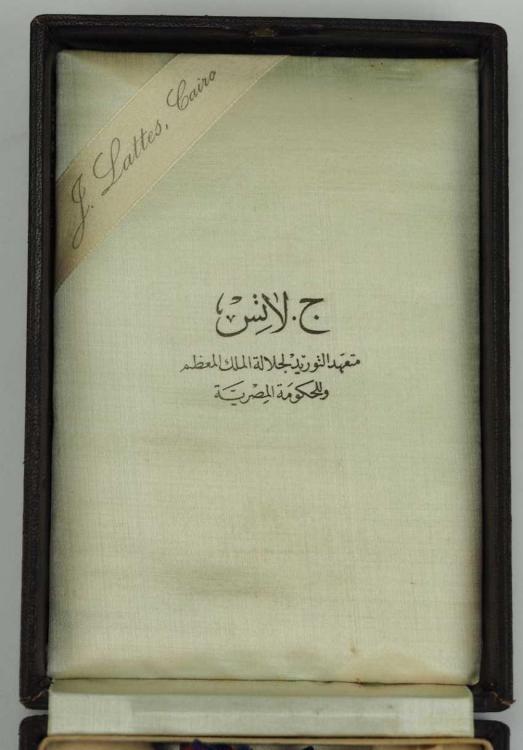
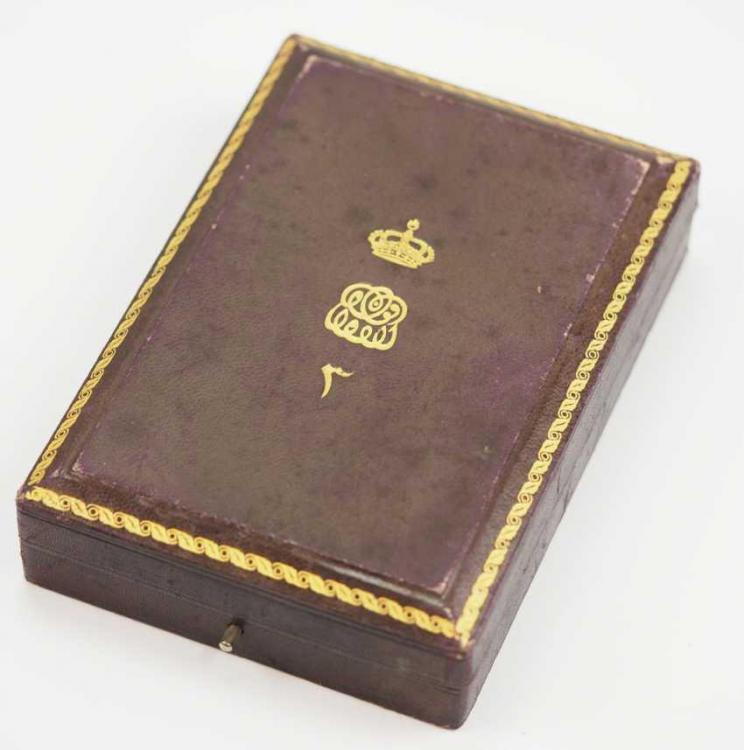
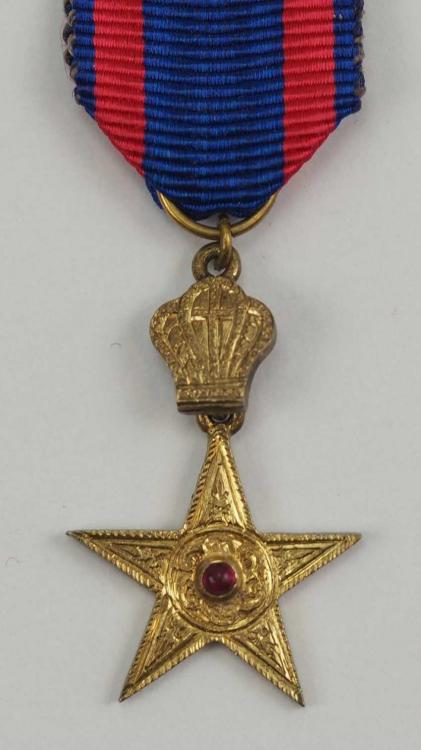
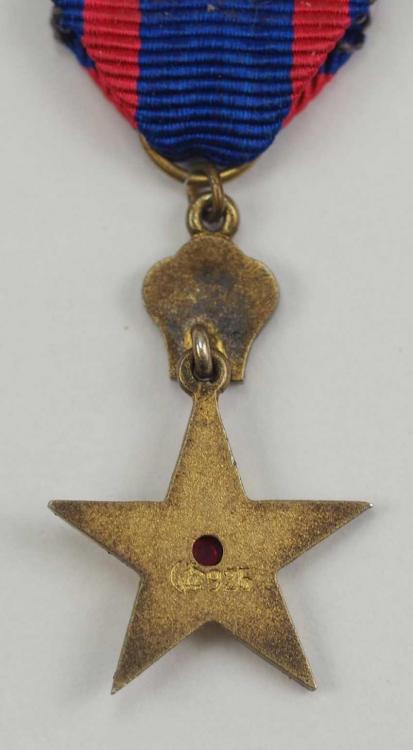
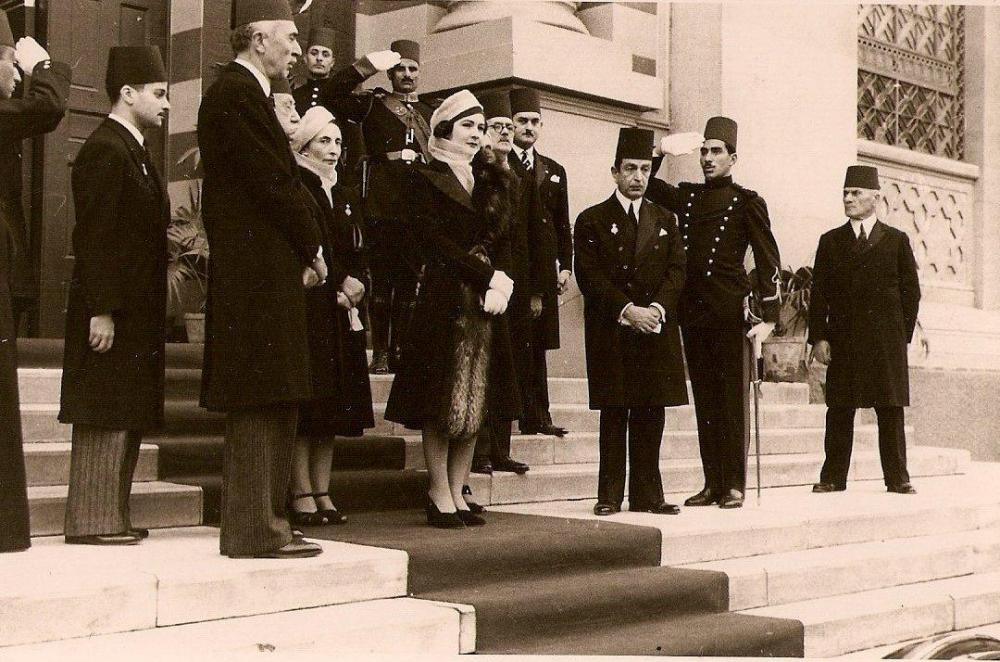
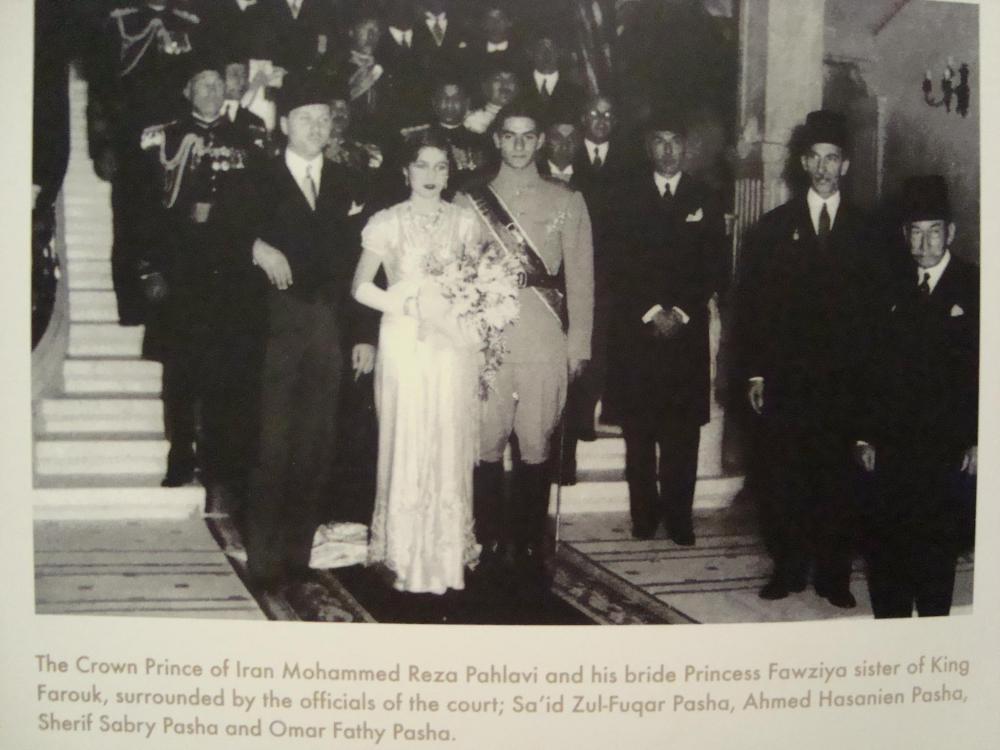
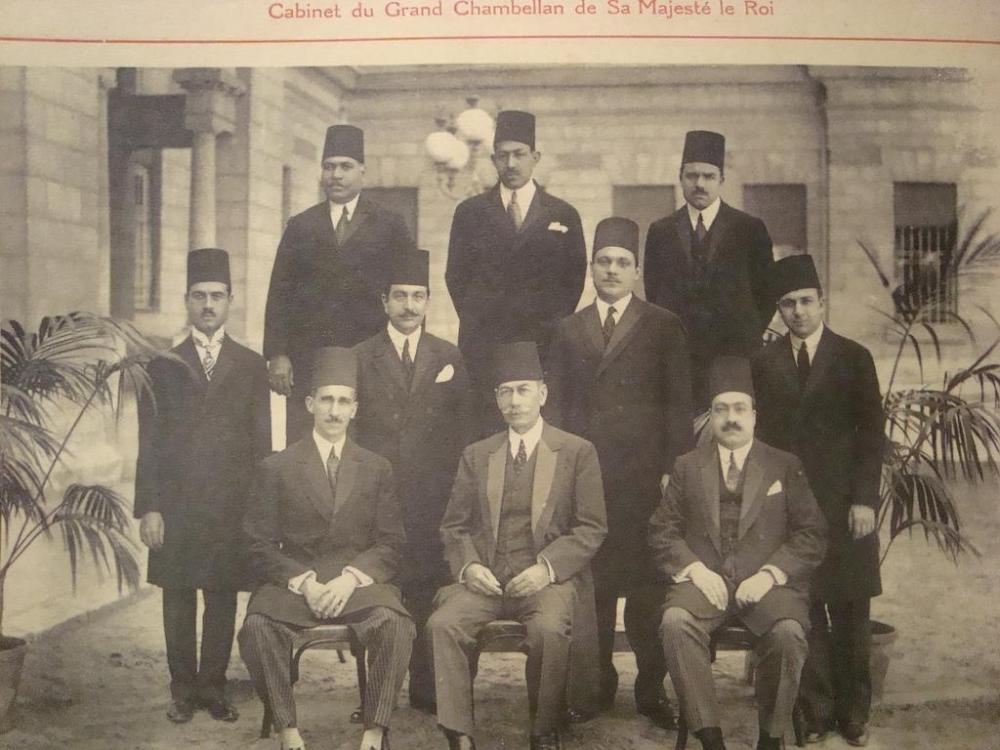

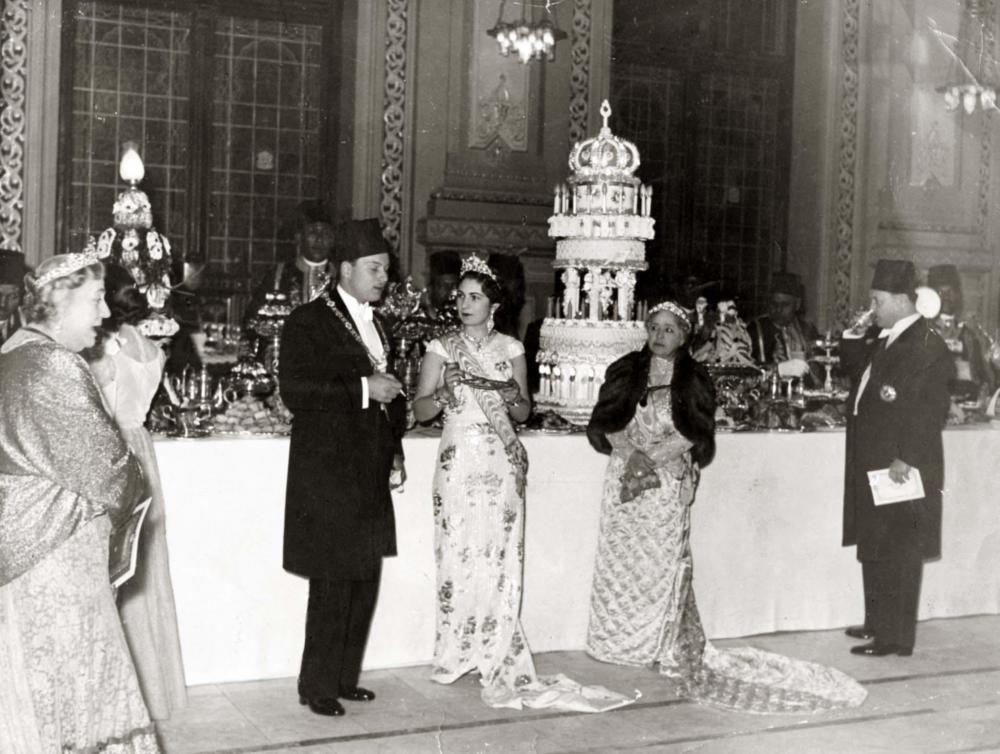
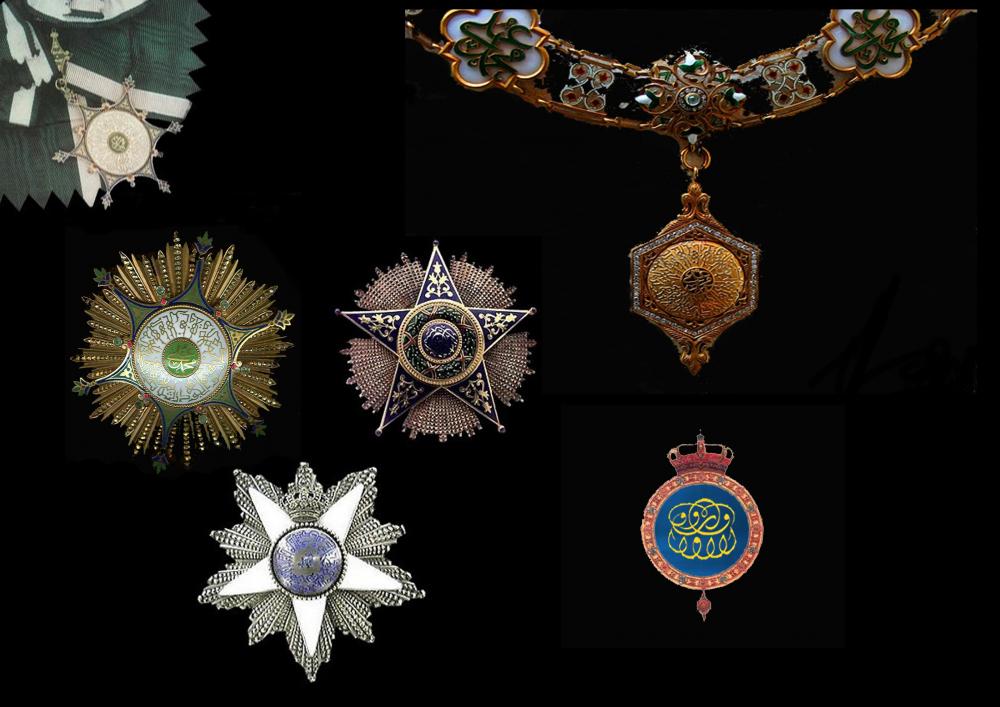
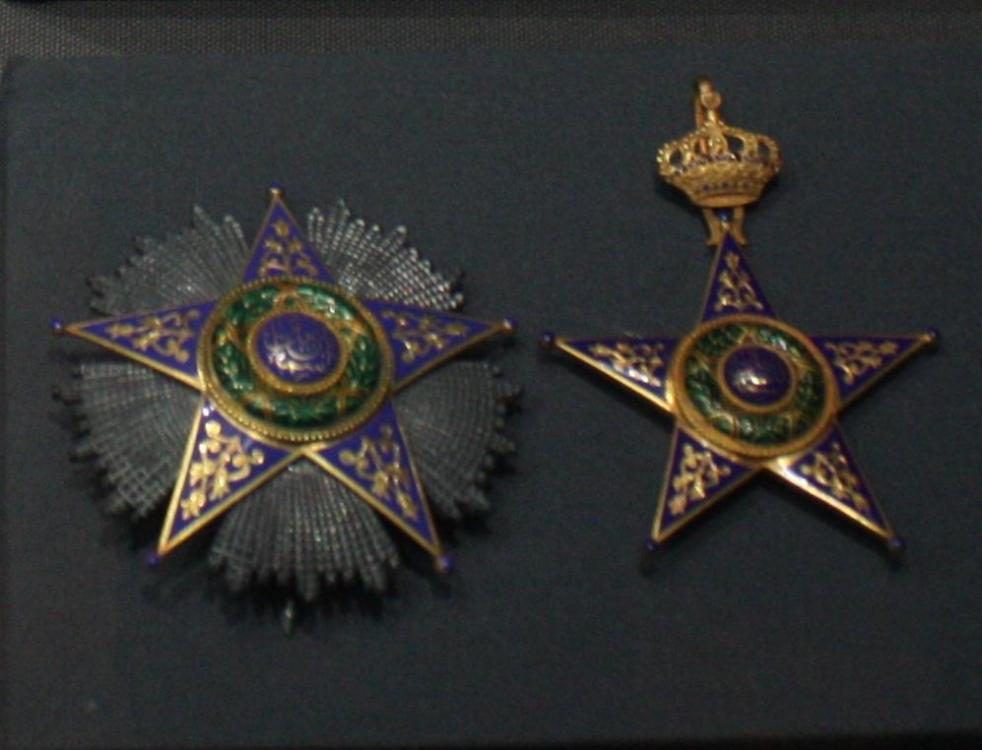
Egypt Khedivate Judge's Badge question
in Middle East & Arab States
Posted · Edited by Rusty Greaves
included additional information on Wolf Horovitz
I want to correct an error I made regarding the hallmark of Stobbe of Alexandria who manufactured some of the Mixed Courts' judicial badges. In my discussion of different hallmarks on these badges on my post of 28 February, 2019 I identified the Stobbe hallmark as including the word "ALEXANDRIE". The French spelling is incorrect for this hallmark, it is actually "ALEXANDRIA" on the 2 examples where I have been able to find photographs of these hallmarks.
Above is the Stobbe hallmark on a gold and silver District Courts badge from a Baldwins’ auction of December 2014 (lot 844) archived on The Saleroom.com website that I have illustrated the obverse side of in past posts on this thread. I have previously illustrated the obverse and reverse of this badge in the first photo of my initial post starting this thread on 17 November, 2016, in the 6th photo of post of March 24, 2017, and in my correction of misidentifying this badge as an Appeals Court badge form on my post of April 4, 2017. Although obscured by the tunic pin, it appears in this close-up image of the Stobbe hallmark that the final letter is more probably "A" than "E". As I noted in the hallmark discussion in my post of of 28 February, 2019, the uppermost portion of the hallmark is "STOBBE"; the center inscription is "900" (indicating 900 or 90% silver purity); and the bottom inscription is "ALEXANDRIA". (From https://www.the-saleroom.com/en-gb/auction-catalogues/baldwins/catalogue-id-srbal10006/lot-895754ae-9b9f-4f06-9d11-a3fe00ab0fe1)
Reverse of a Mixed Courts judicial badge from a May 2015 auction by Fritz Rudolf Künker GmbH & Co. KG (Lot 49) that is archived on the acsearch.com website. I previously illustrated the obverse and revers of this badge in my post of 31 October, 2018 on this thread. This badge is described as silver with gold gilding, although the usual locations of the gilding are difficult to distinguish in the image of the obverse of this badge. In my 31 October post I identified this as a silver badge. Although this image is not as high-resolution as the one above, it is fairly clear that the last 3 letters to the right of the tunic pin in the 2nd line of the hallmark inscription are "...DRIA" , with the form of the "A" contrasting with the "E" in "STOBBE". As described in my 28 February, 2019 post, unlike the Baldwin's example above, this hallmark on this Künker auction badge has a symbol on the left of the upper inscription line followed by "STOBBE" and then at the right end of the upper line is the "900" silver purity designation. The bottom line reads "ALEXANDRIA". (From:https://www.acsearch.info/search.html?id=4974323)
I have not found a significant amount of background information yet about Rudolf Stobbe, but he appears to have been a German jeweler. He had a shop at 29 Rue Chérif Pacha near Opera Square in Alexandria, close to where Wolf Horovitz (another manufacturer of judicial badges for the Mixed Courts) had his shop (at 26 Rue Chérif Pacha), and the same street where Zivy Frères & Cie. (at 10 Rue Chérif Pacha) was located as well (I illustrated one example of a judicial badge made by Zivy Frères on 24 April, 2019 in this thread). Below are a few advertisements for Stobbe, apparently from unidentified newspapers. All of these 3 images below are from the website www.925-1000.com, an online hallmarks database and silver research site that includes some information on Egyptian early 20th century jewelers (from: https://www.925-1000.com/forum/viewtopic.php?t=53896).
Newspaper advertisement identifying Rudolf Stobbe as a jeweler in Alexandria and as a representative in Alexandria of Arthur Krupp, the well-known Austrian metalworker (Berndorfer Metallwarenfabrik Arthur Krupp A.G. Berndorf). This advertisement is identified as from 1904.
This newspaper advertisement for Rudolf Stobbe is identified as from 1907.
The above brief newspaper mention of Rudolf Stobbe also is identified as from 1907.
The www.925-1000.com website also has an illustration and some information about Wolf Horovitz, who also manufactured Mixed Court judicial badges (see my post of 1 December, 2018 on this thread). Above is a 1935 Horovitz hallmark identifying silver that was made in England for his distribution in Alexandria. This reads: "FABRIQUE EN ANGLETERRE/POUR/W. HOROVITZ/26 RUE CHERIF PACHA/ALEXANDRIE". Horovitz had similar marks for material made in France that he sold in Alexandria labeled:"FABRIQUE EN FRANCE/POUR/W. HOROVITZ/26 RUE CHERIF PACHA/ALEXANDRIE". This website correctly identifies his name as Wolf Zeev Horovitz, and gives his birthdate as 18 August, 1883 in Alexandria, Egypt and his date of death as 16 February, 1959 in Geneva Switzerland. I previously included some incorrect information in my post of 1 December, 2018. I illustrated a Horovitz judicial badge and stated that he was Romanian who had settled in Alexandria to open his business. He may have been of Romanian descent, but several more recent sources I have found all identify his birthplace as Alexandria. (From: https://www.925-1000.com/forum/viewtopic.php?f=38&t=53896&p=171016&hilit=Stobbe#p171016)
A better resolution image from the Grabek in Lublin Antique Silver website of a hallmark on silver made in France for distribution by Wolf Horovitz in Alexandria. The hallmarks above the Horovitz diamond-shaped mark are presumably French. (From: http://grabekwlublinie.pl/en/305_wolf-horovitz)
Undated photograph of Wolf Zeev Horovitz from the Geni.com genealogy website (https://www.geni.com/people/Wolf-Zeev-Horovitz/6000000002383946981). Horovitz was known for having a local and more élite clientele, in addition to providing jewelry and possibly other goods to the Royal courts of both King Fuad I and King Farouk I.
While I am making corrections, I will also rectify a mistake I made in identifying the position of one of the judges in the portrait of the District Court of Mansourah in my post of 21 August, 2019 on this thread. In that post I listed a couple of individuals in the first photo, and identified the position of Judge Maurice de Wee incorrectly. I identified Maurice de Wee (Belgium, Vice-President, and the subject of a portrait painting by Mahmoud Saïd shown in the 3rd photo of that same post) as in the 1st row, seated 2nd from left. That position is where Mahmoud Saïd (Egypt, Chef du Parquet) is seated. Maurice de Wee is seated 2nd from the right in that portrait photo. Judge de Wee also is shown in the portrait of the Mansourah District Court I posted on 3 September, 2019 in this thread.